
- Salkantay Trek
- Inca Jungle Trek
- Huchuy Qosqo Trek
- Ausangate Trek
- Vilcabamba Trek
- Choquequirao Trek
- Huayna Picchu
- Altitude Sickness
- Packing List
- Humantay Lake
- Lake Titicaca
- Nazca Lines
- Rainbow Mountain
- Get A Trek Quote

Ausangate Trek – Complete Guide To The Highest Trek In Peru
Welcome to my complete guide to hiking Peru’s Ausangate Trek. This is a stunning hike through the wildest and rarely visited areas in Peru. Namely, the beautiful Cordillera Vilcanota mountain range.
The route takes hikers over several high passes and down into low alpine valleys.
Discover traditional Peruvian villages, herds of llamas, glaciers, and turquoise lakes.
You will also get the chance to see the Rainbow Mountains of Vinicunca!
In this article, I’ve included a detailed overview of all route and itinerary options. There's also useful info on packing, acclimatisation, and preparation. Everything you need to ‘know before you go’ on an amazing Ausangate trek starts here.
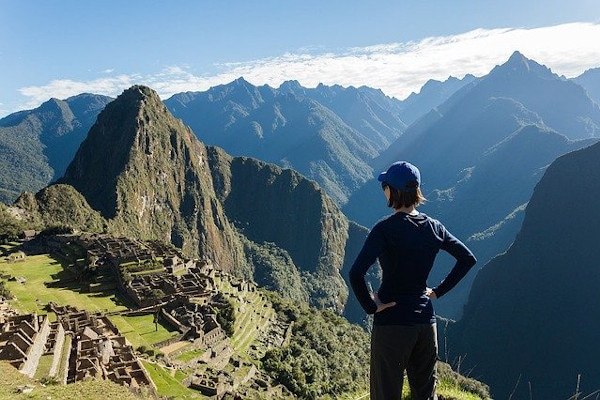
Get a Machu Picchu trek quote
Start planning your Machu Picchu hiking holiday.
Ausangate Trek – An Overview
Ausangate trek: the basics.
Whilst most Ausangate treks are offered on a 6-day itinerary, certain companies will combine the trek with a visit to Machu Picchu as well. This adds an additional 3 days to your trip. You will also have the option of visiting the world famous Rainbow Mountains .
The trail winds 70km / 43 miles through the Vilcanota Mountain range. This is closer to 100km / 62 miles if you extend your trek to Machu Picchu (see more on this below).
You will start and end your trek at the town of Tingui (sometimes called Tinki). Unlike the Inca Trail , no permit is needed for the Ausangate trek.
The Ausangate trek is more challenging than some of the alternative Inca Trail trails to Machu Picchu . As a result, it is one of the quietest in the region. You can go days without another tourist in sight.
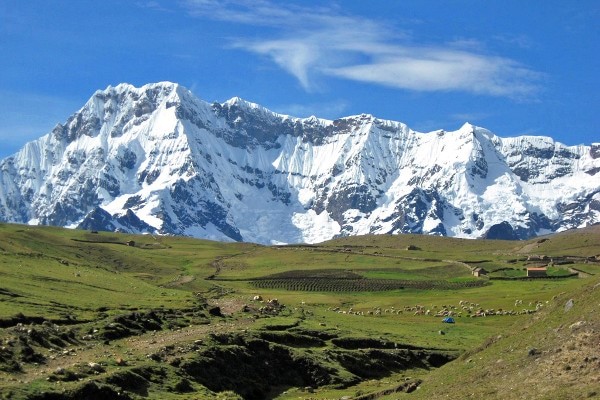
Vilcanota Range and Ausangate Mountain
Lying 100 km / 62 mi south of Cusco is the impressive Cordillera Vilcanota. The mountain range has several peaks over 6,000 meters (19,685 feet) high, including the sacred Ausangate peak (6,372m / 20,906ft). Ausangate is the highest mountain in the Cusco region and the 5th highest mountain in Peru.
Ausangate mountain itself is considered a holy mountain (or mountain spirit) by locals. Since pre-Inca times (see Inca trail history ), the mountain has been a place of worship.
The mountain is also notable for the Qoyllur Rit’I Festival at the end of May. This is held on the opposite side of the Cordillera Vilcanota, in the Sinakara Valley. The festival draws over 10,000 pilgrims each year. This deity of Cusco is celebrated through traditions and offerings.
Looking for a day tour? Here are my 5 favourite day tours around Cusco:
- Rainbow Mountain day trip (with meals)
- Moray and Salt Mines Quad Bike Tour
- Sacred Valley day tour
- Humantay Lake day tour
- Machu Picchu and Huayna Picchu entrance tickets
See more Cusco day trips .
Where Do You Sleep On The Ausangate Trek?
Camping is usually the norm for sleeping and resting on this route. If you book with a tour company, porters will pack and carry the tents and camp equipment for you.
You may also like : Best Inca Trail companies and Best Machu Picchu tours
Please Note: There are no established campsites on the Ausangate trek. Tents are set up along the route, and often alongside a turquoise lake.
Some companies also offer Ausangate trek as a ‘lodge’ trek in which you will stay in very basic huts along the route.
Where to stay? Here are 5 of my favourite accommodation options in Cusco:
- Sonesta Hotel (great 4 star hotel)
- Antigua Casona San Blas
- El Mariscal Cusco (very good value)
- Hotel Paradis (good 3 star hotel)
- Quechua Hostal Recoleta (cheap and cheerful)
See more Cusco accommodation options .
Horse Riding On The Ausangate Trek
The Ausangate trek is one of the few treks in Peru that offers the option to ride a horse along the route. Operators will provide the horses and extra horses will also be brought to carry your gear and equipment.
Certain sections of the trek are so steep that you’ll need to get off and walk beside your horse. If you are not a confident rider (or don’t like horses) then trekking-only tours on foot are a more suitable option.
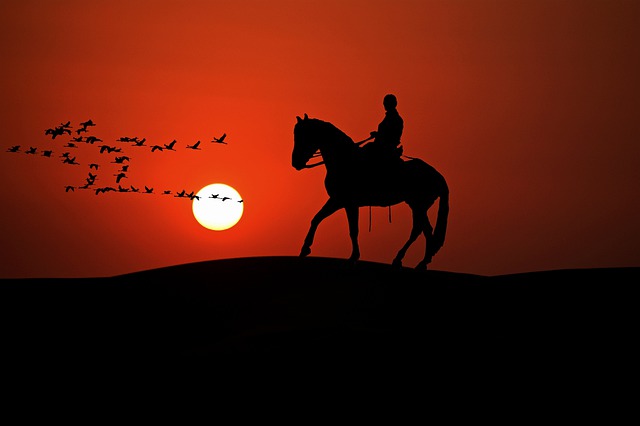
Ausangate Trek Scenery And Wildlife
The Ausangate trail has some of the most stunning scenery of all of Peru’s hiking areas. Mossy passes and glaciers add to the mystical feel of this route. You will pass small villages where time has stood still.
The trek offers an array of wildlife including soaring condors and vicunas (a wild relative of the alpaca). Look out for chinchillas scrambling between the boulders. And, if you are extremely lucky, you may even catch a glimpse of a bobcat or puma.
You’ll also have the chance to bathe in hot springs and view the trek’s signature Rainbow mountains! These colorful sandstone slopes are some of the coolest things you’ll see in Peru.
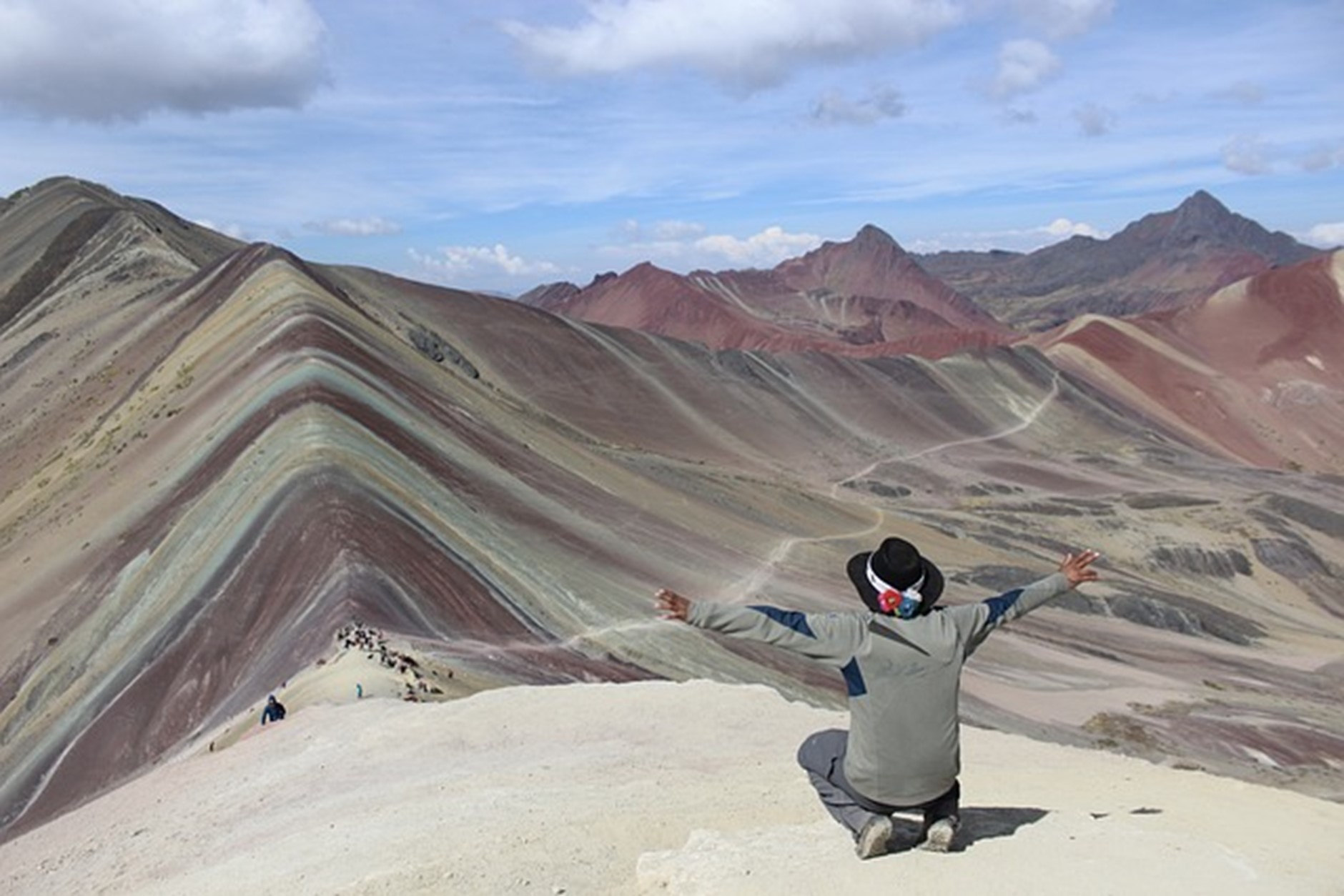
How Difficult Is The Ausangate Trek?
With several mountain passes over 5,000 meters (16,404 feet) high, the Ausangate Trek is relatively difficult. It is best to have experience with multi-day hikes in alpine conditions to do this trek.
As such, the Ausangate trail is classified as a Grade C trek: fairly long and many sections are at high altitudes.
You’ll need a good level of fitness and stamina as you’ll be trekking over many undulating sections. In addition, the elevation changes significantly over a short space of time.
The trail itself is fairly good and well-defined, but the weather can be unpredictable in these mountains. It's not uncommon to experience blizzard conditions in these parts. If you don’t deal well with cold conditions, then this trek isn’t for you.
If you are going by horseback, you’ll most likely be riding for much of the flat sections. Your operator should allow good time for acclimatization to prevent hikers from getting altitude sickness on the higher slopes.
Please Note: This trek is not suited for first-time trekkers. If you are a strong walker and have completed some moderate treks prior to this, then you should be fine.
As there are several high sections on the trek, I recommend reading up on Acute Mountain Sickness (AMS) and how to diagnose and treat the condition. The important thing is not to rush during your trek - slow and steady is better for descending a steep mountain pass. If you have chosen a good operator, they will take this into account.

Ausangate Trek - Typical 6-Day Route Itinerary
There are several route itineraries options for the Ausangate trek: a 4-day, 5-day, 6-day, and 7-day itinerary. The most popular is the 6-day itinerary which we have laid out in more detail below.
Day 1: Cusco - Tinki - Upis
- Total Hiking distance: 7km / 4.3 miles
Most tours will start in Cusco from where your operator will drive you southeast to Tinki (Tinqui). You’ll most likely stop along the way in Ocongate or Qatca for a drink and to experience the local culture.
The journey to Tinki takes roughly 3.5 hours. From Tinki, the real trekking begins.
You will start trekking through the Vilcanota Valley before steadily climbing upwards through high grasslands. Here, you will get your first glimpse of the Vilcanota range. You will see both Ausangate and Colqe Cruz peaks in the distance.
Next, you will start crossing the Mapacho river. Continue on through local community villages towards the base of Ausangate. You will camp near the thermal baths at Upis which are 4,408m (14,462 ft) high.
Local legend tells of the bath’s medicinal properties. Each year, pilgrims make their way to these healing waters.
Day 2: Upis - Arapa Pass - Puqa Q’ocha Lake
- Total hiking distance: 15km / 9.3 miles
The morning begins with your first mountain pass crossing – Arapa (4,850m / 15,912 ft). It takes about 2 hours to ascend this pass. The views of Ausangate from Arapa pass are stunning, so get your camera ready!
After reaching the pass, you will stop for a light lunch. Next, you will descend into the valley, which will take 40-60 minutes of trekking on a well-trodden gravel trail.
On your descent, you’ll pass the green lake of Puqa Q’ocha (4,556m / 14,948 ft). This is connected by a waterfall to another gorgeous lake - Jatun Puqa Q’ocha. Your camp for the evening is usually beside this lower lake.
From your campsite, you can choose to climb a nearby ridge to view the red-tinged lake of Vino Q’ocha. Each lake in the region is colored differently. This is because of sediment variations in the nearby mountains, which makes for an alluring experience.
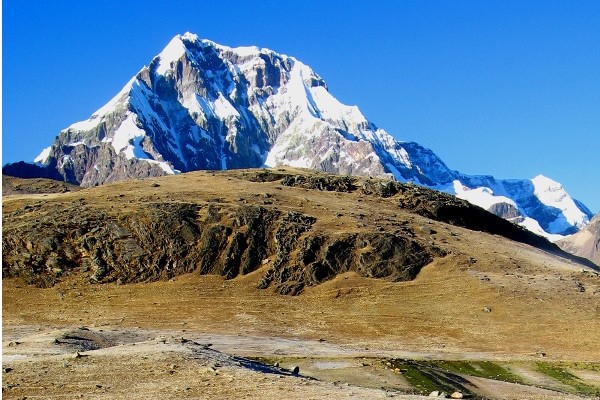
Day 3: Jatun Puqa Q’ocha Lake - Palomani Pass - Chillca
- Total Hiking Distance: 9.5km / 6.8 miles
On day 3 of your trek, you will conquer the highest pass on the trek - the Palomani pass. You will rise early and begin your day passing herds of vicunas, alpacas, and llamas. The looming form of Ausangate watches over you from your left.
It is a 500m (1,640 ft) ascent up the pass. At the top of Palomani pass, you will be 5,051m / 16,571 ft above sea level. The reward for your effort is breathtaking views across the southeast mountain range.
From here, you are able to see the peaks of Mariposa and Caracol in the distance. This is a great location to spot solitary condors and marvel at their enormous size!
After heading back down, you will follow the Jampamayo River through the small village of Jampa. Your campsite will be at Chillca (4,456 m / 14,619 ft).
Please Note: If you are visiting Rainbow Mountain, you will probably camp at Ananta. You should arrive by midday and visit Rainbow Mountain the same afternoon. You can leave your bags at camp and hike to Rainbow Mountain and back. Alternatively, you can go to Rainbow Mountain early on Day 4 of your trek.
Day 4: Chillca - Pampa Jutunpata Valley trek - Lake Q’omercocha
- Total Hiking Distance: 12.5km / 7.8 miles
Day 4 is a slightly easier trek. You will follow the Pampa Jutunpata valley along the shores of Lake Ticllacocha.
The valley is a great place to spot wildlife. Look out for vizcacha, vicuñas, and bobcats. You’ll stop and have lunch before tackling the last of the passes – the Q’ampa pass (5,000m / 16,404 ft).
From the top of the pass, you can see several stunning lakes glimmering in the sunlight. You will then descend down the other side and camp beside the blue-green lake of Q’omercocha (4,704m / 15,433 ft).
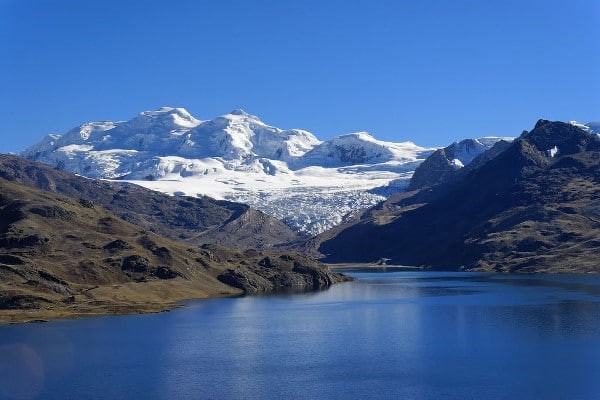
Day 5: Q’omercocha - Pajchanta
- Total hiking distance: 7.5km / 4.6 miles
After breakfast, you will have an easy descent. You will be walking down slope towards the village of Pajchanta (4,010m / 13,156 ft). This takes most hikers approximately 5 hours of walking.
The village is an extremely authentic insight into traditional Peruvian culture where local village people make their living here from herding and farming.
The village is also home to some very picturesque natural thermal pools. Take the opportunity to soak your weary bones in the warm waters.
Some operators will press on for another 3 hours to the town of Tinki; however, most camp at Pajchanta for the night.
Day 6: Pajchanta - Tinki
- Total hiking distance: 4.8km / 3 miles
In the morning, you will make your final trek back to Tinki. Say goodbye to your guide and pack up your horses (and say thank you with a nice tip). The bus will collect you here for your trip back to Cusco.
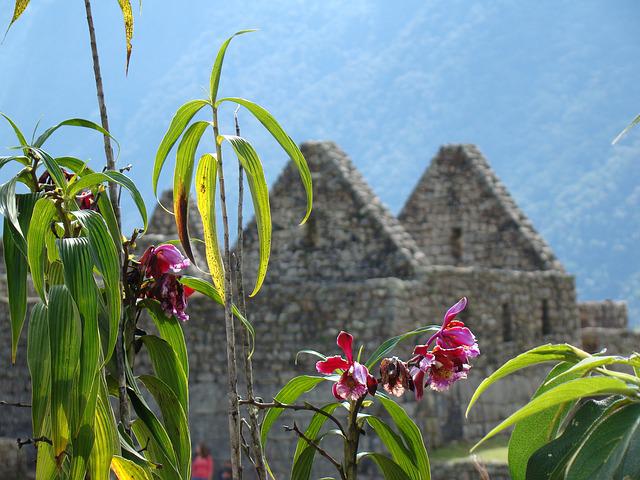
9 Day Ausangate Trek: Machu Picchu Extension
Occasionally, a tour operator will offer the Ausangate trek in conjunction with a visit to the ancient citadel of Machu Picchu . If you have a little more time (and money) on your hands and want to see the magnificent ruins, then this is a great option.
The itinerary is almost identical to the one above until you get to the final day. Instead of trekking from Pajchanta to Tinki, you will trek from Pajchanta to Laguna Armaccocha instead. See below for more details.
Day 6: Pajchanta - Laguna Armaccocha
You’ll have the chance once again to bathe in the thermal pools in the morning. Afterward, you will set off from your campsite at Pajchanta.
The trek is on a well-trodden route through remote highlands. You’ll likely see more herds of alpacas and llamas here.
The walking distance is a fairly short one. You should arrive early in the afternoon at the beautiful Laguna Armaccocha (4,665m / 15,305 ft).
The snow-capped Nevado Collque Cruz peak sits directly above you, making this a lovely place to camp.
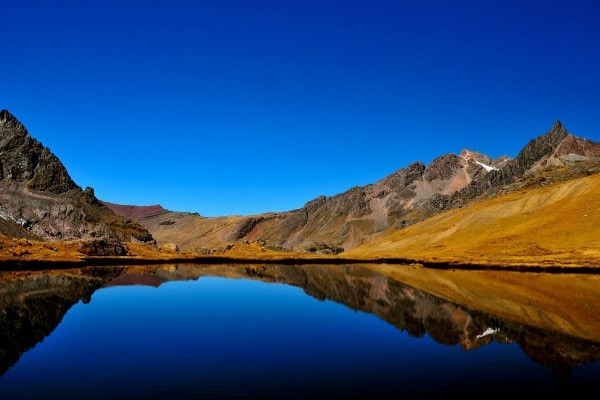
Lake Singrenacchocha
Day 7: Lake Armacoccha - lookout point - Lake Singrenacchocha
After breakfast, you will continue trekking northeast. You will climb a steep shoulder and cross a narrow pass to reach an incredible lookout point (4,940 meters / 16,207 feet).
From the lookout, you get a gorgeous 360-degree view of the surrounding mountains. Several of the peaks are above 6,000 meters (19,685 feet)! From here, you will descend down to the shores of lake Singrenacchocha (4560m / 14,961 ft). This is where you will camp for the night.
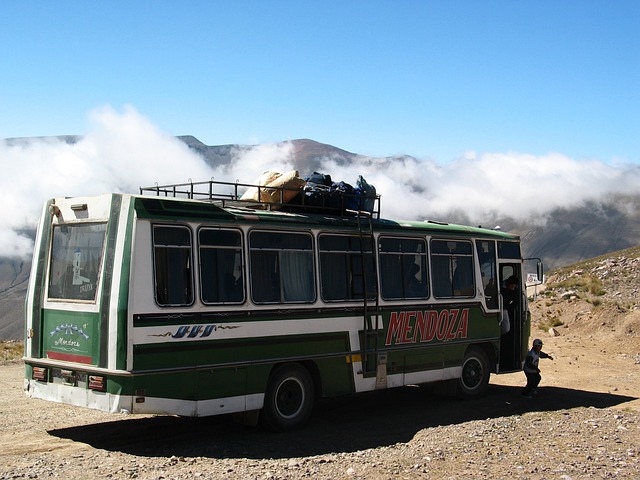
Day 8: Lake Singrenacchocha - Mallma - Cusco - Ollantaytambo
Day 8 is the final day of trekking. You will hike along the lake shore to the rivers that feed it. Follow the river as it gently descends to Mallma at 4,230 meters / 13,878 feet.
In Mallma, you will have lunch before boarding a bus that will take you back to Cusco. From there, you will head to Ollantaytambo where you will check into a hotel .
Day 9: Train to Aguanas Calientes
From Ollantaytambo, you can take a 90-minute train to Aguas Calientes . We have detailed information on things to do at Machu Picchu .
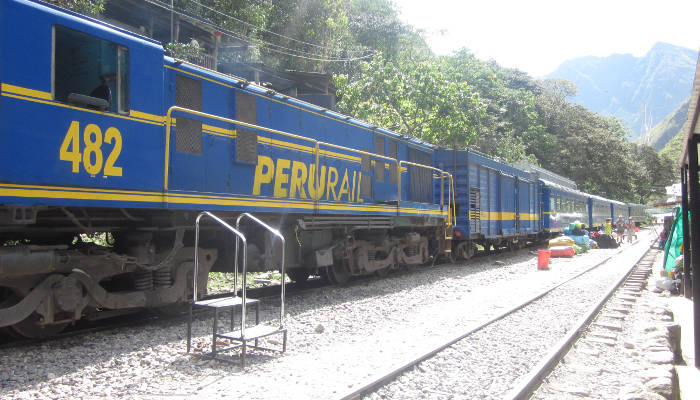
Rainbow Mountain Add-On To The Ausangate Trek
A visit to Rainbow Mountain will add an additional day to your Itinerary. Most companies hike to Ananta camp on Day 3. From here, you will trek to Rainbow Mountain in the afternoon or the following morning.
Expect to see loads of tourists and decorated alpacas at this famous Peruvian landmark. There are usually long queues to get a ‘classic shot’ of the colorful slope in the background.
Please Note: If you are looking for a more authentic trail, you may want to skip this extension. You can still visit Rainbow Mountain on a day tour from Cusco. It is fairly easy, and arguably better, to take a bus to visit Rainbow Mountain. It is recommended that you travel slightly later in the morning (around 8 am) to reach the mountain just after the crowds have thinned out.
Can I Hike The Ausangate Trek Without A Guide?
It is possible to hike Ausangate without a guide. This is a lot more adventurous and also works out much cheaper. However, due to its difficulty and remote setting, I don't recommend this option for inexperienced trekkers.
Only about 5% of hikers on the Ausangate Trek do it solo. These hikers have the right equipment and experience trekking at high altitudes.
If you are planning on hiking Ausangate without a guide, you will need to be completely self-reliant. It is difficult to find accommodation along the way. This means you need to carry all of your own camping gear and food.
A guided trek is a better option for most people. Ausangate is one of the less popular hikes around Cusco. This means group sizes are usually small if not completely private.
Another benefit of booking with a company is that you don’t have to worry about carrying food or preparing meals. You can focus on enjoying the trail.
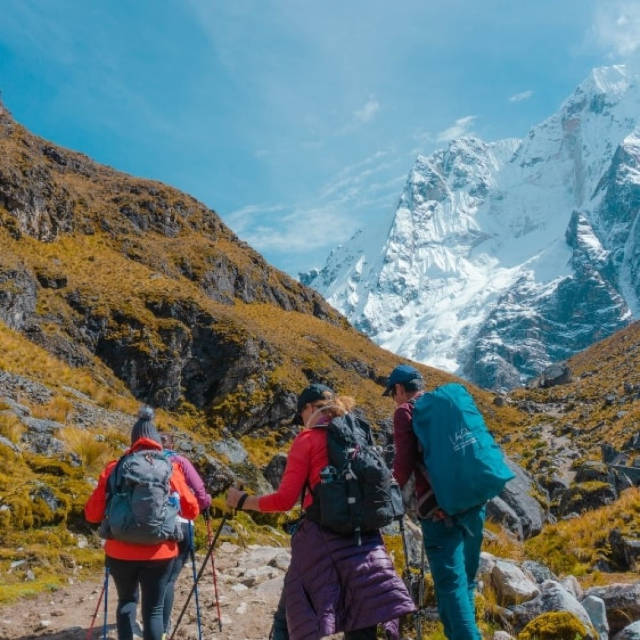
What Does It Cost To Hike The Ausangate Trek?
Ausangate trek cost with a company.
Prices for the Ausangate trek vary greatly between companies. This is true for all the trekking tours from Cusco.
Generally, you can expect to pay between $450-$850 for this trail. This includes guides, transport, horses, and camping gear. Chefs and all meals during the trek will also be included in the price.
Please Note: You usually need to pay extra for sleeping bag rental. Sometimes, the first and final meals are not included. Be sure to check with your tour company about what’s included in your tour package as well as extra expenses.
Unguided Ausangate Trek Cost
Hiking the Ausangate Trek without using a company works out significantly cheaper. There are no support crew fees. Basically, you will only be paying for transport, food, and equipment rental.
Please Note: This is only an approximate estimate. You may need to hire additional equipment and prices vary between rental agencies. I recommend taking a day or two to shop around and adjust your budget.
Doing the trail independently is much more planning intensive. However, this can be rewarding if you are a seasoned multi-day trekker.
Here is a breakdown of expenses on the Ausangate Trek (per person):
- Bus from Cusco to Tique: 10 soles ($3) each way.
- Tique Park Entrance Fee: 10 soles ($3).
- Food Supplies (including gas for cooking): 100-150 soles ($30-$45).
- Camping Gear (tent, sleeping bag, sleeping mat, and cooking set): approximately 40 soles per day.
- Try to budget for about 300 soles ($80) for 6-7 days.
- Total Ausangate Cost Per Person: 470 soles (about $120).
Map and Guidebooks
The map below is the best online map I could find for the Ausangate trek. Please note that the map is not to scale. The trail marked on the map is only representative of the general direction of the route.
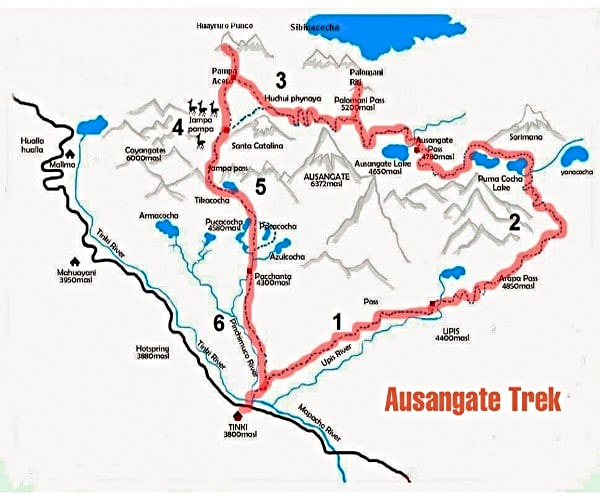
There is a serious lack of hand-held maps for the Ausangate trek. Your best option is to buy the Lonely Planet Trekking in the Central Andes guidebook map for more detailed maps of the region.
Although not as detailed as many maps, the map of the Cordillera Vilcanota above is decent enough. With maps like this, experienced trekkers should be able to find their way without a guide.
Please Note: Planning on hiking the Ausangate solo? I’d advise being a little sneaky while in Cusco. Find out which tour offices sell this trek and pay them a visit. If you tell them you are interested in this trail, they will usually describe the route and may even give you a map. Just don’t say you intend on trekking unguided!
Best time to do the Ausangate Trek
Like most treks in the region, the best time to do the Ausangate trek is in the dry months. This is between May and September which coincides with the busy season.
Unlike other popular Machu Picchu routes , the Ausangate trek is very quiet, even in peak season.
Seasonal shoulder months are April and October. During this time, there is a mix of rain and sunshine. The weather is mostly pleasant, and it is possible to hike the Ausangate trek.
At these high elevations, you’ll have to contend with freezing nights though. This is also true for the dry season which is Peruvian wintertime. The Ausangate trek is best avoided in the wetter colder season between November and February due to snow at high altitudes.
In the dry months, daytime temperatures are usually mild and visibility is high. You will want to wear layers, especially for colder nights. Please see our packing list below for suggestions.
You may also like : best time to hike to Machu Picchu and Inca trail weather
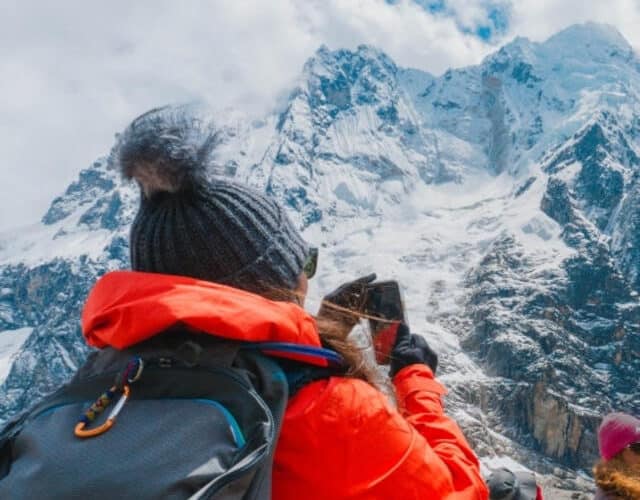
Acclimatization and Altitude Sickness On The Ausangate Trek
The Ausangate trek is one of the highest altitude treks in Peru. Obviously, this means certain altitude sickness risks. Acclimatization is the key factor in ensuring you have a safe and enjoyable trek.
We suggest that you take a minute to read our detailed article on altitude sickness and acclimatization .
Ausangate Trek Packing List
The equipment and packing list for the Ausangate trek is similar to that for other Cusco hikes.
For more insights, see our packing list for the Inca Trail . You will need more changes of clothes as the Ausangate trek is longer. It is also worth investing in thermal undergarments too for an added layer of protection.
If you are hiking independently, make sure the gear you take is suitable for sub-zero temperatures. In this case, you will also need to take cooking equipment and food. Items like dried fruit, instant pasta, packet soup, and instant oatmeal are lightweight and convenient food choices.
Do You Need Trekking Insurance for the Ausangate Trail?
Insurance for any multi-day trek in a foreign country is a must. Many operators will require you to carry sufficient travel insurance for your trek.
The Ausangate trek reaches passes higher than 5, 000m. In this instance, you will need to make sure your insurance covers you for high-altitude hiking. I have reviewed a number of travel insurance providers and the most affordable and best is World Nomads .
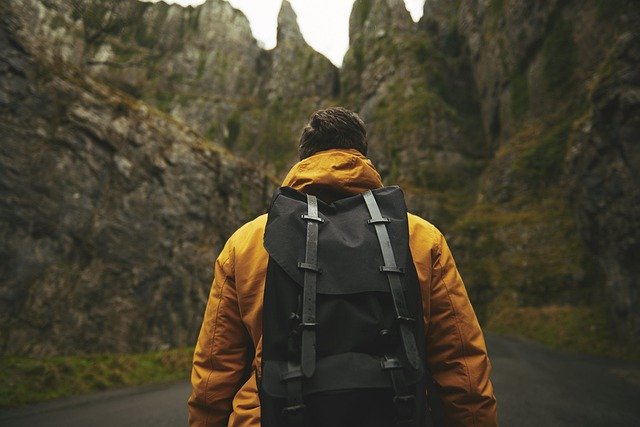
I hope you have enjoyed this article. If you have any further questions about the Ausangate trek, please leave a comment below. We’ll get back to you within 24 hours.
You might want to bookmark this page for future reference. Feel free to share my article with friends or link to your blog. We also always appreciate a shout-out on social media. Happy trekking!
Tags: Ausangate trek, Ausangate trek Peru, Ausangate trail, Ausangate trek to Machu Picchu
References: 1. Contemporary Nomad
Alison Macallister
With a degree in Nature Conservation and experience working with wildlife including the Big 5, Alison works as a guide for a 5-star reserve. She enjoys sharing her passion for all things nature-related. She enjoys hiking, horseriding, 4x4 driving and kayaking.
Leave a Reply
Your email address will not be published. Required fields are marked
Name * * * *
Email * * * *
Get a quote from our recommended local trek operator in Peru
Best local guides. great value hikes..
- Just Me
- Me + 1
- Me + 2
- Me + 3
- Me + 4
- Me + 5
- More than 6
How to Hike the Ausangate Trek Without a Guide
Last updated: 20 December 2023
Nestled amidst the breathtaking landscapes of Peru's Andes Mountains lies the Ausangate trek—an extraordinary odyssey that beckons adventurers seeking a harmonious blend of natural splendor and cultural immersion. This comprehensive guide invites you on an eight-day journey through rugged terrains, vibrant lagoons, and majestic peaks, offering insights, tips, and highlights to prepare you for an unforgettable expedition. From the vibrant hues of the Seven Lagoons to the majestic views atop Palomani Pass, join us as we delve into the rich tapestry of the Ausangate trek—a trek that promises to stir the soul and leave an indelible mark on your heart.

The Ausangate Trek is a trekker's paradise, offering a challenging yet rewarding expedition amidst the majestic peaks of the Andes. As a filmmaker passionate about showcasing the world's diverse beauty, this trek provides a canvas of breathtaking scenes, from turquoise lakes to towering mountain passes. Situated near Cusco, the Ausangate Trek encircles the sacred Ausangate mountain, weaving through remote villages and showcasing the vibrant culture of the Andean people. With altitudes reaching over 5,000 meters, this trek is not for the faint of heart but promises an unparalleled adventure.
Basic Information
Guides: The decision to trek with or without a guide is a personal one. Some trekkers seek the freedom of solitude, while others find comfort in the knowledge and companionship of a local guide. Personally, I prefer to start my journey alone and meet local guides along the way if I would like to know more about the area.
Navigation: For proper navigation, you should always carry a paper map and compass and know how to use them in an emergency. You can pick up any number of paper maps in Cusco when you arrive. Additionally, I typically use a gps app on my phone like maps.me or AllTrails. Check out the map for my entire route.
Accommodation: Accommodation options are limited to camping. Designated campsites exist along the route, offering a place to pitch tents and rest for the night. However, one of the beauties of this trek is the flexibility it provides in terms of camping. While there are designated spots, adventurers often have the liberty to camp anywhere along the trail, allowing for a more personalized and immersive experience amidst nature's embrace. Check out the gear list to see what you should bring.
Permits: Two permits are required during the journey. The first permit is usually secured upon entry to the park, while the second permit is typically obtained in proximity to the Anantapata campsite. These permits serve as essential documents granting access to the trekking routes and the surrounding areas, ensuring a regulated and controlled flow of visitors within the region.
Safety: Hiking in the Andes is difficult. Your safety and well-being are of utmost importance. Take time to acclimatize and relish rest days amid the tranquil beauty of the Andes. Make sure to do your own research and due-diligence. In the end, your safety is your responsibility.
Best Time to Go
Embarking on the Ausangate Trek means navigating through diverse weather conditions dictated by the Andean seasons. From the crisp freshness of Spring to the snowy landscapes of Winter, each season brings a unique charm to this high-altitude adventure.
Dry Season (May to September): Stable, dry weather prevails. Days are sunny and warm, ideal for trekking. Nights get cold, often below freezing.
Wet Season (October to April): Increased rainfall, especially from November to March. Expect rain, mist, and fog. Trails may become muddy and slippery. Lush greenery and blooming flowers enhance scenery.
The Ausangate Trek offers diverse weather experiences based on the distinct dry and wet seasons. The dry season from May to September provides clearer skies, making it an optimal time for trekking, although temperatures can drastically drop at night. Conversely, the wet season from October to April brings more rainfall, transforming the landscape with vibrant vegetation but posing challenges like muddy trails and reduced visibility. Trekkers planning their journey should consider these seasonal variations and pack accordingly to ensure a safe and enjoyable trekking experience.
Below is an illustrative map encompassing the main circuit of the Ausangate trek, outlining the primary trail, side trips to Rainbow Mountain, and an alternative shortcut for the return journey. This visual aid highlights essential waypoints, campsites, notable passes, and key landmarks along the route, offering a comprehensive overview of the trek's terrain and points of interest. The map serves as a valuable resource for trekkers, aiding in itinerary planning, navigation, and understanding the diverse landscapes encountered throughout this remarkable journey. Embrace the adventure, visualize the trail, and explore the splendor of the Ausangate trek through this informative and guiding map.
To better view the map, see it in full-screen . Learn how to download the map for your own offline use by reading how I navigate on the trail .
Nestled in the heart of Peru, the Ausangate trek stands as a testament to the raw, untamed beauty of the Andes Mountains. This adventure promises a soul-stirring experience through breathtaking landscapes, crystalline lagoons, and majestic peaks that reach towards the sky. Traversing through the traditional routes of the Andean communities, this trek unveils a tapestry of culture and nature interwoven seamlessly. Join us on an eight-day expedition that will etch unforgettable memories of rugged terrain, vibrant colors, and the warmth of local hospitality.
Brief Itinerary
Detailed itinerary, day 1: cusco to pacchanta (127 km / 4314 m) (78 miles / 14153 ft).
Embark on your journey from Cusco, initially taking a local bus bound for Tinke. From Tinke, a local taxi shuttles you to Pacchanta, your starting point for the Ausangate trek. As the sun begins to set, immerse yourself in the natural allure of the hot springs and take time to explore the charm of the surrounding village. Some opt to commence the trek from Tinke, the original starting location, despite the path now being a dusty or muddy road. ↩
Day 2: Pacchanta to Seven Lagoons (9.6 km / 4860 m) (5 miles / 15944 ft)
Today's hike covers 9.6 kilometers, a gradual uphill journey that offers splendid vistas of Ausangate Mountain at its peak. As evening approaches, settle into your camp perched atop a hill, relishing the panoramic view of the vibrant, multi-colored lagoons. ↩
Day 3: Seven Lagoons to Jampa Campsite (11.4 km / 4615 m) (7 miles / 15141 ft)
Embark on a 11-kilometer hike, traversing Jampa Pass at 5,063 meters, revealing a lush, fertile valley below. Keep an eye out for freely wandering alpacas along the passes. The Jampa Campsite is a popular choice, yet those seeking a more secluded spot can venture further down the valley along the river. ↩
Day 4: Jampa to Anantapata Campsite (11 km / 4658 m) (6 miles / 15282 ft)
Journey across an 11-kilometer path over Palomani Pass at 5,091 meters, treating yourself to breathtaking views of the chocolate lake, rainbow-colored mountains, and expansive glaciers. Anantapata Campsite, situated near a lagoon and glacier, presents a comfortable resting spot, although encountering other hikers is likely. For a more private area, continue your descent down the valley. ↩
Day 5: Anantapata Campsite to Rainbow Mountain Camping (9.1 km / 4882 m) (5 miles / 16017 ft)
Traverse 9.1 kilometers across Huasacocha Pass at 4,981 meters, praised for its awe-inspiring views by fellow trekkers. To avoid the throngs of tourists flocking from Cusco to Rainbow Mountain, opt to camp just before the landmark. Early the next morning, around 4:30 am to 5:00 am, ascend the remainder of the way to Rainbow Mountain, potentially relishing its splendor in solitude. ↩
Day 6: Rainbow Mountain to Laguna Pucacocha (9.5 km / 4528 m) (5 miles / 14855 ft)
Start the day early, summiting Rainbow Mountain before retracing 9.5 kilometers back over Huasacocha Pass at 4,981 meters and Apacheta Pass at 4,903 meters, culminating at the serene Laguna Pucacocha. ↩
Day 7: Laguna Pucacocha to Pacchanta (14 km / 4860 m) (8 miles / 15944 ft)
Trek 14 kilometers, maneuvering gradual ascents and descents, ultimately returning to Pacchanta. Revisit the tranquilizing hot springs, relishing a final rejuvenating soak. Alternatively, conclude your trek at Upis, though the allure of Pacchanta's superior hot springs and relatively manageable final pass often beckons. ↩
Day 8: Pacchanta to Cusco (127 km / 3399 m) (78 miles / 11151 ft)
Bid farewell to the mountains, arranging for a local taxi to Tinke and then boarding a local bus back to Cusco, concluding your adventurous journey through the mesmerizing Ausangate trek. ↩
The Ausangate trek stands as an ode to the majesty of nature and the resilience of the human spirit. As you bid farewell to the enchanting landscapes, vibrant lagoons, and towering peaks, may the memories of this expedition linger as a testament to the awe-inspiring grandeur of the Andes. Whether it's the tranquil evenings by the hot springs or the breathtaking views from high mountain passes, this journey leaves an indelible mark on the soul, reminding us of the profound beauty that exists within our world. It's worth noting that this eight-day itinerary is relaxed, offering ample time to savor the surroundings. For strong hikers seeking a more brisk pace, completing this trek in 5-6 days is feasible, allowing for a more intense and swift immersion in the stunning landscapes and cultural richness along the route. You can also camp pretty much anywhere you want and avoid the developed campgrounds. As you return to Cusco, may the spirit of the Ausangate trek continue to inspire your wanderlust and beckon you to seek more adventures in the great outdoors.
My Favorite Highlights
During my personal journey along the Ausangate trek, I was swept away by the spellbinding beauty that unfolded with each step. Among the many remarkable highlights, three particular moments stood out, etching themselves into the fabric of my memories.
Palomani Pass

Ascending to Palomani Pass at an altitude of 5,091 meters was nothing short of awe-inspiring. The panorama that greeted me was a breathtaking canvas of nature's artistry. The vistas encompassed a mesmerizing chocolate-hued lake mirroring the sky, alongside the legendary rainbow-colored mountains adorned with layers of sedimentary minerals. These vivid gradients were complemented by the colossal glaciers that seemed frozen in time. Every gaze in every direction evoked a sense of wonder and reverence for the sheer magnificence of our planet's natural wonders.
Seven Lagoons
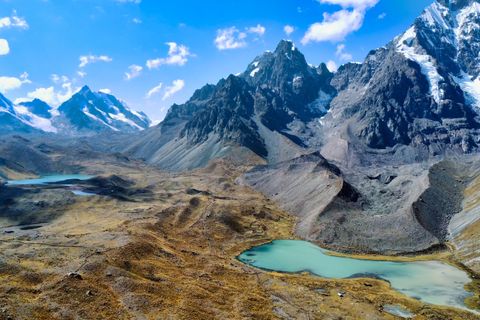
These vibrant, multi-colored lagoons painted a mesmerizing picture against the backdrop of towering peaks. As I approached these natural wonders, the sight of alpacas and llamas freely roaming around, seemingly in harmony with the stunning surroundings, added a charming authenticity to the scene. Each lagoon boasted its own distinct hue, ranging from azure blues to emerald greens, creating a kaleidoscope of colors that seemed almost surreal. Paired with the picturesque views of the surrounding mountains, this panoramic vista was nothing short of a painter's dream come to life.
Jampa Valley

Descending into the tranquil embrace of Jampa Valley felt like stepping into a mythical oasis. Here, alpacas and llamas gracefully roamed amidst a serene landscape, their presence adding a touch of authenticity to the natural tapestry. The opaque teal rivers meandering through this valley added a sense of serenity to the surroundings, inviting a moment of stillness to absorb the tranquility of this hidden gem.
Pacchanta Hot Springs
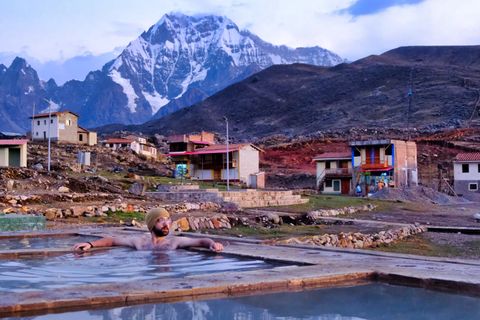
As the trek began and concluded, the soothing embrace of Pacchanta's hot springs offered a much-needed respite. The juxtaposition of relaxation and grandeur was palpable. Immersed in the warm waters, I was treated not only to a rejuvenating experience but also to an unparalleled view of Ausangate Mountain. The ethereal beauty of the landscape enhanced the feeling of utter tranquility, making it an ideal spot to unwind and reflect on your adventures.
The Ausangate trek, with its diverse landscapes and cultural encounters, offered an expedition unlike any other. From the raw, untamed beauty of nature's masterpieces to the serene moments of cultural immersion, each step unfolded a new chapter of exploration and discovery. These highlights, among many others, remain etched in my mind, a testament to the indelible beauty and rich experiences that the Ausangate trek generously bestows upon its travelers.
Embarking on the Ausangate trek involves budgeting for various expenses essential for a successful journey. Here's a breakdown of anticipated costs to consider when planning your adventure:
Transportation to/from Cusco/Pacchanta
The journey from Cusco to Pacchanta typically involves taking a local bus and taxi, costing approximately $16 for the round trip.
Necessary permits for entering the trekking area can be acquired along the way for around $10
Local Guide
Opting for a local guide, fluent in Quechua, Spanish, or English, can enhance your experience but comes at an additional cost ranging from $30 to $50 per day, depending on your trekking style and negotiation.
Budget around $10 per day for food purchased in Cusco before departure. This estimate includes meals and snacks for the duration of the trek.
Accommodation
If you choose to primitive camp throughout the trek, there may not be an accommodation expense. However, staying in developed campsites or shelters might incur fees ranging from $3 to $5 per night.
Careful financial planning is key to a smooth and enjoyable Ausangate trek. Consider these estimated costs to ensure you allocate your budget wisely, factoring in transportation, permits, guide fees, food, and potential accommodation expenses. By budgeting prudently, you can relish every moment of this remarkable journey without financial concerns holding you back.
Recommended Gear
The Ausangate trek in Peru demands thorough preparation. Pack a sturdy backpack and weatherproof cover, a lightweight tent with footprint, warm sleeping bag and insulated pad, water bottle and purification gear, portable stove and cookware with propane. Choose clothing for varied climates and terrains: quick-dry shirts and pants, thermal underwear, down jacket, rain jacket, wool hat, mittens, buff, hiking socks and underwear, hiking boots, and sandals. Prioritize well-being with sunscreen, antiseptic cream, bandages, and an emergency blanket. Pack lighters and matches, toilet paper in waterproof bags, plastic bags for waste and organization, compact toiletries, quick-dry towel, passport, cash, and a laundry bag. Enjoy the trek, fully equipped!

The provided gear list is a suggestion, tailor it to your needs. Prioritize safety by packing and preparing well for a happy, adventurous hike. Interested in all of my gear recommendations? Click the button below to see what I recommend for filming, travel, and fun :) Explore All Gear
The Ausangate trek, with its raw beauty and challenging paths, stands as a testament to the wonders of nature and the resilience of the human spirit. As we conclude this guide, we hope it has provided valuable insights and inspiration for your own Ausangate adventure. Remember, this journey is not solely about conquering trails or ticking off destinations but about embracing the profound beauty of the Andes, immersing yourself in its cultural tapestry, and fostering a deep connection with nature. Whether you embark on this trek for the vibrant lagoons, panoramic vistas, or the joy of exploration, may the memories forged amidst these majestic mountains linger as a testament to the magnificence and grandeur of the Ausangate trek—a trek that invites you to discover the extraordinary within yourself and the world around you.
Check out a video that I made about the entire trip! I tried my best to capture all of the little beautiful moments by letting them speak for themselves. So there are no explanations or speaking in this video, just moments :)
You Might Also Like
How to Walk from Cusco to Huchuy Qosqo in One Day An extensive guide to a diverse trek to Huchuy Qosqo, offering insights into multiple routes, key highlights, and essential tips for an enriching Andean adventure.
How to Hike the Lares Trek Without A Guide Cultural immersion, panoramic vistas, and alpaca encounters await—an all-encompassing guide to Peru's high-altitude wonders.
How to Hike Pu Ta Leng in Northern Vietnam A mountain on the edge of Vietnam and China
How to Hike Inside the Grand Canyon in One Day Everything you need to know about hiking down into the Grand Canyon and back up again
How to Visit Cat Ba Island and Lan Ha Bay, Vietnam Kayaking the bay, hiking through the jungle, and sleeping on a floating house.
A Guide to Mountain Hut to Hut Hiking in Italy Everything you need to know about hiking and mountain huts in Italy
How to Solo Hike the Three Passes Trek for Under $500 Everything you need to know to plan your own Three Passes Trek.
How to Hike Coyote Gulch, A Beautiful Desert Oasis A comprehensive hiking guide for Coyote Gulch in the heart of Utah
How to Hike the Wild Great Wall of China Straying off the beaten path and exploring the ruins of an ancient wall.
How to Solo Hike the Pikey Peak Trek Without a Guide Everything you need to know to plan your own Pikey Peak Trek.
How to Hike the Manaslu Circuit Everything you need to know to plan your own Manaslu Circuit hike.
My site does not support public comments. Please use the form below to send a comment directly to me if you want to ask questions; I am happy to help.
Safety Disclosure This travel guide is intended for educational purposes only. Readers are urged to conduct their due diligence, verify current conditions, and research the most recent information independently. Conditions along trails and relevant details may change, necessitating the confirmation of accurate and updated information from reliable sources or local authorities before undertaking any travel or outdoor activities. Affiliate Disclosure This travel guide contains affiliate links, which means I may earn a commission for purchases made through these links at no cost to you. Your support helps sustain the creation of more content.
Ausangate Trek: The Complete Trekker’s Guide

Ausangate Mountain is considered by the Quechua people to be one of the most holy mountains in all of the Andes. As a result, the 6-Day Ausangate Trek, while being a visually stunning adventure, is something of a spiritual pilgrimage. The Classic 4 Day Inca Trail is a more popular hike of the region, and for that reason more crowded and limited in availability. Ausangate is an off-the-beaten track hiking alternative with minimal foot traffic that allows you to carve into the mystical side of an ancient Andean world.
Spiritual Significance
Best time to go, ausangate trek difficulty, guided vs. independent trekking, climate & weather, machu picchu extension, rainbow mountain side excursion, altitude sickness, ausangate trek packing list, daily itinerary breakdown.
A voyage to Ausangate mountain is one of natural beauty, living history and ancient spirituality. Considered challenging, this 6 day trek is recommended for seasoned hikers only, who have experience hiking at high elevations. The route takes you through the Cordillera Vilcanota , or the Vilcanota Mountain Range. Ausangate is actually the 5th tallest mountain in Peru, standing at 20,945 feet above sea level.
Through this Peru trek , you’ll ascend and descend through the mountain range, finding sweeping Andean vistas, thermal lakes, mystical glaciers, green mossy passes and enormous snowy mountains. Along the way, you’ll catch a glimpse of interesting wildlife, like condors , chinchillas and groups of vicunas. You’ll also come across hidden Andean villages richly embedded in centuries-old traditions. The highest point of the trek is 16,800 feet above sea level and the highest campsite elevation is at 15,255 feet.
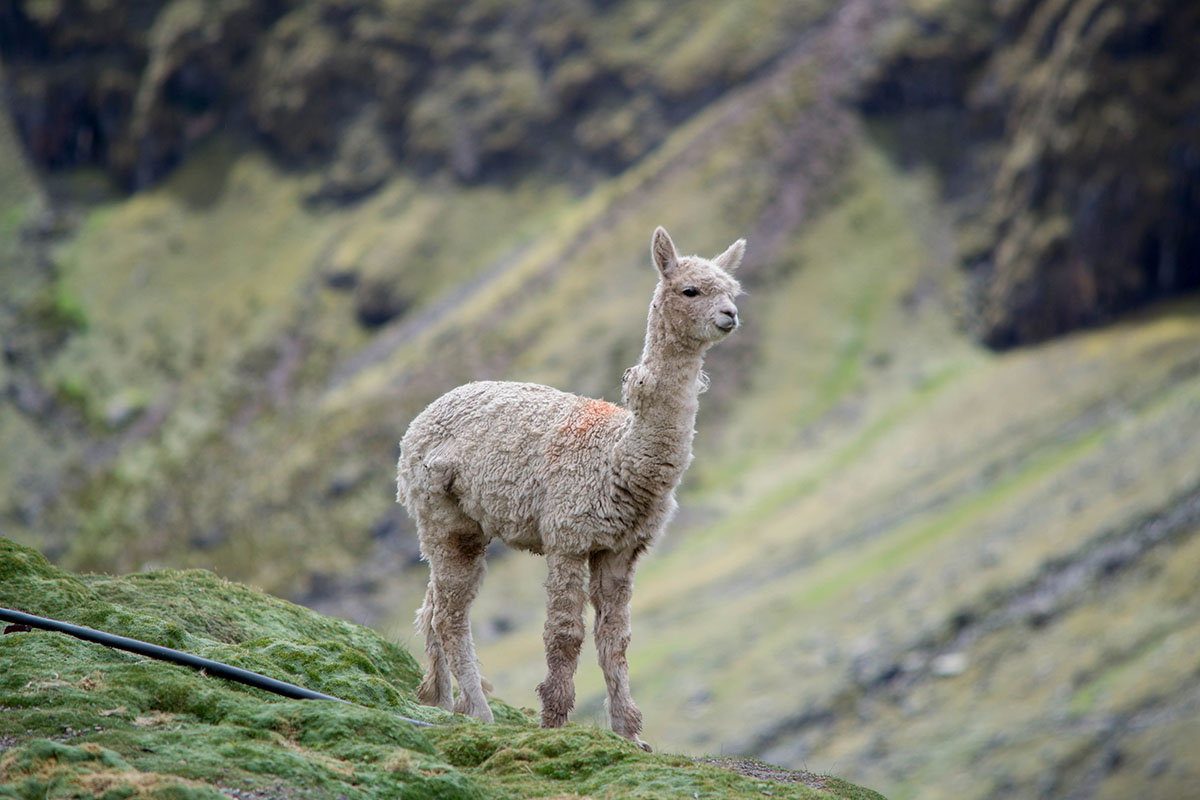
Alpaca traversing the Vilcanota Mountain Range along the Ausangate Trek. Image: Unsplash
In Andean spirituality, the mountains, called apus, are highly revered and believed to have a spirit. In fact, in Quechua apu means lord . These powerful spirits are believed to protect the local people in the highlands. Ausangate Mountain stands with 11 other sacred apus of the Cusco area, namely Salkantay, Mama Simona, Pillku Urqu, Manuel Pinta, Wanakawri, Pachatusan, Pikchu, Saksaywaman, Viraqochan, Pukin and Sinqa.
The road of the Apu Ausangate, or Ausangate Trek, is believed to be the most profound pilgrimage in the Andes and is one of the most renowned hikes in Peru. Traditionally, this spiritual journey is made during the Qoyllur Rit’i festival, a Quechua holiday that celebrates the stars in late May or early June (coinciding with the full moon). Specifically, it celebrates the reappearance of the Pleiades constellation in the night sky, marking the beginning of harvest season. The Ten Nations, or brotherhoods, of the surrounding areas all gather for the occasion.
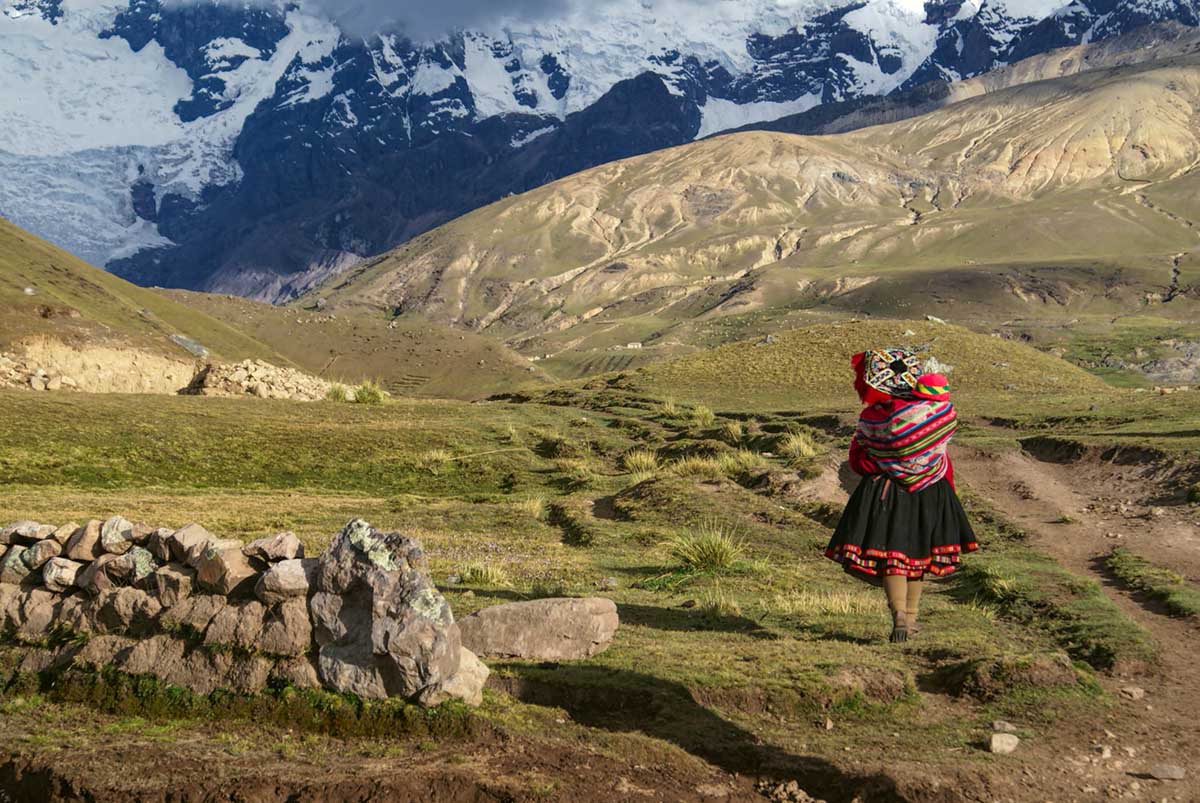
Andean woman walking in the Andes Mountains. Photo by Peru for Less.
The best time to do the Ausangate trek, and all Peru hiking tours, is between May and September. This is the dry season in the Andes, making for sunnier weather and clearer days to take in the beautiful scenery. Try particularly for July or August, the driest months of the year. The dry season is also the high season for the area, so Cusco , Machu Picchu and the Inca Trail tend to be more densely populated. Fortunately, the remote Ausangate Trek is a unique choice, making it clear of crowds year round – even during peak season.
The rainy season in the Andes is between October and April, with the rainiest months being January-March. During this time, especially in February, rain can be torrential, which may cause closures on the trail. It is best to stick to the dry season or the shoulder season (mixed weather) of April and October.
Trekking Tours :

The Ausangate trek is considered strenuous, with a few moderate days sprinkled in. The trek is classified as Grade C in difficulty, which implies altitudes between 14,800 to 16,400 ft (4500-5000 m) and 6-7 hours of hiking per day. Many of the days have steep sections that cause rapid altitude gain in a short time. Anyone with a good level of fitness can manage this hike, but it is recommended that trekkers have experience with multi-day hikes at high elevations.
Another factor to consider, aside from the steep sections and 16,000 ft+ elevation passes, is the weather. The weather can be quite unpredictable, and blizzard conditions at the higher altitudes are not uncommon. It is important to factor the low temperatures and your tolerance to cold and snow when determining your suitability for this trail.
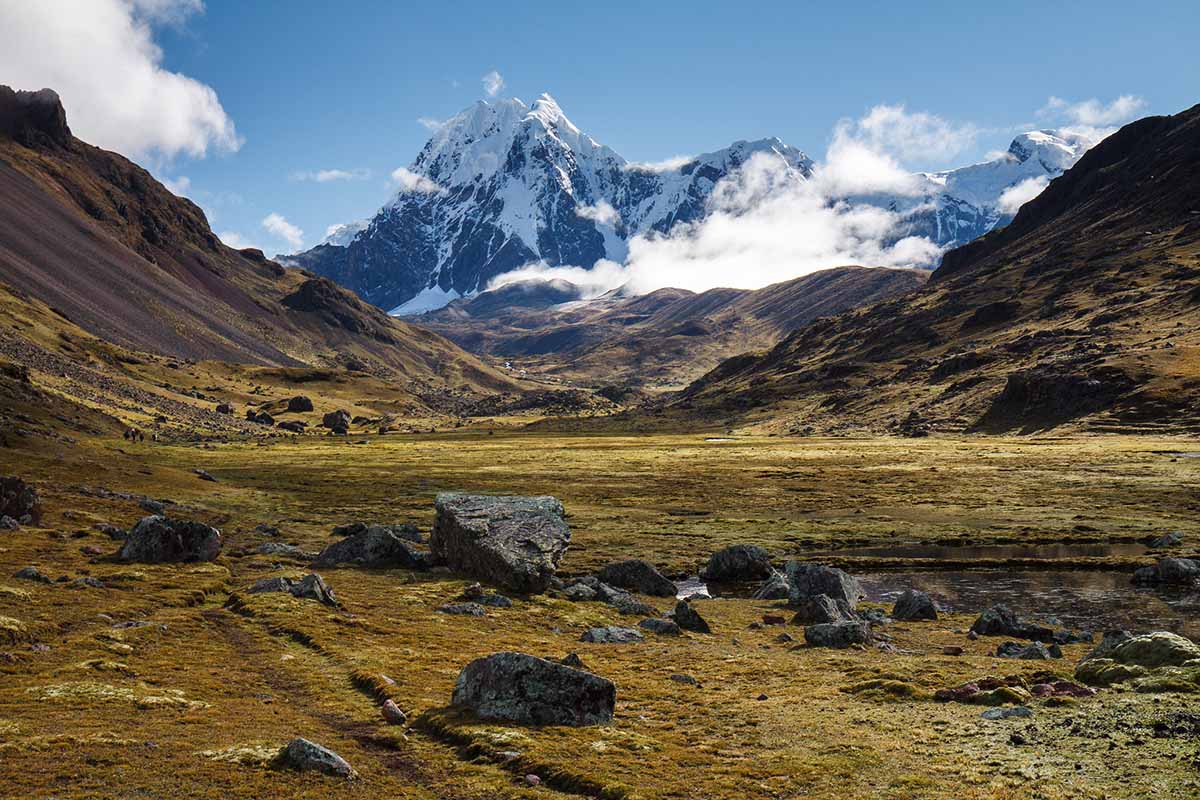
Valley leading to Ausangate Mountain. Image: Ausangate Landscape by Petr Meissner is licensed under CC BY 2.0
Only about 5 percent of hikers do this trek independently. It is only possible if you are a seasoned hiker who is acclimatized with the necessary gear and ample experience backpacking, hiking high elevations, and managing low temperatures/sometimes extreme weather conditions.
We recommend doing this trek with a guide. Between the experienced guides with rich regional knowledge, the traditional meals by local chefs, and the gear being carried and set up from campsite to campsite by local porters, a guided trip notably enhances the experience. Also, you’ll have more time and energy to focus more vividly on the adventure while also supporting the local economy and trek crew welfare.
Check out our Ausangate Trek tour for more information about inclusions for guided tours.
In the Vilcanota Range, there is a dry season and a wet season. The dry season is between May and September, and is considered the best time to hike in the Andes. Keep in mind, however, that the dry season, containing Peru’s winter months, is also the colder time of year. The coldest months are May through July. Expect the days to be cool, no warmer than 40 degrees F, and the nights to drop to freezing temperatures as low as 10 degrees F.
The rainy season is between October and April. While the rainy season is warmer, it can still be cool at night. In fact, there can be heavy snow as well given the elevation. The rain and snow can cause muddy conditions on the trail and even partial closures. It is especially inclimate between January-March, with February bringing the most precipitation. The shoulder months of October and April bring more moderate weather with mixed rainy and dry days.
The Ausangate hike traces through high elevation landscapes ranging between 10,334 ft to as high as 16,800 ft above sea level. The land surrounding the mountain features Andean uplift, glacial valleys with hanging glaciers, Permian formations and cretaceous limestone forests. The trail takes hikers through landscapes bursting with glaciers, snow capped mountains, thermal lakes, high flatlands and lush green valleys.
Traditionally, the 6 day Ausangate trek does not include connection to Machu Picchu . However, if you have extra time to spare, it can certainly be added on. Instead of ending day 6 at Tinki, you would continue on to Laguna Armaccocha, reach a viewpoint and lake Singrenacchocha on day 7, hike alongside the river to Mallma on day 8, and finally board a train to Aguas Calientes , the town at the base of Machu Picchu on day 9.

Machu Picchu. Photo by Ana Sotello of Peru for Less.
Another compelling aspect of the Ausangate trek is that you can conveniently arrange to do Rainbow Mountain as a side excursion. Rainbow Mountain, or Montaña de Siete Colores, is a very popular destination. Here you can see these iconic mountains with rich mineralization bringing red, orange and yellow hues across a seemingly endless mountain expanse. It’s truly a sight to behold.
This part of the trek would bring you to a soaring 17,060 feet above sea level. This portion also tends to be, by far, the busiest part of an otherwise remote journey. It is important to keep in mind the crowds and higher elevation (higher than any other point on the classic Ausangate) to decide if you’d like to add this portion to your Ausantage hike. Talk to a travel advisor for more information.
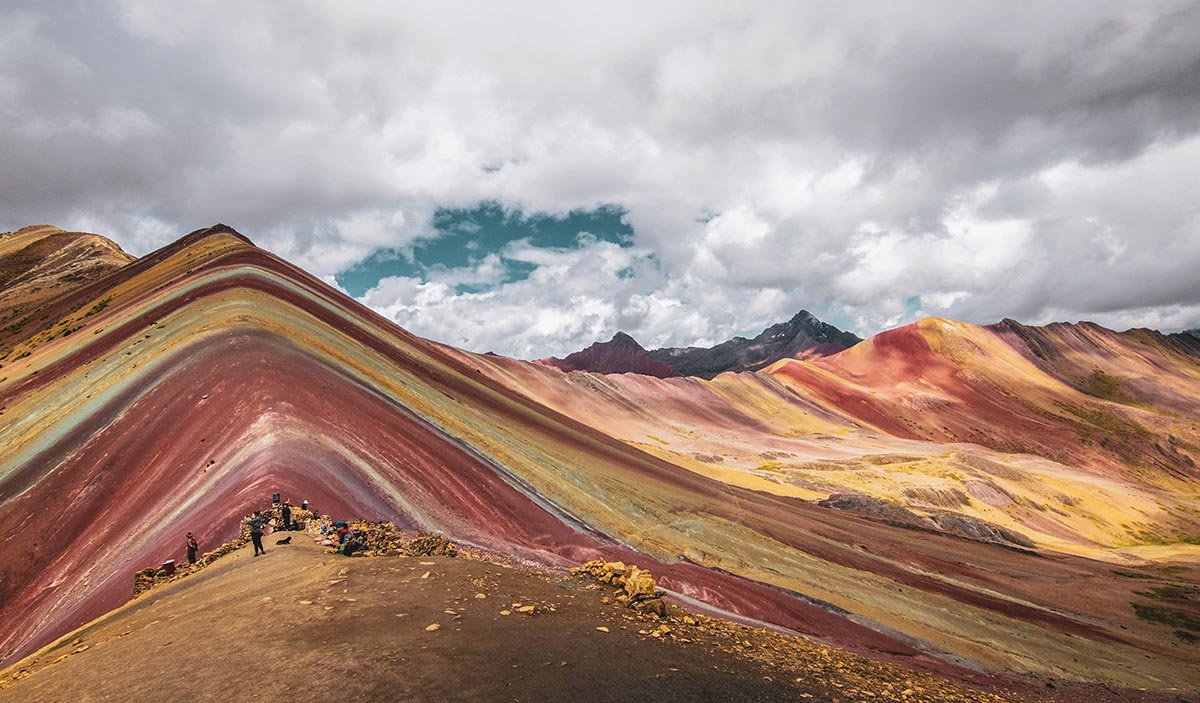
Rainbow Mountain. Image: Unsplash
Altitude sickness, or Acute Mountain Sickness (AMS), is a health effect that can arise at high elevations. Minor symptoms include headache, fatigue, difficulty sleeping and dizziness. More progressed cases can result in vomiting, shortness of breath and high altitude cerebral edema, which is associated with lethargy, nausea and disorientation.
Altitude sickness occurs in 20 percent of people at 8,000 feet and 40 percent of people at 10,000 feet. For a hike like the ausangate trek, it is highly likely that you will experience some form of altitude sickness, as elevations reach as high as 16,800 ft. For this reason, it is important to acclimate properly, take your time on the trail and take measures to combat symptoms.
Measures to combat acute mountain sickness include acclimatizing in the Andes for 48-72 hours, eating a light and high calorie diet, staying hydrated, avoiding smoking and alcohol, easing into the hike and taking breaks whenever necessary. You may also contact your healthcare provider for a recommendation for anti-altitude sickness medication as well. Another local remedy is chewing coca leaves, drinking coca tea or consuming coca candies – a traditional treatment for fighting AMS among the people of the Andes.
Machu Picchu Tours :

It’s best to pack lightly for Ausangate hiking. Generally hikers leave the bulk of their belongings safely in storage at their Cusco hotel , and bring only their hiking pack for the trek. This list ensures that you have everything you need for a guided trek without overburdening yourself.
Clothing
- Long sleeve hiking shirt
- Hiking pants
- Thermal shirt for sleeping
- Long thermal pants for sleeping
- Wool socks (2 pairs)
- Socks for sleeping
- Underwear (2-3 pairs)
- Sports bra (for women)
- Hiking boots with ankle support
- Flip-flops/comfortable shoes for camp
Weather gear
- Lip balm with SPF
- Rain & wind proof jacket
- Rain cover for the backpack
Hiking gear
- Backpack, 50-70L
- Hiking poles (optional but recommended)
- Water bottle
- Water filter
- Purifying tablets
- Zip-lock bags (for money, maps etc.)
Electronics
Toiletries
- Dry shampoo
- Toothbrush
- Toothpaste
- Hand sanitizer
- Small towel
Tipping is not mandatory on a guided Ausangate Trek, but it is highly recommended. You will be amazed by the amount of work and dedication that the guides, chefs, porters and other crew bring to your experience. Tipping is a great way to show your appreciation for the incredible experience. A good rule of thumb is 30-50 soles ($8-$15) per hiker per day. All the hikers on the team can pool their tips and then hand to the trekking team, who will distribute among themselves.
Below is a daily itinerary and highlight breakdown of the classic 6 Day Ausangate trek.
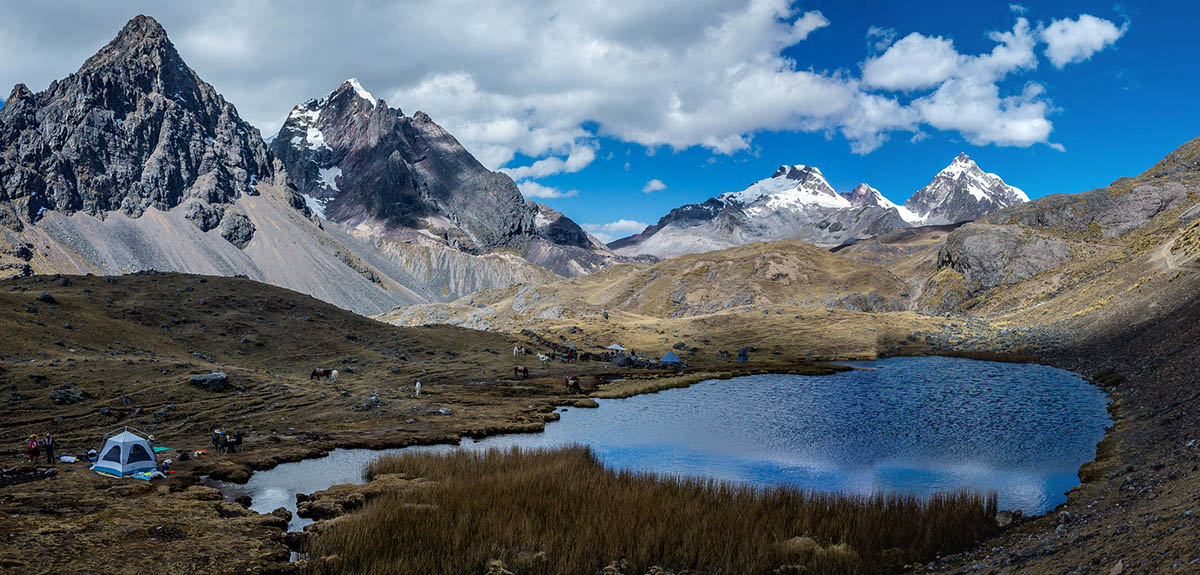
Campsite beside a lagoon on the Ausangate Trek. Image: Trekkers camping near a laguna in the majestic cordillera Vilcanota on the Ausangate circuit by sergejf is licensed under CC BY 2.0
Day 1 : Cusco to Tinki
Day 1 itinerary includes the archeological site of Tipon with its impressive water fountains, irrigation systems, and other marvels of pre-Columbian engineering. It then continues on to the ancient settlement of Pikillaqta, which was originally settled by the Wari culture. Later, you’ll continue on to the beautiful lake of Huacarpay and the town of Andahuaylillas with its famously decorated church, known as the Sistine Chapel of the Andes. Eventually your journey through this ancient landscape ends at the town of Tinki. Approximately 2-3 hours of hiking time.
Day 2 : Tinki to Upis
Start by making your way to the camp of Upis. On the way, you’ll pass by the beautiful ecological landscape of Quinsapucyu and the mountain Huarmisaya. After lunch time, hikers have an opportunity to hike mystical thermal lakes and marvel at the uniqueness of its surrounding glaciers. Approximately 6-7 hours of hiking time.
Day 3 : Upis to Ausangatecocha
Day 3 is the most challenging day of the trek. You’ll start on an increasingly steep trail that leads you up to a high mountain pass at Arapa where you will be rewarded with outstanding views of the entire mountain chain. After Arapa pass, you approach a series of beautiful Andean lakes. In the afternoon you’ll make another climb to the Ausangate pass before descending towards your campsite for the night at Ausangatecocha. Approximately 9 hours of hiking time.
Day 4 : Ausangatecocha to Hatunpampa
Today, you begin your approach to the highest point of the trek, the pass at Abra Palomani. At this point you will be at a breathtaking 16,800 feet above sea level, enjoying unique views of the vast mountain chain that runs below you. From here you descend to the settlement of Huchuy Phinaya and continue on a gentler gradient through high flat land until reaching your campsite in the shadow of snow-capped Hatunpampa mountain. Approximately 9 hours of hiking time.
Day 5 : Hatunpampa to Pacchanta
Starting out for another challenging day, your trail rises immediately towards the second high pass of Abra Janca, dominated by the peak of Colquecruz. From here it’s a gentle descent towards your lunch spot before you reach the town of Pacchanta where you’ll be rewarded with a dip in the town’s mineral rich thermal baths – a perfect chance to relax after a long, demanding day of hiking. Approximately 8 hours of hiking time.
Day 6 : Pacchanta to Cusco
Following the trail from Pacchanta, you eventually return to the town of Tinki, from where you began your adventure. You will celebrate the end of your epic Peru adventure trek with a pachamanca, a unique and ancient style of Andean cooking. Approximately 5 hours of hiking time.
See our Ausangate Trek page, where you can find more in depth information about the daily itinerary, inclusions for the trek, and high and low elevations of trail and campsites. You can also find a form to contact a travel advisor to perfectly tailor your ultimate Peru trekking adventure .
The Ausangate mountain trek, traversing one of the biggest mountains in all of Peru, is like a dream from start to finish. Between the high altitude naturescapes, the spiritual flourishes and the amazing local guides, it’s an adventure like no other. If you want to take to one of the lesser known trails of the mystical Andes, reach out to our team and we’ll be happy to include it in your upcoming Peru travel package .

Start Planning!
Explore all our best-selling packages
See All Packages

Book With Confidence
We're flexible! Postpone your tour with zero cost up to 10 days prior to departure.
Email: [email protected]
Sign up to receive our newsletter for great articles, stunning photos, and special deals.
1-817-230-4971
Sales & travel support
Ausangate Trek in Peru: All You Need To Know in 2024
If you are looking for the ultimate adventure, the Ausangate Trek is by far one of the best treks in Peru!
Reaching altitudes of 5400m, the Ausangate trail offers an ‘off the beaten track’ experience boasting turquoise glacier lakes, snow-capped peaks, rainbow mountains, hot springs, and much more!
I personally embarked on a 7-day Ausangate Trek Peru and have put together this complete guide with everything you need to know before you go.
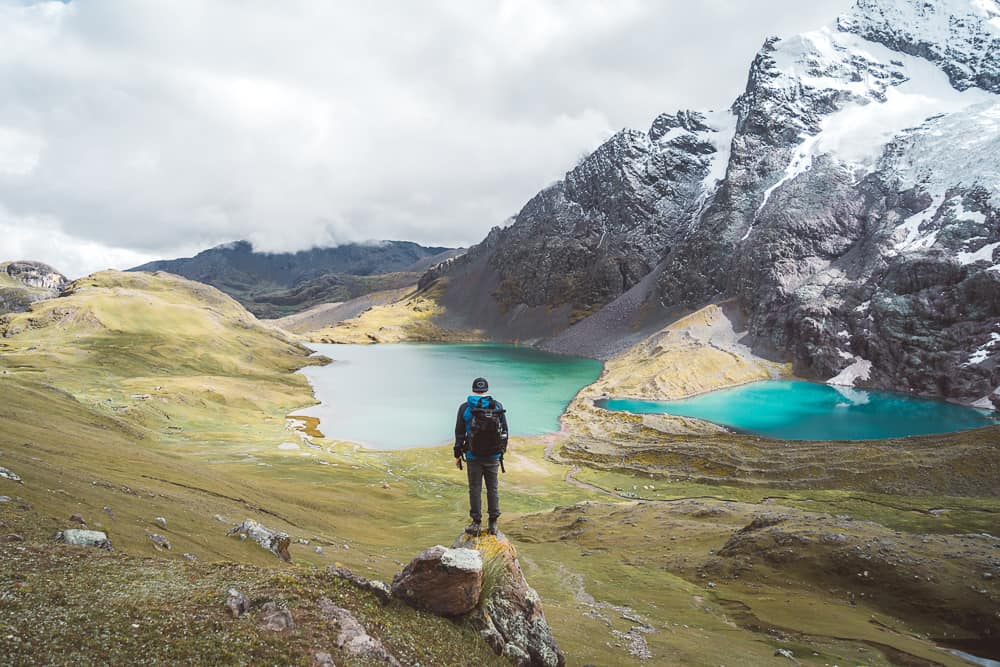
Table of Contents
QUICK ANSWERS: AUSANGATE TREK PERU
Before I go into more details about the Ausangate Peru Trek, here are some quick answers to first-time visitors’ most frequently asked questions.
AUSANGATE STATS – ALTITUDE, DISTANCE, DIFFICULTY
Before you trek Ausangate, see this list of essential things to know before you go;
- Altitude – 3,700m to 5,400m
- Terrain – glacial, rocky trails and high passes
- Acclimatization – 2 to 3 days in Cusco is recommended before Ausangate trekking
- Distance – 5-day trek/7-day trek (67km) & 9-day trek (100km)
- Difficulty – strenuous, lengthy, and high altitude
- Weather – rain, wind, snow, hail, and sunshine (best time to go is from March to November)
- Food – all food and drinks are included during the trek, along with porters and chefs
- Accommodation – tents, mattresses, pillows, and sleeping bags are provided upon request
BEST AUSANGATE TREK TOUR
The best way to visit is to join an Ausangate Tour !
It includes transportation from Cusco, meals, camping gear, a fun group, and a knowledgeable guide!
WHERE IS AUSANGATE MOUNTAIN?
Ausangate Mountain is located in the Vilcanota Mountain Range in Peru.
From Cusco, it’s approximately a four-hour drive to reach a small village called Tinki, which is the starting and finishing point for most Ausangate Treks.
Click here to see the location on Google maps.
BEST TIME TO DO THE AUSANGATE TREK?
The best time to go is between March and November which is the dry season in the Andes and calls for clearer days and beautiful scenery.
That being said, the weather here is unpredictable so expect a mix of cloudy and sunny days, as well as cold temperatures, as you’ll see in the photos in this guide.
HOW MANY DAYS FOR THE AUSANGATE PERU TREK?
To make the most of your experience, I recommend taking 7 days and 6 nights to complete the trek.
This will give you enough time to acclimate to the elevation, take in the scenery, and fully immerse yourself in the culture and customs of the local communities.
CAN I BOOK AN AUSANGATE TOUR?
There are many tour operators in Cusco that offer tours and treks to Ausangate, however, it can be overwhelming to decide which one to book.
I personally booked my trek with Killa Expeditions, the most reputable and experienced tour operator in Cusco, and I can’t recommend them enough!
They go above and beyond to make sure their guests are comfortable, happy, and most importantly safe on all their trips.
Click here to see all Ausangate tours and treks on the Killa Expeditions website.
If you decide to book the Ausangate trekking tour with Killa, be sure to let me know because readers of my blog are eligible for a $100 discount . Get in touch with me via email to claim.
MY EXPERIENCE ON THE AUSANGATE TREK PERU
Read on to learn more about the Ausangate trek itinerary and my own experience on the tour.
Day one of the trek began with a 6 am hotel pick-up from Cusco for an approximately four-hour drive to a small village called Tinki, the starting point of the trek.
About halfway to Tinki, we stopped at a viewpoint that overlooks a vast valley in the region and we were each given a boxed breakfast to fuel our bodies.
We arrived in Tinki and unloaded the bus with our bags, Ausangate trekking gear, tents, and supplies to hand over to the porters who then mounted all the gear onto the horses.
It was all about to begin and I was honestly a little nervous as I had never before done a trek that lasted longer than three days nor at high altitude.
Furthermore, our guides pumped us up with a motivational speech and before you knew it, we were off along the trailhead towards Ausangate Mountain.
The first part of the Ausangate circuit trail eases in along a path that gently ascends as it leads away from civilization and into the mountains. We came around a bend to see the lunch tents already set up by the porters and chefs!
They had prepared a 3-course meal with some hot tea, ready for us to indulge. In saying that, every meal on the 7-day trek consisted of 3-courses including tea, coffee, juices, fruit, snacks, and fresh drinking water!
It was luxurious, to say the least, and I was very impressed by the efforts that the Killa Expeditions staff went to in order to make us all feel satisfied.
After lunch, we continued hiking for another two hours or so through vast fields of green, passing by scattered stone houses and herds of alpacas.
Our campsite was located in a place called Upis for the night and we arrived just in time to take some photos of a flowing river with the almighty Ausangate peak in the backdrop!
There are also hot springs here if you wish to take a hot dip.
Dinner was served shortly after sunset, which was absolutely delicious, and then the porters offered us hot water bottles to take inside our tents for extra warmth during the night.
Safe to say that day 1 of 7 was off to a great start!
Day two of the trek began bright and early for breakfast at 6 am before continuing on the Ausangate circuit trail at around 7 am.
A three-hour hike up to Arapa Pass which sits at 4,800m and incredible views of Maria Huamantilla Mountain and Ausangate Mountain can be seen from here.
From the Arapa Pass, we then descended across some epic trails through the valley and down to our lunch spot which was set up beside one of the glacier lakes, boasting a small waterfall at one end.
I was already starting to feel the burn in my legs and headaches from the altitude sickness, but I had some electrolytes and Panadol to keep me going.
After lunch, we then hiked for a further two hours over the Pucaccocha Pass and down to Pucaccocha Lake which was formed by a melting glacier.
I was in complete awe of my surroundings on this particular afternoon, as around every corner we came across scenes that reminded me of ‘The Land Before Time’ and ‘Jurassic Park’.
See the pictures below and you’ll know what I’m talking about when I say it’s one of the best treks in Peru!
The camp was already set up by the time we had all arrived and again, another 3-course dinner was dished up that was very much appreciated.
By day three of the Ausangate hike, I felt as though we were well and truly off the beaten path, deep inside the mountains of Peru , and the truth is, we actually were!
It was an incredible feeling of solitude and being detached from phones, laptops, and electricity for the week was great!
After a hearty breakfast, we were all pumped to see what day three had to throw at us! Well, it was off to a steep climb for around two hours to the Puca Pass which sits at 5,050m.
This was by far one of my favorite mornings – rolling hills, jagged peaks, turquoise lakes, and the Rainbow Mountain ranges were just some of the phenomenal sights that can be seen from the top of Puca Pass.
The lunch spot was a further two hours’ descent into Chilca Valley, passing more beautiful lakes and lush green landscapes.
After recharging our batteries here, it was time to hustle over the second mountain pass for the day and down to Yanacocha Lake where the campsite was set up.
With Rainbow Mountain a further one-hour hike away from the campsite, we were given the option to make it there for sunset and also for sunrise the following morning.
As Rainbow Mountain had been on my bucket list for years I couldn’t pass up the opportunity to visit it twice!
So we dumped our bags off in the tents and made the one-hour hike to Rainbow Mountain, making it just in time to catch the sunset!
Was it worth it?! Hell yeah! There was no one else in sight which is a rare opportunity at this location, as it is the second most visited site in Peru, after Macchu Picchu.
Feeling completely wrecked after a massive day of trekking on day three, arriving back at the tents in one piece was a godsend. I had a quick feed for dinner and then went straight to bed.
Full Blog Post: Rainbow Mountain Peru
Pssst! Check out this EPIC Hiking Backpack!
Perfect for shorter day hikes, the Osprey Stratos 24L is a tough pack made from sustainable materials.
With great internal organization, this is all you need for your next adventure, no matter the weather!
A super early rise for everyone on day four to make the same one-hour hike back to Rainbow Mountain for sunrise.
To our surprise, there was 2 to 3 cm of snowfall overnight, covering the trail and surrounding mountains in a light dusting of snow.
This meant that Rainbow Mountain was going to have an extra color too! And sure enough, when we arrived at the viewpoint it was one of the most beautiful sights I have ever seen!
A light dusting of snow had fallen over Rainbow Mountain, though some colors were still poking through.
Myself and the rest of the squad were absolutely mind-blown at this incredible sight! Although there wasn’t really a banger sunrise, the snow-capped Rainbow Mountain made up for it.
Again, we had the entire mountain to ourselves for a couple of hours before the herds of tourists started to arrive and this is when we made our departure to the next spot.
Our guides took us on a short detour into the Red Valley for a quick photo and then we continued our hike to Quesouno for lunch.
With full bellies, the adventure pushed on for a couple more hours upstream to the beautiful Ausangatecocha Lake and this is where we set up camp for the night.
Must Read: 3 Week Peru Itinerary
I must admit, getting up on day five was a bit of a struggle. All of my muscles were sore, headaches were forever existent and a lack of motivation was present.
However, with the support of the other trekkers, all of whom were good mates by this stage, they encouraged me to keep on keeping on.
After breakfast, we began a steep climb for two hours to the Palomani Pass, the highest peak of the trek at 5, 400m above sea level!
A panoramic viewpoint awaits at the top with extensive views of countless mountain peaks in the Cordillera Vilcanota region and a birds-eye perspective of Ausangatecocha Lake.
The trek continues down into Huchuy Finaya Valley where we stopped for lunch before making our way to Comercocha to camp for the night.
The snaking river on the way to Comercocha is absolutely amazing and this Ausangate trail boasts incredible views of the distant Las Dos Gemelas, also known as the Two Twin Mountains.
Read More: Macchu Picchu Guide
Day six is essentially the last big day of Ausangate trekking through the Pampacancha Valley along a rocky trail with some of the best mountain views on the trek so far!
There is also an abundance of wildlife through this valley, so keep your eyes peeled.
The last leg of the trek goes up and over the Qampa Pass offering insane views of the Three Peaks and Pacchanta Valley.
From here the final descent begins between Ausangate Mountain and Two Twin Mountains, passing by glacial moraines, vibrant lakes, and snow-capped peaks and eventually emerging at the campsite a few hours later.
The best part about this final campsite in Pacchanta is the thermal hot springs and also a convenient store to buy snacks and cold drinks etc. A well-deserved soak in the hot springs will set you back 10 Soles.
Our guides gave us the option to either be picked up by the minivan the following day from Pacchanta or trek a further three hours in the morning back to Tinki Village and be picked up from there.
It was an easy decision for the entire squad as we were all very exhausted from the trek, so we opted to finish here at Pacchanta and take the easier option of the mid-morning van pick-up.
Furthermore, we bought a bunch of beers, had a dip in the hot springs, and celebrated our completion of the 7-day trek.
Feeling slightly tired and hungover, we managed to heave ourselves out of our tents for one last breakfast.
The van arrived at around 9 am and we thanked our guides, porters, and chefs for their amazing services before taking off on the long drive back to Cusco , stopping in at a small lakeside town for lunch.
Overall, I rate the Ausangate trek Peru with Killa Expeditions a 10 out of 10 and highly recommend it to anyone who is searching for the best trek in Peru!
AUSANGATE TREK COST
The Ausangate trek cost depends on whether you go with a tour guide or on your own.
I personally recommend going with a guide, but I’ll go through each option in more detail below.
AUSANGATE TOUR COST
The recommended way to do the Ausangate hike is with a tour, and the price is the following:
- $534 for Ausangate Trek 3 days
- $579 for Ausangate Trek 4 Days
- $690 for Ausangate Trek 5 Days
- $1,050 for 6 days
- $1,641 for 9 days
While these prices may seem steep, the tours include everything, from meals to transportation to camping gear and everything in between, so you pay for the convenience.
I recommend booking online before coming as it’s relatively cheaper.
COST OF AUSANGATE TREK WITHOUT GUIDE
On the other hand, if you plan to do the Ausangate Trek without guide, it’ll be a cheap expedition – That is, if you already have all the gear.
Here are the fees involved:
- Transportation from Cusco: USD $6 return
- Food shopping: USD $30-40
- Gear rental: USD $50 to $100 per person.
- Red Valley entrance fee: USD $6 per person (10 soles at the entrance, 10 soles at the exit)
In total, you’ll spend about $100 to $150 in total, which is much cheaper than a tour, but it’s not as convenient and you’ll have to spend your time alone the whole trek.
WHERE TO STAY IN CUSCO
Cusco is the best place to stay before and after Ausangate trekking.
There are hundreds of accommodation options to choose from, so I have narrowed it down to a few of the best places to stay in Cusco to fit the needs of budget backpackers, luxury travelers, and everyone in between.
Luxury: JW Marriott El Convento Cusco
An unforgettable stay at any Marriott Hotel around the world is never a bad choice.
This particular Marriott boasts beautiful interiors with antique exposed bricks and it’s just a few minutes walk to the main square, Plaza de Armas.
The rooms are elegantly styled featuring cable TV, wifi, a minibar, and a private bathroom. Oxygen-enriched rooms are also available for those who struggle with high altitudes.
Mid Range: Tambo del Arriero Hotel Boutique
A charming colonial boutique hotel located in the Nueva Alta neighborhood, a short walking distance to the San Pedro Market and Cusco’s main square.
The rooms are spacious and cozy featuring a TV, iPhone docking station, free Wi-Fi, work desk, warm heating, and some even boast a private jacuzzi.
Budget: Selina Saphi Cusco
There are countless hostels in Cusco but there is only one Selina. It features a garden, a restaurant, a bar, and a central location just a few minutes walk to the main square!
There are cozy dorm rooms and private rooms available at a very affordable price and breakfast is included.
In addition, guests have access to a shared kitchen and can enjoy free Wi-Fi throughout the hostel.
FOR ALL OTHER PLACES TO STAY IN CUSCO, SEARCH ON BOOKING.COM
What to pack for ausangate peru.
When visiting Ausangate Peru, here are a few items I recommend taking with you:
Must-Have Travel Essentials
Hidden money wallet.
Keep your cash and other valuables safe with this anti-theft hidden money wallet!
Reusable Water Bottle
The GRAYL GeoPress is the best reusable bottle that allows you to purify water from anywhere!
Travel Backpack
The Nomatic Travel Backpack has 20+ innovative features, perfect for everyday use!
Quick-Dry Travel Towel
The most compact, lightweight, and quick-dry towel for traveling!
Portable PowerBank
Keep your phone, laptop, and accessories charged while you’re on the go with the Anker PowerBank!
More Peru Travel Guides
Click the button below to view all articles related to Peru!
FINAL THOUGHTS – TREKKING AUSANGATE
If you have any questions at all about trekking Ausangate, please leave me a comment below this post and I will get back to you as soon as I can.
For a quicker response, be sure to join Jonny Melon’s Travel Tribe on Facebook and post your questions or recommendations to our awesome community.
TRAVEL RESOURCES FOR YOUR NEXT TRIP
Whether you’re a seasoned traveler or it’s your first trip overseas, here are some useful travel resources to help you kick-start your next adventure!
Search and book accommodation worldwide.
Compare and book cheap flights to anywhere.
Find tickets, tours, and experiences around the world.
Book buses, trains, and transfers online in advance.
Search all rental cars in your next destination.
Need travel insurance for your next trip?
THANKS FOR READING
Hey friend, thanks for reading this guide!
Please know this post may contain affiliate links. When making a purchase through one of my links, I earn a small kickback at no extra cost to you and it’s a big help to keep the site up and running. Rest assured, I only promote products and services that I personally use and recommend.
Click here to find out how you can support the site organically .
Many thanks!
PIN IT FOR LATER
2 thoughts on “Ausangate Trek in Peru: All You Need To Know in 2024”
Hello, Thank you for this article! I’m wondering, what month did you do the trek in? Thanks!
Hey Isaac, I did this trek at the end of April. Enjoy 🙂
Leave a comment Cancel reply
Notify me of follow-up comments via e-mail.
Plan Your Trip
Travel Guides
Destinations
Hotel Guides
Find Best Tours
Travel Gear
Travel Resources
How To Start A Blog
Photography Guides
Support the site
Follow On Socials
© 2024 Jonny Melon Adventure Travel Blog. All rights reserved.
Privacy Policy | Terms | Sitemap
Get a FREE Essential Travel Apps and Websites Checklist!

2-Day Ausangate Trek to Rainbow Mountain, Peru – A Complete Hiking Guide
In this blog post we’ll tell you everything you need to know about hiking the 2-day Ausangate Trek to Rainbow Mountain.
This particular trek brings you up close to Ausangate Mountain, the highest peak in the Cusco region. It also takes you to the popular Rainbow Mountain that’s mostly visited as part of a day trip from Cusco.
If you enjoy trekking and would love to escape the crowds you get on the Inca Trail or Salkantay Trek, then this hike is for you! In this guide we’ll answer every question you may have about altitude, level of difficulty, accommodation, food options and what to wear and pack for an unforgettable adventure in the Andes.
If you’d like to see our adventures, then check out the Ausangate to Rainbow Mountain hiking video on our YouTube Channel. For more Peru videos check out our Peru Playlist .
Disclosure: This post may contain affiliate links, which means we may receive a small commission if you click a link and purchase something. Clicking these links won’t cost you anything, but it will help us to keep this site up and running! Learn more about our affiliate policy.
Table of Contents
About Ausangate Mountain
The Ausangate trek is named after the Ausangate Mountain located around 100 km (62 mi) southeast of the city of Cusco. It is part of the Vilcanota mountain range and at 6,384 m (20,944 ft) it’s the highest mountain in the Cusco region and the fifth highest mountain in Peru. Apparently, you can even see it from the Sacsayhuaman Inca site in Cusco.
Ausangate is also one of the sacred mountains of the Andes, also known as ‘apus’. The area around Ausangate consists of vast plains, glaciers and turquoise lakes like Sibinacocha and is inhabited by llama and alpaca herding communities.
According to Inca legends, Ausangate and Salkantay were brothers living in Cusco. They ventured out to save Cusco after a dry season. Apparently Salkantay went north where he found the Amazon Jungle whereas Ausangate went south and found the typical food of the highlands.
Every year, a week before the Corpus Christi feast, a festival takes place near Ausangate called Qoyllur Rit’i or ‘Snow Star’. During this festival thousands of people make a pilgrimage to the temple of Sinakara. Since 2004 this pilgrimage has been named an Intangible Cultural Heritage of Humanity by UNESCO.
Summitting Ausangate normally takes 5 days, which makes it one of the most challenging trekking routes in the Peruvian Andes. The first expedition to scale the mountain was in 1950. A few years after the first attempt, a German expedition managed to scale the southern slope. The northern face had never been climbed until May 2023, when Yudai Suzuki and Kei Narita from Japan made the very first ascent. They named the route ‘Japones Directo’.
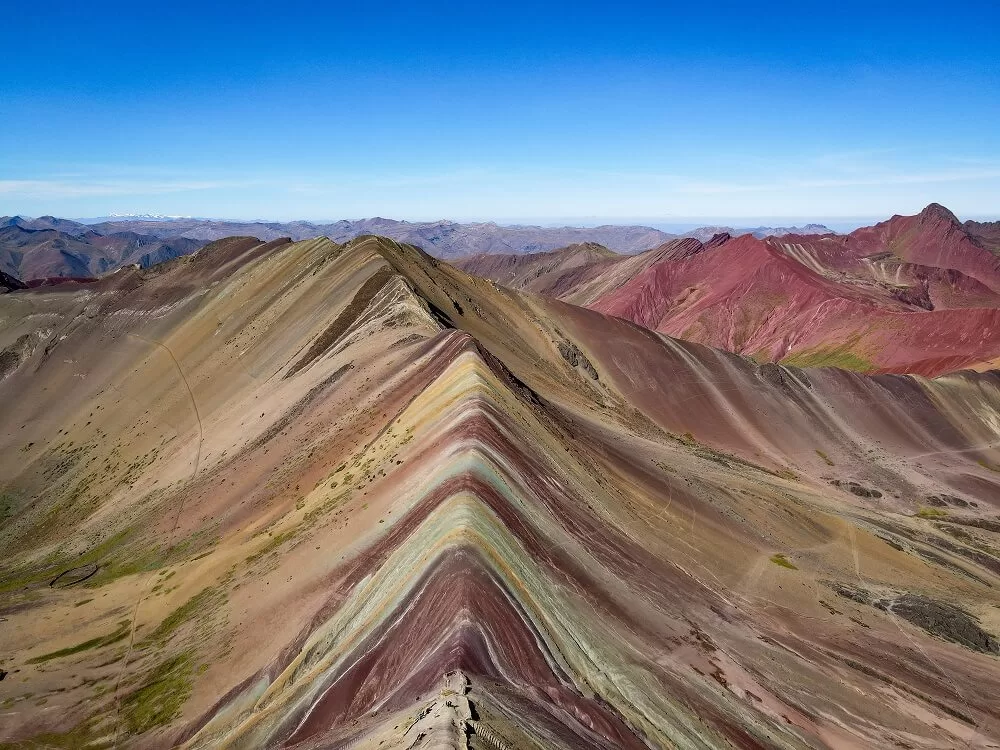
About Rainbow Mountain
Possibly the second most popular day trip from Cusco , after Machu Picchu , is the Rainbow Mountain . The mountain is also known as Vinicunca, Winikunka, Montaña de Siete Colores, and Montaña de Colores.
Vinicunca Rainbow Mountain wasn’t even visible until about 2015. This is because it was covered in a thick layer of snow and ice. Then, due to climate change, the snow melted and revealed the colourful mountain beneath.
The subduction of the Nazca and South American plates which created the Andes mountains also produced volcanism and varied mineralogy. Over time the sedimentary deposits and environmental conditions formed a series of colourful layers such as red, orange, turquoise, blue and green.
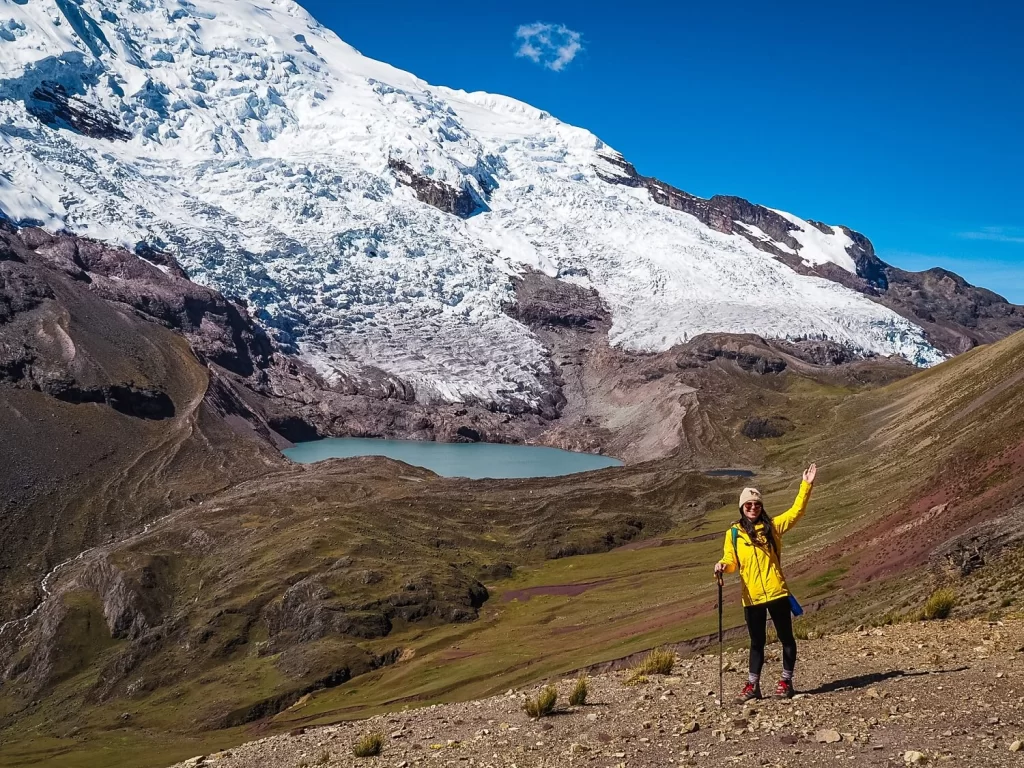
Booking the Ausangate to Rainbow Mountain Trek
Below are a few important facts you should read before booking the Ausangate Trek as not all of them include Rainbow Mountain in their itineraries.
Different Ausangate Trek Packages
There isn’t just one version of the trek you can book. The 2-day trek is the shortest one, but you can opt for an even longer version if you wish.
The Classic Ausangate Trek (5 Days)
During the Classic 5 days 4 nights Ausangate Trek, you’ll be trekking for over 55 km (34 mi). The trek will take you over at least 4 different mountain passes, past colourful lakes, incredible views and small Andean communities. The highest point along this trek is 5,200 m (17,060 ft) and you’ll be hiking close to 5,000 m (16,400 ft) most days, so this trek isn’t for beginners. It also doesn’t go to Rainbow Mountain.
Ausangate Trek to Rainbow Mountain (4 Days)
This 4-day trek will take you to Rainbow Mountain. You’ll have to hike for about 38 km (24 mi) and will reach Rainbow Mountain on your last day. The highest elevation will be around 5,100 m (16,732 ft) at Rainbow Mountain. Depending on the tour you book, you can also take a short hike in the Red Valley.
Ausangate Trek to Rainbow Mountain (3 Days)
This is a slightly shorter version of the 4-day trek. You’ll be hiking around 34 km (21 mi) which isn’t much shorter than you’d be hiking on the 4-day version itself. You’ll get to Rainbow Mountain on your last day which is also going to be the highest elevation you’ll reach along the entire trek.
Ausangate Trek to Rainbow Mountain (2 Days)
This is the shortest version of the Ausangate Trek that would also take you to Rainbow Mountain. You’ll only be walking for around 18 km (11 mi) over the course of the two days. We’ll describe this exact trek in more detail below.
Ausangate and Sibinacocha Trek (7 Days)
Trekking enthusiasts can also embark on a 7 day long adventure around the Ausangate Mountain and Sibinacocha Lake. The max altitude along this trek will be around 5,400 m (17,716 ft) so it’s not for the faint hearted. Note that this trek doesn’t include Rainbow Mountain.
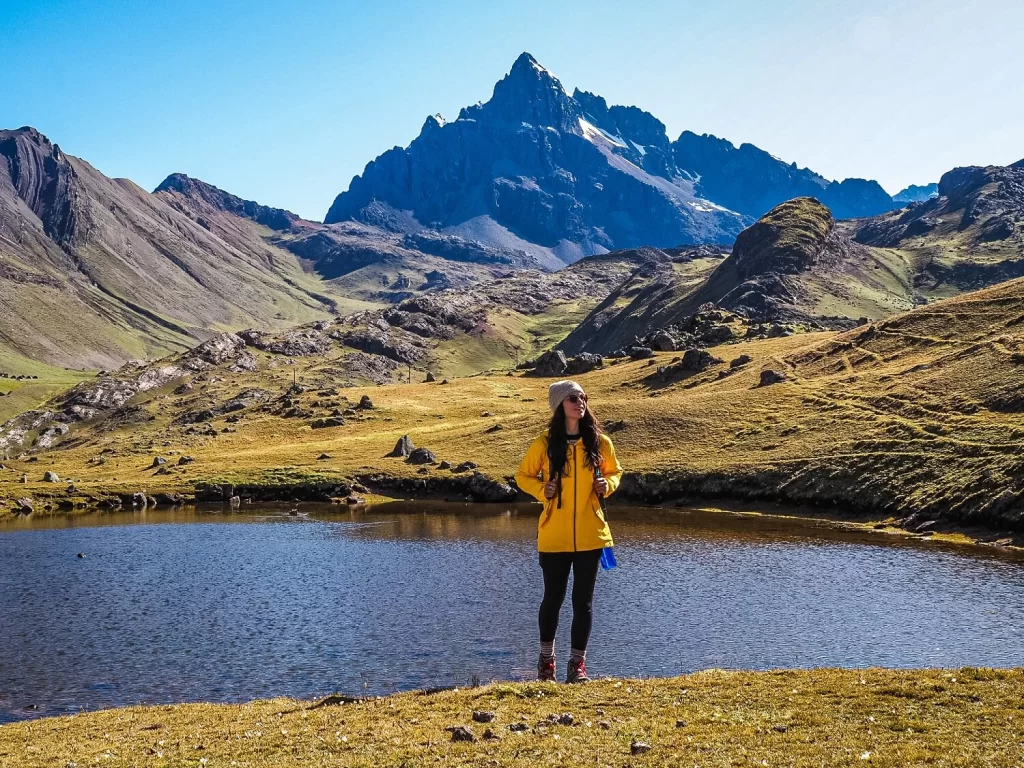
Do You Need a Guided Trek or Can You Hike the Ausangate Trek Independently?
You can hike the Ausangate Trek without a guide. However, we only recommend doing this if you’re an experienced hiker and have completed many treks independently before.
Depending on which route you’re completing this trek is generally pretty remote. There are some lodges available, so it’s worth checking if you can book these for the night. We definitely saw one on our 2-day trek not far from where we camped.
If you’re planning on doing a longer trek, then you should have your own camping gear and food with you. Carrying that load at such high altitudes isn’t easy, so you have to be sure that you’re fit and capable enough.
Lastly, if you’re hiking without a guide, you’ll likely have to pay entry fees to the park or even a small fee to camp or walk along the trails. It’s good to know a few words in Spanish or Quechua and have offline Google Translate on your phone because you won’t have much signal out there.
The lack of signal is also why it’s important to let others know about your itinerary and if you can, don’t hike alone.
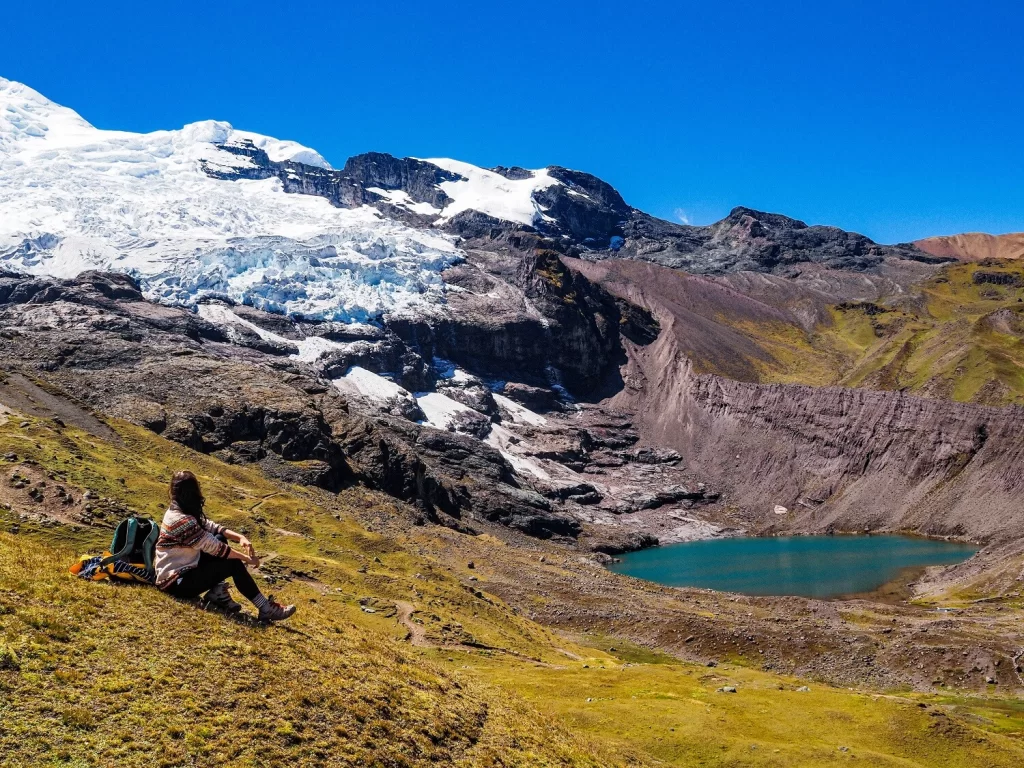
Best Time to Hike the Ausangate Trek
The best time to hike around Ausangate is between the months of April to October. Peru has two main seasons, dry and rainy. The rainy season is normally from November to April and the dry season is from May to October.
As you would expect, during the rainy season the trail can be pretty muddy and just not that enjoyable to camp and hike on. Mudslides are also common, which could make the trail dangerous or impassable in places. For this reason, we recommend avoiding the wet season especially from November to mid-March.
Between April and October you’ll have a higher chance of a sunny and enjoyable trek. However, the dry season has its challenges too.
The nights can become very cold so you’ll need to prepare with warm layers. It’s hard enough to sleep at such high altitude without being freezing all night. This also means that the ground can very well be frozen in the morning or even covered with snow.
Generally speaking, you’ll be hiking in high altitudes, and close to the mountain, therefore the weather can still be unpredictable.
How Much Does the Ausangate Trek Cost?
Depending on the company you’re doing it with, the average cost of the 2-day Ausangate Trek is around $200-$250 USD per person.
If you opt for a longer trek, the price will automatically increase. The above price range is also more likely to include one night camping. If you go with a company that offers a lodge stay, then expect the price to be higher.
Normally the price won’t include sleeping bags, walking poles or tips for your guide, horseman and cook. Make sure to calculate this extra cost into the final price when booking.
We suggest reading a bit more about the company and how they treat their staff. If a tour is too cheap they probably don’t pay their staff fairly, and you might want to opt for a more expensive one or tip the staff well. They deserve much better compensation than what they get for their hard work.
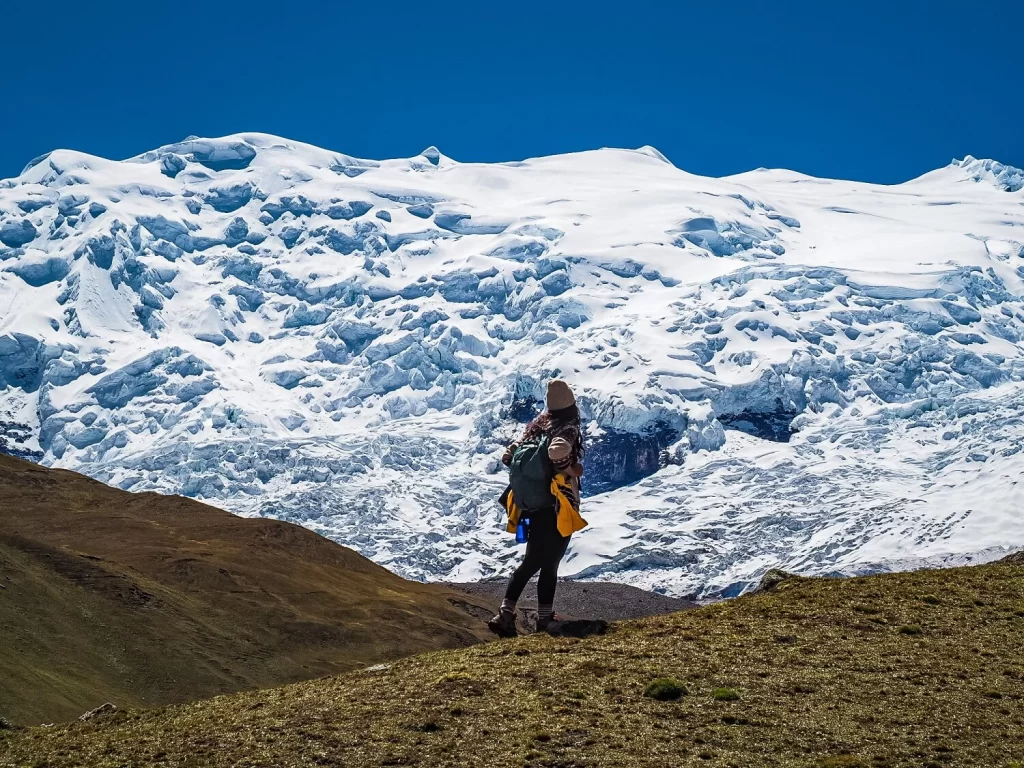
Do you Need Special Travel Insurance to Hike the Ausangate Trek to Rainbow Mountain
We cannot emphasize enough how important it is to have travel insurance before any trip you make abroad. Now, most travel insurance won’t automatically include cover for all the activities you’re planning on doing during your travels.
For example, if you’re visiting Peru, and planning on hiking in high altitudes, then you should have cover for high altitude trekking in your insurance policy. Make sure to shop around to find the most suitable one. You just never know what could happen and it’s better to be safe than sorry.
Best Ausangate Trek Tour Companies
There are quite a few companies you can choose from. We read good reviews about the following companies:
- Salkantay Trekking,
- Alpaca Expeditions,
- Ausangate Trekking, and
- Conde Travel.
These are just a few of many. For reference, we went with Peru Hike and had a great experience. As always, we recommend reading about what’s included in the tour, any additional costs and a bit more about the company’s background before booking.
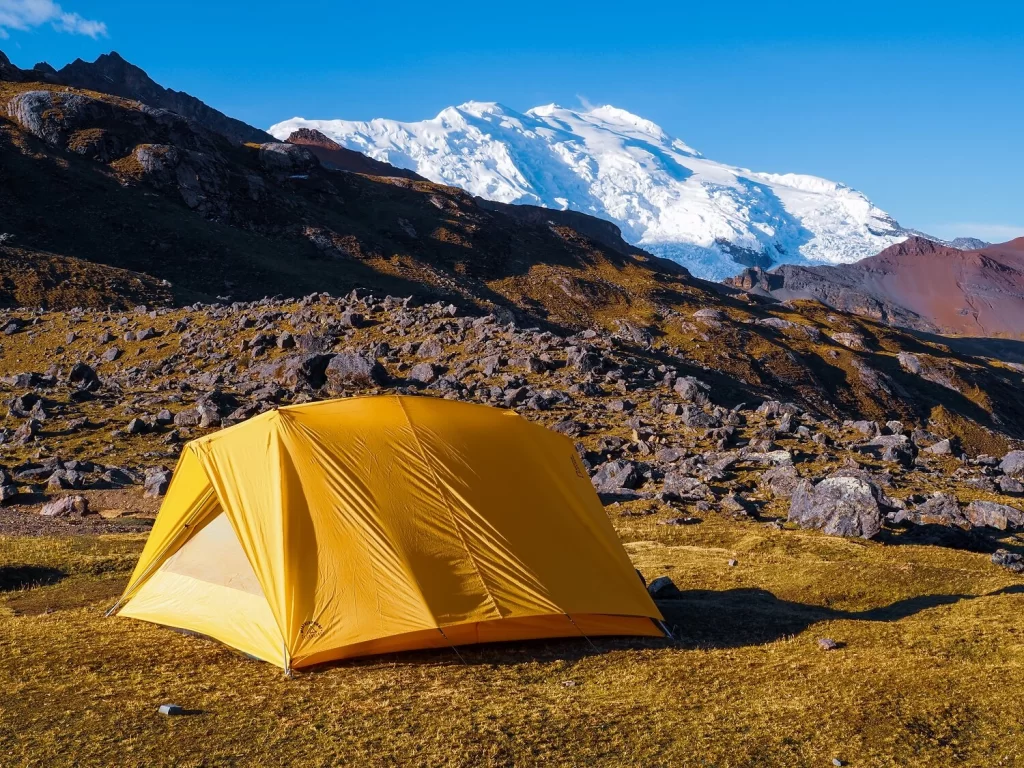
Accommodation Options Along the Ausangate Trek
Most versions of the Ausangate Trek will include camping. Tents are normally included in the tour cost, but you’ll have to rent additional items such as sleeping bags.
Top Tip – If you know that you’ll be completing a few treks in Peru , then you can pack your own sleeping bag to save on renting one each time you sign up for a new trek.
Some treks might include a lodge stay, such as at Anantapata Lodge. If you don’t want to camp, then make sure to find a company that offers a lodge or cabin stay. Just note that these will generally be more expensive.
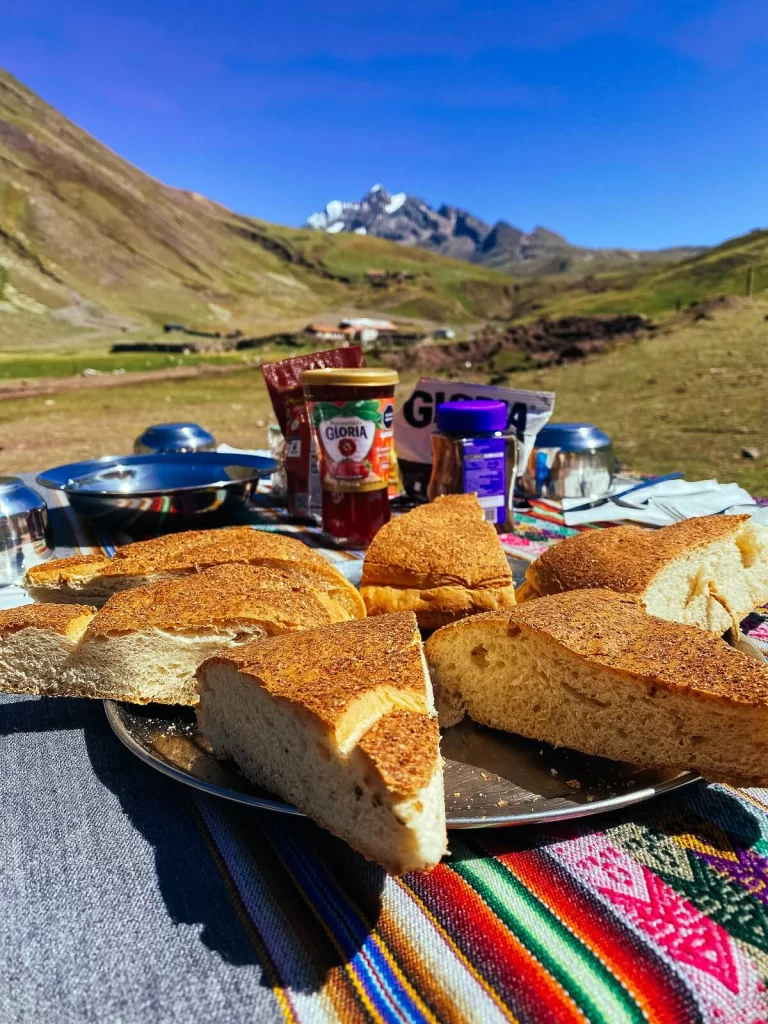
Food and Water Options Along the Ausangate Trek
Depending on the company you book with, food is normally included in the price. You’ll be provided with breakfast, lunch and dinner on your hike. Some companies won’t include breakfast on the first day of your hike or dinner on your last day.
Normally the cooks will cater for a variety of diets, so you won’t have any issues if your vegetarian or vegan. We don’t have any personal experience with allergies, so it’s worth reaching out to companies to see how they can accommodate you.
The cooks are basically magicians, and can somehow create the most flavourful dishes out in the middle of nowhere.
In terms of drinking water, cooks will normally boil the amount of water each hiker from the group will need between meals. We didn’t have any issues drinking this water, but we had a water purifier bottle for extra security.
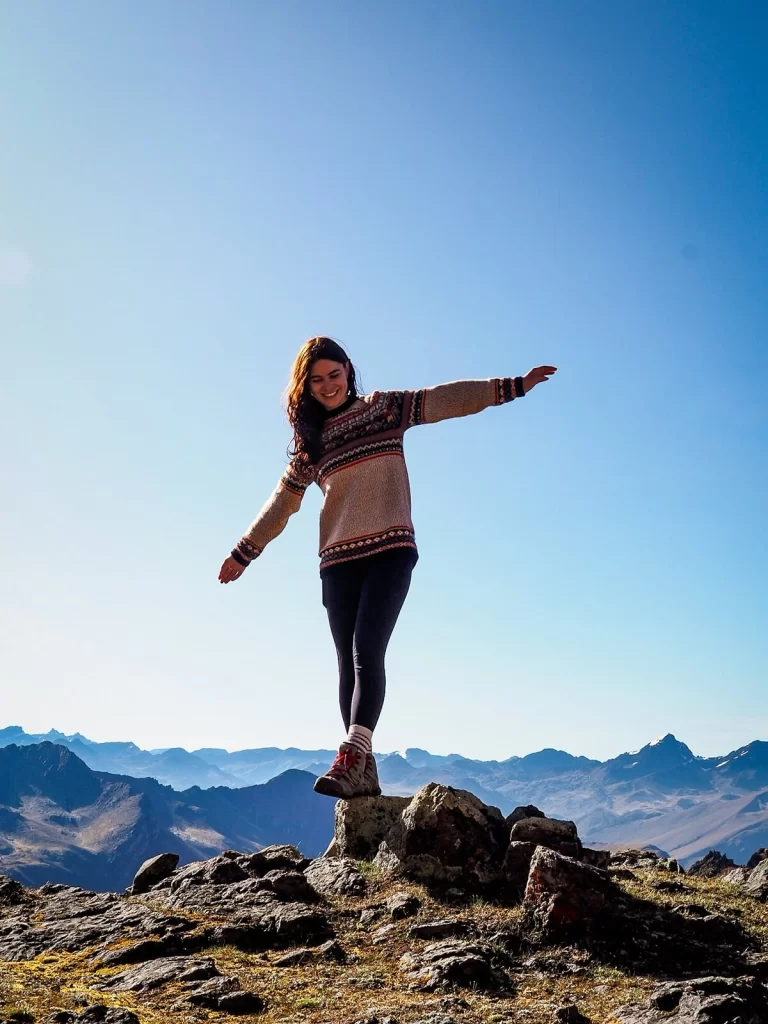
What to Wear and Pack for the 2-Day Ausangate Trek
Let’s talk about what to pack for the Ausangate Trek. Ideally, you’ll want to carry a daypack that fits everything you’ll need for one night.
Clothing Items
In terms of a hiking outfit, we recommend packing for cold temperatures. You’ll definitely need long trousers, fleece, hat and gloves on this hike. The temperatures will change a lot during the day so definitely wear layers. Make sure to also pack waterproofs like a rain jacket .
In terms of footwear, it’s important to wear hiking boots or shoes that have good grip and support. You can pack some flip-flops or slides that you can change into after your hike when you’re around the campsite.
Obviously, make sure to pack everything you need for a night such as pyjamas, and a few basic toiletries.
Electronics
In terms of electronics , don’t forget to pack your phone and camera gear. If you’re camping you won’t be able to charge your devices, so we recommend taking a portable charger .
Bring a torch or headlamp! They will be essential when moving around the campsite after dark and in the morning when you’ll start the hike at the crack of dawn.
Accessories and Other Items
In terms of accessories for the hike, we recommend taking a reusable water bottle, sun-cream, a hat or cap and sunglasses for protection. Lastly, but most importantly, have enough cash on you to pay for anything extra such as tips for the guides.
We suggest having a basic first-aid kit with you containing some painkillers, altitude tablets, band-aids and any prescribed medications.
Make sure to have your ID card or passport with you in a waterproof case.
All in all, try to pack as lightly as you can because, unlike with the Inca Trail or Salkantay Trek , in most cases the horseman will only carry your camping gear and food. So, you’ll have to carry all personal belongings on your own.
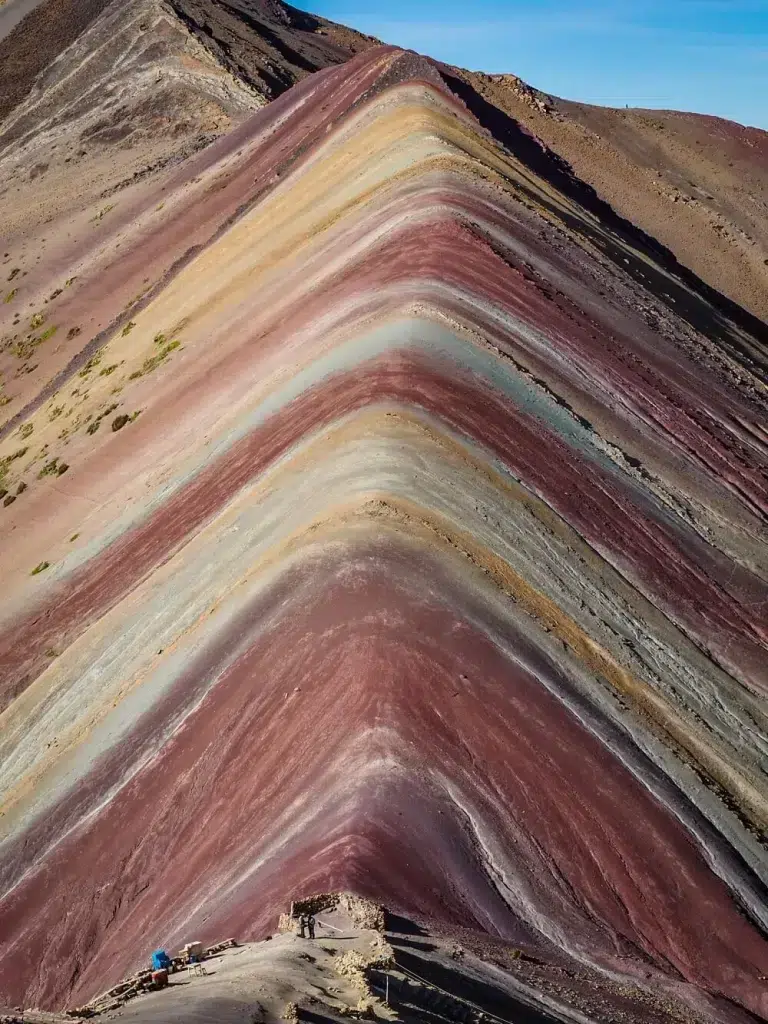
Can You Visit Rainbow Mountain Without Trekking?
Yes, you can. If trekking isn’t your ideal way to reach Rainbow Mountain, then you can just opt for an organised day tour leaving from Cusco. Rainbow Mountain is probably the second most popular day trip from Cusco after Machu Picchu , so there are plenty of companies you can choose from to take you there.
We put together a detailed guide on everything you need to know about your visit to Rainbow Mountain. Make sure to read it to arrive prepared.
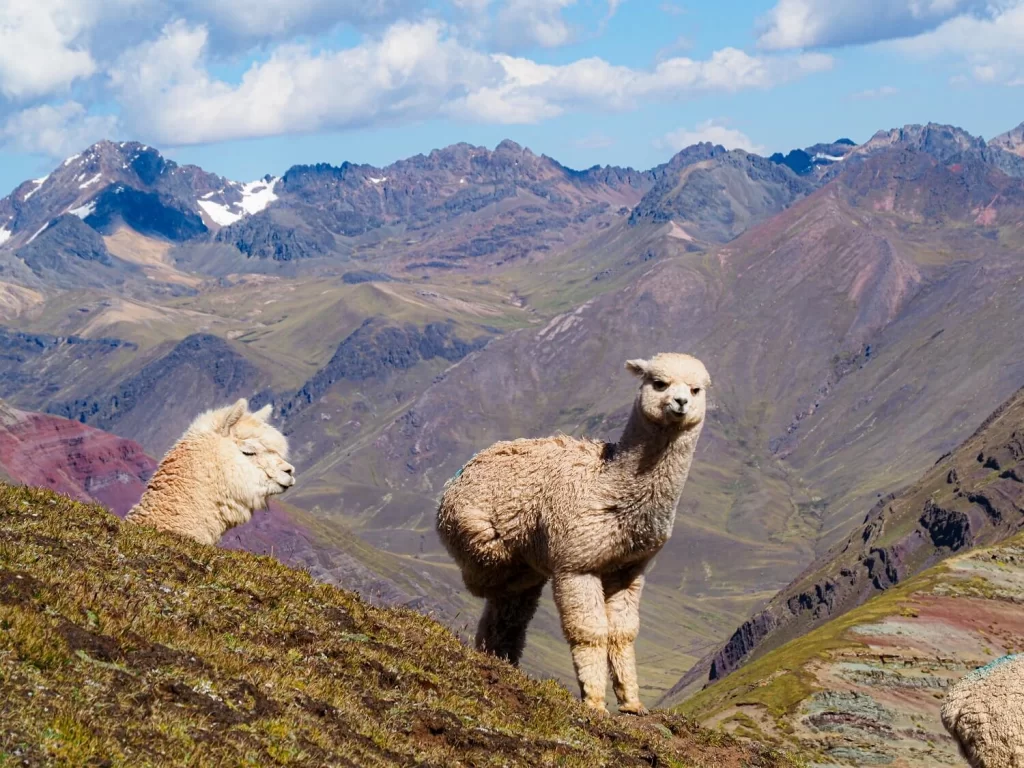
2-Day Ausangate Trek to Rainbow Mountain Itinerary
Day 1: quesiuno – pucacocha pass – anantapata or surina qocha camp.
You’ll have a very early alarm and a 4AM pick up from your hotel or the closest main square in Cusco. Depending on the group size, a minivan or a small car will drive you to Quesiuno about 3 hours away from Cusco.
Here you’ll have a quick breakfast with some beautiful views of Ausangate in the distance. Then you’ll start your trek up to the first pass. This first section is pretty gradual, perfect to warm up and get slowly acclimatised to the high altitude.
After a while, the trail will get steeper and steeper before passing the first lake called Laguna Ausangatecocha. You’ll soon reach the top of the first pass along the trek called Abra Apuchata (~4,900 m / 16,077 ft). A short distance from this pass, you’ll reach the second one, called Pucacocha Pass, from where you’ll get some jaw-dropping views of Ausangate Mountain and the lagoons in front of it.
After admiring the incredible views, you’ll slowly make your way to Anantapata. Along the way you’ll likely walk past some curious or skittish llamas and alpacas. Make sure to also say ‘hi’ to the shepherds too. At Anantapata you’ll normally have lunch before carrying on for another 3 hours to your campsite at Surina Qocha. We actually decided to camp at Anantapata and set off earlier to Rainbow Mountain the next morning. It was an amazing camping spot, and we recommend spending the night here if you can.
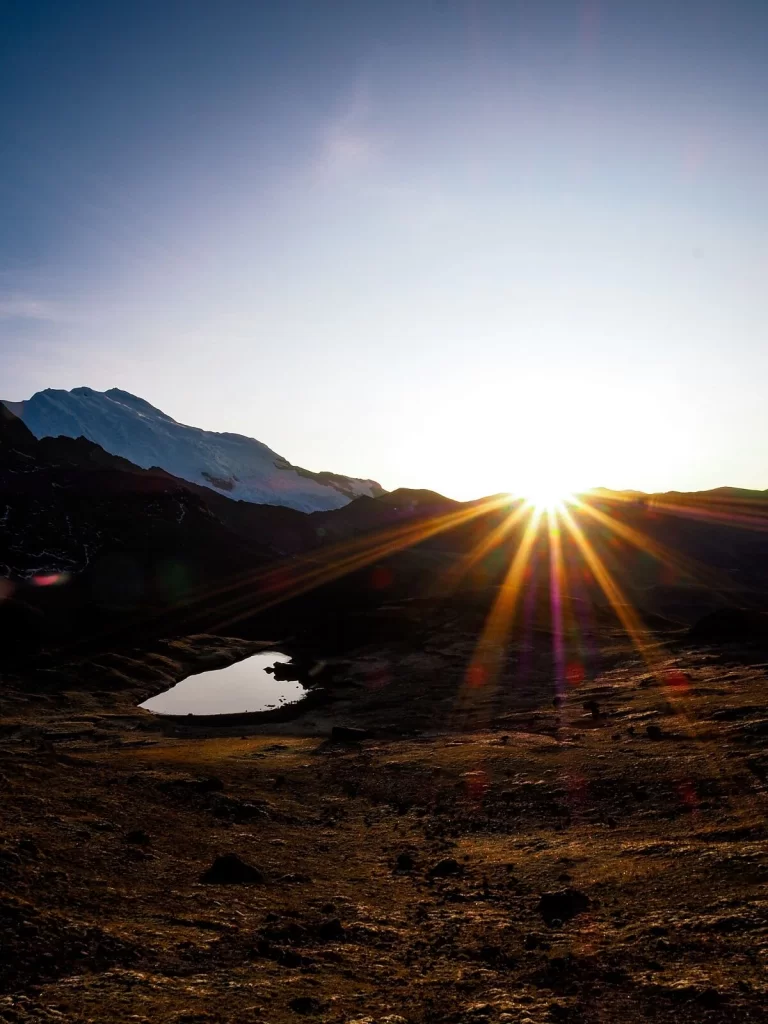
Day 2: Anantapata – Warmisaya Pass – Surina Qocha – Rainbow Mountain
If you end up spending the night at Anantapata, then you’ll have an early wake-up call (4AM) the next morning. This is necessary if you’d like to beat the first tour groups arriving to Vinicunca Rainbow Mountain.
After a quick breakfast, you’ll make your way up to Warmisaya Pass (Minasniyuc Pass) located at 4,955 m (16,257 ft). From the top of the pass you’ll be able to get your first glimpse of Rainbow Mountain in the distance.
You’ll make your way down the side of the mountain and past Surineqocha Lagoon where you could’ve camped the night before. We personally think that the campsite at Anantapata has a much better view.
After passing the lagoon, you’ll have a gradual 45 minute long uphill hike to reach Rainbow Mountain Viewpoint. The 360-degree views from here will be mind-blowing and seeing Rainbow Mountain and the Red Valley will make you feel like you’ve trekked to another planet.
Once you’ve taken hundreds of photos, you’ll have the chance to do a short hike within the Red Valley. Unfortunately, it was closed at the time of our visit. After your hike, you’ll slowly make your way back to the road you were dropped off on the day before. There you’ll have lunch and will get in a transport back to Cusco.
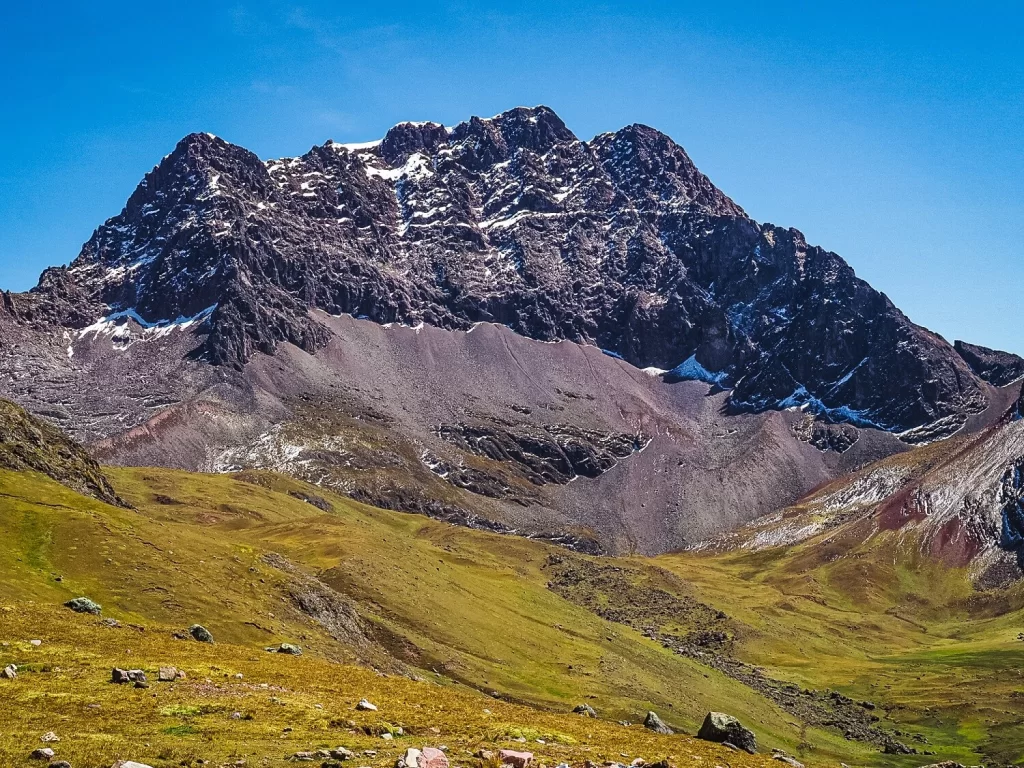
Information About the 2-Day Ausangate Trek to Rainbow Mountain
1. length of the 2-day ausangate trek.
This 2-day Ausangate Trek is a 24 km / 14 mi long trek. It is a relatively short one and spread across two days, so you won’t be hiking for too long each day.
The first day will be the longest especially if you have to hike all the way to Surina Qocha camp. You’ll hike around 2 to 3 hours to reach the first few passes and then another hour and a half to reach your lunch spot at Anantapata.
If you spend the night at Surina Qocha camp, then you’ll have another nearly 3-hour long trek ahead of you the following day. Don’t forget though that if you spend the night at Anantapata, you’ll add an additional 3-hour’s of hiking onto your final day. We were personally much happier about hiking an extra couple of hours in the morning after resting a bit the night before.
On the final day then, you’ll either have a nearly 4 hour hike to Rainbow Mountain or just under an hour. Then from the viewpoint, you’ll be hiking in the Red Valley for a few hours before making your way back to your pick up location about 2 hours away.
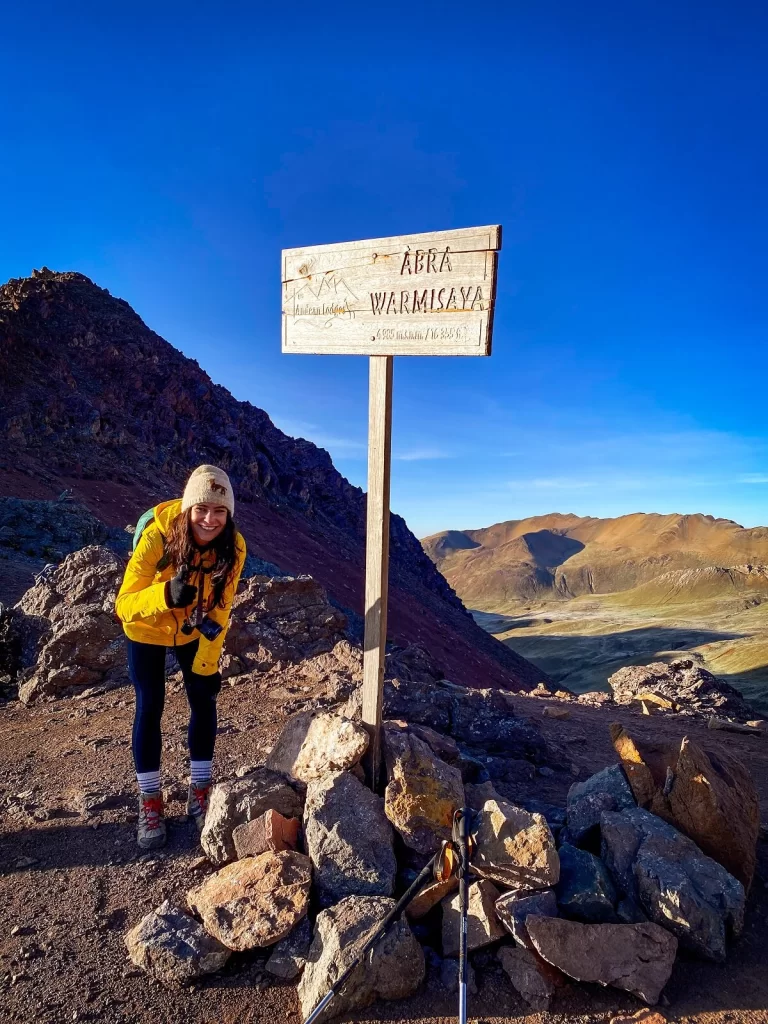
2. Level of Difficulty
This 2-day Ausangate Trek to Rainbow Mountain is a moderate to challenging hike, and it’s definitely not for a first-time hiker either. We’ll detail below all the challenges you can face on this route, so make sure to be realistic about your abilities and don’t underestimate this trek.
Elevation and Altitude:
Altitude and elevation are probably the main challenges you’ll face during your 2-day Ausangate Trek to Rainbow Mountain. Quesiuno, where you start your hike, is located at 4,370 m (14,350 ft) above sea level. This is already pretty high, especially if you compare that to the highest point along the Inca Trail which is only 4,215 m (13,829 ft). The Salkantay Pass along the Salkantay Trek is not much higher than your starting point at 4,630 m (15,190 ft).
Most passes along this trek will be around 5,000 m / 16,400 ft. This means that you can get altitude sickness if you’re not acclimatised properly before attempting this hike. You’ll also have to sleep at this height too which can be pretty hard and you might feel less rested the next morning.
There are many symptoms of altitude sickness, including dehydration, dizziness, headaches, shortness of breath, heavy breathing, loss of appetite, nausea and vomiting. It’s good to remember that anyone can develop altitude sickness and its symptoms can be less or more severe depending on the person.
For this reason we highly recommend spending a few nights in Cusco first and perhaps completing the Inca Trail or S alkantay Trek before this one to see how you’re coping with the altitude.
Temperatures and Weather Conditions:
If the altitude wasn’t enough to deal with, you’ll also have to be mindful of the temperatures too when trekking. The sun can be pretty intense, especially in the dry season. There are no trees to offer shade, so it’s important to wear a hat, sunglasses and sun-cream.
During the dry season the temperatures can drop during the night, so you’ll have to prepare for that if you’re camping. Believe us, the combination of freezing temperatures and high altitude doesn’t guarantee a good night’s sleep!
If you visit in the shoulder or rainy season, you’ll also have to be ready for potential rain. Whilst a little rain is just a bit of an inconvenience, a lot of it can make the trail quite dangerous. For this reason, make sure to time your visit outside the rainy season. Nobody enjoys trekking in the pouring rain with low visibility.
Other Posts You May Like:
- Vin icunca or Palccoyo? – Which Rainbow Mountain to Visit in Peru
- 10 Best Day Trips from Cusco
- All You Need to Know Before Hiking the Salkantay Trek to Machu Picchu
- Hiking in the Sacred Valley Without a Guide or Tour (Ollantaytambo, Maras, Moray and Pisac)
- The Ultimate 3 Week Peru Itinerary – How to Plan a Trip to Peru
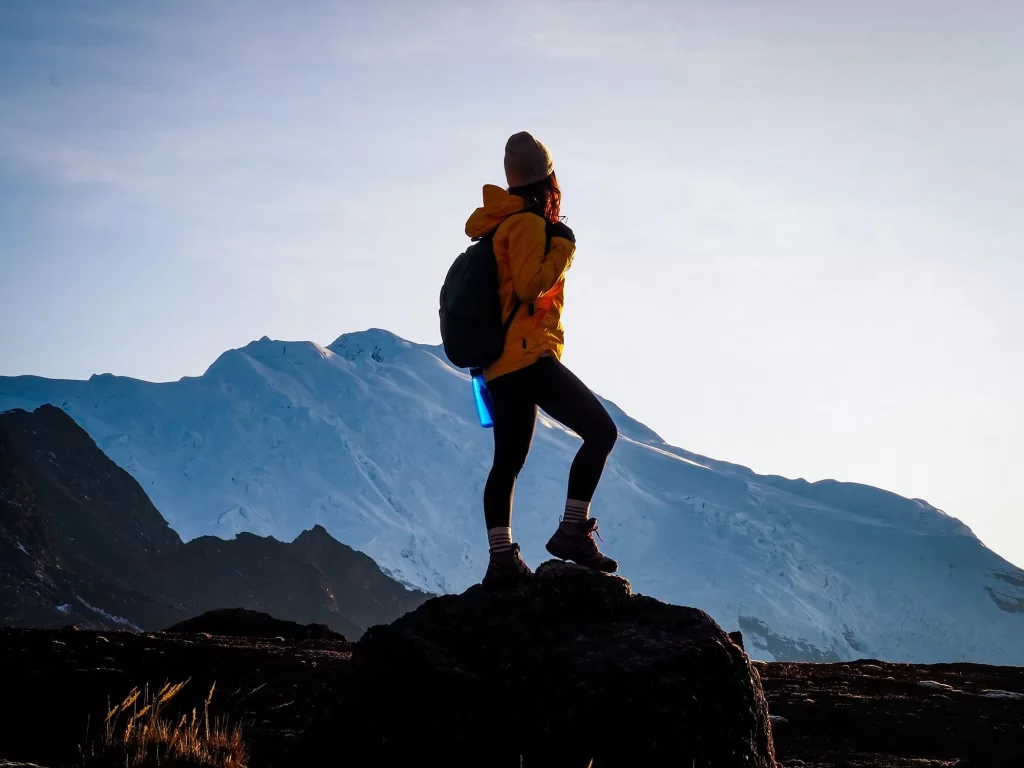
Final Thoughts on the Ausangate Trek to Rainbow Mountain
We absolutely loved our 2-day Ausangate Trek to Rainbow Mountain. Whilst we found the trek a bit challenging due to the high altitude, it was a really great way to push our bodies and see what they can do. Since we didn’t camp along the Salkantay Trek, it was also fun to spend a night in a tent under the star-lit sky. Of course, sleeping at 5,000 m wasn’t easy, but we still woke up with plenty of energy and adrenaline for another day of trekking.
We actually ended up having a private trek, which allowed us to bond with our guide and cook more than we could’ve done in a larger group.
It was also a fantastic and less crowded way to reach Rainbow Mountain. Getting to the viewpoint before everyone else made the entire trek even more special.
Have you ever hiked the Ausangate Trek to Rainbow Mountain? If so, which length of trek did you pick and what was your experience? If not, would you complete this trek to visit Rainbow Mountain or would you just opt for a day trip there? Let us know in the comments below.
Now, let your adventure begin,

Our Top Travel Resources
Accommodation: For hotels we always use Booking.com and Hostelworld for hostels. We also book longer stays on Airbnb or Vrbo.
Flights: To find the best flight prices we always check Skyscanner , Google Flights or WayAway. Then we also check the airlines’ websites too for comparison.
Car Rentals: We use Discover Cars when we want to rent a car as it compares local, national and international companies.
Activities: If we book organised tours we always check either GetYourGuide or Viator.
Foreign Currency: Whenever we can we prefer to pay in local currency and for that we always use our Wise card. We can easily withdraw money from the ATM or pay by card at most shops and restaurants.
Travel Insurance: We never go anywhere without travel insurance. You never know what will happen on your trip, so good travel insurance like SafetyWing can protect you in case of injury, illness, theft and cancellations.
eSIM and VPN: To get data abroad we use Airalo which is an app that allows you to download a prepaid eSIM to your phone in over 190 countries. Make sure to have a VPN to avoid hackers accessing your personal data when using public WIFI. We use Surfshark which is the only VPN that offers one account on unlimited devices.
Remember…It all starts with a Pin…
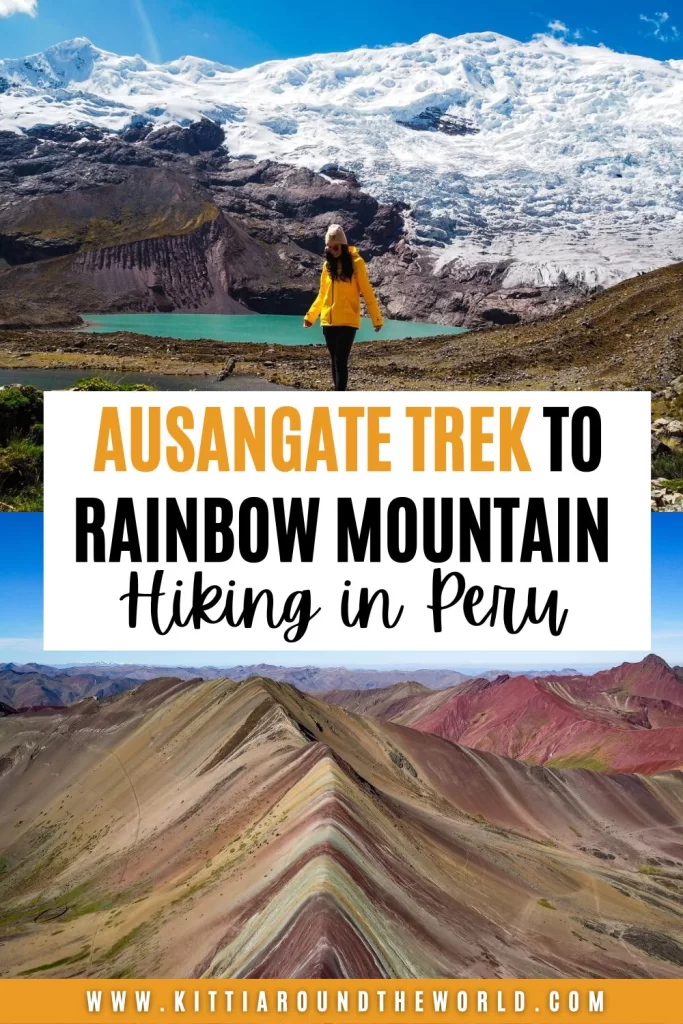
Similar Posts

A Guide to Visiting the Ollantaytambo Ruins, Peru
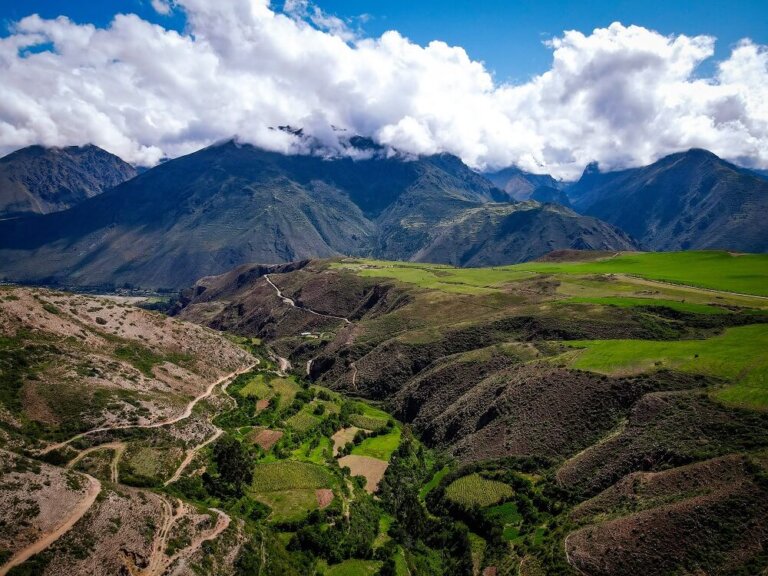
Hiking in the Sacred Valley Without a Guide or Tour (Ollantaytambo, Maras, Moray and Pisac), Peru
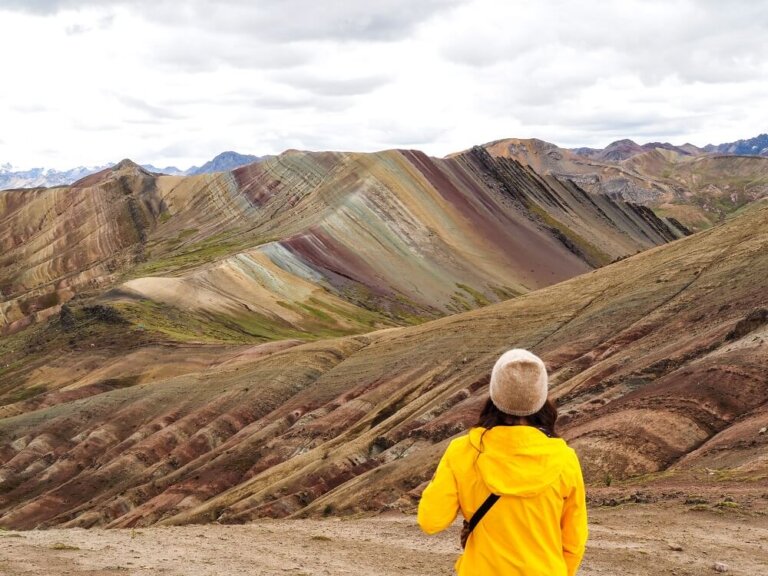
10 Best Day Trips from Cusco, Peru
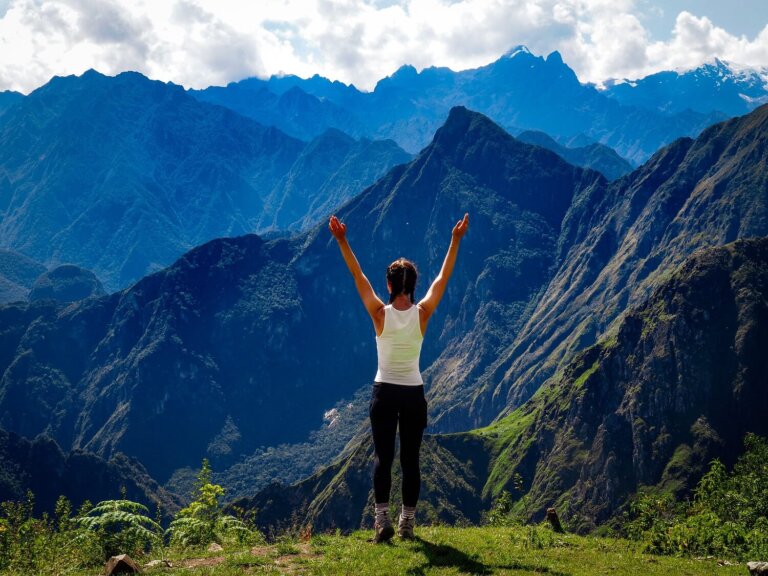
Hiking the Salkantay Trek, Peru – A Day by Day Itinerary
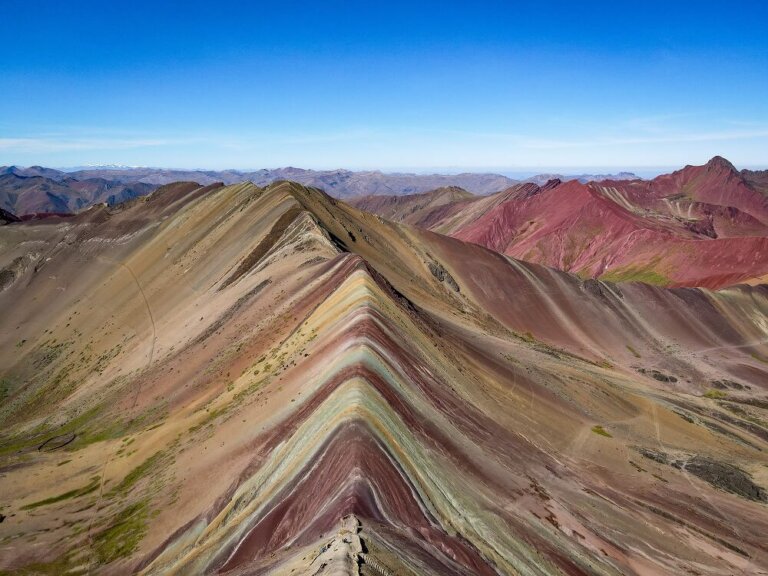
Vinicunca or Palccoyo? – Which Rainbow Mountain to Visit in Peru

A Complete Guide to Lima, Peru – Travel Tips and 3 Day Lima Itinerary
The pics and video are all amazing. What an awesome trip you did. I really enjoyed watching the video – it gives you a totally different aspect on the hike. The drone shots were excellent. Thanks for sharing!
I did Salkantay, Inca, and Rainbow Mountain but missed Ausangate while I was in Peru for a summer a few years back. Loved the area. One of the prettiest places I’ve been.
Sounds like such a great adventure! The area is absolutely gorgeous!
This looks like a solid adventure I’m into! Very detailed post and loved reading it!
The views on this hike looks like a dream! Amazing photos!
2 days, wow! I did this for a full day and I was extremely tired! I was actually surprised that many people can take that high altitude. Some people in my group did not even make it halfway and went back because of altitude sickness. I did not even know you can do a 2-day hike. What physical preparations did you do before the hike?
Thanks Trisha and well done for doing the one-day hike! The 2-day one was probably the most challenging hikes we did so far, but it was worth the effort! I think being in high altitude for about 3 months helped a lot, plus we did many multi-day treks before this one, such as the Salkantay Trek. Those definitely helped to get used to the environment. You can get pretty sick if you don’t acclimatise properly, and unfortunately everyone reacts to altitude differently.
Leave a Reply Cancel reply
Your email address will not be published. Required fields are marked *

- PERU: +51 992 509 095
- SALKANTAY TREKS TOURS
- Reviews on TripAdvisor
- Inca Trail Availaility
- +51 992 509 095
- Inca Trail 4 Days to Machu Picchu
- Salkantay Trek 5 Days
- Salkantay Trek And Short Inca Trail To Machu Picchu 5 Days
- Salkantay and Inca Trail 7 Days to Machu Picchu
- Salkantay Trek 4 Days
- Salkantay Trek 5 days to Machu Picchu
- Machu Picchu Day Tours – Trip from Cusco
- Choquequirao Trek 4 Days
- Choquequirao Trek 5 Days
- Choquequirao Trek To Machu Picchu 6 Days
- Choquequirao Trek To Machu Picchu 7 Days
- The Classic Choquequirao Trek To Machu Picchu 9 Days
- Lares Treks
- Ausangate Treks
- Inca Jungle Treks
- Huchuy Qosqo Treks
- Ancascocha Treks
- Sacred Valley 1 Day
- Maras Moray Tour
- Qeswachaca Bridge One Day Tour
- Humantay Lake 1 Day
- Rainbow Mountain Tour 1 Day
- Palccoyo Rainbow Mountain
- Pallay Punchu Trek 1 Day
- Amazon Rainforest

Ausangate Trek: The Complete Trekker’s Guide
Embark on an unforgettable journey through the heart of the Peruvian Andes on the Ausangate Trek , a challenging yet rewarding adventure that circles the majestic Ausangate mountain, the highest peak in Cusco. This guide provides everything you need to know to conquer this incredible trek.
The Classic 4 Day Inca Trail is a more well-known hike in the area, making it more congested and scarce. Ausangate is a less traveled, off-the-beaten-path trekking option that enables you to delve into the ethereal side of an old Andean world.
The Challenge:
- Distance: 43 miles (70 kilometers)
- Duration: 2-4-6 days (depending on your pace and chosen route)
- Difficulty: Strenuous. High altitude (reaching up to 17,000 feet) with steep sections and demanding hikes.
- Highlights: Breathtaking scenery, diverse landscapes, glaciers, local villages, colorful flora and fauna, and the imposing Ausangate mountain.
Planning Your Trek:
- Best Time to Go: The dry season, from April to October, offers the most comfortable trekking conditions with minimal rain and clear skies. However, be prepared for cold nights at high altitudes.
- Permits and Entrance Fees: Permits are mandatory for the Ausangate trek. Book well in advance, especially during peak season. Entrance fees to the Ausangate region also apply.
- Training: Due to the high altitude and challenging terrain, good physical fitness is crucial. Train for endurance and uphill hiking months before your trek.
A trip to Ausangate Mountain is a journey through unspoiled nature, active history, and ages-old spirituality. This six-day climb, which is considered difficult, is only advised for experienced hikers who have previous experience hiking at high altitudes.
The Vilcanota Mountain Range, or Cordillera Vilcanota, is traversed on the trip. With a height of 20,945 feet above sea level, Ausangate is actually Peru’s fifth-tallest mountain.
You will climb and descend through the mountain range on this Peruvian hike, taking in the expansive Andean views, thermal lakes, mysterious glaciers, verdant mossy passes, and massive snow-capped summits.
You’ll see interesting species along the trip, including condors, chinchillas, and herds of vicunas.
Ausangate Trek Overview
- Total Distance: 70km/43 miles
- Duration: 2, 4 to 5 days
- Starting/Finishing Point: Tinqui (Tinki)
- Average Altitude: Over 4000m/13,123ft
- Highest Points: Arapa Pass – 4850m/16,000ft; Palomani Pass – 5165m/17,000ft
Explore the stunning Ausangate trek , a 4 to 5-day adventure starting and finishing in Tinqui (Tinki). Covering a total distance of 70km/43 miles, this trek offers breathtaking views and challenging terrain. With an average altitude of over 4000m/13,123ft, prepare to immerse yourself in the high Andean landscape.
Reach the towering heights of Arapa Pass at 4850m/16,000ft and Palomani Pass at 5165m/17,000ft, where panoramic vistas await. These high points provide unparalleled views of the surrounding mountain ranges and valleys below.
For more trekking options around Cusco, check out our guides on the Choquequirao trek and trekking from Salkantay to Machu Picchu. Embark on an unforgettable journey through the Peruvian Andes and discover the natural wonders of this beautiful region.

Packing Essentials:
- Backpack: Choose a comfortable and well-fitting backpack (40-50 liters) to carry your essentials.
- Hiking Clothes: Pack layers for varying temperatures, including thermals, waterproof jacket and pants, fleece, comfortable hiking boots, and a hat.
- Sleeping Gear: Depending on your chosen route, you may need a sleeping bag rated for cold temperatures (around 15°F) and a sleeping pad.
- Other Essentials: Sunscreen, sunglasses, headlamp, trekking poles (recommended), water bottle, water purification tablets (optional), basic first-aid kit, snacks, and cash (soles) for small purchases in villages.
Trekking Options:
- Guided Trek: Opting for a guided Ausangate trek is highly recommended, especially for first-timers. Guides provide expertise, navigation, camping equipment (on some tours), meals, and ensure a safe and enjoyable experience.
- Independent Trek: Experienced trekkers with proper planning and permits can attempt the Ausangate trek independently. However, be aware of the challenges and potential dangers of high-altitude trekking without a guide.
Possible Routes:
There are several routes for the Ausangate trek, varying in difficulty and duration. Popular options include:
- The Classic Ausangate Trek (2-4-5 days): This route circles the Ausangate massif, offering stunning views of glaciers, lakes, and snow-capped peaks. It involves several high passes, including Arapa (15,912 ft) and Palomani (16,571 ft).
- The Rainbow Mountain Trek (3-4 days): This shorter trek incorporates Rainbow Mountain, a spectacular mountain with vibrant striations of color. It’s a good option for those seeking a shorter but scenic experience.
- The Ausangate & Salcantay Trek (6-8 days): This challenging trek combines the Ausangate circuit with the Salcantay trek or Machu Picchu Tour , offering incredible views of both majestic mountains.
Religious Importance
The mountains, known as apus, are widely adored and thought to have a spirit in Andean spirituality. In actuality, apu signifies lord in Quechua. These ferocious ghosts are said to guard the Highlands’ inhabitants.
Salkantay, Mama Simona, Pillku Urqu, Manuel Pinta, Pachatusan, Saksaywaman, Viraqochan, Pukin, and Sinqa are the other ten sacred mountains in the Cusco region.
One of the most well-known climbs in Peru is the Ausangate Trek , also known as the Apu Ausangate Road, which is thought to be the Andes’ most profound pilgrimage. This spiritual voyage usually takes place in late May or early June during the Qoyllur Rit’i festival, a Quechua event that honors the stars.
Ideal Time to Visit
The Ausangate Trek and all Peruvian trekking treks are best done between May and September. Because it is the Andes’ dry season, there will be more sunshine and clearer days to enjoy the stunning scenery.
Try focusing on the driest months of the year, July or August. Since the dry season coincides with the region’s peak travel period, Machu Picchu, and the Inca Trail are frequently more crowded.
Fortunately, the uncommon Ausangate Trek is distant enough to avoid crowds year-round, even in the height of tourist season.
The Andes experience a rainy season from October to April, with January through March being the wettest time of year. Rain can fall at this time of year, particularly around February.
Additional Considerations:
- Altitude Sickness: Acclimatization is crucial. Spend a few days in Cusco (at 11,150 ft) to adjust to the high altitude before starting the trek. Be aware of altitude sickness symptoms and descend if necessary.
- Respecting Local Culture: Be mindful of local customs and traditions. Dress modestly in villages and ask permission before taking photos of people.
- Leave No Trace: Practice responsible tourism by minimizing your environmental impact. Pack out all your trash and avoid disturbing the natural environment.
Ausangate Trek Hardness
The Ausangate journey is rated as difficult, with a few easy days thrown in. The walk is rated as Grade C in terms of difficulty, implying elevations between 14,800 and 16,400 ft (4500–5000 m) and 6-7 hours of hiking per day.
Many of the days contain steep parts that result in a quick ascent of altitude. This hike is manageable for anyone with a good level of fitness, however it is advised that trekkers have prior experience with multi-day hikes at high heights.
In addition to the steep parts and passes with elevations of over 16,000 feet, there is also the weather to take into account. At higher altitudes, blizzard conditions are not unusual because the weather may be highly erratic.
Trekking: Independent vs. Guided
Only 5% of hikers complete this journey on their own. It is only feasible if you are an experienced hiker who is acclimatized, equipped with the required equipment, and has a lot of backpacking, high-elevation hiking, and managing chilly, occasionally extreme weather conditions.
We advise using a guide for this hike. A guided tour significantly improves the experience due to the knowledgeable, seasoned guides, the authentic meals prepared by local cooks, and the local porters who carry and set up the gear from campground to campsite.
The Ausangate trail winds across high elevation sceneries varying from 10,334 feet to 16,800 feet above sea level. Andean uplift, glacial valleys with hanging glaciers, Permian formations, and cretaceous limestone woods characterize the landscape surrounding the mountain.
Hikers will pass through vistas dotted with glaciers, high flatlands, thermal lakes, snow-capped mountains, and lush green valleys.
Extension of the Machu Picchu Trail
The 6-day Ausangate journey does not traditionally involve a connection to Machu Picchu . However, if you have extra time, it is surely possible to add it on. Instead of finishing day 6 at Tinki, you would continue on to Laguna Armaccocha, visit a viewpoint and lake Singrenacchocha on day 7, and climb along the river to Mallma on day 8.
- [email protected]
- Second floor, Matara 242, Cusco

Go Treks Perú , is a local operator specialized in trekking, tours, hikes to Machu Picchu, Cuzco and other destinations in Peru. We have travel packages with alternative routes to Machu Picchu.
The experts in boutique travel To Peru and South America
Ausangate Trek: The Complete Hiking Guide
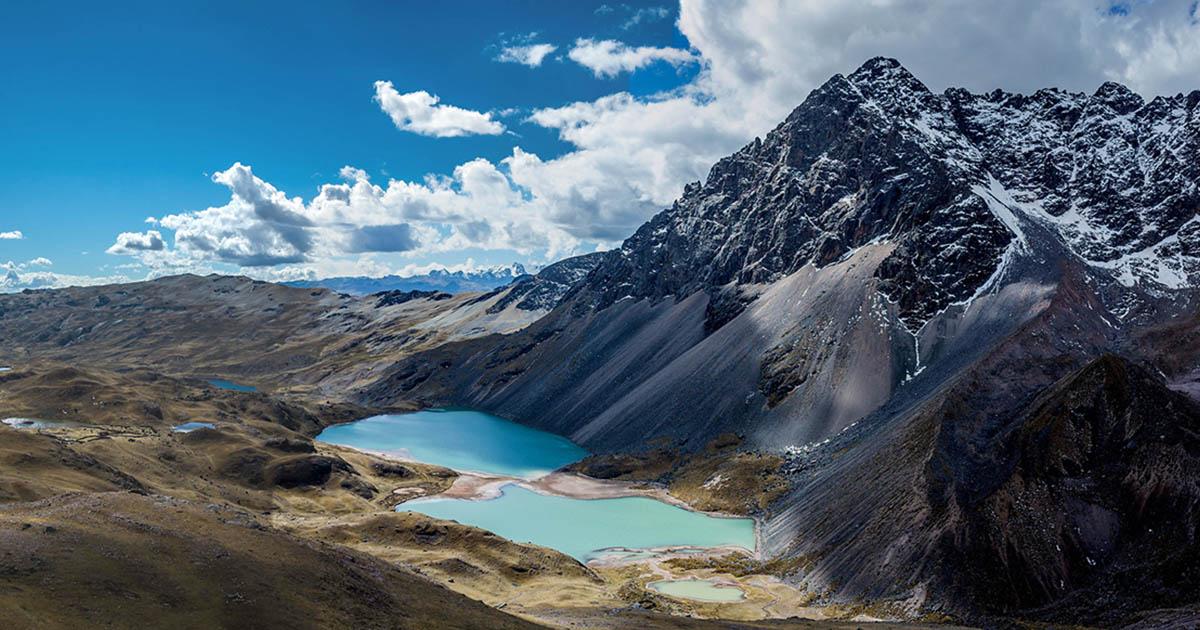
Peru is famous for being home to many exhilarating treks . Though not as popular as some of the other trails accessible from Cusco , the Ausangate trek is just as worthwhile. In fact, being less crowded with tourists is part of its charm. It guarantees travelers who venture on this remote journey a more unique experience. While you won’t come across Incan ruins, it makes up for it with breathtaking natural scenery and spiritual significance. Spot spectacular snow-capped peaks, gorgeous lakes, and wonderful wildlife, including herds of llamas and alpacas. The centerpiece of the trek is the mighty Apu Ausangate, one of the tallest mountains in Peru.
*Cover photo by Serge , used under CC BY 2.0
Table of Contents
Trail highlights, guided tour vs. independent trek, geography and climate, best time to trek, altitude sickness, what to pack, day-by-day itinerary, trekking tips.
Before embarking on the Ausangate trek, it is important to know what to expect. This will help you decide whether this trek is best suited for you. Firstly, it’s useful to compare Ausangate to other trekking options in the Cusco area. Ausangate does not conclude at Machu Picchu, making it less crowded compared to other treks. This means it is ideal for travelers looking to get off the beaten path.
Most tour companies recommend at least 5 days for the trek, or 6 if visiting Rainbow Mountain. The average elevation during the hike is 13,000 feet (4,000 m). Thus, it’s important to give yourself sufficient time to complete the trek. Taking some time to rest will decrease your chances of getting altitude sickness. Because of these challenges, previous experience hiking at altitude is recommended.
Basic Information
- Length: 4-6 days
- Distance: 43 miles (73 km)
- Highest altitude: Palomani Pass – 17,000 ft (5,165 m)
- Average altitude: 13,123 ft (4,000 m)
- Elevation Gain: 9,406 ft (2,867 m)
- Difficulty: Challenging
Comparison With Other Treks
The Ausangate trek doesn’t end at Machu Picchu . If you want to combine a trek with a visit to the ancient citadel, consider one of the treks to Machu Picchu. The most popular are the Inca Trail , Salkantay , and Lares treks. That being said, there are several other reasons visitors choose to hike the Ausangate trek. Especially those who have already seen Peru’s World Wonder, or travelers aiming to avoid the large crowds.
- Unlike the Inca Trail, there is no permit needed for Ausangate. It is thus much easier to organize and does not require booking months in advance.
- Ausangate is not as popular as other treks in Cusco, meaning fewer tourists can be found on the trails. You are guaranteed a more tranquil experience, even during the high-season from June to August.
- Ausangate gives you the unique opportunity to explore Vinicunca, the Rainbow Mountain . Vinicunca is not included on other treks and normally must be visited on a day trip from Cusco.
Trekking Tours:
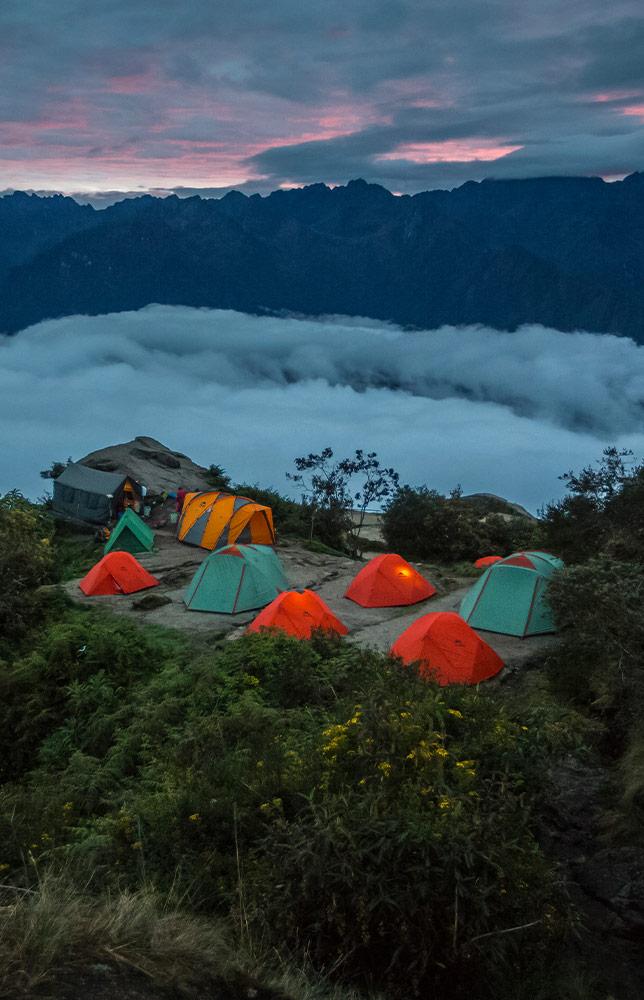
How Long is the Trek?
The recommended length of this trek is 5 days . This gives you enough time to relax and enjoy the beautiful scenery. It also accounts for time to rest, in case you are suffering from symptoms of altitude sickness. Adding a visit to the Rainbow Mountain will require an extra day, making it a total of 6 days . If you are short on time, some tour companies organize a 4-day Ausangate + Rainbow Mountain trek. This shortened trail takes you back to Cusco after visiting the Rainbow Mountain.
Ausangate is considered to be a hard trek. It is important to consider the challenges carefully before embarking on your trip.
While the hike itself is comparable to other Andean treks, the average altitude is over 13,000 feet (4000 m) above sea level. Lower oxygen levels at this elevation can trigger altitude sickness and shortness of breath. There are a total of four steep passes to cross measuring up to 17,000 ft (5,182 m). Previous experience hiking at high altitude is highly recommended.
Located in a very remote area, it can be difficult to navigate the trail. To avoid getting lost, hiking with a professional guide is suggested for all but the most seasoned adventurers.
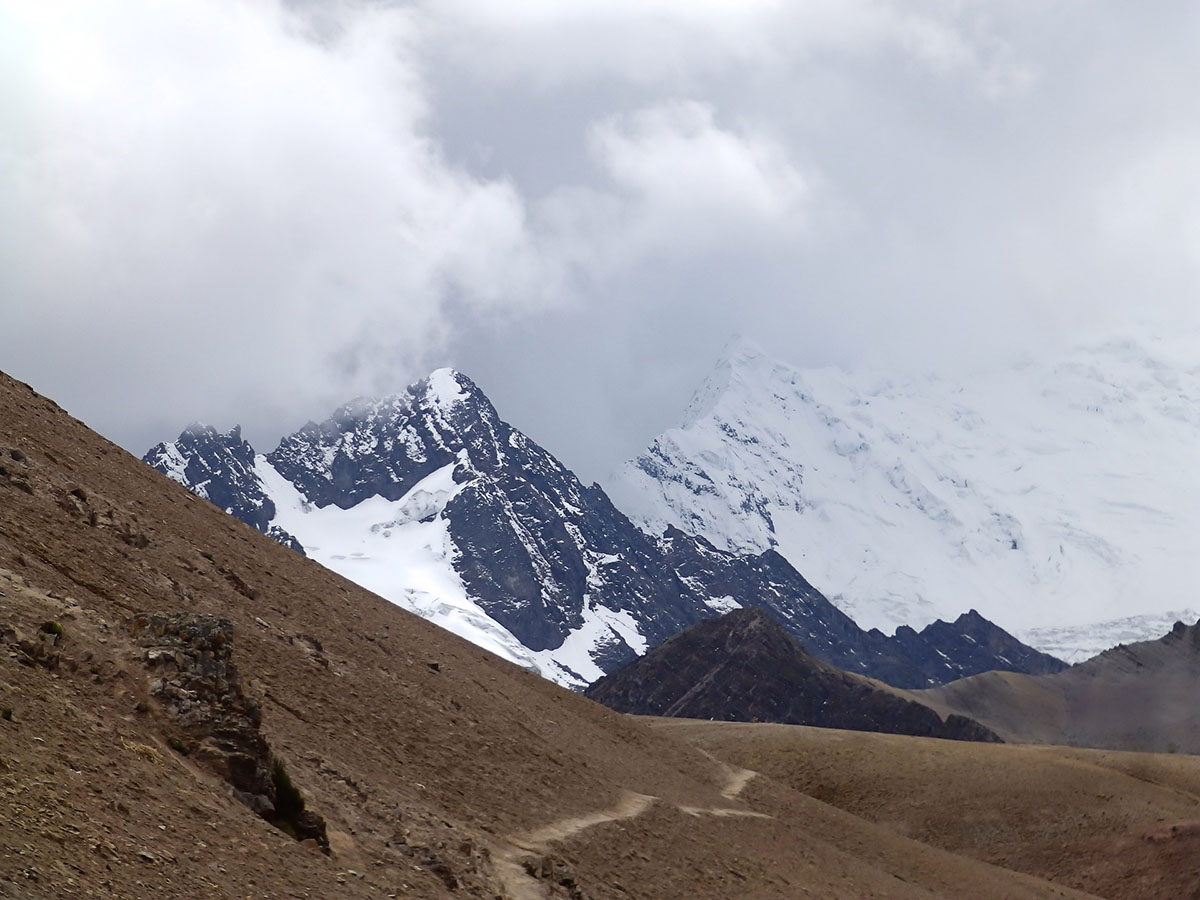
The Ausangate trek is different to other treks, mostly because it does not offer a visit to Machu Picchu. Nor does it visit other Incan ruins. Instead, its highlights are natural attractions, including glaciers, colorful lakes, and precious wildlife. Being so close to Rainbow Mountain, it even offers trekkers a chance to visit this popular attraction. In addition, you will encounter remote Andean villages that still retain their traditions. Read more below about the highlights of hiking the Ausangate trek.
Apu Ausangate
For the Incas, mountains served as a connection between the middle and the upper worlds. Important mountains were called “ Apus “, named after protective spirits they believed to live inside them. Apu Ausangate is the tallest peak of the Vilcanota Mountain Range in the Cusco region. It is also the fifth tallest mountain in Peru, measuring 20,940 ft (6,384 m). Though the trek does not take you to the top, you will get unrivaled views of its majestic, snowy peak.
Glaciers and Lakes
Apu Ausangate’s nickname is “ Creator of the Waters ” because of its many glaciers. They are the source of several lakes and rivers that supply water to other parts of the country. For example, the Vilcanota River goes on to feed the famous Amazon River. Thus, Ausangate has a special significance for Peruvians to this day. On the trek, you will come across gorgeous lakes, each of which with its own unique color. The colors range from green to blue, turquoise, and even red.
Rainbow Mountain
One of the biggest attractions of Ausangate Trek is a chance to visit the famous Rainbow Mountain. Mineral rock sediments found in the sandstone give this mountain its iconic colors. While not on the trail itself, a visit can be easily arranged on a one-day detour. See the day-by-day itinerary below for more details on how to incorporate it into your trek.
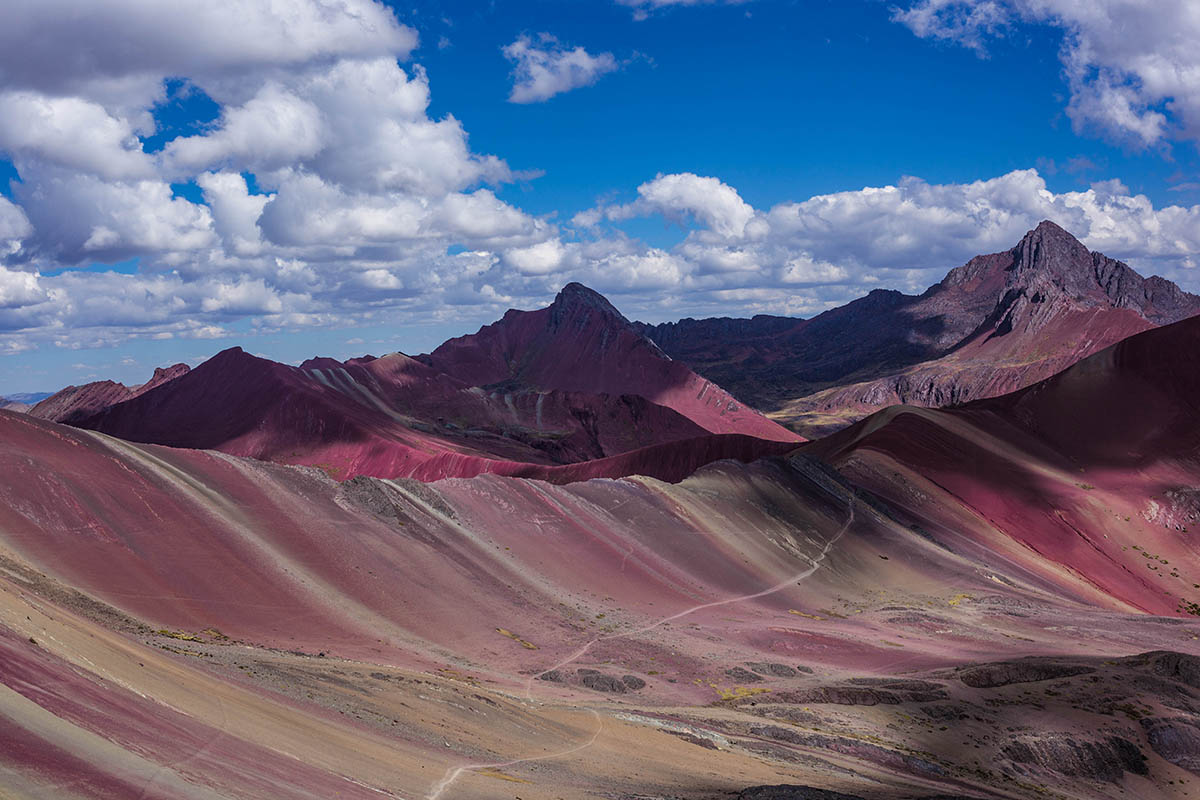
Flora and Fauna
The Ausangate trek passes through remote areas untouched by mass tourism. This has preserved it as a habitat for many wildlife species found in Andean Mountains. Come face to face with llamas, alpacas, vicuñas, and vizcachas (South American rabbit-like rodents). There are also various types of birds, such as Andean condors, black-chested buzzard eagles, and hummingbirds.
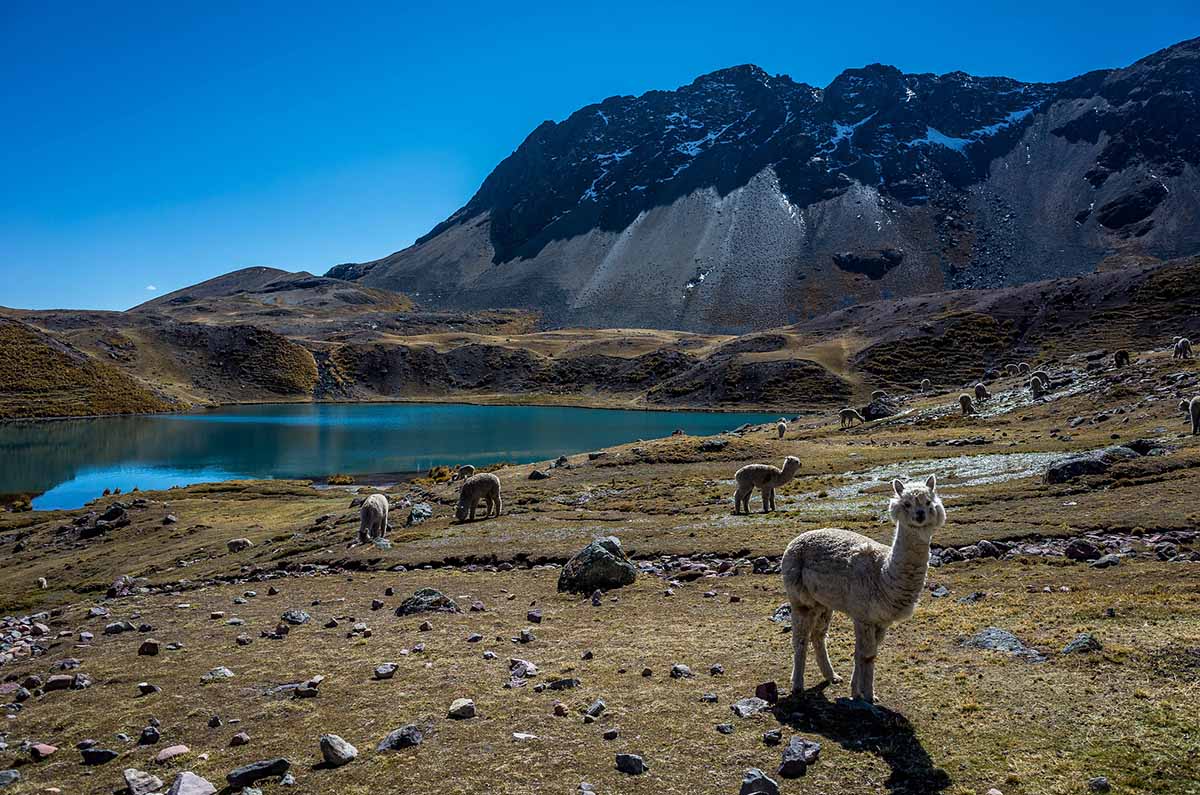
Andean Culture
Several Andean villages are dotted across the trail of the Ausangate trek. These remote Andean communities still retain their rich culture and traditions. Once a year, 10,000 pilgrims gather to celebrate Qoyllur Rit’i, the festival of the “ Snow Star ”. Several pilgrims climb Apu Ausangate searching for the legendary snow star. At the base of the mountain people celebrate with traditional dances. This event takes place over four days at the end of May or early June, coinciding with the full moon. Visitors who travel at this time are welcome to join the festivities.
Many hikers enquire whether it’s possible to do the trek on their own, or whether they need to go with a guide. In theory, it is possible to complete the trek without a guide. However, due to the high altitude it is only recommended for those with advanced hiking experience. While it may be more expensive, hiking with a guide will make the experience much more enjoyable. Especially for travelers who do not consider themselves professional hikers. See below for a full comparison of the advantages of hiring a guide vs. hiking solo.
Ausangate Trek With a Guide
- All logistical details, including transportation are taken care of. You will be picked up and dropped at your hotel in Cusco.
- Trekking companies provide tents and other items required for the trek. This will save you having to travel with bulky gear that is difficult to transport.
- Extra staff members on the trek can improve your experience. Chefs cook nutritious meals to boost your energy. Porters help you carry some of the heavy gear, including your tent.
- Hiking with a guide will give you a local’s insider knowledge on the trek. You will gain a deeper understanding of the significance and importance of Ausangate’s role in Andean culture.
- The presence of a Spanish speaker who is familiar with the area is valuable in case of an unexpected event.
Lodge to Lodge Ausangate Trek
- While camping is the standard on the Ausangate trek, some tour companies organize a lodge to lodge tour.
- On this version of the trek you will stay in basic, yet comfortable, tambos (Andean lodges) each night.
- Be aware that this will change the itinerary of the trek, as the tambos are located off of the main trail.
- Also, the lodge to lodge version can be significantly more expensive than the standard trek.
Ausangate Trek Without a Guide
- If you are a very experienced hiker, you may prefer trekking on your own.
- There is no strict schedule to stick to. You are free to make your own itinerary and move at your own pace.
- The cost is significantly lower than traveling with a professional tour company. Especially if you already have your own gear.
Part of the Andes Mountains chain, the Ausangate trek runs at a very high altitude. Elevations range between 10,334 and 16,800 ft (3,150 to 5,120 m), contributing to the trek’s difficulty. The giant, snow-capped mountains and glaciers are the source of rivers and lakes. These bodies of water have formed lush valleys and limestone forests below the mountains.
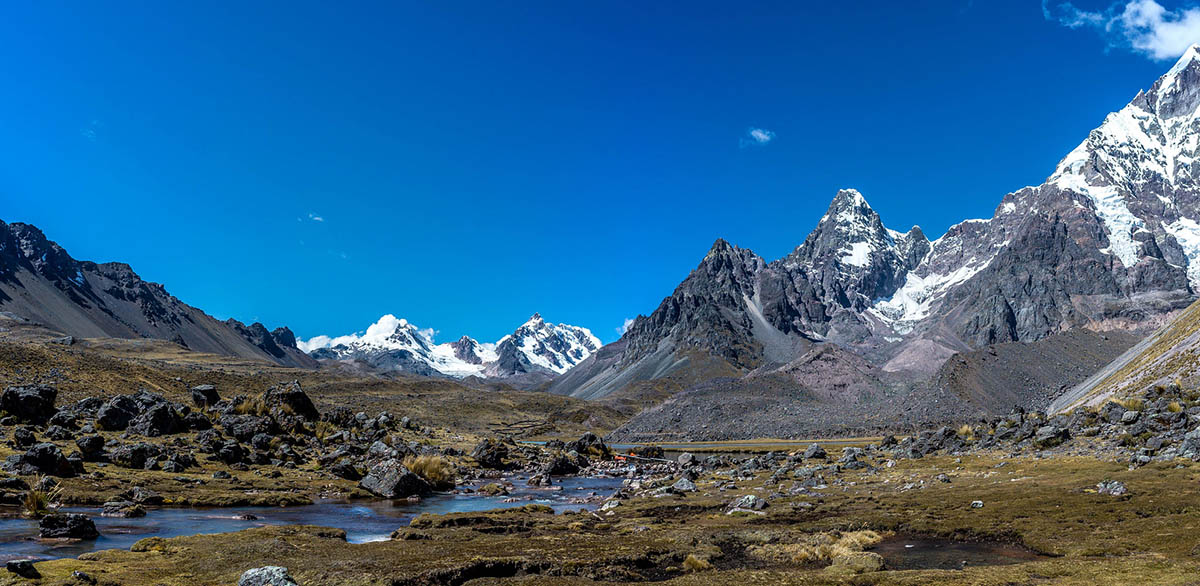
There are two distinct seasons, the dry season from June to August, and the rainy season from November to March. During the dry season it is very hot and sunny during the day. However, temperatures decrease rapidly after sunset and can drop to below freezing at night.
The rainy season coincides with summer in the Southern Hemisphere. Therefore, nighttime temperatures are slightly warmer, though it can still get quite chilly. Rain comes in hard and heavy burts, often several times a day. This also makes the valleys much greener than during the dry season.
The remaining months form the shoulder season, which is mostly dry, but with a few afternoon showers. Despite these general patterns, the weather in the Andes is unpredictable. It can be rainy or sunny on any day of the year, and thus it is always best to be prepared.
Dry Season – June to August
- Daytime: 64℉ (18℃)
- Nighttime: 28℉ (-2℃)
Should Season – April to May & September to October
- Nighttime: 35℉ (2℃)
Rainy Season – November to March
- Nighttime: 39℉ (4℃)
Most travelers choose to trek during the dry season , from June to August . During these months you can expect sunny, yet cool days and very cold nights. The ideal weather conditions attract hordes of visitors to Cusco. Yet, even during the busy season, Ausangate remains much less crowded than the other treks in the region.
Hiking in the shoulder season , from April to May and September to October , is a good option. Crowds and prices fall, yet the weather remains pleasant. Most days are generally sunny with a few light showers in the afternoon.
Few travelers decide to trek during the rainy season . From November to March It can often rain heavily for hours at a time. For those who don’t mind getting wet, temperatures are slightly warmer at night and crowds are almost non-existent.
Trekking in February is not recommended because excessive rainfall can create bad hiking conditions on the trails. This can even lead to potentially dangerous mudslides. Peruvian authorities often close the trails and carry out maintenance on them.
Altitude sickness is a common health concern for Andean trekkers, and for good reason. The average elevation of the Ausangate trek is very high at 3,123 ft (4,000 m). This means it is something to take seriously before setting off on your hike. Read more to find out what altitude sickness is, what are the most common symptoms, and how to prevent it.
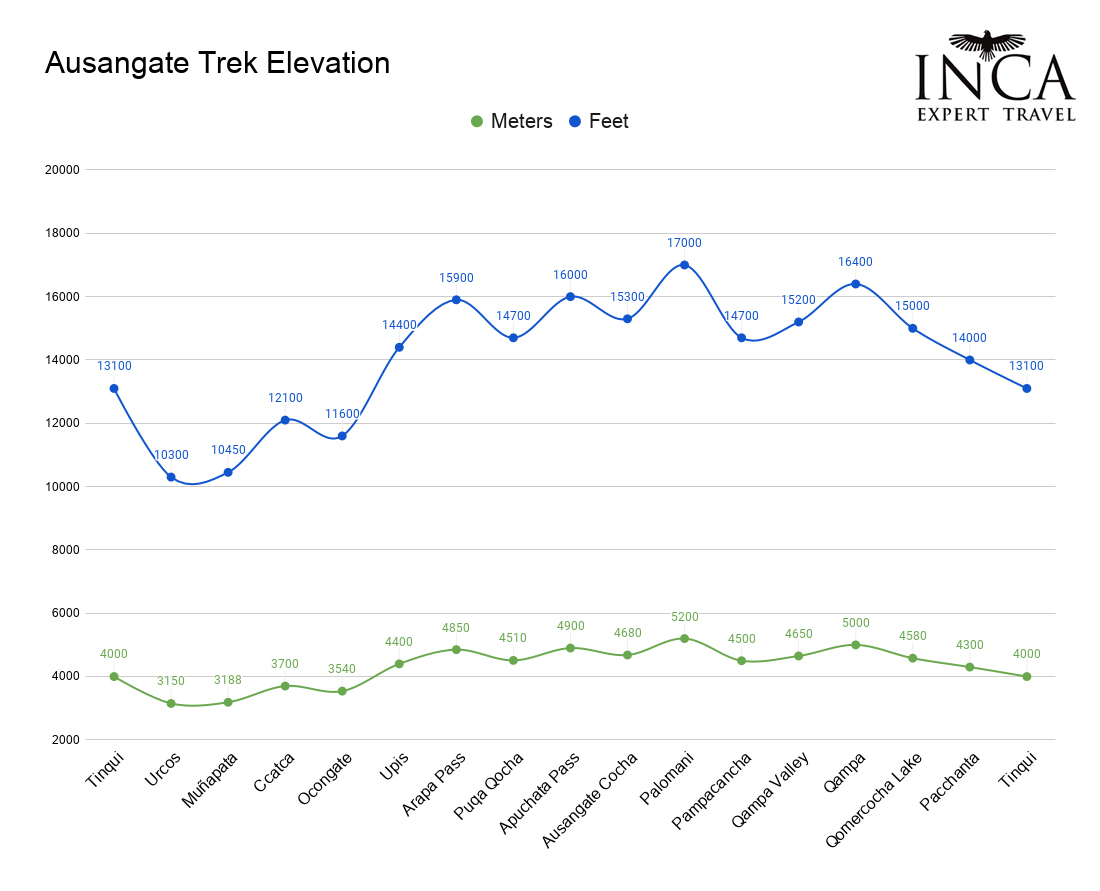
What is Altitude Sickness?
When moving to high altitude in a short period of time, your body may react to the lower level of oxygen in the air. This could result in a few mild, yet unpleasant symptoms for the first couple days. Over time, the body is able to adjust and these symptoms fade. The time it takes varies from person to person, but in general it’s around 2 days. In extreme cases, a more serious condition can develop and medical attention is required.
Mild symptoms of altitude sickness are similar to a hangover and include:
If you experience any of these more serious symptoms seek medical assistance:
- Shortness of breath, even when resting
- Loss of consciousness
How to Prevent Altitude Sickness
- Before departing the US you can get a prescription for Diamox, a pill containing Acetazolamide.
- Once you arrive in Peru, look for a very popular pill called Soroche. It is available at any major pharmacies, such as Mifarma or Inkafarma.
- Spend some time in Cusco before your trek to give your body a chance to acclimatize. Plan for at least 1-2 before partaking in any strenuous activities.
- Take natural remedies such as coca or muña tea that help reduce symptoms.
- Avoid drinking alcohol and eating heavy meals for the first few days at altitude.
- Stay hydrated at all times. Dehydration can worsen the effects of altitude sickness.
The weather in the Andes can be unpredictable. Bringing the right clothing and gear will prepare you for any weather conditions you might encounter. Some electronics will be useful to document your trip, while others are best left at home, or at your Cusco hotel. In case of injury, it’s always essential to bring a well-equipped first aid kit. Read the suggested packing list below to get an idea of what to take with you on the Ausangate trek.
- Long sleeve hiking shirt
- Hiking pants
- Thermal shirt and pants for sleeping
- Impermeable raincoat
- Sports bra for ladies
- Backpack – minimum 50 L
- Rainproof backpack cover
- Purifying tablets
- Water bottle
- Zip-lock bags for storing money and documents
- Hiking poles – recommended
- Sleeping bag and mat (can be rented from trekking company)
- Tent (if trekking independently)
- Cooking equipment (if trekking independently)
Electronics
- Flashlight/headlamp
- Spare battery back
First Aid Kit
- Paracetamol
- Diamox (for altitude sickness)
- Antiseptic cream
- Travel towel
- Toothbrush and toothpaste
- Toilet paper
- Hand sanitizer
This 5-day itinerary covers the most common route used by trekking companies. Follow this day-by-day description to get an idea of the distances covered, and sites visited each day. Keep in mind that there are several different versions Ausangate trek. Thus, you can consult with your trekking company if you would like to make any modifications.
The itinerary below does not cover the Rainbow Mountain visit. See the note on Day 2 explaining how to incorporate an extra day to visit the colorful mountain.
Day 1 – Cusco / Tinqui / Upis
- Distance: 7.5 miles (12 km)
- Elevation Gained: 2,346 ft (715 m)
Start your day early, driving along the highway south of Cusco. Observe the breathtaking scenery of the Andes with a panoramic view of the imperial city below. Once you enter the town of Tinqui, start the first part of your trek. Pass through traditional Andean villages, until you reach the first campsite at Upis. The campsite is located next to thermal hot springs, which are used for medicinal purposes.
Day 2 – Upis / Lake Ausangate
- Distance: 10.25 miles (16.5 km)
- Elevation gained: 2,946 ft (898 m)
Follow the trail until you reach Arapa Pass – 15,900 ft (4,850 m) – the first of four mountain passes. Once you reach the top, behold a spectacular view of Apu Ausangate. Descend from the peak until you arrive at the turquoise Puqa Q’ocha lagoon. Begin your second ascent to Apuchata Pass, located at 16,000 feet (4900 m). This path is surrounded by native vegetation and covered with rocks, moss, and lichen. At the top, enjoy more panoramic views of Ausangate and the snowy peaks that surround it. Eventually, you will arrive at Lake Ausangate Q’ocha. This is a gorgeous, turquoise lake named after the snowy peak and the source of its water.
Note: If you want to add a visit to Rainbow Mountain, you will require an extra day here. In the morning, hike to the Rainbow Mountain and then end the day back at Lake Ausangate.
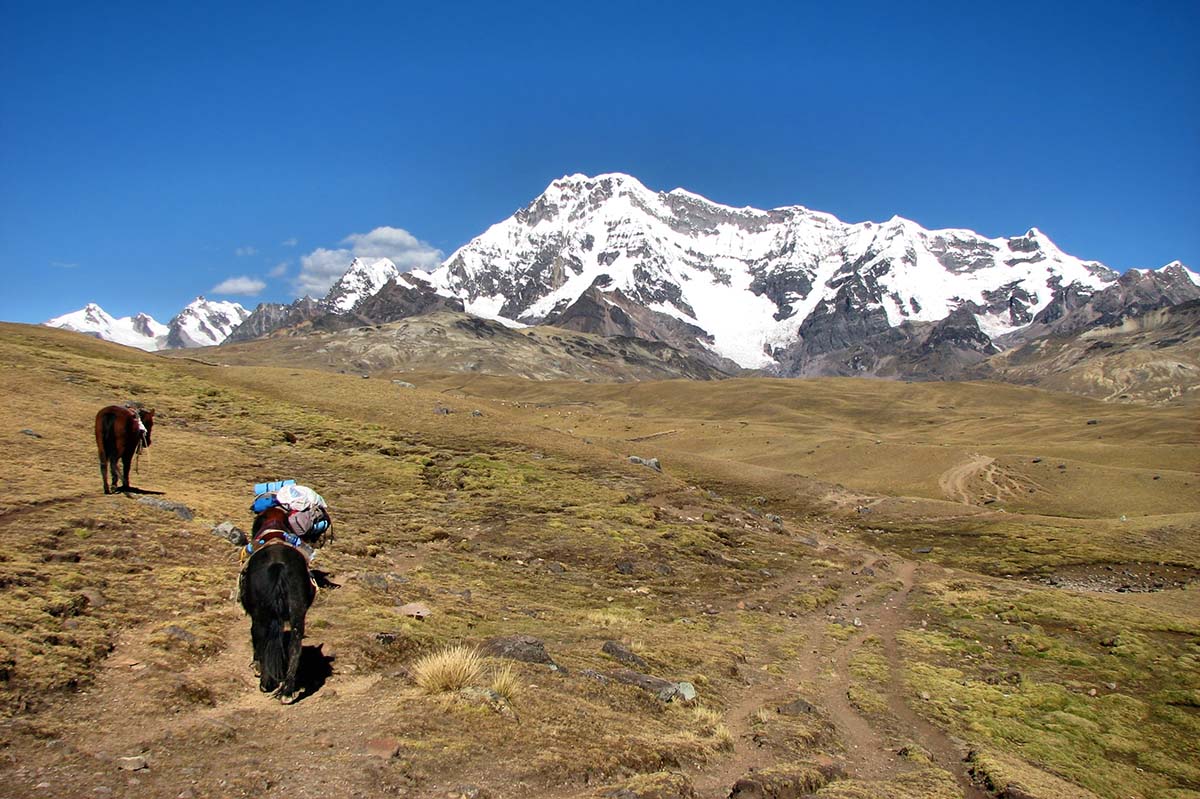
Day 3 – Lake Ausangate / Q’ampa
- Distance: 7.3 miles (11.75 km)
- Elevation gained: 2,093 ft (638 m)
Climb the third, and highest, point of the trek – Palomani at 17,000 ft (5200 m). Then, head downhill again into Pampacancha and the Qampa Valley. This lush valley is home to wildlife, such as condors, chinchillas, and herds of vicunas. Set up camp here for the night.
Day 4 – Q’ampa / Pacchanta
- Distance: 10.6 miles (17 km)
- Elevation gained: 2073 ft (632 m)
Marvel at the giant glaciers and huge ice blocks that are part of the snow capped Qolque Cruz Mountain. Continue until you reach the Ticllacocha Lagoon and then cross Qampa Pass at 16,400 ft (5,000 m). This is the fourth and final pass, which is covered in small stone towers called “ apachetas ” in Quechua. At the top, make your own stone tower as a way of asking the mountain for good luck. On your descent you will pass by Lake Qomercocha, known as the “ Green Lake “. Andean priests have long believed that this lake has a very special energy. Finally, arrive at Pacchanta, a small Andean town that is home to hot springs. An evening bath in the relaxing waters is a must after your arduous trek!
Day 5 – Pacchanta / Tinqui / Cusco
- Distance: 7 miles (11.25 km)
- Elevation gained: 272 ft (83 m)
Continue for about 3 hours until you arrive back at Tinqui. From there, board the bus or van that will take you back to Cusco.
When hiking the Ausangate trek, following certain guidelines will help you stay safe. Choosing the right time to visit is important to avoid torrential rain and mudslides. Adjust to the altitude before you trek and stay hydrated to prevent altitude sickness. Purchasing travel insurance will help you in case something goes wrong. Read the trekking tips below for more details on safety and other useful information to help you plan your trip.
Pick the Best Time to Travel For You.
Excessive rain from December to February can erode the trail and even create mudslides. Not only is it unpleasant to hike in these conditions, but it can also be dangerous. If hiking during the rainy season, listen to any updates from the Peruvian authorities regarding the conditions on the trek.
Be Prepared for High Altitude.
Spend at least 2-3 days in Cusco or the Sacred Valley before embarking on the trek. You will enjoy the trek more once your body has had time to acclimatize. If you feel yourself getting symptoms of altitude sickness, take a break and don’t push yourself too hard.
Tell Others About Your Plans.
When traveling independently, keep an itinerary of your trip at home with family and friends. There is no phone reception on the Ausangate Trek, making it impossible to communicate in an emergency. Informing others of your plans will allow them to seek assistance if they haven’t heard from you.
Practice Your Spanish.
Most locals in these remote Andean villages do not speak English. Knowing at least a few basic phrases, or having a dictionary handy, can help you communicate if necessary.
Drink Plenty of Water.
If hiking through a reputable travel agency your trekking company will be able to provide you with water. If hiking on your own, be sure to use water purifying tablets before drinking water from natural sources. Staying hydrated is especially important in order to prevent symptoms of altitude sickness.
Purchase Travel Insurance.
As with any outdoor adventurous activity, the Ausangate trek can be unpredictable. Cancellations due to weather, mudslides, etc. may occur. There is also risk of injury or illness. For peace of mind, invest in a comprehensive travel insurance plan that will cover you during your entire trip.
How To Get There
Lima is the nation’s bustling capital and travel hub, where all but a few international flights land. From there you need to connect to a domestic flight to Cusco There are many flights per day and the journey only takes about 1 hour. Several airlines fly this route, including some low-cost options. However, the most reliable option is LATAM.
Cusco is the base for most popular treks in the region. From here, arrange the Ausangate trek with a reputable travel agency, which will take care of all logistic details. Your guide will meet you at your hotel and take you to the trailhead. At the end of the trail you will be dropped off back at your hotel.
If you prefer to trek independently, make your own way to the small village of Tinqui. It is located about 100 km from Cusco. You can either arrange your own private transportation or take a public bus. Buses leave from Terminal Paradero Livitaca and the journey takes about 2.5 hours. From Tinqui, follow the signs until you arrive at the trailhead.
Accommodation In Cusco
You will need to arrange accommodation in Cusco for before and after your trek. There is a wide variety of hotels available, ranging from cozy, family-owned inns, to luxurious 5-star resorts. While there are options that fit every budget, it may be worth splurging on your hotel. After such an adventurous trek, arriving somewhere comfortable for some well-deserved rest will certainly feel worth it.
If you would like to visit the Rainbow Mountain, be sure to plan ahead. When organizing your trek with a travel agency, let them know in advance. Not all trekking companies include it in their itinerary by default. The dry season is the best time to see the vivid colors on the mountain as pictured in photos. During the rainy season, it can often be covered in snow, leaving travelers disappointed. Unlike the rest of the Ausangate trek, Rainbow Mountain is very popular with tourists so be prepared for large crowds.
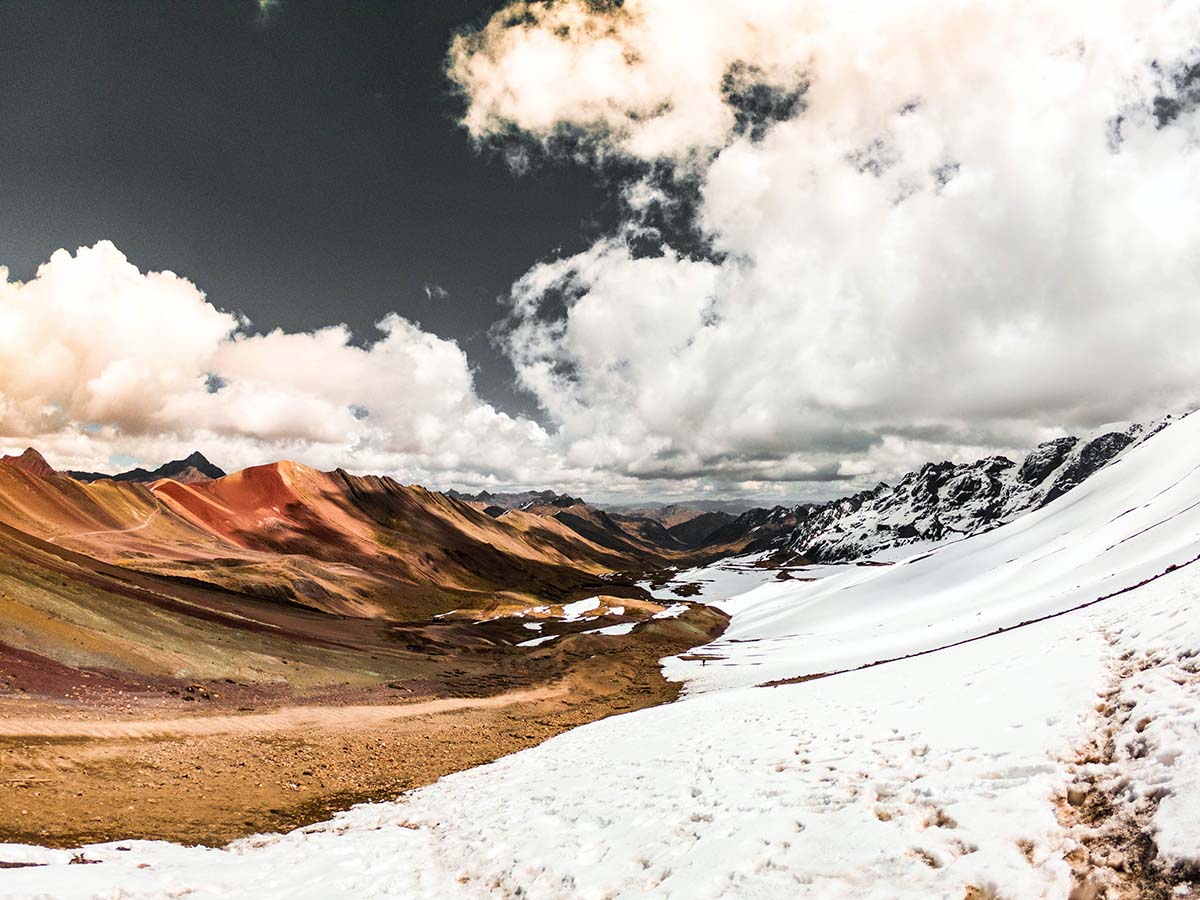
Hiking the Ausangate trek is an incredible adventure, best suited for those who already have experience hiking at high altitude. It’s essential to be well prepared for the high altitude, and remoteness of this trek. Hiking with a professional guide, organized through a reputable travel agency can make the experience much safer and more enjoyable. If you are up to the challenge, it’s sure to be an unforgettable journey.
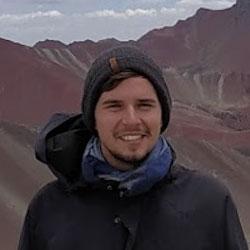
Passionate global traveler, Mikey, born in Prague to Czech-US parents, explored Latin America, taught in Salvador, studied in the UK, and calls Peru home.
Related Posts
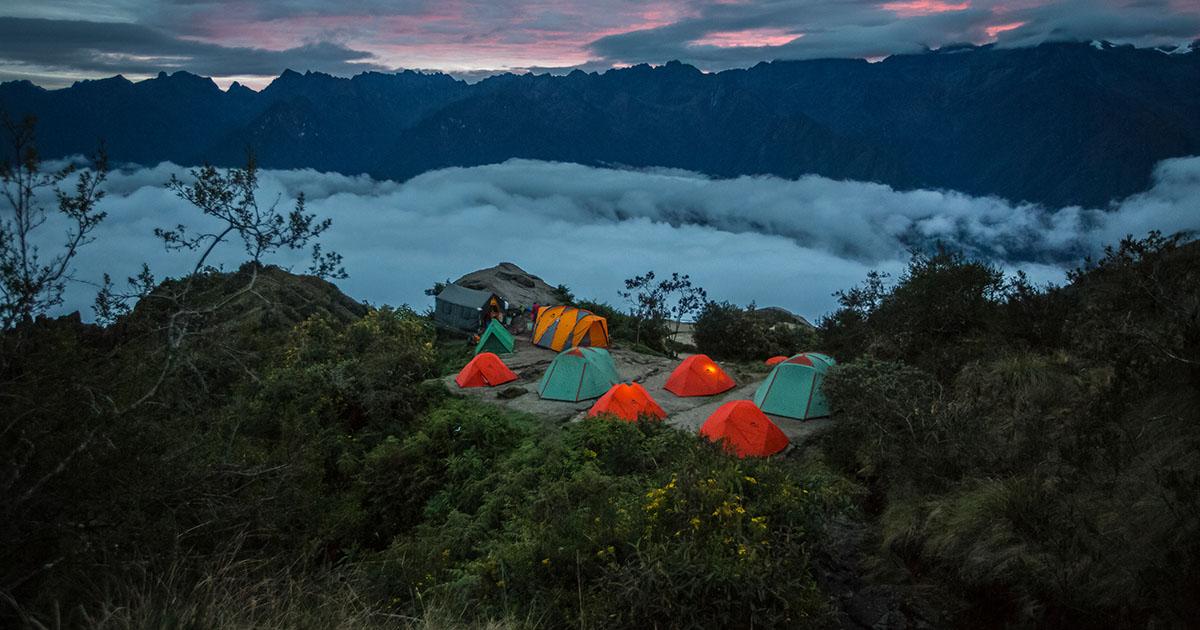
The 10 Best Treks in Peru: The Inca Trail and Beyond
Peru has so many incredible hiking trails that it’s difficult to narrow the best treks in Peru to just ten. No matter where you are hiking in the Andes Mountains, it is sure to be rewarding. From the deepest canyons to Inca trails and the Cordillera Blanca. Azure lakes, mountain vistas, Inca ruins and remote Andean villages are sure to amaze. Here are the top ten multi-day Peru hikes.
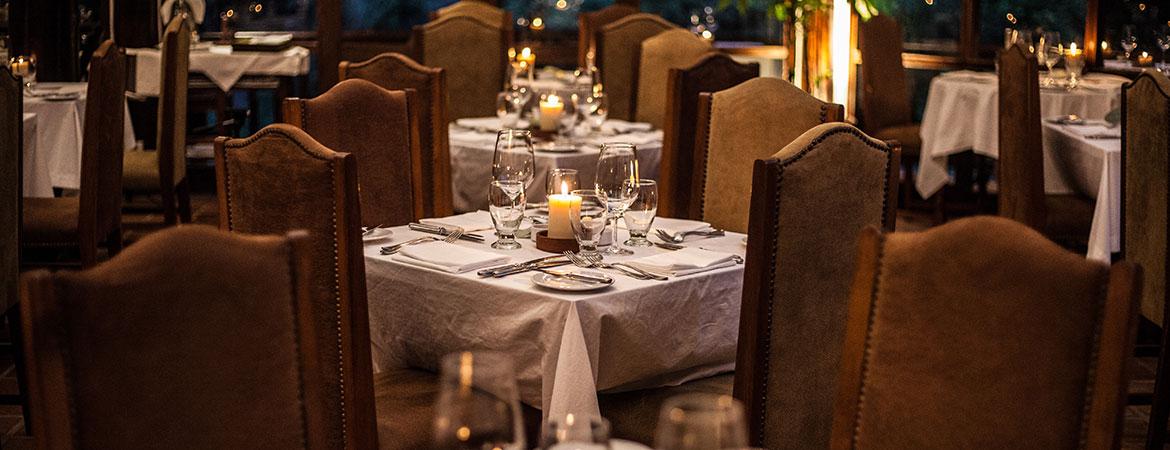
The Epicurean Route to Machu Picchu
Peru and food. It is increasingly difficult to speak of one without the other. Some would argue that the truest conduit to Peru’s modern heart and soul is through its culinary landscape.
Book with confidence
Postpone your tour with zero cost up to 30 days prior to arrival with open dates

Ausangate Trek Guide To Rainbow Mountain
by Tour Leaders Peru | May 30, 2023 | Ausangate Trek | 0 comments

Ausangate To Rainbow Mountain Trek Comprehensive Hiking Guide in Cusco Peru. The Ausangate Treks is a high-altitude 70km hike in the Peruvian mountains near Cusco with an average altitude of over 4000m. Unlike most other hikes in the region.
Ausangate is not about Inca ruins, it’s all about beautiful scenery; snow peaks, glaciers, colorful mountain lakes, and Rainbow Mountains .
- If you like beautiful nature, going off the beaten track and hiking this trek is for you.
- Ausangate is one of the most challenging hikes around Cusco but at the same time one of the most rewarding in the sense of scenery.
- Any doubts about hiking Ausangate on your own, read this article. We hope it’ll help you decide whether to do an independent or guided trek.
- For more info on all our favorite hikes in Peru, check out our travel guide Blogs or you can contact us here!
You May Also Like
- When IS The Best Time To Visit Machu Picchu
- Rainbow Mountain Trek Self Guide
- Rainbow Mountain Fotos
Ausangate Best Time For Trekking
If you’re planning to hike Ausangate in Cusco, it’s important to take into account a few factors. The primary seasons are the dry season (May to September) and the rainy season (November to March). To determine the best time for you to go on your hike and witness the wildflowers, here’s a helpful guide. It’s recommended to visit during the dry season (May to September) as there is little to no rain, but it can get quite chilly, particularly at night in the mountains. In April and October, there is a higher chance of rain, but the temperature is warmer.
Due to the high altitude in the winter months, from June to August, some parts of the trek might be covered in snow. – Rainy season (November to March): it’s warmer and rains a lot. The period from December to February is the worst time for hiking in the Cusco region as it rains the most.
So, When Should You Go?
If you don’t mind a little cold and rain, April and October are ideal months to hit the trails, as there will be fewer crowds to contend with. If rain isn’t your thing, plan your trip for the May-September range. Just note that June-August can still get chilly; don’t forget to pack accordingly!
Peruvian culture is greatly influenced by its indigenous roots, too. You’ll find brightly colored fabrics and textiles in markets all over Peru, as well as many traditional dishes that incorporate some of the country’s native fruits and vegetables. Plus, the food even varies from region to region! Whether you’re into hiking or just want to take in the sites.

What You Need To Know About The Ausangate Trek
Are you considering the Ausangate Trek or Rainbow Mountain? Here’s what you need to know!
The Ausangate Trek is a high-altitude trek, so acclimatization is essential. You may want to do another lower-altitude hike first to see how your body reacts. you can find Cusco Day Trip to acclimatize your body
Drinking enough water is key when hiking at high altitudes. There are creeks and rivers on the route, but we recommend bringing a Lifestraw bottle or water purifying tablets, just to be safe.
During the trek, you won’t come across any lodges or established campsites with facilities. Therefore, it is necessary to be self-sufficient. However, if you’re hiking with a tour operator, they’ll provide you with all the necessary travel equipment, including eco-friendly toilets.
A good map or GPS navigation is highly recommended for this trek. Cell phone reception is very limited, if available at all.
Your camping gear must be reliable and suitable for low temperatures. At night, it can get below freezing.
Expect to see many people at Rainbow Mountain. If you want to avoid the crowds, you can visit on a day trip from Cusco.
The Mountains add one extra day to the itinerary, plus there will be many tourists, locals with decorated alpacas, etc. But if you want to see the more authentic side of things, Rainbow Mountain is worth the visit.
How We Rank The Ausangate Trek Guide In Peru.
It’s perfect for those who love being in nature and enjoying the amazing scenery. Here are a few things to know about this fantastic trek:
Difficulty level: 5 out of 5. The Ausangate trek is not for the faint of heart. It’s remote, high altitude, and has several steep ascents and descents.
Scenery: 5 out of 5. The scenery on the Ausangate trek is stunning. From colorful lakes to snow-capped peaks to Rainbow Mountain, this hike has it all.
Touristy: 2 out of 5. The Ausangate trek is one of the less touristy hikes around Cusco. The only time you’ll see other tourists is at colorful Rainbow Mountain.
So, if you’re looking for an amazing, remote hike with incredible scenery, the Ausangate trek is perfect for you. Just be sure to come prepared for a challenging hike.
Altitude Sickness in Ausangate
Ausangate is a high-altitude trek that goes over 4000m. Good acclimatization is key to enjoying the trek.-Many people arriving in Cusco by bus from Lima or the Amazon get altitude sickness. It is normal if you fly or go by bus from a low altitude to a location more than 3000m above it.
There are Three Types of altitude sickness.
Mild Altitude Sickness, HAPE, and HACE – the last two are lethal. Mild Sickness is the first stage and if you don’t take precautions, it can develop into one of the lethal types. Having Mild Altitude Sickness is similar to having a hangover; headache, nausea, and fatigue.
Many people feel it for the first couple of days in Cusco.-You can avoid or lessen the effects of altitude sickness by drinking coca tea, staying hydrated, and avoiding alcohol.
Acclimatization is key when trekking at high altitudes
If you are coming from a lower altitude, it is normal to experience some effects of altitude sickness. These can include a headache, nausea, and fatigue. To avoid or lessen the effects of altitude sickness, be sure to drink coca tea, stay hydrated, and avoid alcohol. By following these simple tips, you can have a safe and enjoyable experience on the Ausangate Trek or Rainbow Mountain.
Drink plenty of water and avoid alcohol
– Acclimatize gradually by “climbing high and sleeping low”
– Consider taking Diamox if recommended by your doctor

Travel Insurance For Ausangate Trek
Hiking like any outdoor activity involves risks of getting injured, losing or breaking gear, cancellation of the trip due to bad weather, etc. The Ausangate Trek is a high-altitude route through remote areas of the Andes it’s highly recommended to have travel insurance that covers you for the period of the hike.
Choosing an insurance company that you can rely on in case of emergency is very important, we recommend World Nomads. The company focuses on covering outdoor activities including trekking. Peru is one of their top hiking destinations which means they have experience working with local companies.
A great thing about World Nomads is that you can buy insurance online while traveling, it takes only a couple of minutes. Their insurance policy is very flexible-you can buy insurance to cover the whole period of the trip or only the hiking part of it, even if it’s one or two days.
Ausangate Trek Complite Guide Packing List
This inventory outlines the essentials for a trek along the Inca Trail to Machu Picchu. Tour companies will have meals, group cooking gear, tents, and sleeping pads included. Before embarking, ensure that you are clear on the gear provided by your tour operator.
This list features the Ten Essential Systems every backcountry trip must have: navigation, sun protection, insulation, illumination, first-aid supplies, fire, repair kit and tools, nutrition, hydration, and emergency shelter. We did not include essentials in the list below because travel to Machu Picchu requires a tour company that brings those items along.
There may be an overlap between equipment for travel and equipment for trekking. Keep this in mind when choosing quantities.
Exclusive Ausangate Trek Guide Packing List
If you’re planning a trip to Machu Picchu, you’ll need a comprehensive packing list to ensure your journey is smooth and comfortable. This guide has been tried and tested to provide you with the ultimate checklist for Ausangate.
- Airline tickets (confirmation and itinerary)
- International health card (immunizations listed)
- Valid passport (needed in many places, including Machu Picchu, where you get a souvenir stamp)
Travel Equipment
- Luggage locks
- Luggage tags
- Travel wallet
- Passport/money belt
- Sleeping bag liner
- Travel plug adapters (A and B) and converters
Hiking Clothing
- Wicking, quick-dry boxers or briefs
- Wicking, quick-dry sports bra
- Synthetic or wool T-shirt
- Long-sleeve, travel-friendly shirt
- Lightweight, travel-friendly pants
- Casual shoes
- Midweight wool or synthetic socks
Trekking Equipment Ausangate Trek Guide
- Day pack (21 – 35 liters; double check with your tour company)
- Sleeping bag rated 15°F to 29°F (dependent upon season, forecast, and personal preference)
- Waterproof hiking boots
- LED headlamp with extra batteries
- Trekking poles (optional, but rubber tips are required)
Trekking Clothing Ausangate Trek Guide
- Midweight long underwear bottoms
- Midweight long underwear top
- Synthetic short- and long-sleeve T-shirts
- Midweight fleece or soft-shell jacket
- Midweight down or synthetic jacket
- Convertible hiking pants
- Fleece pants
- Lightweight waterproof/breathable rain jacket
- Lightweight waterproof/breathable rainpants
- Midweight fleece gloves or if you prefer you can buy wool gloves
- Midweight fleece/wool winter hat
- Sun-shielding hat or cap
- Midweight wool or synthetic hiking socks
- Liner socks (optional)
Personal Items for Ausangate Trek Guide
- 1-liter water bottles (2) Machu Picchu does not allow Plastic water bottles
- 2-liter hydration reservoir (optional)
- Watch with alarm (altimeter, other features are optional)
- Compass (optional on a guided trip)
- Signaling whistle (optional)
- Action camera ( Go Pro or regular camera; optional)
- Spare camera battery and spare camera memory card
- Camping pillow Optional
- Insect repellent
- Pocket knife or preferably multi-tool
- Personal first-aid kit
- Eye shade (optional)
- Earplugs (optional)
- Journal and pen (optional)
- Book or e-reader (optional)
- Small binoculars (optional)
- Cash in local currency (nuevos soles)
- Large plastic garbage bags
Toiletries Ausangate Trek Guide
- Compact roll of toilet paper
- Personal wipes/hygiene items
- Hand sanitizer
- Toothbrush (travel size)
- Toothpaste (travel size)
- Dental floss
- Sunscreen (SPF 30 or higher)
- Lip balm (SPF 30 or higher)
- Shampoo and conditioner For Travel
- Camping, Hiking, Travel Soap
- Razor and shaving cream
- Skin lotion
- Spare eyeglasses or contact lenses
- Prescription medications for traveler’s diarrhea, altitude sickness, malaria
Guide companies generally provide breakfast, lunch, dinner, and drinking water during your trek. You’ll want to add to this by bringing snacks, drink mixes, and energy foods. Check with your guide company to see what food is provided
- Energy bars
- Energy gels
- Electrolyte replacement drink mix
- Snacks (cookies, GORP, Snickers, etc.)

Comparison With Guided Tour Operators And Independent Hikers
The Ausangate trek is undeniably one of the more challenging and secluded hikes in the region. Therefore, if you’re new to hiking, it’s highly recommended that you embark on this adventure with the reliable Ausangate Trek Guide Tour Operator by your side.
-Let them guide you through the route and arrange everything. This way, you can focus on enjoying the hike.
-However, if you’re an experienced hiker with proper acclimatization, then going on your own is possible.
Here are the pros and cons of both an independent and guided hike. This way, you can make the best decision for your Ausangate trek!
Ausangate Trek Without Tour Operator
If you’re looking for a real adventure, Ausangate Trek and Rainbow Mountain is the perfect option for you. Here are some of the benefits of going on an independent hike:
– It’s much cheaper but takes time to Organize your Trip
– You’re very flexible with distances and times; start and finish when you want, stop where you like, etc.
– You have to carry all your gear and food.
– You can trust only yourself there is no backup.
– It’s not always fun to pitch a tent and make food after a long and tough walking day.
However, the sense of accomplishment you’ll feel afterward is unlike any other feeling.
So if you’re up for a challenge and want to explore Ausangate Trek and Rainbow Mountain at your own pace, an independent hike is the perfect option for you. Read our comprehensive Blog Post Ausanate Trek Whitout Guide Here
Ausangate Trek Guided Tour ( With Travel Agency )
Hiking Ausangate on your own is a true adventure, we saw nobody else for a whole week, being at a high altitude the trek is quite tough, and since the route is not always very well marked navigation can be challenging.
Many hikers are more comfortable leaving planning and logistics to an experienced travel company that knows the area. Looking to explore the breathtaking Ausangate Trek? Run a Trip has got you covered! Their team of experienced trekking professionals can guide you on an organized trek.
All you need to do is secure your spot.
Note: If you don’t have time to complete the route you can do a day tour from Cusco to Rainbow Mountain and hike to the top of it from where you can see Ausangate Mountain.
Benefits of Going on a Guided Tour
-It’s less stressful, no planning or preparation involved, just find a good reliable company and they will arrange everything for you.
-The walk is easier you carry only your day-pack the rest is transferred by horses.
-It’s more fun to hike in a group than wander on your own in the mountains (not for everybody).
-Part of the money you spend goes to the local community; guides, cook, muleteer (though the small part).
Downsides of Going on a Guided Tour
-It’s more expensive, a lot more actually.
-You might be unlucky with a group or a guide and it will spoil your hike.
Ausangate Trek Cost
Are you looking for an amazing, once-in-a-lifetime trekking experience in Peru? If so, the Ausangate Trek is definitely for you! This incredible trek takes you through some of the most stunning scenery in all of Peru, including Rainbow Mountain, 7 Laggon of Ausangate, and Hotspring.
Here Is the Price To Keep in Mind When Planning Your Ausangate Trek:
The cost of the trek will vary depending on whether you go with a guide or not. Expect to pay around US$680 if you go with a company, which includes transport, food, and tents.
If you decide to do the trek independently, it is possible to do it very cheaply. The only expenses you will have are transport to get there and back, and food for the hike.
Without a Guide, Per Person
If you do it independently it’s very cheap especially if you have your camping gear; no paid accommodation, no big entrance fees, and the only expenses; are transport to get there and back (public bus) and food for the hike.
Transport (bus Cusco – Tinqui – Cusco) – 30 Sol/US$6 return.
Shopping (food, gas) – 120 Sol/US$40.
Entrance fee – 15 Sol/US$5 at the exit from Tinqui there is a small kiosk where you pay the park entry fee, not sure what park but looked more or less official.
Gear rental (optional) – depending on what you’re going to rent it will cost you between 180 Sol/US$90 to 300 Sol/US$100. If you’re planning to do several hikes in Peru or South America we’d suggest bringing your gear if it’s only one or two hikes rather rent it there.
-The Ausangate Trek is challenging, so make sure you are prepared physically and mentally before undertaking it. However, the rewards are more than worth it!

Classic and Doeable Ausangate Trek Itineraries (Tinqui) From Cusco?
The trek starts in the small town of Tinqui (sometimes spelled Tinki), 100km from Cusco. It’s very easy to get here by private bus from Cusco.
Find the Ausangate 7 Lagunas tour operator, and reach out to the tour operators to see if there is any availability for transportation. Simply inquire about the space on the bus and the payment process for transportation. this is the easy way
By Local Bus to Transportation
The bus leaves from Terminal Paradero Livitaca (easy to find on Google Maps), which is near Coliseo Cerrado, a modern stadium. The ticket costs 10 Sol/US$3, and the ride takes about 2.5 hours.
Once you’re on the trek, you can expect to see some amazing scenery, including glaciers, lakes, and of course, Rainbow Mountain.
The trek takes about 4 days to complete, and you can camp along the way or stay in one of the many available lodges.
Whether you’re a seasoned hiker or a first-timer, the Ausangate Trek is an amazing experience that you won’t want to miss!
Ausangate Trek Guide Google Map
You can use this Ausangate Trek Map to help plan your hike through the Ausangate region. This map shows the main trails and attractions in the area, as well as some of the best camping spots.
6 Days Ausangate Guided Trek – Itinerary
The Ausangate Trek is a 6-day trekking itinerary that is quite demanding, requiring good physical condition and acclimatization.
-The whole route is above 4000m, with two passes over 5000m. So it is recommended to do one of the easier treks first, for example, Salkantay or Choquequirao.
-What I especially liked about the trek is that there were no tourists or people at all; some days we met one or two local shepherds.
-Drinking water is not a problem once you have purification tablets or a Lifestraw, there are many lakes, rivers, and creeks.
-To prevent getting lost it is highly recommended to ask the way every person you meet and have GPS or an old-style compass. If you meet a group with a guide just follow them, it’ll make your wandering around much easier.
Day 1. Bus Cusco – Tinqui, Walk Tinqui – Upis, 100km drive/7km walk
We will pick you up at 6 am and go by private van to the trailhead of our hike at the base of the majestic Mountain Ausangate. We will start the hike From Upis Pampa. You will hike through many remote villages with many stream crossings until you get to the Upis Campsite. Here we spend the night in our private Camping spot.
While you are exploring Our cook will prepare a delicious lunch. After eating, you have the option to hike to Upis Lake which takes 2 hours or you can take a bath in the hot spring all afternoon. At night you will have a chance to enjoy the first starry night, and you will remember it for life.
- Distance : 7 km/ 4.34 miles.
- Campsite elevation: 4400 m/ 14,450 ft.
- Hiking time: 3 hours.
- Difficulty: Easy
- Accommodation: Tents
Day 2: Upis – Puca Cocha
Upis (4100m) – Arapa pass (4850m) – Puca Cocha lake (4600m)
We will begin the day with a delicious breakfast served in your tents at 5 am. You will then hike up to Arapa Pass (4968m) with an English-speaking guide who will point out the local flora, fauna, and landmarks along the way. With Ausangate snow-capped on your left, you might also be lucky enough to spot condors, chinchillas, and vicuñas during the journey.
Later, we will find ourselves at Pucacocha surrounded by high mountains and unbelievable hanging glaciers. Tents inside the Mountain huts are going to be set up for us to change clothes, take a nap, and have our lunch and dinner prepared by our professional chef. In the afternoon, you have a chance to go down to the lakes or hike to the viewpoint of Pucacocha from where you will snap an amazing photo of Ausangate Mountain with all of its beautiful surrounding lakes.
- Distance: 15 km.
- Campsite elevation: 4600 m/ 15,100 ft
- Hiking time: 7-8 hours.
- Difficulty: moderate.
- Accommodation: Camping in huts
- Several turquoise color lakes; Puca Cocha, Japu Cocha
- A couple of waterfalls
- Hundreds of alpacas
- Beautiful sunset from the campsite
- Ascend to Arapa Pass from Upis – 700m up.
- Descend to Puca Cocha lakes – 300m down.
Ausangate Trek Video Guide
Day 3: Puca Cocha – Ananta – Qeullacocha
Puca Cocha (4600m) – Puca Cocha Pass (5051m) – Ananta (4400m)
Puca Qocha Pass (5051) is our first stop today, and the very colorful mountains will surround you. In addition to having a spectacular view of Mount Ausangate, we’ll also see glacier lakes in vivid colors. We’ll enter the Red Mountain Valley next, which is an intact landscape with vibrant hues all around us. You might even see llamas eating grass close by as we approach the lunch spot! And once we’re there, you can enjoy lunch while taking in Rocky Mountains views at Ananta.”
After lunch, we’ll make our way up to Surini Pass at 15,090ft (4500m or 14,000 feet), where you’ll see Rainbow Mountain in the distance. But don’t get too excited – there’s still some walking! We’ll go downhill and circle the lake before making camp for the night. If you’re feeling energetic after all that hiking, you can head over to Rainbow Mountain for sunset.
- Distance: 14km / 8.65 miles.
- Campsite elevation: 4900 m/ 10,090 ft.
- Difficulty: difficult.
- Colorful mountains on the way to Puca Cocha Pass
- Many viscachas and alpacas
- View from the pass; Ausangate mountain, colorful Cocha lakes
- Rainbow Mountain
- Steep ascend from Puca Cocha campsite to the pass, 500m up
- Long descent to Ananta campsite, 600m down
Day 4: Qeullacocha – Rainbow Mountain – Alqatari – Ausangate Lake
Ananta (4400m) – Ananta Pass (4500m) – Vinicunca valley (4300m) – Rainbow Mountain (5000m) – Vinicunca valley (4300m) – Ananta Pass (4500m) – Ananta (4400m) – Ausangate lake (4300m)
Today is the day you have been waiting for. We will wake you up at 6:00 am with coca tea delivered to your tent then you will hike for about 45 minutes until Rainbow Mountain. You will have time to explore the area and take pictures.
The trek will take approximately 30 minutes to 1 hour, depending on your speed and the weather conditions. After enjoying Rainbow Mountain for about one hour, we’ll go to visit the Red Valley, which is another 1-hour round trip. Then we’ll hike down for 3 hours to Alqatari campsite where we have lunch and spend the night in our Campsite.
- Distance: 14 km / 8.69 miles.
- Campsite elevation: 4500 m / 14,790ft.
- Hiking time: 5-6 hours.
- Accommodation: Camping Tents
- Ausangate Mountain and Lake
- Ascend to Ananta Pass from the campsite – 100m up
- Ascend from the valley to Rainbow Mountain – 700m up
- Descend from Rainbow Mountain to the valley – 700m down
- Ascend from the valley to Ananta Pass – 200m up
Day 5: Alqatari – Lake Ausangate – Palomani Pass – Jutumpata
Ausangate lake (4300m) – Palomani Pass (5200m) – Jutumpata (4400m)
After a delicious breakfast, you will begin your ascent to Palomani Pass, the highest point of today’s hike. Along the way, you can expect to see stunning colorful lakes, lush green pampas, small villages, and friendly locals in traditional dress. Alpacas and llamas are also common sights in this part of the world!
After we arrive in Palomani and spend 3 hours there, we will see the red lake. The view of Vilcanota from this location is amazing before we hike down to Huchuy Pinaya where we will have lunch. Then, we will keep hiking for 2 more hours to reach Surapampa where we will camp for the night. Our campsite is located close to a rocky place full of viscachas sitting on top of the rocks.
- Distance: 15 km (9.32 miles).
- Campsite elevation: 4600 m/ 15,000 ft.
- Hiking time: 6-7 hours.
- Accommodation: Camping in Tents.
Day 6: Surapamapa – 7 Lakes of Ausangate – Pacchanta – Cusco
Jutumpata (4400m) – Qampa Pass (5000m) – Pacchanta village (4100m) – Tinqui (4000m)
We set our alarms early to return to Cusco today. 7 Lakes of Ausangate is too beautiful not to enjoy, and the scenery surrounding it is breathtaking. At least once in your life, you deserve the experience of jumping into one of these lakes to cool off.
The journey to the hot springs of Pacchanta will be our last chance to see the Ausangate mount from a close and new angle. Our guides’ purpose is to get us there so we can relax in the hot water and take in views of the mountain above. Today, after our last supper together, we say goodbye to our horsemen and chef and begin heading back to Cusco. We should arrive by 6:00 pm tonight.
- Distance : 12 km.
- Hiking time: 5-7 hours.
- Difficulty: moderate/difficult
- Ausangate Lake and Glacier
- View from the top of Palomani Pass
- Steep and very long ascend from Ausangate Lake to Palomani Pass – 900m up.
- Steep descend from Palomani Pass into the valley – 800m down.
- Colorful lakes
- Beautiful green valley near Pacchanta
- Steep ascent to Qampa Pass – 600m up
- The long descent from Qampa Pass to the valley – 900m

Places To Stay In Cusco, Peru
Cusco is a beautiful city in Peru that is rich in culture and history. There are many great places to stay while visiting this amazing place. Here are some of the best places to stay in Cusco, Peru:1 . The El Dorado Hotel – This hotel is located in the heart of Cusco and is within walking distance to many of the city’s attractions. The El Dorado Hotel offers comfortable accommodations and great service.
2. The Andean Lodge – The Andean Lodge is a great place to stay if you want to be close to nature. This lodge is located in the mountains outside of Cusco and offers stunning views of the surrounding area. The lodge also has a variety of activities to keep you busy, such as hiking, mountain biking, and horseback riding.
3. The Inkaterra La Casona – The Inkaterra La Casona is a luxury hotel located in the historic center of Cusco. This hotel offers luxurious accommodations and top-notch service. The hotel is also home to a spa, restaurant, and bar.
4. The Palacio del Inka – The Palacio del Inka is a luxury hotel located in the heart of Cusco. This hotel offers stunning views of the city and the surrounding mountains. The Palacio del Inka also has a variety of upscale amenities, such as a spa, restaurant, and bar.
5. The JW Marriott El Convento Cusco – The JW Marriott El Convento Cusco is a luxury hotel located in the heart of the city. This hotel offers luxurious accommodations and stunning views of the surrounding area. The JW Marriott El Convento Cusco also has a variety of upscale amenities, such as a spa, restaurant, and bar.
These are just a few of the great places to stay while visiting Cusco, Peru. No matter what your budget or preferences are, you will be able to find a place to stay that meets your needs.

Machu Picchu Guided Books
A helpful guidebook for a self-guided walk at Machu Picchu would be The Machu Picchu Guidebook: A Self-Guided Tour by Alfredo Valencia Zegarra (in paper form) or Lonely Planet Peru (both in paper and Kindle versions).
If you’re interested in reading about the discovery of Machu Picchu hiking and camping Tours , check out the Lost City of the Incas. It’s available in both Kindle and paperback form.
Another fun read is Turn Rigtheat ht at Machu Picchu: Rediscovering the Lost City One Step at a Time by Mark Adams. This book tries to answer the question “What is Machu Picchu?”Purchase it on Kindle or as a paperback.
Looking to expand your literary horizons and read some works by local authors? Then we recommend picking up a copy of Death in the Andes by world-renowned Peruvian writer Mario Vargas Llosa. The novel tells the story of mystical events that take place in the picturesque Andes mountains, not far from Cusco and Machu Picchu. Available in both Kindle and paperback formats.
Cusco, Peru has a plethora of breathtaking hiking destinations that caters to all preferences and budgets. Whether you’re a nature lover seeking to nestle amidst green mountains or an adventure enthusiast dreaming of a closer view of Ausangate’s majestic peaks, Cusco has it all. Plan your trip now and get ready to immerse yourself in the natural wonders of Peru.
Thanks For Reading Ausangate Trek Complete Guide
Submit a Comment Cancel reply
Your email address will not be published. Required fields are marked *
Save my name, email, and website in this browser for the next time I comment.
Submit Comment

I’m Cesar Conde, owner of Tour Leaders Peru & Travel Advisor and my other side job is Nomadic Digital . I share my own amazing Tour Experiences, travel stories, guides, and itineraries for travelers like you and me!
This post contains select links to products from our sponsors. When you click on these links, we may earn a commission. For more information about our Advertising Policy, please visit this page..
Related Post

No Permitted Activities in Machu Picchu
No Permitted Activities and Itiems in Machu Picchu Machu Picchu is an invaluable Peruvian cultural heritage site. Any damage to the area or its structures will result in penalties and possible legal consequences. In this article, we outline the regulations that all...

Best Hiking Trail in the World: From Utah to Inca Trail & Pataginia
Hiking the best trails in the world is more than just a physical activity; it's a journey into the heart of nature. The allure of hiking spans the globe, calling to adventurers, nature lovers, photographers, and outdoor enthusiasts alike. There's a magical connection...

Hiking The Inca Trail to Machu Picchu | Complete Guide for Newbies®
Why You Should Learn How to Hike the Inca Trail to Machu Picchu? If you decide to embark on the 4-day inca trail hike to machu picchu, it's crucial to research and choose your tour provider carefully and thoroughly. In this travel blog post, you'll discover detailed...

Foods and Drinks You Must Try on a Trip to Peru
Peruvian Culinary Delights: A Taste of Peru's Rich Food Culture Peruvian cuisine, a compelling fusion of flavors and cultures, stands as one of the most diverse and innovative culinary scenes in the world. Its history spans thousands of years, incorporating pre-Inca...

Best Hikes in South America You’ve Never Heard of
Best Hikes in South America: The Ultimate Guide South America is a vibrant tapestry of natural wonders, each landscape a unique masterpiece on the continent's vast ecological canvas. From the towering volcanoes of Ecuador, their summits adorned with ribbons of snow....

How to Treat Altitude Sickness in Cusco and Machu Picchu
Welcome to the majestic heights of Cusco and Machu Picchu, where the air is thin and the scenery breathtaking. However, amid the awe-inspiring beauty of these Peruvian wonders, altitude sickness in Cusco Peru can cast a shadow over your adventure. As you ascend to...
- USA/Canada Toll Free: 1(800) 986-4304

- Social projects
AUSANGATE PACKAGES
- Classic Ausangate Trek 5 Days Ausangate | Huayna Ausangate | Pucacocha | Azulcocha
- Ausangate Route 6 Days Ausangate | Pukacocha | Huchuy Pinaya | Pacchanta (Hot Spring)
- The magic of nature 6 Days Ausangate | Rainbow Mountain | Warmisaya | Palomani Pass
- Ausangate and Sibinacocha Lagoon 7 Days
- Ausangate and Machu Picchu 8 Days Ausangate | Rainbow Mountain | Machu Picchu
AUSANGATE TREK
The AUSANGATE TREK PACKAGE includes the best mountain destinations in Cusco: an impressive hike through snow-capped mountains, glaciers, lakes and wildlife in the Peruvian Andes
RAINBOW MOUNTAIN PACKAGES
- Rainbow Mountain One Day Tour
- Rainbow Mountain & Red Valley Trek 2 Days
- Rainbow Mountain, Sacred Valley y Machu Picchu 3 Days
- Ausangate Trek & Rainbow Mountain 3 Days Puca Pass | Warmisaya | Rainbow Mountain | Andahuaylillas
- Apu Ausangate in its maximum splendor 4 Days Ausangate | Rainbow Mountain | Red Valley
- Rainbow Mountain: Imperial 4 Days City tour Cusco | Maras Moray | Machu Picchu | Rainbow Mountain
- Highlights in Southern Peru 6 Days Ausangate | Rainbow Mountain | Maras - Moray | Machu Picchu
RAINBOW MOUNTAIN
Enjoy the natural colors of the stunning Rainbow Mountain Trek, hiking through an isolated valley, in which you may interact with the local people who are still keeping traditional Quechua culture alive! You will see snow capped peaks, herds of alpaca, glaciers and birds of prey, all set within an incredibly colourful mountain range.
MACHU PICCHU PACKAGES
- Rainbow Mountain, Sacred Valley & Machu Picchu 3 Days
- Ausangate & Machu Picchu 8 Days Ausangate | Rainbow Mountain | Machu Picchu
MACHU PICCHU
Machu Picchu is one of the 7 wonders of the world most visited by tourists, it has beautiful stone-based constructions, which were carved with great precision and detail, it is the most important work for the Incas for having been built in a wild mountain and inaccessible, divided into two large sectors, urban and agricultural, separated by a great wall that descends the side of the hill until it reaches the banks of the Vilcanota river.
- Rainbow Mountain and Quelccaya Glacier 2 days
- Classic Quelccaya Glacier 4 days
FULL DAY HIKES
- Ausangate 7 Lakes Hike 1 day
- Pallay Punchu Tour 1 day
AUSANGATE & INCA TRAIL
- Rainbow Mountain + Inca Trail 6 days
- Rainbow Mountain + Inca Trail 4 days
- Quelccaya + Inca Trail short 4 days
- Ausangate + Inca Trail to Machu Picchu 5 days
- Ausangate + Short Inca Trail 7 days
- The Best of Cusco & Inca Trail 8 days City tour Cusco | Sacred Valley | Inca Trail Classic | Rainbow Mountain
SALKANTAY TREK
- Rainbow Mountain - Salkantay Challenge 5 days
HUCHUY QOSQO TREK
- Mountains that challenge time 4 days Rainbow Mountain | Huchuy Qosqo | Machu Picchu
- ENQUIRE NOW
Classic Ausangate Trek
- Huayna Ausangate Lagoon
- Ausangate Cocha
- Palomani Pass
The Classic Ausangate Experience
The trail of the grand Ausangate will take you through ancestral paths in the Vilcanota Mountain Range. You’ll learn how sacred this mountain is and get to see the daily life of the native, Quechua-speaking locals. On each ascent and descent of this trek, you’ll be able to see Andean wildlife, like llamas, alpacas and vicuñas, as well as multi-colored lakes that add to the spectacular beauty of this trail so highly coveted by mountaineers.
We’ll finish this tour with something you simply can’t miss, a stop at the nearby hot springs so you can relax and rejuvenate after such a difficult, albeit satisfactory, trek. We offer you everything you need to enjoy this hike through the mountains worry-free. It will give you incredible views, an emotional reset and the joy of being present in this sacred mountain range with its lagoons and glaciers.
It’s incredible to spend time in the natural wonders of this planet we call home. We’ll start off this adventure going from the city of Cusco to the community of Upis in private transportation. We’ll have lunch there, explore the beautiful lakes that surround it and spend the evening stargazing from our campsite there. The next day, we’ll do an uphill hike to the Arapa Pass and walk to the Yanacocha Lagoon to have lunch with an amazing view. After that, we’ll make our way to Hatun Pucacocha to camp and recover from the day’s exhaustion, only to start all over again tomorrow.
We’ll then rise to the challenge of reaching the highest point on our trek, the Palomani Pass, which is sitting at more than 5000 meters (16,400 feet) above sea level! We’ll then go down to Sorapata to our campsite. Next in line, we’ll hike to the Jampa Pass and see three mountains - Tres Picos, Jampa and Huamanticlla - which all form part of the breathtaking landscape, combined with the surrounding lakes. On top of all that, we’ll have the amazing opportunity to take a dip in the hot springs of Pacchanta with an unforgettable view of the Ausangate glacier.
Lastly, we’ll finish out this once-in-a-lifetime experience going, by foot, from Pacchanta to the community of Tinke where our private car will be waiting to take us back to the city of Cusco.
Trip Highlights
- Be amazed at the glaciers and turquoise-blue lakes on the trail.
- Put yourself to the test to conquer the highest point, the Palomani Pass (5,200 m / 17,060 f).
- Walk through native villages and communities.
- Be captivated by the flora and fauna of this place: alpacas, llamas, vicuñas and ducks.
- Feel the magic of this mountain, its pristine aire connecting you with nature’s enveloping beauty.
We’re here to help. If you have any questions, call +51-949771574-HIKE or contact us online.
- PDF Trip Itinerary Packet
Or fill out a Reservation Request
- Hiking Team
- Packing List
- Enquire now
With Cusco behind us, we’ll go in a private car to the community of Upis through the South Valley. When we get there, we’ll have a nutritious breakfast that will give us the strength we need to start our hike. We’ll start slowly to, little by little, get used to the region’s altitude.
On our hike to the Upis Campsite, we’ll catch the first glance of the Ausangate glacier welcoming us to this beautiful place. After a few hours, we’ll get to the place where we’ll have lunch. After enjoying this delicious food prepared by our chef, we’ll rest a bit and then, in the afternoon, go out to explore the surroundings of the Huayna Ausangate Lagoon. We’ll finish the day with tea time and dinner and then be able to get to sleep.
We’ll leave early for the community of Upis, have breakfast there and then start slowly walking up to the place on the trail where we’ll stop for lunch. During the trip, we’ll adjust to the altitude and enjoy the incredible views this trail gives us. In the afternoon, we’ll go out on an adventure to the Huayna Ausangate Lagoon before returning to the Upis Campsite to rest and recuperate for our day tomorrow.
- Breakfast, lunch and dinner Meals
- Easy to Moderate Level of difficulty
- 5 hours Hiking time
- 4,250 meters / 13,944 feet Starting altitude
- 4,250 meters / 13,944 feet Minimum altitude
- 4,480 meters / 14,698 feet Maximum altitude
After a restful night, we’ll have an energizing breakfast and leave on our hike, accompanied by the classic chill of the Andean sunrise. We’ll go up to the Arapa Pass (4,800 m / 15,748 f). We’ll hike slowly to save our energy and take in the surroundings, so it will take about two and a half hours. Once we’re at the peak, the horizon will open up, showing us picturesque, Andean landscapes.
We’ll continue moving forward then and, after an hour and a half, we’ll have lunch near the Yanacocha Lagoon. We’ll rest and then continue downhill. The mood will change as we get closer and closer to our campsite. After an hour, we’ll arrive near the Hatun Pucacocha Lagoon, where we’ll spend the night. If you still have energy, you can go to visit the nearby lagoon.
Very early, we’ll gradually hike uphill to the Arapa Pass. After enjoying those amazing views, we’ll go to Yanacocha to have lunch. After the delicious lunch, we’ll descend to Hatun Pucacocha. In the afternoon, you can go on an excursion to see the nearby lagoon and its surroundings.
- Moderate Level of difficulty
- 6 hours Hiking time
- 4,400 meters / 14,436 feet Starting point
- 4,400 meters / 14,436 feet Minimum altitude
- 4,800 meters / 15,748 feet Maximum altitude
Today, we’ll go up two and a half hours to the Ausangate Pass (4,750 m / 15,584 f), known by natives as the Apacheta Pass. You’ll probably see the picturesque apachetas on the peak, stacked stone columns left by passers by as a way of showing respect to the mountain. After this amazing experience, we’ll hike down for an hour and a half to the Ausangate Cocha Lagoon to have a scrumptious lunch, accompanied by the spectacular views of an impressive canyon.
The best part of the trek has now arrived! We’ll start off toward our goal, the Palomani Pass (5,200 m / 17,060 f), the highest point on our journey. For the local inhabitants, this part of the mountains is especially important because it’s a place where you can recharge with positive energy. From here, you’ll be able to see other glaciers and high mountains: Santa Catalina or Mariposa (Butterfly), Ausangate and Jampa. After enjoying this outstanding scenic landscape, well descend to the small community of Huchuy Phinaya (4,700 m / 15,420 f) where you’ll get a close-up view at some of the townspeople’s customs and routines, for example taking their animals out to graze on the mountain’s fields.
After that, we’ll gradually go down to Sorapata, where our campsite will be set up. That night, after a pretty long day, we’ll enjoy a well-earned dinner together before getting to bed, excited for what’s coming tomorrow.
We’ll start the day with a two-and-a-half-hour ascent to the Ausangate Pass. After enjoying this exciting viewpoint, we’ll go down to Ausangate Cocha Lagoon and have lunch there to get back our energy for the afternoon, which has another ascent in store for us. We’ll hike uphill to the highest point on our journey, the Palomani Pass. From this incredible place over the mountain range, you’ll be able to look out and see other high mountains and glaciers, such as Santa Catalina o Mariposa (Butterfly), Ausangate and Jampa. Recharged, we’ll head down to Huchuy Phinaya and then continue up again to Sorapata, where we’ll have dinner and spend the night.
- Moderate to challenging Level of difficulty
- 7 hours Hiking time
- 4,400 meters / 14,436 feet Starting altitude
- 5,200 meters / 17,060 feet Maximum altitude
We’ll start off the day with a two-hour uphill hike to Huanopata. From the first step, we’ll enjoy the view of three peculiar peaks called the Tres Marias, or Three Marias. Next, we’ll continue to our destination - the Jampa Pass (5,070 m / 16,634 f) - on a trail filled with scenic wonders that will leave you breathless.
Then, we’ll be on our way to rest at our campsite. On the way, we’ll see the famous lakes of China Otorongo, Orco Otorongo and Qomer Cocha, respected in the spiritual world of the Andes for their mysticism. Here, we’ll stop for a moment to take part in a small offering ceremony of thanksgiving for the hospitality of the Pachamama (Mother Earth) on this beautiful mountain trail.
After spending time wrapped up in the scenic beauty of this place, we’ll continue on to Pacchanta to spend the night. There, you’ll be able to swim in its refreshing hot springs, and we’ll take advantage to relax our legs and muscles after a few difficult days of trekking. We’ll finish the day with a satisfying dinner.
We’ll ascend gradually to Huanopata, which will take about two hours. On the trail, we’ll see the Tres Marias (Three Marias), a set of peculiar mountain peaks. We’ll continue our journey on a mystic path of scenic beauty until we arrive at the Jampa Pass. From there, we’ll go downhill to our campsite in Pacchanta. On the way, we’ll enjoy seeing three glacial lakes: China Otorongo, Orco Otorongo y Qomer Cocha. To finish out the day, you can take a swim in the relaxing hot springs of the town.
- 7.5 hours Hiking time
- 4,650 meters / 15,256 feet Starting altitude
- 4,100 meters / 13,451 feet Minimum altitude
- 5,070 meters / 16,634 feet Maximum altitude
Today is the time to say goodbye to the trekking team that’s accompanied us on our journey. Without them, it would have been an overwhelming and impossible trek. We’ll have our last breakfast and then start today’s hike, which will last three hours and take us to the community of Tinke. After spending a bit of time in this picturesque town, we’ll try to strike up a conversation with the townspeople and interact with them, learning about their way of life.
Finally, we’ll say goodbye to the team after lunch and then take one last look at the surrounding landscape, storing all of these pleasurable moments away in our hearts. Our private car will be waiting to take us back to Cusco.
- Breakfast and lunch Meals
- Easy Level of difficulty
- 3 hours Hiking time
- 4,100 meters / 13,451 feet Starting altitude
- 3,800 meters / 12,467 feet Minimum altitude
- 4,100 meters / 13,451 feet Maximum altitude
At Ausangate Peru, we specify the included and non-included services under all the tour itineraries listed on our website. We take care of all the logistics, but please pay attention to the details to avoid missing anything. Some items may differ for specific programs, so please read carefully before booking with us.
What is Included?
High quality service & safety, pre-departure briefing, experienced tour guide, private camping equipment.
- A spacious dining tent to enjoy your meals worry-free
- Tables, chairs, dishware, and cooking equipment
- A portable travel toilet
One Duffle Bag
Inflatable matress, medical kit or first aid kit, extras included in our service, 24/7 customer service, satellite phone, accommodation, 4 nights accommodation in tents, 5 breakfasts, 5 lunches, and 4 dinners, water on the trail, wake up tea, tea time or happy hour, daily snacks on the trail, one cloth snack bag per person, hygiene products, transportation, private transport.
- Day 1: You will be picked up from your hotel in the morning and will travel by private transportation to Upis, the starting point of the trek.
- Day 5: Once you complete the tour, we will take you back to the door of your hotel in Cusco.
Cargo Mules
Permits & entrance tickets, entry ticket for the ausangate trek, entry to pacchanta thermal baths, not included:, sleeping bag.
- US$ 25.00 per person
Trekking Poles
Entry to upis thermal baths (day 1), day 5 dinner, personal hiking gear, travel insurance, tips for our staff, additional costs or delays beyond our control, our hiking team, our tour guides.
Your tour will be led by a trained and highly experienced professional with a very solid guiding background, years of hiking and wilderness experience, medical certifications, and a passion for leading people into unforgettable adventures.
After a challenging trek we know how important a good hot meal can be to prepare your body and warm you up. That’s why on every trek with Salkantay Trekking we employ chefs with years of experience cooking on the trails so that they provide filling.
Meals: What to Expect
All of our hiking tours include a diversity of tasty meals packed full of critical carbohydrates, proteins and fats. We carry foods that travel well in the backcountry – rice, pastas, lentils, beans, couscous, packaged meats, nuts, breads, oatmeal, granola.
Our Horseman and Horses
Our Horseman and his horses are in charge of all our gear and will always await us within the safe and comfortable camp sites.
Essential packing list for trekking
So you are planning to trek the famous Ausangate ?
his Ausangate Packing List will help you to prepare for your outdoor adventure in one of the most stunning regions of South America.
In it we have provided as much detail on every piece of kit you will need for a safe and successful trekking. The packing list includes personal recommendations on gear that we own and use. We believe these recommended items of gear provide the best value for money and deliver the best performance.
Essential packing list
Important accessories, personal gear and medications, trekking towel:, small locks:, waterproof ziplock bags:, isotonic powder:, general medications:, basic first aid kit:, suncream / lip balm:, baby wipes:, blister plasters:, hand sanitizer:, 2021 land cost.
The " Ausangate Trek Classic " can leave any day of the week, from March through January. We do not run this trek in February because rainy season & maintenance.
This small-group journey is guaranteed to operate with just two guests.
Notice that PayPal charges a fee of 8%, which we ask the client to cover since it's due to the use of its service. This tax is just for online deposits so that you will pay the remaining in cash (the briefing day in Cusco) without charges.
lease, after your deposit, send us the transfer number to [email protected] ; only after that, we'll be able to confirm your deposit and reservation.
Extensions & Offers
There are several extensions you can include to your Peru Adventure.
- Rainbow Mountain: US$ 80.00
- Sacred Valley: US$ 50.00
- City Tour: US$ 20.00
Additional Items
There are additional items you can include in this trip. Below is a quick list of prices.
- Sleeping bag: US$ 20.00
- Inflattable mattress: US$ 20.00
- Walking poles (pair): US$ 20.00
Price Guarantee
Once your booking has been confirmed, we guarantee the price won’t increase, whatever the circumstances. So please, before booking, ensure you’ve read all our important tour information.
Thank you for your interest in having an adventure travel experience in Peru curated by Ausangate Peru . Please take a moment to complete our short form, so one our friendly Adventure Consultants could provide you all the information for your trip of a lifetime in Peru.
Our Pledge | Your privacy is respected and protected. The Ausangate Peru Company will never share, sell, or make public any of your personal contact information to third parties.
Personal Details
Trip details, customer support, the greatest hiking trails in peru, here you will find the best adventure treks around ausangate, rainbow mountain, and machu picchu..
Our collection of the most fabulous hiking trails in Peru bring you up close and very personal with the region’s most jaw-dropping highlights: from the snow-peaked Andes to turquoise lakes, waterfalls, and glaciers that seem to hang as if by magic, as well as an abundance of wildlife spotting and a breathtaking, unforgettable adventure in nature.
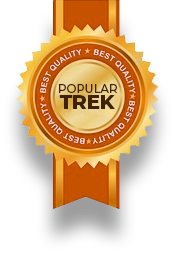
Ausangate Trek Classic
- Max group size: 12
- 5 days trekking
- Max altitude - 5200 metres
- For Adventure Seekers
- 1 day trekking
Ausangate & Rainbow Mountain
- 3 days trekking
Rainbow Mountain: Imperial
- 4 days tour

Rainbow Mountain & Quelccaya Glacier
- 2 days trekking
Rainbow Mountain + Inca Trail
- 9 days treks
- Max altitude - 5100 metres
Ausangate 7 Lakes Hike
- Max altitude - 4800 metres
For us quality of experience is only second to safety.
We are committed to providing world-class trekking experiences for our guests that go way above and beyond the mass-produced tours so common today., 2 days of adventures in the andes.
We did the 2-day tour through Ausangate, the rainbow mountain, and the red valley. The tour was private, the guide Jimmy was very friendly and professional, the whole trip has well organized the food was delicious during the excursion. I thank the travel agency for this beautiful experience, and I recommend it.

We are here to help
Whether you have a single question or a special request, we`re here for you..
hikingduck.com
PERU TOUR OPERATOR
Inca trail tours.
- LUXURY INCA TRAIL HIKE TO MACHU PICCHU 5 DAYS
- CLASSIC INCA TRAIL TO MACHU PICCHU 4 DAYS Best Seller
- INCA TRAIL EXPRESS TO MACHU PICCHU 1 DAY
- INCA TRAIL EXPRESS TO MACHU PICCHU 3 DAYS
- INCA TRAIL HIKE TO MACHU PICCHU 5 DAYS
- SHORT INCA TRAIL TO MACHU PICCHU 2 DAYS Best Seller
The Inca Trail to Machu Picchu tour is a classic for lovers of hiking and landscaping. This route offers you the best experience, from the first day you will take your tour you will witness the best preserved natural and archaeological wonder of the powerful empire of the Incas. Andean Great Treks has been working on this route to Machu Picchu for more than 15 years. Thus, we offer different routes with connection to the Inca trail. The classic 4-day Inca trail that was one of the first trails to be visited by tourists in the 60s. It continues to captivate with its landscape and archaeological charms, it is a 45 km trail, which in its 4 days offers you the best ecosystem ranging from the inter-Andean valley, subtropical mountainous forest, and the cloud forest jungle. Where the largest amount of natural flora and fauna reserves in Cusco are located. Its historical attractions in themselves describe a past full of power and magnificence, which this road represented in the Inca era. That is why you will have the opportunity to explore its religious, urban, agricultural and magical centers throughout its total area. Every day you will visit a different landscape with your route guide, who will explain and answer all your questions about this Wonder. And to finish the tour you will have the advantage of seeing the citadel of Machu Picchu from the famous Puerta del Sol. The short Inca trail tour is designed for people who are not very used to taking long walks, however this small route will delight you with its exclusive natural attraction of beautiful orchids, waterfalls, viewpoints, and the imposing palace of Wiñaywayna, which belonged to the most famous emperor of the Incas Pachacutec. From where you can see how it has an exquisite contrast with the mountains and the Verónica snow-capped mountain. On both tours you will visit the sacred city of Machu Picchu, you will see all the most important sectors, such as the temple of the three windows, royal palace, temple of the sun, sacred rock, houses of the nobles, granaries and terraces. For all of the above, you should visit Peru, a country full of wonderful places, and the best culinary destination in South America.

BEST ALTERNATIVE TREKS
- ANCASCOCHA TREK TO MACHU PICCHU 4 DAYS
- ANCASCOCHA TREK & CLASSIC INCA TRAIL 7 DAYS
- ANCASCOCHA TREK TO MACHU PICCHU 5 DAYS Best Seller
- AUSANGATE TREK TO SIBINACOCHA LAKE 6 DAYS
- AUSANGATE TREK & SHORT INCA TRAIL 6 DAYS
AUSANGATE TREK & RAINBOW MOUNTAIN 7 DAYS
Ausangate trek & rainbow mountains 6 days, ausangate trek + rainbow mountains 5 days, ausangate trek + rainbow mountains 4 days, ausangate trek & vinicunca mountain 3 days, classic ausangate trek 4 days.
- CHOQUEQUIRAO & SALKANTAY TREK & INCA TRAIL 9 DAYS
- CHOQUEQUIRAO TREK TO MACHU PICCHU 5 DAYS
- CLASSIC CHOQUEQUIRAO TREK 4 DAYS Best Seller
- LARES TREK TO MACHU PICCHU 3 DAYS Best Seller
- Lares Trek & Short Inca Trail to Machu Picchu 5 Days Best Seller
- LARES TREK TO MACHU PICCHU 4 DAYS
- HUCHUY QOSQO TREK TO MACHU PICCHU 3 DAYS
- HUCHUY QOSQO TREK TO MACHU PICCHU 2 DAYS
- SALKANTAY TREK TO MACHU PICCHU 4 DAYS
- SALKANTAY TREK TO MACHU PICCHU 5 DAYS
- SALKANTAY TREK & CLASSIC INCA TRAIL 6 DAYS
- Salkantay Trek & Short Inca Trail Hike to Machu Picchu 5 Days Best Seller
- VINICUNCA RAINBOW MOUNTAINS & QUELCCAYA GLACIER 3 DAYS
- TREK TO QUELCCAYA GLACIER 2 DAYS Best Seller
- INCA QUARRY TRAIL TO MACHU PICCHU 4 DAYS Best Seller
- SACRED INCA TRAIL TO MACHU PICCHU 4 DAYS
- SHORT INCA TRAIL TO MACHU PICCHU & YANACOCHA LAKE 4 DAYS
ANDEAN PERU TREKS
Andean Great Treks is a trekking operator in the city of Cusco. We organize high mountain tours and treks to the best mountain destinations, where you can enjoy the best landscapes surrounded by beautiful lakes, turquoise color, and an intense blue sky. Our mission is to make you know the greatest natural paradises such as the great Ausangate circuit, where we offer you the best trekking experience, lakes of glacial origin, of different colors, likewise you will visit the mountain of colors before any traveler manages to arrive and contemplate a sunrise just for you. Another highly recommended destination is the Lares Trek circuit, where you will directly appreciate the craft and textile traditions of the people of Lares, Wacawasi, and Cancha Cancha, they are considered the last descendants of the Incas, due to their wide wisdom in all fields of Andean science, such as natural medicine, organic agriculture, and constructive technology of agricultural terraces. The Inca Quarry tour is very special for its attractive landscape, in this trek you will enjoy varied landscapes such as the Veronica snow-capped mountain, and the Sacred Valley of the Incas, and a direct contact with mother earth, highly respected by the Incas. And finally we cannot miss the other major archaeological attraction of Cusco, the fabulous Choquequirao, this jewel of the Incas, is considered one of the best trekking circuits by the National Geografic magazine, which you must visit at least once in your life. This is due to the incredible landscape where this ancient Inca city has been built. Precisely you reach Choquequirao going down the canyon of the Apurimac river, and then an ascent to the cloud forest, and once there you will enjoy the best experience, since this adventure will be worth it, there is no other similar place like this Inca palace. To all these tourist attractions, our company organizes expeditions, in small groups, and an assistance service with the best quality standards, with the best route guides, highly experienced cooks, and the best trekking equipment for your maximum enjoyment. Decide your next adventure today, and get to know these unique and mysterious beautiful places.
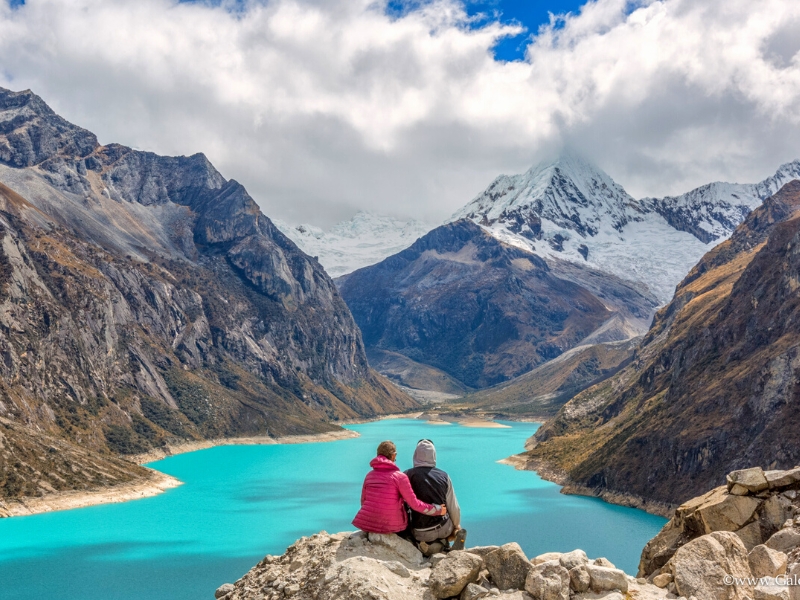
Peru Vacations in Family and Friends
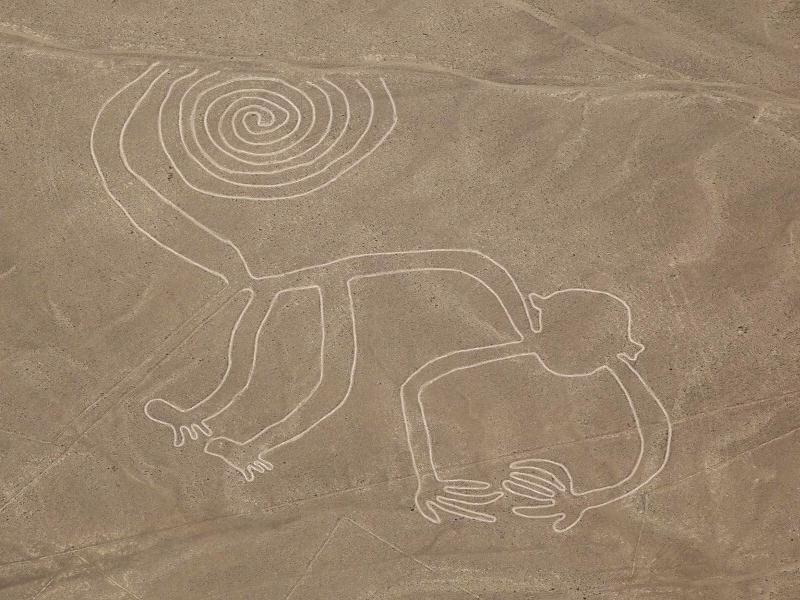
Manu Amazon Rainforest Tours
- MANU AMAZON RESERVED ZONE 6 DAYS
- MANU AMAZON RESERVED ZONE 7 DAYS
- MANU AMAZON RAINFOREST 5 DAYS
- MANU AMAZON RAINFOREST 3 DAYS Best Seller
- TOUR MANU AMAZON RAINFOREST 8 DAYS
- MANU AMAZON RAINFOREST 4 DAYS
Tambopata Jungle tours
- TAMBOPATA AMAZON MACAW CLAY LICK 3 DAY Best Seller
- AYAHUASCA RETREAT IN PERU AMAZON 3 DAYS
- AYAHUASCA RETREAT IN CUSCO 1 DAY
- LUXURY TAMBOPATA RAINFOREST 4 DAYS
- LUXURY TAMBOPATA RAINFOREST 3 DAYS

MACHU PICCHU TOURS
- CUSCO, SACRED VALLEY, MACHU PICCHU, HUMANTAY LAKE & 7-COLOR MOUNTAIN 5D/4N
- MACHU PICCHU, SACRED VALLEY, CUSCO, 7 COLOR MOUNTAIN 4D/3N
- SUNSET TOUR AT MACHU PICCHU 2D/1N
- CUSCO, MACHU PICCHU AND SACRED VALLEY 3 DAYS Best Seller
- MACHU PICCHU & SACRED VALLEY OF THE INCAS 2 DAYS Best Seller
- TOUR TO MACHU PICCHU BY TRAIN 2D/1N
- TOUR TO MACHU PICCHU BY TRAIN 1 DAY
Located on top of a mountain in the middle of a tropical forest, it is considered the best tourist attraction in Peru. The historical sanctuary of Machu Picchu is a place that captivates tourists not only because of its dazzling architectural beauty, but also because of its important historical-cultural legacy, which has led it to be recognized and admired throughout the world. This ancient Inca city is one of Peru's most precious treasures. It was built in the mid-15th century and it is believed that it was one of the residences of the ninth Inca of Tahuantinsuyo, Pachacútec, although there are also the remains of a sanctuary. Its name means old mountain, and refers to the place where it is located, at about 2,453 meters above sea level, on a rocky premonitory between Machu Picchu and Huayna Picchu. Currently, this Inca jewel is one of the tourist centers of the country. Travelers go to Aguas Calientes to start the Inca route that Hiram Bingham, of Yale professor, popularized at the beginning of the 20th century. The Historic Sanctuary of Machu Picchu is considered one of the seven new wonders of the modern world and was declared a World Heritage Site in 1983. It is probably the most amazing architectural construction of the Inca Empire. This citadel is made up of temples, palaces, terraces, monuments, ensembles and walls; In addition to water channels, built with large blocks of stone, without any type of amalgam, proof of the great wisdom of the Inca civilization. The flora and fauna of Machu Picchu are of great importance not only for their natural beauty, but also for their ecological and cultural value. The rich biodiversity present in the area is essential to maintain the ecological balance and sustainability of the region. The flora and fauna of the Machu Picchu area have been used for centuries by local inhabitants, both for food and for traditional medicine. The flora of Machu Picchu is varied, with more than 2,000 species of plants identified in the area. Among the most common plants are orchids, bromeliads, ferns, mosses and lichens. There is also a wide variety of trees, such as alder, cedar, cinchona and molle, growing throughout the valley. The fauna of Machu Picchu is equally impressive and varied, with more than 400 species of birds identified in the region. Among the most common birds are the hummingbird, the quetzal and the cock-of-the-rock. You can also find a wide variety of mammals, such as the spectacled bear, the llama, the puma. Reptiles and amphibians are also present in the area. Among the most common mammals in Machu Picchu are spectacled bears, who "usually feed on fruits, leaves, insects and small mammals." These animals are crucial to the area's ecosystem.

FULL DAY HIKES
- HIKE TO INCA SUN GATE 1 DAY
- TREK TO WAQRAPUKARA RUINS 1 DAY
- TOUR TO SINGRENACOCHA LAKE 1 DAY
- PALLAY PONCHO RAINBOW MOUNTAIN TREK 1 DAY
- TOUR TO PALCOYO RAINBOW MOUNTAIN 1 DAY
- VINICUNCA RAINBOW MOUNTAIN TREK 1 DAY Best Seller
FULL DAY TOURS
- TRAINING HIKE TO DO CLASSIC INCA TRAIL 1 DAY
- SOUTH VALLEY OF CUSCO HALF DAY
- CUSCO CITY TOUR HALF DAY
- TOUR TO QUESWACHAKA INCA BRIDGE 1 DAY
- INTI RAYMI-INCA’S SUN FEST 2024
- TOUR SACRED VALLEY OF INCAS 1 DAY Best Seller
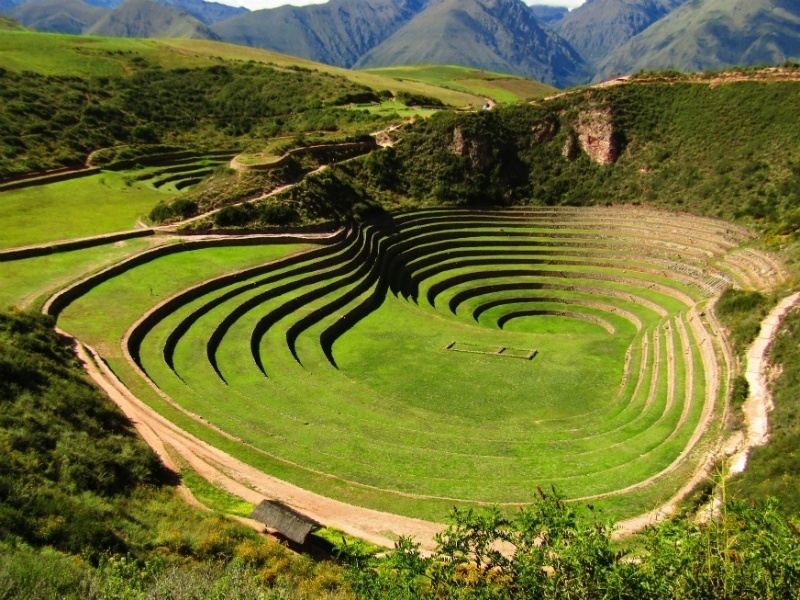
THE ULTIMATE AUSANGATE TREK : EVERYTHING YOU NEED TO KNOW
The ultimate ausangate trek: a complete guide for adventure seekers.
The Ausangate trek is a “little” gem among the attractions of the Cusco region of Peru. To 100 km southeast of Cusco is the impressive Vilcanota mountain range. The mountain range has several peaks over 6,000 meters, including the sacred Ausangate (6372m), the highest mountain in the Cusco region. It is not very popular among millions of tourists that visit the more famous Inca Trail hike to Machu Picchu . The full circuit, is a six day affair although it can be done in a shorter time. There are a few variations of the track, one ends at the Rainbow Mountain, other cuts across the front of the range. There is also a longer version that traverses the entire range of Cordillera Vilcanota.
The Ausangate Trek is renowned for its otherworldly natural scenery. It’s considered by many to be one of the world’s best high-altitude treks, the trek takes hikers over several high passes, into low alpine valleys, and through traditional Peruvian villages. You’ll see snow-capped peaks, herds of llamas, glaciers, and turquoise lakes, all within a stunningly beautiful mountain range. You will also have the opportunity to see the Rainbow Mountains of Vinicunca!
EXPLORE THE BEST ANDEAN TREK IN PERU
Unlike the Inca Trail hike to Machu Picchu , no permit is needed for the Ausangate trek . The hike is one of the quietest in the region and you probably won’t see another hike. While most Ausangate treks are offered on a 6-day itinerary, Andean Great Treks combines the trek with a visit to Machu Picchu. Camping is usually the norm on this route. The Ausangate trek is one of the few treks in Peru that offers the option of horseback riding. However, certain sections of the hike are so steep that you will have to get off and walk alongside your horse. If you are not a confident cyclist, trekking tours are also available.
The hike offers a variety of wildlife including condors, vicuñas, lynxes, and pumas. The campgrounds are usually next to beautiful blue lakes. You will also have the opportunity to bathe in various hot springs and see the rainbow mountains from the trek! The colorful sandstone mountains in the Vinicunca area are probably the best thing you will see in Peru!
If you are looking for the ultimate adventure, the Ausangate Trek is by far one of the best treks in Peru! Reaching altitudes of up to 5400m, the Ausangate trail offers an ‘off the beaten track’ experience boasting turquoise glacier lakes, snow-capped peaks, rainbow mountains, hot water springs, and much more!
WHERE IS LOCATED THE AUSANGATE TREK?
The Ausangate Mountain is a natural attraction that is located in the district of Ocongate, within the province of Quispicanchi, in the department of Cusco. That snow-capped mountain is part of the Cordillera de Vilcanota and, according to an ancient legend, it was the brother of the Salkantay snow-capped mountain.
The Ausangate Mountain, has a height of 6,384 meters above sea level; and is considered an apu, or protective deity of the peoples that surround it; as well as the most representative mountain in the region. Its size is such that it can be appreciated even if one is in the Sacsayhuamán Fortress, not in vain is it considered the fifth highest mountain found in Peru.
This beautiful snow-capped Cusco impresses the eye, due to its incredible natural formations; In it, there are not only beautiful water mirrors such as the Sivinicocha, with turquoise waters, but also stone forests, glaciers and high plains that seem to make this natural attraction a paradise on earth, especially for those tourists who are interested. for adventure sports since the geographical features of Ausangate make it ideal for practicing sports such as rock climbing, ice climbing, trekking, among other activities.
The Ausangate trek appears before our eyes as a mountain challenge; It is known that the first attempts to ascend it occurred in the early fifties of the last century, there were two frustrated first attempts to conquer the top of the mighty Apu, it was not until 1953, when a German expedition achieved the goal, climbing the mountain on its southern slope, in posterity, new routes were opened for the conquest of the Apu, however, only in 1983, thirty years after the first ascent, Peruvian feet crowned the top of the majestic snow-capped mountain.
At present, different companies have been promoting the Ausangate route as a trekking route, one of its purposes is that the expeditionists manage to surround the snow-capped mountain, although to date, few seasoned visitors have dared to follow it. Those who are interested in climbing this snowy mountain must know that they must have had enough time to practice before, since the Apu is not a snowy peak for beginners; so if you are an intermediate level mountaineer, it is recommended that you go in the company of a larger group of people experienced in the field.
THE LEGEND OF THE AUSANGATE MOUNTAIN
The Inca tradition tells that Salkantay and Ausangate were two brothers who lived in Cusco. After a terrible time of drought, both ventured into strange lands to save the town from the crisis. Salkantay went north and found the jungle, and there, Veronica’s forbidden love; instead, Ausangate went south, to the highlands, and there he found a large amount of Andean food, such as camelid meat, corn, and potatoes, which he sent to the population.
The Chillca community, made up mostly of llama and alpaca farmers and herders, is known as the guardian of these beautiful landscapes. Every year on the slopes of the mountain the Qoyllur Ritti festival -“star snow” in Quechua- is celebrated before the Corpus Christi festival, during which thousands of people make a pilgrimage to the Sinakara temple where the painting of the Crucified Christ engraved on a rock. This pilgrimage has been named Intangible Cultural Heritage of Humanity in 2004.

WHAT IS THE ALTITUDE OF AUSANGATE TREK?
The Apu Ausangate is the fifth highest mountain in Peru at 6,384m, and is the highest of the 6 peaks that exceed 6,000m located in the Cordillera del Vilcanota in the Cusco region. The first ascent was made in 1953 and was led by the famous Austrian climber Heinrich Harrer, part of his first group conquered the north face of the Eiger, which was the story and script for the book/film “Seven Years in Tibet” (The renowned actor Brad Pitt was the protagonist of this film).
Ausangate is the most famous and well-known snow-capped peak in Cusco, the normal route to reach its summit is not very technical and difficult, but a lot of resistance and strength are needed to break the path with loose or accumulated snow to the summit stalls. Ausangate is the main Apu in Cusco and can be seen from many places in the city. It is rarely visited by tourists in this part of the region but is becoming popular as a destination to do the Circuit Trek around the snow capped in the dry season.
The altitude is insane. I’ll mention again that this trek never drops below 14,000 feet! Many of the passes are grueling and tower over 16,000 feet. The mountains are Apus, or Gods, to the Indigenous, so go in with the mindset of respecting them in this regard. By the way, the mighty mountain of Ausangate is a staggering 20,945 feet (6,384 m).
HOW IS THE LANDSCAPE IN THE AUSANGATE TREK CIRCUIT?
Ausangate is surrounded by extensive and luminous turquoise lakes such as Sibinacocha, as well as stone forests, glaciers and vast plains that impress with their magical landscape. Reaching the top of Ausangate involves a journey of 5 days and 4 nights along 70 km, which is why it is considered one of the most challenging trekking routes in the Andes. However, during the walk, the traveler witnesses incredible postcards: multicolored mountains, herds of alpacas and desert cliffs that together create an incredibly beautiful outdoor experience from start to finish.
The landscape is stunning. The imposing chain of mountains of the Cordillera de Vilcanota with its snow-covered peaks takes the breath away from those who dare to explore it.
There are more than 400 glaciers that extend between the Cusco and Puno regions. One of them is Ausangate , the guardian mountain of Cusco that gave its name to the regional conservation area created in December 2019, over an area of 66,514 hectares distributed between the provinces of Quispicanchi and Canchis, in the department of Cusco.
BEST TIME TO VISIT THE AUSANGATE TREK
Like most trek in the region, the best time to do the Ausangate trek is in the dry months between May and September. Unlike other popular treks, the Ausangate trek is very quiet, even in peak season.
In the shoulder months of April and October weather is still pleasant and the trek is very possible. However, because of its altitude you’ll have to contend with freezing nights, even in the dry season. Because of the altitude and snow, the trek is best avoided in the wetter colder season between November and February.
Temperatures during the day in the dry months are usually quite mild and visibility is very high. Because of the height you’ll want to make sure you are wearing layers, especially for the colder nights.
Because of its high altitude and frigid air, rainy season in the region often translates to snowfall for Rainbow Mountain. Visitors to Ausangate Trek and Rainbow Mountain should come prepared with clothes for all weather, as conditions can also change quickly. For more information about when to visit, make sure to check out our blog on the best time to visit Peru.

AUSANGATE TREK OVERVIEW
Peru is famous for being home to many exhilarating treks. Though not as popular as some of the other trails accessible from Cusco, the Ausangate trek is just as worthwhile. In fact, being less crowded with tourists is part of its charm. It guarantees travelers who venture on this remote journey a more unique experience. While you won’t come across Incan ruins, it makes up for it with breathtaking natural scenery and spiritual significance. Spot spectacular snow-capped peaks, gorgeous lakes, and wonderful wildlife, including herds of llamas and alpacas. The centerpiece of the trek is the mighty Apu Ausangate , one of the tallest mountains in Peru.
The Ausangate Trek is a high altitude 70km hike in the Peruvian mountains near Cusco with an average altitude of over 4000m. Unlike most other hikes in the region Ausangate is not about Inca ruins, it’s all about beautiful scenery; snow peaks, glaciers, colorful mountain lakes, and the Rainbow mountain. If you like beautiful nature, going off the beaten track and hiking this trek is for you.
Ausangate is one of the most challenging hikes around Cusco but at the same time one of the most rewarding in sense of scenery. If you have any doubts about hiking Ausangate on your own read this article we hope it’ll help you decide whether to do an independent or guided trek. For more info on all our favorite hikes in Peru.
Basic Information
- Length: 4-6 days
- Distance: 43 miles (73 km)
- Highest altitude: Palomani Pass – 17,000 ft (5,165 m)
- Average altitude: 13,123 ft (4,000 m)
- Elevation Gain: 9,406 ft (2,867 m)
- Difficulty: Challenging
HOW MANY DAYS TAKES THE AUSANGATE TREK?
There are circuits from 3 to 7 days, which have different starting and ending points. It is advisable to do each circuit with a certified and highly experienced tour operator. The Ausangate Trek is a challenging high altitude trek through 70 km of the Cordillera Vilcanota mountain range and features some of Peru’s most extraordinary scenery. Ausangate is an off-the-beaten track hiking alternative with minimal foot traffic that allows you to carve into the mystical side of an ancient Andean world.
A voyage to Ausangate mountain is one of natural beauty, living history and ancient spirituality. Considered challenging, this trek is recommended for seasoned hikers only, who have experience hiking at high elevations. The route takes you through the Cordillera Vilcanota, or the Vilcanota Mountain Range. Ausangate is actually the 5th tallest mountain in Peru, standing at 20,945 feet above sea level.
Through the Ausangate trek , you’ll ascend and descend through the mountain range, finding sweeping Andean vistas, thermal lakes, mystical glaciers, green mossy passes and enormous snowy mountains. Along the way, you’ll catch a glimpse of interesting wildlife, like condors, chinchillas and groups of vicunas. You’ll also come across hidden Andean villages richly embedded in centuries-old traditions. The highest point of the trek is 16,800 feet above sea level and the highest campsite elevation is at 15,255 feet.
HOW DIFFICULT IS THE AUSANGATE TREK?
The Ausangate trek is considered strenuous, with a few moderate days sprinkled in. The trek is classified as Grade C in difficulty, which implies altitudes between 14,800 to 16,400 ft (4500-5000 m) and 6-7 hours of hiking per day. Many of the days have steep sections that cause rapid altitude gain in a short time. Anyone with a good level of fitness can manage this hike, but it is recommended that trekkers have experience with multi-day hikes at high elevations.
Another factor to consider, aside from the steep sections and 16,000 ft+ elevation passes, is the weather. The weather can be quite unpredictable, and blizzard conditions at the higher altitudes are not uncommon. It is important to factor the low temperatures and your tolerance to cold and snow when determining your suitability for this trail.

WHAT KIND OF FOOD THERE IS ON THE AUSANGATE TREK
Andean Great Treks is proud to have the best staff of chefs specialized in high mountains, with more than 15 years of experience, in the different trekking routes in Cusco. On our Ausangate route we provide you with the best food service every day, our chefs will prepare meals with 100% fresh and organic foods, since our company is focused on community work and support for farmers who provide us with their best fruits. You can taste the best Peruvian and Cusquenian cuisine, during the breakfast we will have pancakes, omelettes, coffee, milk,butter, cereals, and very nutritious breakfast of Cusco based on oatmeal, quinoa, wheat, etc.
Lunches and dinners are served buffet style, such as sauteed loin, quinoa chaufa, salads, vegetable soups and products from the Andes, chicken, steak, alpaca.
If you are allergic to any type of food or do not consume gluten, or are vegetarian, it is no difficulty for us as we are trained to provide food under these food standards.
In general, Andean Great Treks handles an order and quality in the handling of the products, taking care of their safety so that no illness or discomfort happens during the days of hiking on the Ausangate mountain.
IS WATER INCLUDED ALONG THE AUSANGATE TREK ?
On the Ausangate Trek it is possible to find shops to be able to supply water on the first day. You will then be provided with water that is boiled and then filtered, to avoid any kind of illness or discomfort. It is not a good idea to drink water from waterfalls, lagoons or streams, as many of them could contain toxic minerals or bacteria that are harmful to human health.

EXPLORING THE VINICUNCA RAINBOW MOUNTAIN
Rainbow Mountain, or Montaña de Siete Colores, is a very popular destination. Here you can see these iconic mountains with rich mineralization bringing red, orange and yellow hues across a seemingly endless mountain expanse. It’s truly a sight to behold.
This part of the trek would bring you to a soaring 17,060 feet above sea level. This portion also tends to be, by far, the busiest part of an otherwise remote journey. It is important to keep in mind the crowds and higher elevation (higher than any other point on the classic Ausangate) to decide if you’d like to add this portion to your Ausantage hike . Talk to a travel advisor for more information.
The best day trekking tour Rainbow Mountain Trek was opened in 2015. It is a very popular tourist destination in the city of Cusco, you will undoubtedly enjoy the wonderful hill of colors. The Apu Ausangate is very close to the 5th highest snowfall in Peru, to see this attraction it is good to acclimatize at least one day, because it rises to 5200 meters high. On the road you can see llamas, alpacas, vicuñas. Native peoples who speak Quechua.
GEOLOGICAL FORMATION OF RAINBOW MOUNTAIN VINICUNCA
The geological formation of the mountain of the 7 colors, caused many of us an interrogation, perhaps without an answer at that moment, today we will inform you about the geological formation of this natural wonder. The formation of the rainbow appearance of the Vinicunca is due to the marine, lacustrine and fluvial sediments transported by the water that previously covered the area. These sediments date from between the Tertiary and Quaternary periods, approximately 65 million years ago.
The formation of a mountain is due to the alterations of the terrestrial layer and the movement of the tectonic plates, in these alterations the environment, the climate and other external factors have a lot to do. Have you ever wondered why mountains are conical in shape? The conical shape of the mountains is because ice usually forms on the top of the mountain.
Over time, these sediments formed layers, which are today the famous colored layers. The movement of the tectonic plates in the area raised the colorful sediments that became great mountains. After this, the mountains acquired their striking colors due to the oxidation and erosion of minerals in the soil. Then, due to climate change, it causes it to thaw and this causes the mountains to drain and these generate streams of water that run towards the lower area until they run into rivers or lagoons until they mix with the ocean depending on climatological factors and because of From this process the mountain wears down and takes its cone shape.
There is no doubt that the mountains are a masterpiece of nature, from the top of a mountain we can appreciate everything that surrounds us and enjoy it.
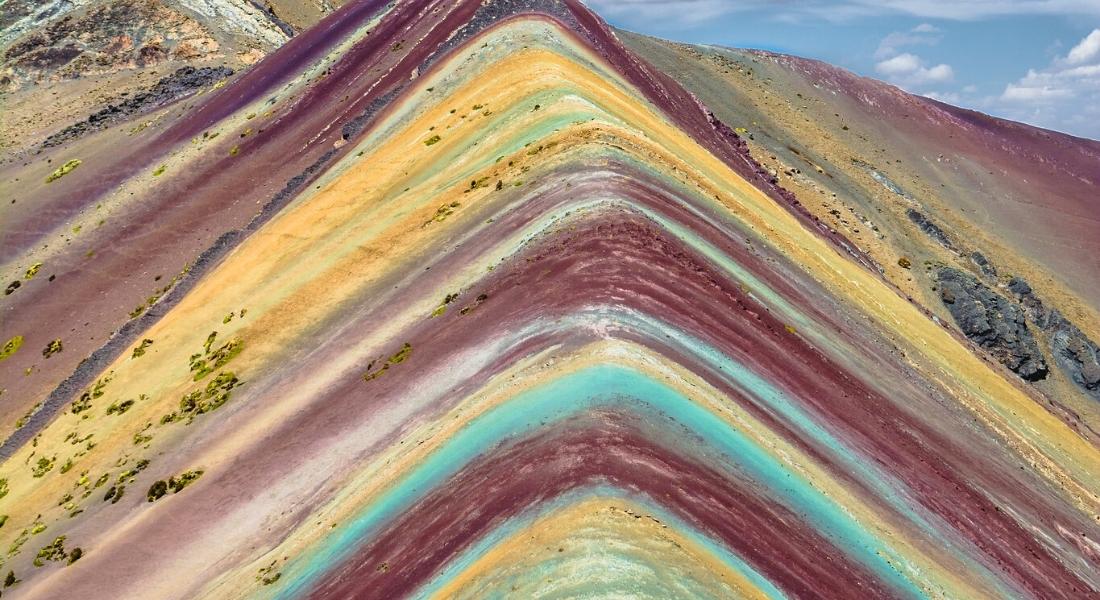
WHAT IS THE ORIGIN OF THE COLORS OF THE RAINBOW MOUNTAIN
The rainbow aspect of Vinicunca is due to “a complex geological history of marine, lacustrine and fluvial sediments,” according to a report by the Cultural Landscape Office of the Decentralized Directorate of Culture of Cusco. These sediments, transported by the water that previously covered the area, date from between the Tertiary and Quaternary periods, that is, from about 65 to two million years ago. Over time, the sediments formed layers (with different grain sizes) that today are seen as the strips that attract tourists so much.
The movement of tectonic plates in the area raised these sediments until they became mountains. Then they began to acquire their striking colors due to the oxidation of their minerals, exerted by the humidity in the area, and their erosion.
Composition of each strip according to its color:
• Pink or fuchsia: mixture of red clay, fangolitas (mud) and sand. • Whitish: sandstone (quartz sand) and limestone. • Purple or lavender: marl (a mixture of clay and calcium carbonate) and silicates. • Red: argillites and clays. • Green: clays rich in ferromagnesia (a mixture of iron and magnesium) and copper oxide. • Yellowish brown, mustard or gold: limonites, calcareous sandstones rich in sulphide minerals (combined with sulphur).
Juan Carlos Gómez, from the Geophysical Institute of Peru (IGP), told BBC Mundo that the hill was “partially” covered with ice and that it received temporary snow until the early 1990s.
Along the same lines, Fabián Drenkhan pointed out that he does not believe that the summit has been a glacier in recent years or decades. The residents of Pitumarca, according to Haydee Pacheco, from the municipality of this district, say that there was snow about 70 years ago.
Pacheco explains that the mountain gained popularity thanks to the promotion of tourists who walked through the place in the direction of Ausangate , a sacred mountain for the people of Cusco.
DO I NEED REALLY THE TREKKING POLES ON THE AUSANGATE TREK
The answer is that if, since having trekking poles on the Ausangate Trek route is vital, this instrument will help you overcome very difficult barriers, and have it in good balance during well-sloped descents. The type of cane that is recommended is of free will for you, since these define according to the food you are going to provide, it can be aluminum, carbon fiber, or other material, but if it has a good resistance When hiking, another no less important detail is that you must have the metal protectors at their tips, usually you will be accommodated with rubber soles. Preferably those that can be easily packed and tied.
IF I DON’T HAVE A GOOD SLEEPING BAG , CAN I RENT IN CUSCO
If you can rent a sleeping bag in our office in Cusco. For the Ausangate Trek it is necessary to have a sleeping bag that has the resistance specification at -15 C ° to -20 C °. Because otherwise you will feel very uncomfortable with the icy weather of the Ausangate Mountains.
COMPARISON WITH OTHER TREKS
The Ausangate trek doesn’t end at Machu Picchu. If you want to combine a trek with a visit to the ancient citadel, consider one of the treks to Machu Picchu. The most popular are the Inca Trail hike to Machu Picchu , Salkantay, and Lares treks. That being said, there are several other reasons visitors choose to hike the Ausangate trek. Especially those who have already seen Peru’s World Wonder, or travelers aiming to avoid the large crowds.
- Unlike the Inca Trail hike to Machu Picchu , there is no permit needed for Ausangate. It is thus much easier to organize and does not require booking months in advance.
- Ausangate is not as popular as other treks in Cusco, meaning fewer tourists can be found on the trails. You are guaranteed a more tranquil experience, even during the high-season from June to August.
- Ausangate gives you the unique opportunity to explore Vinicunca, the Rainbow Mountain. Vinicunca is not included on other treks and normally must be visited on a day trip from Cusco.
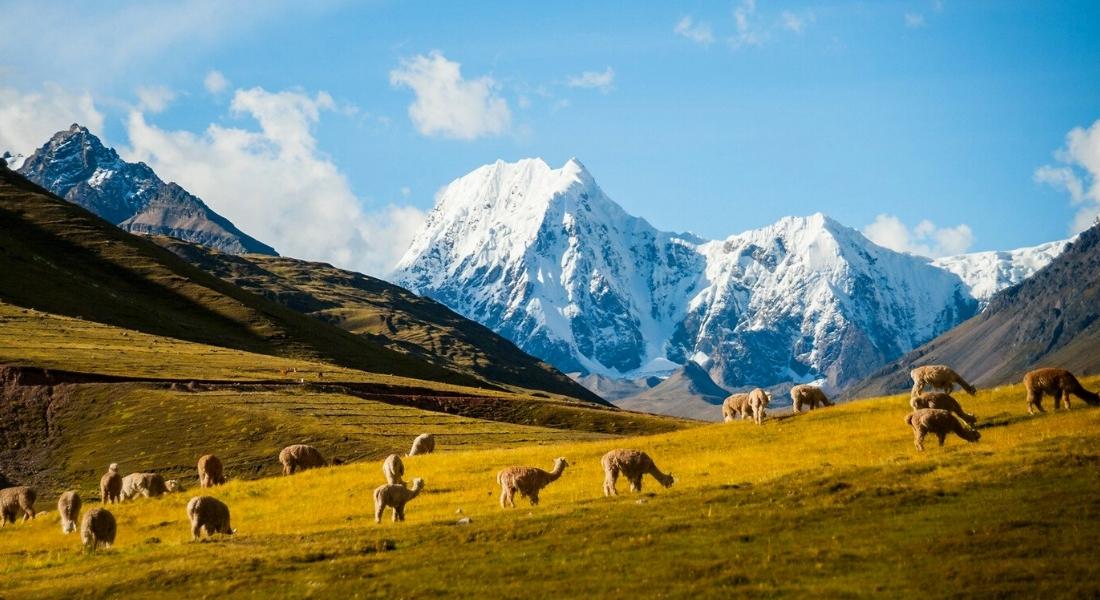
GUIDED TOUR VS INDEPENDENT TREK
Many hikers enquire whether it’s possible to do the trek on their own, or whether they need to go with a guide. In theory, it is possible to complete the trek without a guide. However, due to the high altitude it is only recommended for those with advanced hiking experience. While it may be more expensive, hiking with a guide will make the experience much more enjoyable. Especially for travelers who do not consider themselves professional hikers. See below for a full comparison of the advantages of hiring a guide vs. hiking solo.
Ausangate Trek With a Guide
- All logistical details, including transportation are taken care of. You will be picked up and dropped at your hotel in Cusco.
- Trekking companies provide tents and other items required for the trek. This will save you having to travel with bulky gear that is difficult to transport.
- Extra staff members on the trek can improve your experience. Chefs cook nutritious meals to boost your energy. Porters help you carry some of the heavy gear, including your tent.
- Hiking with a guide will give you a local’s insider knowledge on the trek. You will gain a deeper understanding of the significance and importance of Ausangate’s role in Andean culture.
- The presence of a Spanish speaker who is familiar with the area is valuable in case of an unexpected event.
Lodge to Lodge Ausangate Trek
- While camping is the standard on the Ausangate trek , some tour companies organize a lodge to lodge tour.
- On this version of the trek you will stay in basic, yet comfortable, tambos (Andean lodges) each night.
- Be aware that this will change the itinerary of the trek, as the tambos are located off of the main trail.
- Also, the lodge to lodge version can be significantly more expensive than the standard trek.
Ausangate Trek Without a Guide
- If you are a very experienced hiker, you may prefer trekking on your own.
- You can run the risk of suffering an accident, or getting lost on the route, the ausangate trek is not recommended to be done on your own, you are exposed to extreme climates, and mountains far from the towns.
- There is no strict schedule to stick to. You are free to make your own itinerary and move at your own pace.
- The cost is significantly lower than traveling with a professional tour company. Especially if you already have your own gear.
AUSANGATE TREK HIGHLIGHTS
The Ausangate trek is different to other treks, mostly because it does not offer a visit to Machu Picchu. Nor does it visit other Incan ruins. Instead, its highlights are natural attractions, including glaciers, colorful lakes, and precious wildlife. Being so close to Rainbow Mountain, it even offers trekkers a chance to visit this popular attraction. In addition, you will encounter remote Andean villages that still retain their traditions. Read more below about the highlights of hiking the Ausangate trek.
Apu Ausangate
For the Incas, mountains served as a connection between the middle and the upper worlds. Important mountains were called “Apus“, named after protective spirits they believed to live inside them. Apu Ausangate is the tallest peak of the Vilcanota Mountain Range in the Cusco region. It is also the fifth tallest mountain in Peru, measuring 20,940 ft (6,384 m). Though the trek does not take you to the top, you will get unrivaled views of its majestic, snowy peak.
Glaciers and Lakes
Apu Ausangate’s nickname is “Creator of the Waters” because of its many glaciers. They are the source of several lakes and rivers that supply water to other parts of the country. For example, the Vilcanota River goes on to feed the famous Amazon River. Thus, Ausangate has a special significance for Peruvians to this day. On the trek, you will come across gorgeous lakes, each of which with its own unique color. The colors range from green to blue, turquoise, and even red.
Rainbow Mountain
One of the biggest attractions of Ausangate Trek is a chance to visit the famous Rainbow Mountain. Mineral rock sediments found in the sandstone give this mountain its iconic colors. While not on the trail itself, a visit can be easily arranged on a one-day detour. See the day-by-day itinerary below for more details on how to incorporate it into your trek.
Flora and Fauna
The Ausangate trek passes through remote areas untouched by mass tourism. This has preserved it as a habitat for many wildlife species found in Andean Mountains. Come face to face with llamas, alpacas, vicuñas, and vizcachas (South American rabbit-like rodents). There are also various types of birds, such as Andean condors, black-chested buzzard eagles, and hummingbirds.
Andean Culture
Several Andean villages are dotted across the trail of the Ausangate trek . These remote Andean communities still retain their rich culture and traditions. Once a year, 10,000 pilgrims gather to celebrate Qoyllur Rit’i, the festival of the “Snow Star”. Several pilgrims climb Apu Ausangate searching for the legendary snow star. At the base of the mountain people celebrate with traditional dances. This event takes place over four days at the end of May or early June, coinciding with the full moon. Visitors who travel at this time are welcome to join the festivities.

TIPS FOR THE AUSANGATE TREK
When hiking the Ausangate trek , following certain guidelines will help you stay safe. Choosing the right time to visit is important to avoid torrential rain and mudslides. Adjust to the altitude before you trek and stay hydrated to prevent altitude sickness. Purchasing travel insurance will help you in case something goes wrong. Read the trekking tips below for more details on safety and other useful information to help you plan your trip.
Pick the Best Time to Travel For You.
Excessive rain from December to February can erode the trail and even create mudslides. Not only is it unpleasant to hike in these conditions, but it can also be dangerous. If hiking during the rainy season, listen to any updates from the Peruvian authorities regarding the conditions on the trek.
Be Prepared for High Altitude.
Spend at least 2-3 days in Cusco or the Sacred Valley before embarking on the trek. You will enjoy the trek more once your body has had time to acclimatize. If you feel yourself getting symptoms of altitude sickness, take a break and don’t push yourself too hard.
Tell Others About Your Plans.
When traveling independently, keep an itinerary of your trip at home with family and friends. There is no phone reception on the Ausangate Trek , making it impossible to communicate in an emergency. Informing others of your plans will allow them to seek assistance if they haven’t heard from you.
Practice Your Spanish.
Most locals in these remote Andean villages do not speak English. Knowing at least a few basic phrases, or having a dictionary handy, can help you communicate if necessary.
Drink Plenty of Water.
If hiking through a reputable travel agency your trekking company will be able to provide you with water. If hiking on your own, be sure to use water purifying tablets before drinking water from natural sources. Staying hydrated is especially important in order to prevent symptoms of altitude sickness.
Purchase Travel Insurance.
As with any outdoor adventurous activity, the Ausangate trek can be unpredictable. Cancellations due to weather, mudslides, etc. may occur. There is also risk of injury or illness. For peace of mind, invest in a comprehensive travel insurance plan that will cover you during your entire trip.
How To Get There
Lima is the nation’s bustling capital and travel hub, where all but a few international flights land. From there you need to connect to a domestic flight to Cusco There are many flights per day and the journey only takes about 1 hour. Several airlines fly this route, including some low-cost options. However, the most reliable option is LATAM.
Cusco is the base for most popular treks in the region. From here, arrange the Ausangate trek with a reputable travel agency, which will take care of all logistic details. Your guide will meet you at your hotel and take you to the trailhead. At the end of the trail you will be dropped off back at your hotel.
If you prefer to trek independently, make your own way to the small village of Tinqui. It is located about 100 km from Cusco. You can either arrange your own private transportation or take a public bus. Buses leave from Terminal Paradero Livitaca and the journey takes about 2.5 hours. From Tinqui, follow the signs until you arrive at the trailhead.
Accommodation In Cusco
You will need to arrange accommodation in Cusco for before and after your trek. There is a wide variety of hotels available, ranging from cozy, family-owned inns, to luxurious 5-star resorts. While there are options that fit every budget, it may be worth splurging on your hotel. After such an adventurous trek, arriving somewhere comfortable for some well-deserved rest will certainly feel worth it.
If you would like to visit the Rainbow Mountain, be sure to plan ahead. When organizing your trek with a travel agency, let them know in advance. Not all trekking companies include it in their itinerary by default. The dry season is the best time to see the vivid colors on the mountain as pictured in photos. During the rainy season, it can often be covered in snow, leaving travelers disappointed. Unlike the rest of the Ausangate trek , Rainbow Mountain is very popular with tourists so be prepared for large crowds.
TEXTILE ART ON THE AUSANGATE TREK ROUTE
Another of the typical occupations of these shepherd towns is textile production, a job they perform with singular skill. It is common to see women, usually mothers and daughters, spinning delicately while tending the cattle under their responsibility. Or while they handle the stick loom they set up in the patios of their adobe and clay-tiled mansions. The iconography of the designs in alpaca and sheep wool of the garments that are woven in the province of Quispicanchi, the quality of the fiber used, the natural and sometimes mineral dyes that the artisans prepare, as well as the innate skill with which they weave , inherited from his elders, characterize his work. Experts in making Unkus to bring the coca, the snack and the supplies for the offering to the land; Chuspas where they keep the coca leaves and the lime that they have to take to the fields; Ponchos and scarves that give enough shelter; the Lliqllas that women use to carry babies; the Chumpis or belts; the braids that are placed on the waist, the bracelets, the headbands and other articles of the finest finish that show their admirable knowledge of textile art. Both in Ccatcca and in Ocongate there are two craft centers that serve visitors whose offer is increasingly adapted to the demands of the modern market; in fact, some of its weavers have participated in very prestigious fashion competitions. Artisanal producers who have been trained by the Jesús Obrero-CCAIJO Association work in them: their work is very delicate and the designs of their iconography allow us to listen to the daily life and worldview of the province’s inhabitants. Along the paths or in the communities’ own ranches you can always find a fabric or garment to your liking and at good prices. Paying what it really costs to produce a poncho, a lliclla or a scarf made by hand and with great patience by a local artisan is a contribution that can be fulfilled.

WHO ARE THE CHEFS AND MULETEERS OF THE AUSANGATE TREK
Our chefs and muleteers are humble people who live in the high Andean area of Ausangate Mountain. In their communities, they raise domestic animals and are dedicated to agriculture. Therefore, It is common to see locals trading their products with people from nearby. Those are their main source of income for most families.
Muleteers are the backbone of the Ausangate Trek . Their work consists of hauling all the necessary camping gear and food from campsite to campsite until the Ausangate tour is completed.
Most of them are men, and only a fraction of less than one percent are women. Most of them are young men between the ages of 18 and 45 who come from many distant villages located as far as 100 miles away from Cusco. A good portion of them are farmers who work only part-time, while the rest are people who have migrated to Cusco due to lack of employment and opportunities in their small villages.
Sustainability. Most Ausangate Trek tour operators brand themselves as Sustainable, Eco-friendly, and Ethical. However, the reality of the Ausangate Trek has shown that this is far from the truth. Chefs and Muleteers are fundamental to the operations of the Ausangate Trek . They perform a backbreaking job, literally. Without them, it would be simply impossible for most people to try hiking in this place.
Ausangate Trek providers should ensure that muleteers should have decent nutritious food equal to the food tourists consume, backpacks that will not hurt their backs, and tents of the same quality as the tents tourists use.
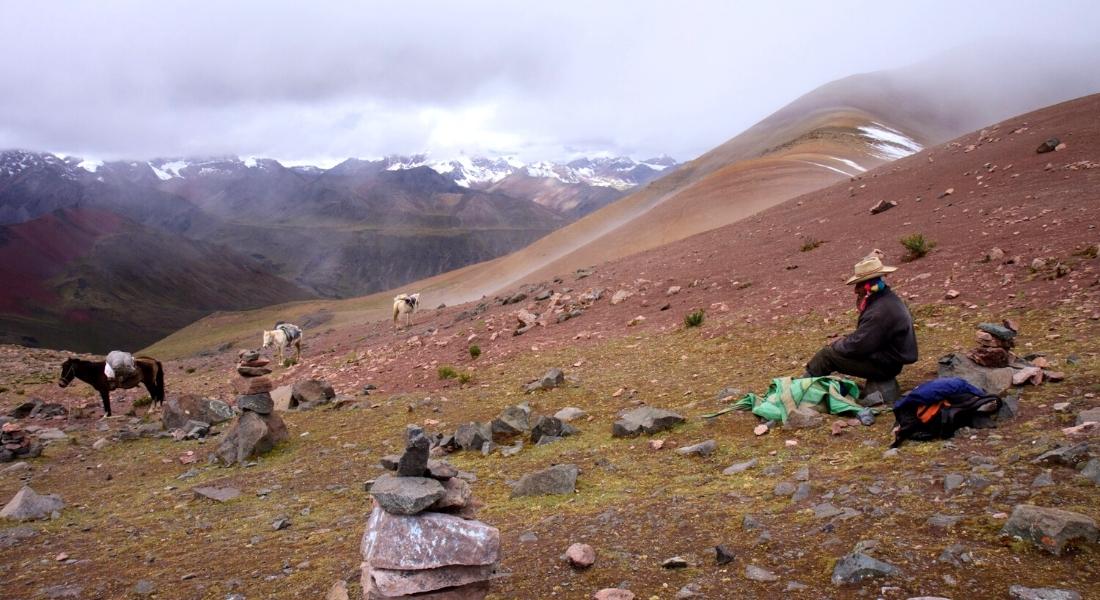
RELATED TOURS
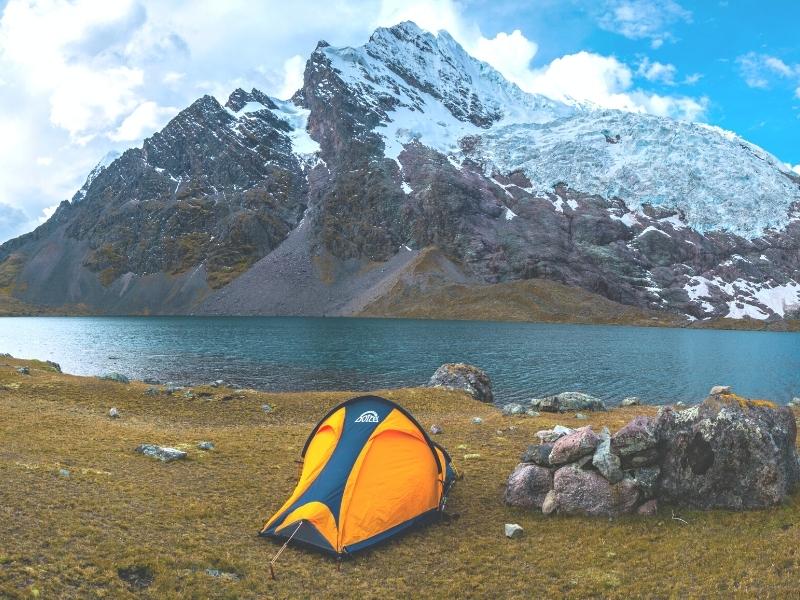
Ausangate is an excellent and quiet/remote trekking circuit offering stunning features such as spectacular mountain scenery, snow-capped peaks, hot springs, turquoise lakes, glaciers, herds of llamas, alpacas, and wild vicuña, picturesque villages, and traditionally dressed Quechua people.
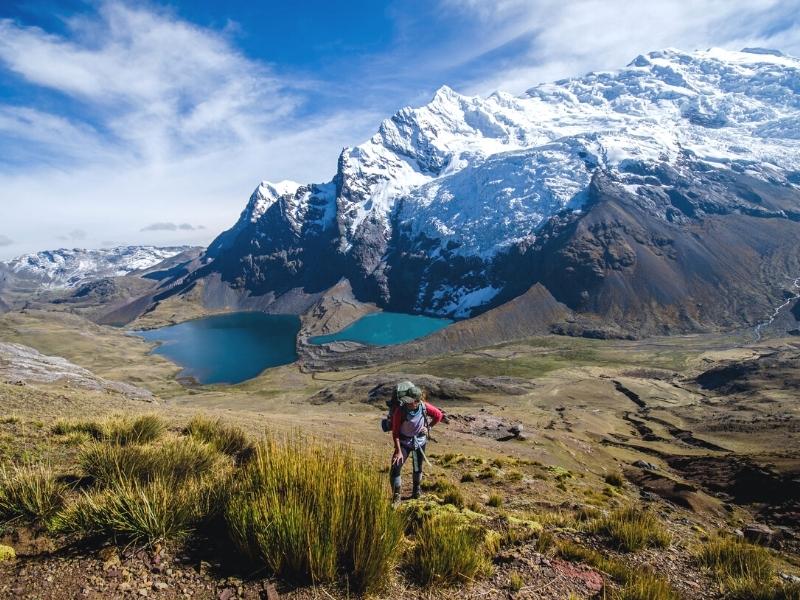
The Ausangate Trek is one of the hiking circuits, most incredible for the beauty of its landscapes, in this mountain adventure you will enjoy unique scenarios, such as lakes of different colors (blue, green, turquoise, red), the mythical mountain of rainbows and ancient Andean cultures, who are the true heirs of the Incas, many still celebrate their ancestral rites.
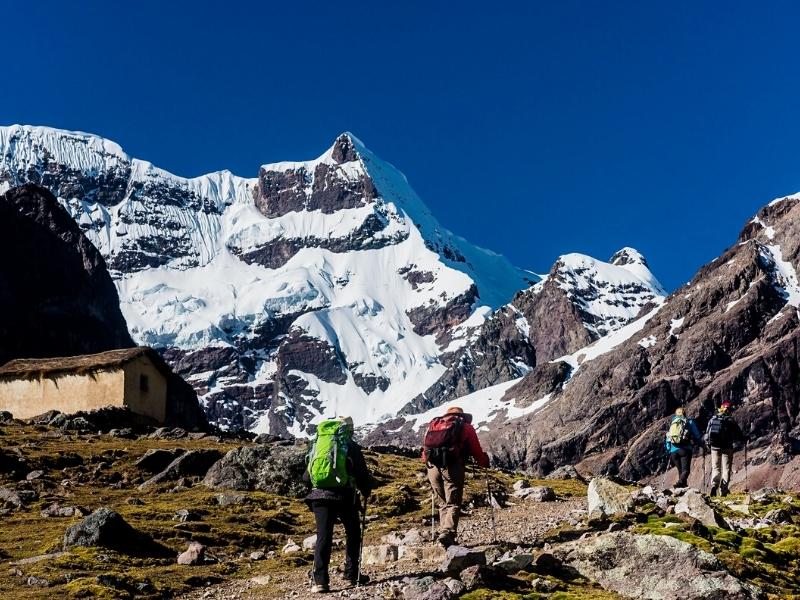
Ausangate Trek is in the Top Ten highly Recommended Treks in the World. Ausangate Trek 5 Days offers you a real taste of the Andean life, impressive mountain scenery, remote Andean villages, hot springs, and turquoise lakes.
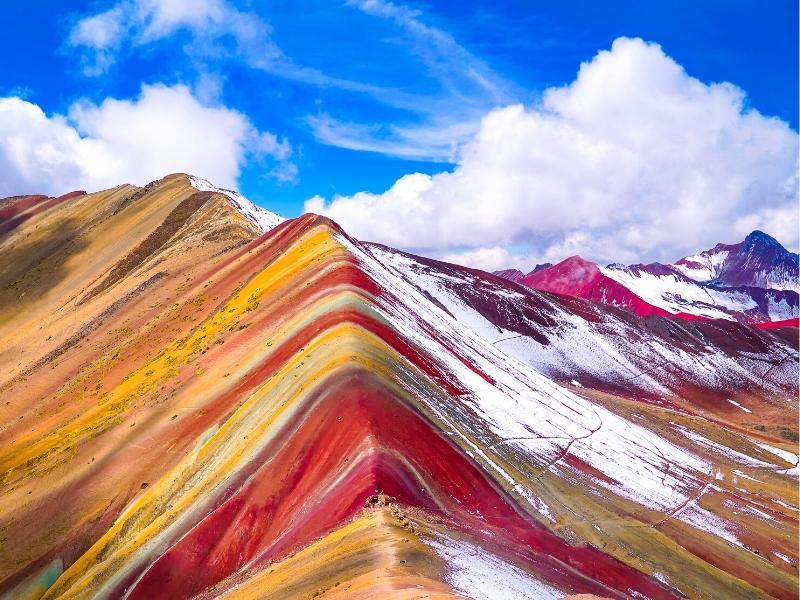
Explore the mythical mountain of Ausangate Trek, and the rainbow mountain. Andean Great Treks organizes this tour only in small groups, with the best trekking equipment.
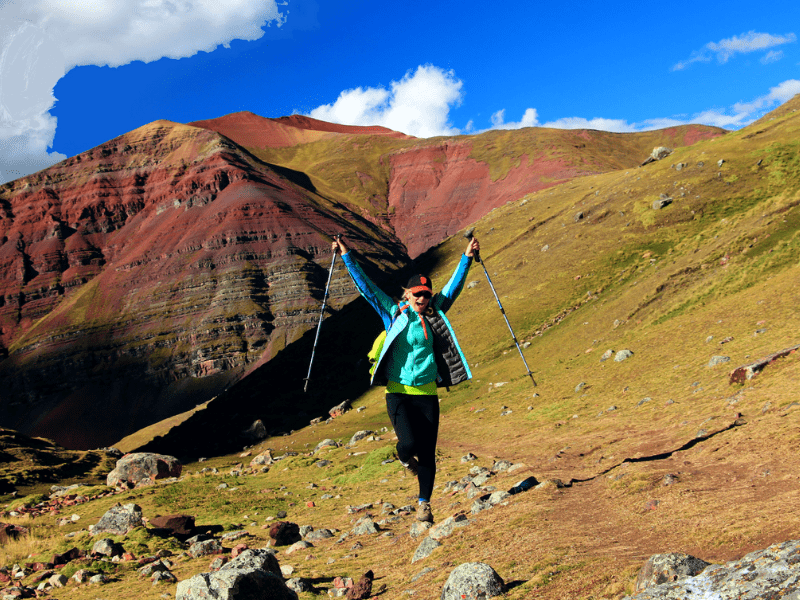
Ausangate Trek & Rainbow Mountain, Explore this route of turquoise lakes, imposing snow-capped mountains, little-visited trails and Very experienced trekking guides.
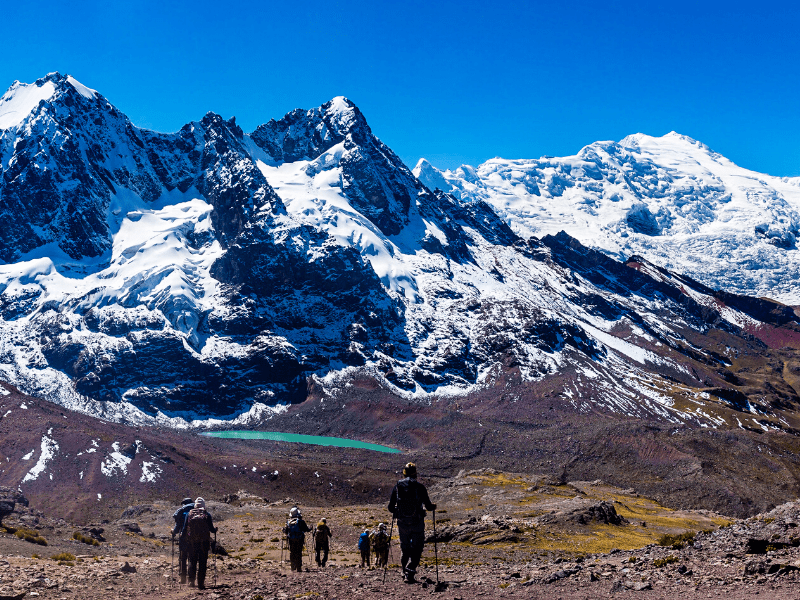
The Ausangate trek offers a fascinating route through the Andes of Peru. You can enjoy stunning mountains and blue lakes, villages with very friendly people who still maintain incas ancient customs.
ARTICLES IN ANDEAN GREAT TREKS

THE 6 REASONS TO VISIT MACHU PICCHU
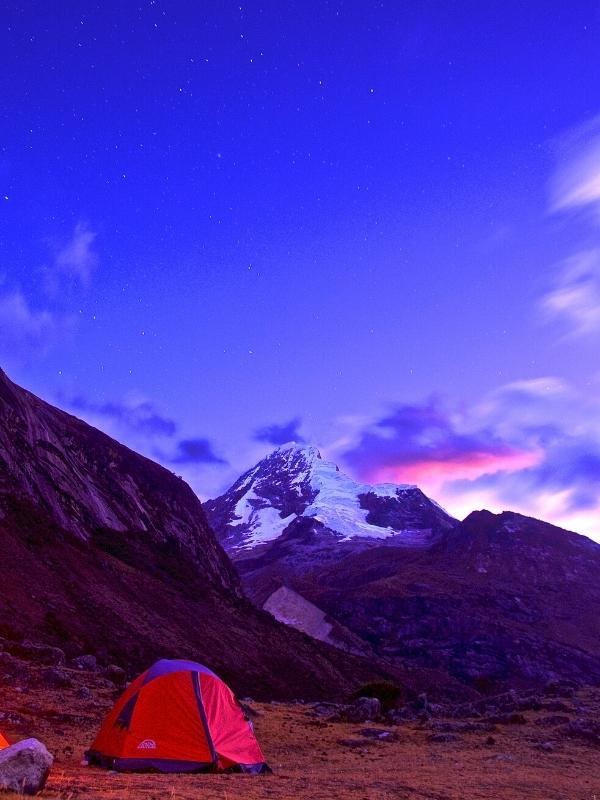
THE 8 MOST BEAUTIFUL TREKS TO MACHU PICCHU

THE BEST ADVENTURE SPORTS IN CUSCO

THE SHORT INCA TRAIL : EVERYTHING YOU NEED TO KNOW
What our clients say about us.
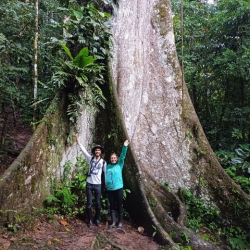

AUSANGATE TREK IN 4 DAYS
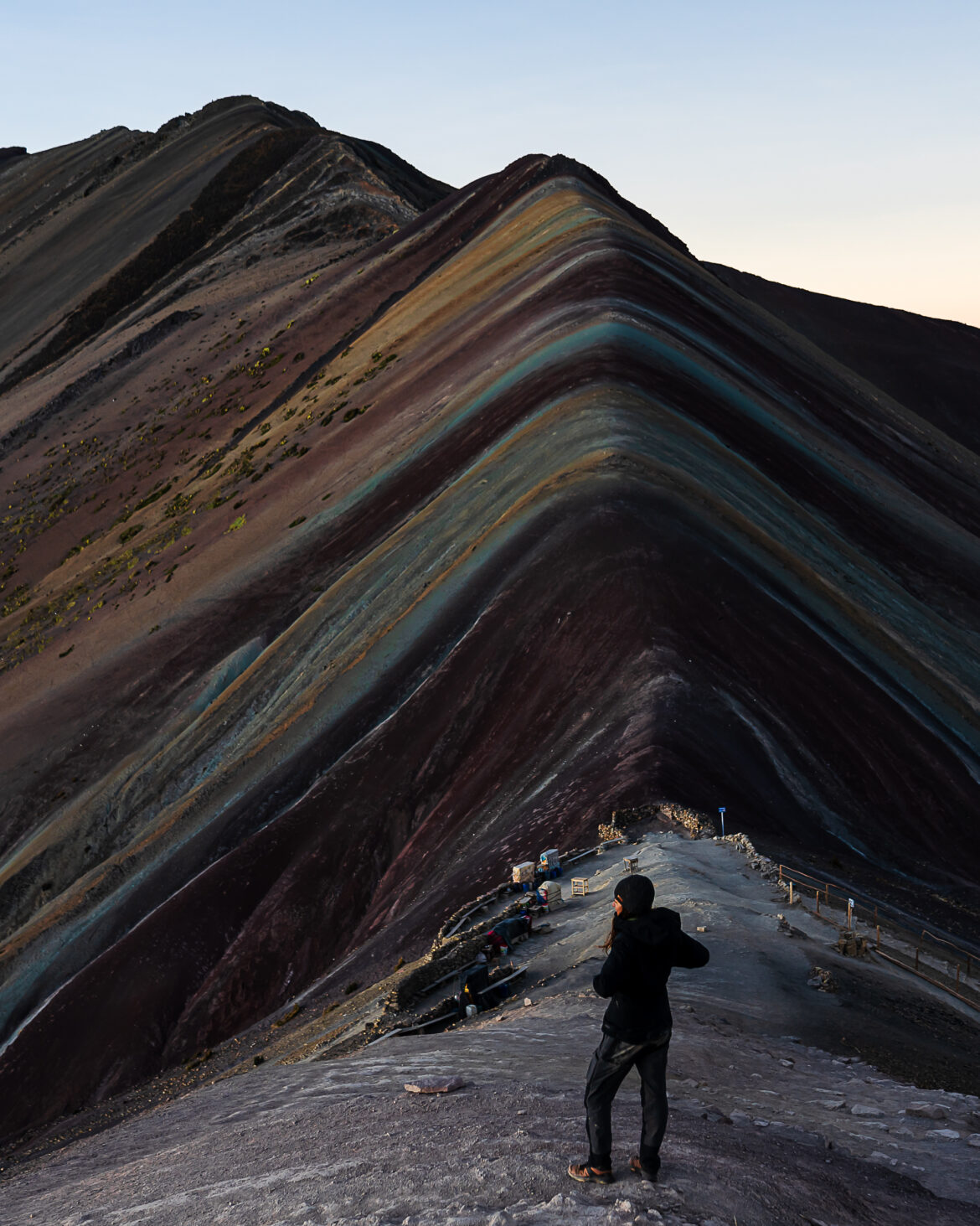
HOW TO BE ALONE AT THE RAINBOW MOUNTAIN?
This was one of the most beautiful hikes in Peru, along with the Huayhuash . 4 incredibly magnificent days around Ausangate with an arrival at the rainbow mountain, Vinicunca , at sunrise! The best way to be the first to admire this natural beauty! And honestly, it’s totally worth it! There are several possibilities to do the Ausangate, either you do the complete tour in about a week and finish on the rainbow mountain, or you can do part of the Ausangate finishing in the same place. Traveling alone and having suffered from altitude sickness in my previous hikes, I chose to go with an agency. Because yes, the hike’s at high altitude, you’re always above 4,000 m, or even at the end 5,200 m. As the Ausangate trek isn’t yet very popular, in low season it’s difficult to find agencies that do it over several days. Fortunately, by planning a little in advance, I was able to do it in collaboration with AB Expeditions in 4 days. It’s entirely possible to do this independently. Packing up the Pieces tells you about it in this article.
Table of Contents
WHAT EQUIPMENT TO TAKE FOR THE AUSANGATE TREK?
If you go with AB Expeditions , during your briefing, they’ll give you a bag where you can put all your stuff. This bag’s sufficient for the 4 days of hiking in Peru and it will be carried by the mules throughout the Ausangate trek.
Here’s a list to help you know what equipment to bring:
- Underwear for 4 days
- Hiking pants
- Pants for the evening and night
- T-shirts for 4 days
- A t-shirt for the evening and night
- A warm sweater for cool evenings and nights
- Warm leggings to wear under hiking pants
- A waterproof jacket for rain and wind
- A pair of hiking shoes
- A pair of shoes for the evening
- A backpack that you keep with you during the day
- Solar cream
- A pair of gloves
- Hiking poles if you use them
- A sleeping bag for cold temperatures (ideally -10° C)
- Your toiletries
- Cleaning wipes because there’s no shower
- A filter bottle
- Your emergency kit first aid kit / medication
- A roll of toilet paper
- Mosquito repellent
- Pocket money
- Your passport
- Cables to charge your devices
- A portable battery
With all this material, you’ve the basic equipment you need for the Ausangate trek. Obviously to be adjusted according to your needs and desires.
HOW TO DO THE AUSANGATE TREK?
As I said in the introduction, I went in collaboration with AB Expeditions for 4 days and 3 nights. When I booked, the agency asked that we come see them the day before for a 30-minute brief if possible. I meet my guide and he explains to me what to expect, the route, the weather, the pace, my level… A very good exchange and this allows him to adapt the trek Ausangate according to the customers he has. I liked that it was quite flexible depending on the wishes of the group.
DAY 1: 11 km - 350 m elevation gain
Sunset at lake upis, ausangate trek, lake upis during sunset, accommodation the 1st night.
Meeting at 6am at my accommodation to wait for the guide to pick me up. I board a mini-van with 3 other people. It’s a 3.5 hour drive with a few logistical stops along the way. We arrive around 10:30 a.m. at our starting point. A small house in front of which we eat a good, very complete breakfast (avocado, hot drink, egg, cheese, and so on). After a 1 hour break, and having prepared our things, we begin the first part of the Ausangate trek, going to the Upis camp, located at an altitude of 4,320 m. It takes us about 3 hours to get there. The trail’s quite flat, which is rare for a hike in Peru haha. The landscape’s super beautiful, we can see the Ausangate closer and closer. This first day is mainly for us to acclimate to the altitude. Arriving at the camp, the view’s incredible! We discover our accommodation, small cabins with large bay windows facing the summit of Ausangate! I can’t believe it! I’ve never had such luxurious accommodation while hiking in Peru! Then, late in the afternoon, we’re in good shape to make a return trip to Lake Upis during sunset. The path’s a little rockier but fairly easy. After 45 minutes we’re in front of this super beautiful lake facing the immensity of the Ausangate summit. Being there at the end of the day, the lake’s so calm that we can see the mountain and its glacier reflected in the water! I was really impressed by the immensity of this summit! The colors of the sunset were very pretty on the mountain. We return to camp when it gets dark. Before dinner, we see the Milky Way passing above the peaks! That’s wonderful! The next few days of the Ausangate trek promise to be epic!
If you would like to view the path in more detail, click here for the morning and here for the one towards Lake Upis.
DAY 2: 10.67 km - 468 m elevation gain
Lake hatun pucacocha, view from above, sunset over ausangate, view from the campsite.
Wake up early at 5:30 a.m. with a hot drink prepared by our guides. We prepare our bags before having breakfast around 6am. We leave with low temperatures around 7:30 a.m. A nice climb awaits us to start. Altitude sickness is coming for me, but my guide gave great advice and helped me overcome it throughout the Ausangate trek. At the top of this small climb, we see Lake Upis with its snow-capped peaks! It’s an incredible view! We continue our hike bypassing the Ausangate. We gradually discover other facets of the mountain with its glaciers. It’s really beautiful! I’ve never seen such an impressive mountain with eternal snow, and so close. We take our time taking photos and finding super beautiful places. As the group is oriented towards photography, our guide gives us great advice and finds the right spots. We pass by the Arapa summit , located at 4,968 m above sea level, the highest I’ve been able to do so far while hiking in Peru. We then arrive for lunch at our camp, around 2:30 p.m. Fortunately the agency provides snacks. A magnificent place which gives a beautiful view of the Ausangate and its glacier above. The location’s just incredible, I’ve no words! After a good lunch, we’re free for the afternoon. I decide to get closer to one of the lakes with a waterfall coming from the glacier. A beautiful place to contemplate nature in complete tranquility. To think that we saw few people for two days apart another small group of hikers, and some locals. I stay until sunset which gives incredible colors on the glacier. I advise you to return to the camp during sunset, so as not to get lost, but also because it’s a little higher up and allows you to have a super beautiful view. We then have dinner before going to bed at 4,500 m altitude. If you’re lucky, maybe you can admire the stars passing over this mountain.
To view the route we took on the second day of the Ausangate trek, click here .
DAY 3: 9 km - 776 m elevation gain
Puca cocha summit, view from above during ausangate trek, view during ausangate trek, sunset at the 3rd campsite.
The third day was the hardest day of the Ausangate trek for me. For what ? Because in 7 hours of hiking, we’ve 3 big climbs at high altitude… We leave around 7:30 a.m. when the sun gradually rises over the mountains and lakes. During the first climb, we stop at a beautiful place to take photos! An elevated view of several lakes of different colors and the Ausangate summit. One of the most beautiful viewpoints of this magnificent hike around Cusco. We continue to the Puca Cocha summit (4,990 m) where we have a 360° view of the valleys. On one side the snowy summit of Ausangate, on the other side a red valley. We continue our way in this red valley. Very different landscapes compared to what we saw the day before. At the end of the descent, we arrive at a campsite. Our guide asks us if we want to stop here and leave earlier tomorrow morning, or if we want to continue. Unanimously, we decide to continue because it’s still early. We climb to the Abra Warmisaya summit (4,985 m). I’m starting to feel tired, and my legs feel heavy. But I’m not giving up, I’m going at my own pace with several stops. We’ve magnificent views of the snow-capped peaks all along. At the top, we see a mountain of several colors, but not the one we’ll see the next day. Seeing this geological formation in different colors is quite unique! We continue the Ausangate trek until arriving at our camp located at 4,900 m above sea level in the middle of the afternoon. After lunch, some go up to the Rainbow Mountain for the sunset, but I prefer to rest to be in good shape the next day. The sunset at this place remains super beautiful!
To view the third day of the Ausangate trek, click here .
DAY 4: 6.16 km - 228 m elevation gain
Sunrise at the rainbow mountain, sunrise at the rainbow mountain, sunrise over the rainbow mountain, entrance to the red valley, view from the red valley.
Let’s go to the end point of this beautiful hike around Cusco, the sunrise at the rainbow mountain, Vinicunca . Wake up at 4:30 a.m. for a departure at 5:10 a.m. after a very cool night. To give you an example, the liquid from my lenses froze in the small box… As the whole group didn’t necessarily want to see the sunrise, we separated to meet up later. We arrive at the summit a little before 6am. We slept really close to the place. And there, a great natural spectacle awaits us! A mountain with multiple colors that intensify more and more with the rays of the sun. A purple sky over this mountain! The view’s just incredible! And what a joy to be able to enjoy this place alone! Yes, yes, you read correctly… We were the only ones in front of this famous mountain. Such a pleasure to be able to enjoy this beauty while being able to take our time, and in peace… Just for this moment, I’m so happy to have done the Ausangate trek. The best view’s from the top of the hill facing this mountain. It’s only a few meters of ascent. After several minutes of observation in the cold, we continue on our right. We take a path that few people do, to get to the red valley, Valle Rojo. This is a step that I recommend if you’re in good physical condition and have the time. A magnificent view of a very red valley with a little green. It’s very beautiful! I think the photos illustrate my words well. Then, we go back down a good slope to catch up with the path that everyone takes to go to and back from the rainbow mountain. And seeing the world, while it’s still early in the morning, I’m so glad I was there during sunrise!
To view the map of the last day of the Ausangate trek, click here .
CONCLUSION OF THE AUSANGATE TREK
A magnificent trek! Every day was incredible, every view was breathtaking! This hike in Peru is part of my top 3 in the country. The immensity of Ausangate is extraordinary… The hike’s really not easy. The elevation changes are quite significant! In addition to being in good physical condition, you must tolerate the altitude. Regarding the AB Expeditions agency, I’ve nothing to complain about. The food was excellent, the guide adapted very well to the group’s desires by offering several alternatives. He also took care of us when we started to feel altitude sickness. The locations chosen for sleeping were perfect, everyone was very attentive! Even if I did this trek in partnership with the agency, I give you a very honest opinion, you’ll find great value for money!
THE PRACTICAL MAP OF THE AUSANGATE TREK
To visualize the different parts of the Ausangate trek, here are links where you can download maps:
Day 1: click here Day 2: click here Day 3: click here Day 4: click here
HOW MANY DAYS DOES IT TAKE TO DO THE AUSANGATE TREK?
There are different options for doing the Ausangate trek to the Rainbow Mountain. Either you tour the Ausangate peaks and it will take you about a week. Either you only do part towards the Rainbow Mountain and it will take you between 3 and 4 days. Having suffered from altitude sickness in Bolivia, I didn’t want to try the experience of doing it independently in case of problems. So I decided to do it with an agency. Unfortunately being in low season in Cusco, and the trek being little known, I had a lot of difficulty finding an agency that was going. I was finally able to do it in 4 days in collaboration with AB Expeditions .
WHEN TO DO THE AUSANGATE TREK?
Conditions are ideal between May and August to do the Ausangate trek. Even though temperatures are low, especially at night, there are few rainy days, so good conditions for using the trails.
WHAT BUDGET TO EXPECT TO DO THE AUSANGATE TREK?
The budget indicated below is that of a backpacker who goes with an agency that is a little more luxurious than what he would normally use. To be expected because as I specified earlier in this article, if you go in low season and you want to do it with an agency, you may not have much choice.
- Accommodation : You must allow one night before the start of the excursion. I advise you to plan 2 nights afterwards too if you’ve time, especially to rest, or plan the next hike/destination. There are inexpensive hostels, around PLN 30*, in the city center.
- Food : Everything’s included in the excursion, except the last dinner on return.
- Transport : The agency picks you up in front of your accommodation and also drops you off there.
- Activities : The excursion with accommodation, transport, food, guide, entries cost US$490*.
In total, count on a budget of around PLN 2,300* for the excursion. Doing it independently will cost you less, but the service I got is worth the price.
MY TRAVEL TIPS TO DO THE AUSANGATE TREK
- Prepare your equipment well to do the Ausangate trek. Depending on when you go, it can get very cold at night.
- Acclimate to the altitude for several days in Cusco before heading out to hike. You will be at 5,200m.
- If you’ve little experience or are alone, take the excursion with an agency or someone who has experience.
*Prices are updated from July 2023.
COLCA CANYON 2 DAYS TREK
Things to do in huaraz, you may also like, huayhuash trek in 8 days, the sacred valley of the incas, salkantay trek in 5 days, leave a comment cancel reply.
POPULAR POSTS
- Cookie Policy
- Legal Notices
Username or E-Mail
Forget Password?
Do not have an account?
Already a member.
- Tambopata Ecotour 3 Days
- Tambopata Ecotour 4 Days Top!
- Sandoval Lake Lodge 3 Days Premium
- Sandoval Lake Lodge 4 Days Premium
- Challenge Inca Trail 1 Day
- Short Inca Trail 2 Days
- Classic Inca Trail 4 Days
- Ancascocha Trek + Classic Inca Trail 7 Days
- Salkantay + Inca Trail To Machu Picchu 7 Days
- Lares + Inca Trail To Machu Picchu 5 Days Top!
- Ausangate + Rainbow Mountain 2 Days Premium
- Ausangate + Rainbow Mountain 3 Days
- Ausangate + Rainbow Mountain 4 Days
- Rainbow Mountain To Ausangate 7 Lakes 4 Days Premium
- Ausangate + Rainbow Mountain 5 Days Premium
- Classic Ausangate Trek Circuit 5 Days Premium
- Ausangate + Rainbow Mountain Trek 6 Days
- Ausangate Trek & Sibinacocha Lake 7 Days Premium
- Ausangate Images
- Ausangate Trek To Machu Picchu 3 Days Top!
- Ausangate Trek To Machu Picchu 4 Days Top!
- Machu Picchu & Rainbow Mountain Trek 4 Days Package
- Ausangate & Rainbow Mountain + Short Inca Trail 4 Days Premium
- Ausangate & Rainbow Mountain + Short Inca Trail 5 Days Premium
- Machu Picchu Tour To Ausangate Trek 6 Days Package
- Ausangate Trek To Machu Picchu 7 Days Top!
- Ausangate Trek To Machu Picchu Tour 8 Days Premium
- Machu Picchu Tour By Train 1 Day Top!
- Machu Picchu Tour by Train 2 Days
- Machu Picchu And Rainbow Mountain 4 Days New!
- Sacred Valley and Machu Picchu Tour 2 Days Top!
- Machu Picchu Images
- Salkantay Trek Imperial 8 Days Package
- Lares Trek To Machu Picchu 6 Days Package
- Machu Picchu & Ausangate Trek 6 Days Package
- Machu Picchu & Rainbow Mountain 4 Days Package
- Salkantay Trek To Machu Picchu 3 Days
- Salkantay To Machu Picchu 4 Days Economic
- Salkantay To Machu Picchu 5 Days Economic
- Salkantay + Inca Trail & Machu Picchu 7 Days
- The Salkantay Trekking Imperial 8 Days New!
- Choquequirao Trek 4 Days Premium
- Choquequirao Trek 5 Days Premium
- Choquequirao And Machu Picchu 7 Days Top!
- Choquequirao Trek To Machu Picchu 8 Days
- Choquequirao Trek To Machu Picchu 9 Days
- Ancascocha Trek To Machu Picchu 4 Days Top!
- Ancascocha Trek & Machu Picchu 5 Days Premium
- Ancascocha, Inca Trail, Machu Picchu 5 Days
- Ancascocha, Inca Trail, Machu Picchu 7 Days
- Lares Trek To Machu Picchu 3 Days
- Lares trek To Machu Picchu 4 Days Top!
- Lares + Inca Trail To Machu Picchu 5 Days Premium
- Sacred Valley, Lares To Machu Picchu 6 Days
- Huchuy Qosqo Trek 1 Day
- Huchuy Qosqo Trek 2 Day
- Huchuy Qosqo Trek To Machu Picchu 3 Days Top!
- Inca Jungle Tour To Machu Picchu 3 Days
- Inca Jungle Trek To Machu Picchu 4 Days Top!
- Inca Jungle Trail Plus Llactapata 4 Days
- Inca Quarry Trail 1 Day Hike
- Inca Quarry To Machu Picchu 4 Days
- Moonstone Trek To Machu Picchu 5 Days
- Amazon Jungle
- Our Porters
- Travel Reviews
- Our Hiking Gear
- Booking Policies
- All Photos Of Peru
- Machu picchu Ticket
- How To Make a Booking
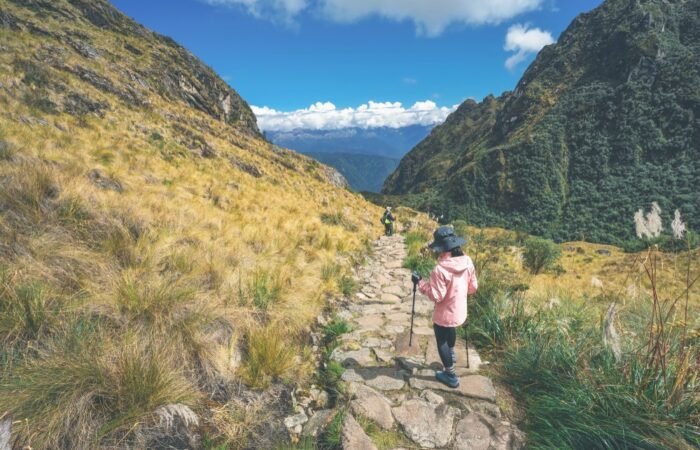
Inca Trail Treks Packages
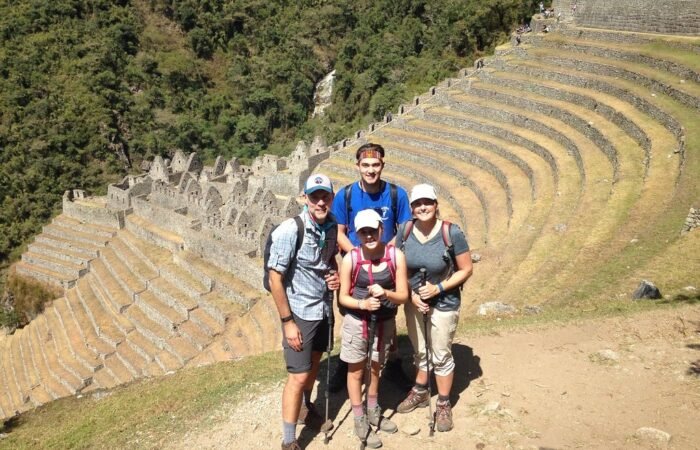
Inca Trail Combinations
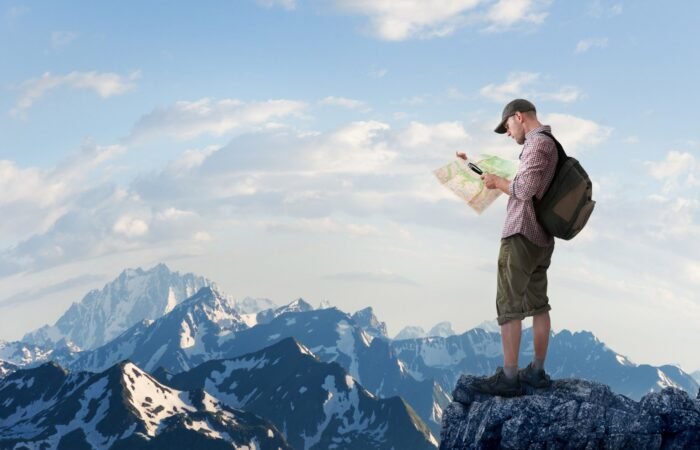
Packing list

All Packages
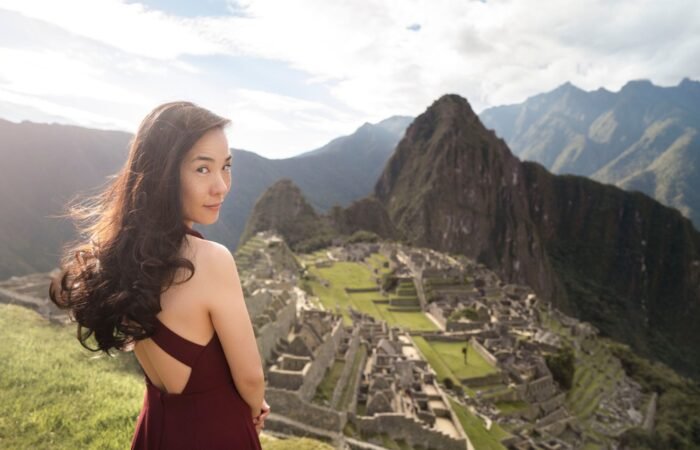
Ausangate Trek
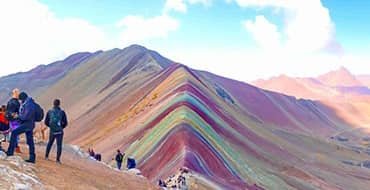
Rainbow Mountain

Salkantay Trek
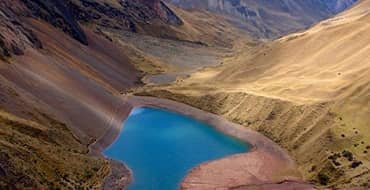
Ancascocha Trek
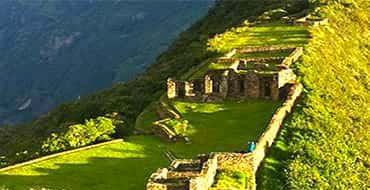
Choquequirao Trek
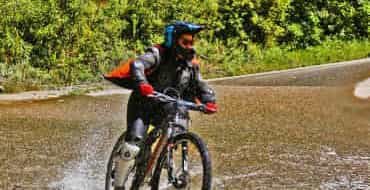
Inca Jungle Trail
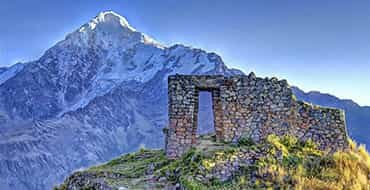
Inca Quarry Trail
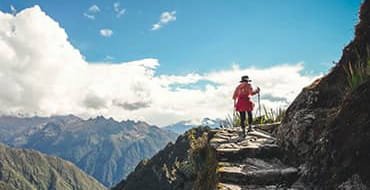
Moostone Trek
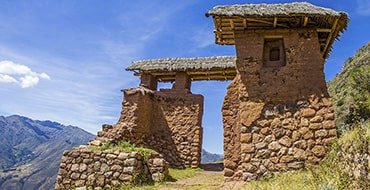
Huchuy Qosqo Trek
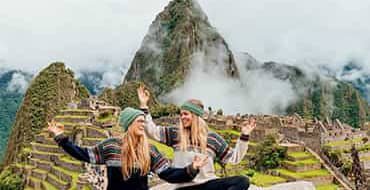
Machu Picchu Tours
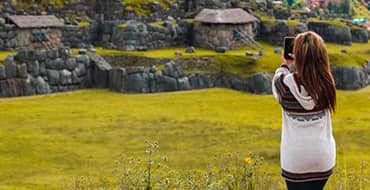
Cusco Day Tours
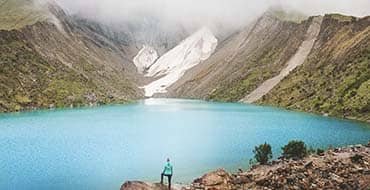
Cusco Day Hikes
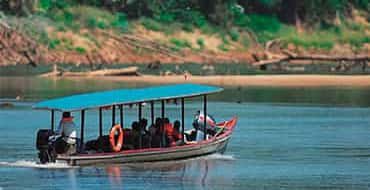
Sandoval Lake Tour 4D
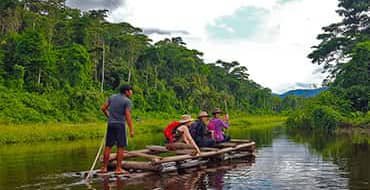
Tambopata Tour 3D
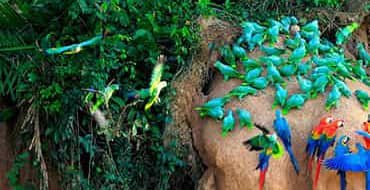
Tambopata Tour 4D
Ausangate trek to rainbow mountain 5 days.
- Classic group service Group Service 12 people Adult: $490 Children: $480 Available: 18 seats
- VIP private service Service with total flexibilit Adult: $590 Children: $580 Available: 26 seats
Proceed Booking
Already a member.
Username or E-mail
Don't have an account? Create one.
Or continue as guest, adding item to wishlist requires an account.
Reservations for the great year 2024 - 2025 have already started, more than 5000 clients with reservations secured!
Are you thinking about taking a trip to Machu Picchu? What are you waiting for, make your reservation now and secure the best place to see Machu Picchu completely and live an unforgettable experience!.
We recommend booking it at least 2 months in advance as tickets are quite limited.
BOOKING FAST & EASY
Book fast and easy on our website and keep track of your reservation with our most advanced booking system, be updated on our discounts every week.
- FB Messenger
- Odnoklassniki icon Odnoklassniki

Ausangate Trek 5 days
Ausangate trek Plus rainbow mountain 5 days: explore the unspoiled nature and remote Ausangate circuit, including the impressive rainbow mountain, on a 5-day trek around the foothills of the wonderful snow-capped sacred mountain (“Apu”) of Ausangate (6,380 m / 20,931 ft), which is the highest mountain region of Cusco. Throughout the Ausangate circuit we will pass through local villages, where people dress in their typical local clothing. Our incredible and unique Ausangate trek itinerary will take you to discover the most beautiful landscape of the Peruvian Andes. with its dazzling Ausangate peaks and glaciers, turquoise alpine lakes, rainbow mountains, hot springs, where llamas and alpacas walk freely. In addition, the Ausangate trek is one of the most scenic, high altitude treks in Peru that traverses high altitude passes (5,000 m / 16,000 ft).
Our Mother Nature will surprise you with an impressive display of vibrant and varied colors spread over the high peaks of Cusco. Remember that when you put your eyes on Rainbow Mountain , you’ll be contemplating millions of years of geological history and a natural wonder that’s not repeated on almost any other corner of the planet. You can also feel extreme tranquillity as you walk through the surreal Red Valley , surrounded by majestic snow-capped mountains and beautiful slopes. At times, your only company will be alpacas , llamas , and vicuñas . Also, from time to time, you’ll be able to observe the daily life of the Andean communities that are located in that sector.
It is not easy to believe in the beauty of the Andean night skies if you do not see them with your own eyes. Let the constellations and shooting stars hypnotize you before sleeping in our comfortable tents that you will find ready, with mattresses and pillows, as soon as you arrive. So why not escape the hordes of tourists that saturate Cusco? Come and join us on this memorable route to one of the true wonders of Mother Nature.
Why Take the Ausangate Trek To Rainbow Mountain 5 Days?
- Join us on this breathtaking five-day trek through the Andes Mountains.
- Marvel at majestic snow-capped peaks, glaciers, and crystalline turquoise lakes.
- Get touch with indigenous people in rustic rural villages of the mountains.
- Spectacular views from high altitudes especially while crossing two passes, the Palomani Pass and the Q’ampa Pass.
- Catch a glimpse of Andean wildlife – condors, llamas, alpacas, vicuñas, and many aquatic birds.
- Hike with a real direct & official local tour operator based in Cusco.
DAY 1 Cusco, Upis To Yana Qocha Campsite
Visit places.

To start our 5 day Ausangate trek and Rainbow Mountain, our expert trekking guide will pick you up at 5 am from your hotel in Cusco and then, we will drive in our private vehicle for approximately 3.5 hours to the trailhead of Ausangate trek. Along the journey, we will pass through different colorful villages following the highway to Puerto Maldonado. After driving for 3 hours, we stop at Tinque (3,800 m / 12,467 ft) to use a bathroom and buy something we forgot to buy in Cusco and then continue driving for 30 minutes on a dirt road to reach the beginning of the trail.
Upon arrival to the trailhead, called Upis Village (4,250 m / 13.943 ft). We will have time to organize our daypack and duffle bags while our trekking cook prepares the breakfast and then, we will enjoy the first breakfast with spectacular views of the Vilcanota mountain range and Apu Ausangate peak (sacred mountain) located just in front of our trekking trail, while our muleteers organize and pack the equipment for the hike. After breakfast, before starting the hike, the tour guide will introduce you to the staff of the company that will be on the Ausanagte Circuit with you.
Our trek to Ausangate begins on a small path that winds through the Andean potato and grain fields. The first three hours of hiking run over hilly pampa crossing some streaming and slight rise where you see some Andean row of houses built like in their ancestor’s time. As we hike through the spiky ichu grass of the pampa, we will have a chance to see some Andean gulls hovering on the wind, also we hike nearby of small ponds around Upis which is a perfect habitat for the Andean bird. Just before the community of Upis (4,400 m / 14,435 ft), we will enter by broad valley heading towards the glacier where we’ll enjoy our lunch just right at the base of Ausangate Mountain (6,372 m. 20,900 ft.).
After eating the delicious lunch, we will continue ascending for 2 hours to Arapa Pass (4,800mt./15,748ft.). At the top of the pass, we will have stunning views of eroded mountains, highland valleys and wonderful view of the Ausangate Mountain behind it. From the pass, we trek across an arid hillside for 20 minutes and then we descend, sometimes quite steeply, for 1 hour and 30 minutes to get to the first campsite, called Yana Qocha (4,570m / 14,993 ft ), which is a place with amazing views around of the Ausangate mountain. Once we get to the Yana Qocha camp, we will have free time to take a rest or walk around the campsite before the happy hours (afternoon tea), followed by dinner. Durant the dinner, the trek leader will tell you the scheduled wake time for the next day.
- Meals: Breakfast, lunch, dinner.
- Accommodation: Camps
- Difficulty: Moderate
- Walking Distance: 15 km / 9.32 mi
- Camp Altitude: 4,570 m / 14,993 ft
- Highest Elevation: 4,800 m./15,748 ft
DAY 2 Yana Qocha To Qomer Qocha Camp

Our staff will wake us up and then, we will enjoy the nutritious breakfast. After breakfast, we will begin our hike along a gently sloping trail (up and down), into a valley blue glacial lakes and waterfalls. This section of the Ausangate trail is one of the most picturesque ones, which is located along the impressive Ausangate Mountain (6,384 m / 20,945ft). After hiking for 1 and a half hours along these beautiful and colorful glacial lakes, called Yana Qocha (black lake) and Puca Qocha (red lake), we will start hiking up on a switchback trail to Puka Qocha Pass (4,870 m / 15,977 ft).
At the top of the pass, we will be impressed by the beautiful views of Ausangante Mountain, the lagoons below, formed by a melting glacier. In front of us, we will have an extraordinary vantage point to look down and see the snow-capped mountains going in different directions and the red valleys of the highlands with colorful mountains and an untouched landscape. Afterwards, we will take advantage of some great photographic opportunities and begin our descent into the valley, walking close to some freely grazing llamas and alpacas.
Then we will climb to reach our lunch spot called Ananta (4750 m / 15,583 ft), located in a highland valley with incredible views everywhere and some llamas grazing nearby. Following lunch, we continue trekking uphill for 2 hours to reach to the Warmisaya Pass (4,985 m / 16,354 ft), from this pass, we will be able to spot the Rainbow Mountain in a further distance and views are still very impressive. After witnessing the views and taking some pictures, we will walk the last 30 to 45 minutes downhill to reach the second camp located at Qomer Qocha (4,570 m / 14,993 ft). At the camp, we will enjoy afternoon tea and dinner and then go to sleep, because the next day we will get up early to explore the amazing Vinicunca Rainbow Mountain.
- Walking Distance: 14 km / 8.69 mi
- Highest Elevation: 4985 m / 16354 ft
DAY 3 Qomer Qocha, Rainbow Mountain To Ausangate Qocha Camp
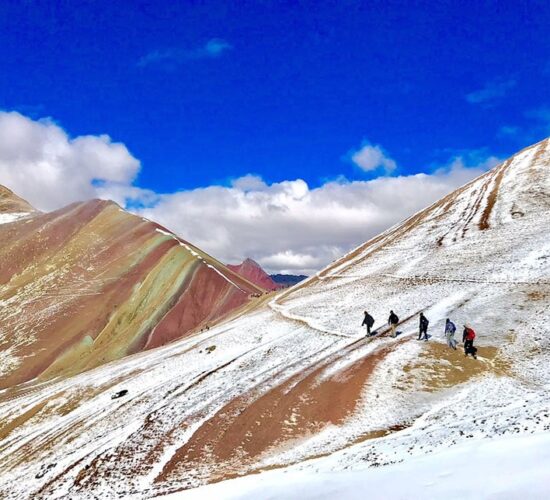
This morning, the wake-up time will very early to go and explore the painted hill or Vinicunca “Rainbow Mountain Peru”, to beat the large crowds and explore in solitude and take pictures. We only take what we need. Typically, the sky is clear and full of stars. The hiking path is uphill for about 1 and 10 minutes before reaching to the famous Rainbow Mountain.
When we arrive at the epic Rainbow Mountain, we will soak up incredible views of the Painted Hill or Vinicunca also called the 7-Color Mountain(5,100 m / 16,732 ft.), in the Vilcanota range and we will receive information from your tour guide as to why these mountains are unique! After exploring for approximately 45 minutes (depending on your trekking speed and weather conditions), we return to our camp by the same path we took, along the way, we will have the opportunity to see some farmers who still use llamas as in the time of the Incas.
Once we arrive at the camp, we will have time to rest and enjoy the delicious lunch. In the afternoon, we will walk for 3 hours to the third camp, called Ausangate Qocha (4,500 m / 14,763 ft) following the path along the skirt of the colorful mountains. Subsequently, we will arrive at the camp where we will enjoy afternoon tea before being served an amazing dinner.
- Camp Altitude: 4,500 m / 14,763 ft
- Highest Elevation: 5,100 m / 16,732 ft
DAY 4 Ausangate Qocha To Qampa Camp

After another wonderful breakfast, we begin another challenging and rewarding day. We will climb steeply for 3 hours along the shores of the lagoon Ausangate Qocha and the glacial moraine to the highest point of the Ausangate Circuit, which is the Palomani Pass (5,200m / 17,060 ft). Besides, the trail ascends between the red bluffs of apacheta (mound of stones) and peaceful mountains. Where we will walk with our goal of reaching the highest point
At the highest point of the entire Ausangate trek 5-day, we’ll snap the unique pictures and soak up the gratification of our achievement. Looking down the stunning valleys and Peruvian Andes (The Andes Mountain Range). After taking pictures at the pass, we will begin our descent following the trail as it loops across the steep slope passing corrals and herds of llamas and alpacas.
After having lunch, we climb over the hilly terrain surrounding the peak of Ausangate, toward a marshy area to reach the upper level of the valley where is our basecamp. Upon arrival at basecamp of Qampa camp (4,700 m / 15,419 ft), we will rest and have hot drinks. Likewise, around the camp amid these rocks and bounders, you will have an opportunity to see viscachas muted brown in color (rodent in extinsión danger like a rabbit with a long tail). At dinner time, your guide will provide the plan for the next day.
- Walking Distance: 13 km / 8.07 mi
- Camp Altitude: 4,700 m / 15,419 ft
- Highest Elevation: 5,200 m / 17,060 ft
DAY 5 Qampa Camp, Pacchanta village To Cusco Hotel

After breakfast, this morning we leave Qampa base camp with beautiful views of Huayna Ausangate Mountain through the Andean typical houses ascending step by step for about 2.5 hours towards Qampa Pass that is an altitude of (5,070m / 16,633ft). Along the way, we will be amazed by snow-capped peaks and also is possible to see an ice-cape in the ravine below.
From the Qampa pass, we continue descending to gorgeous Qomercocha (green lake) located in the skirt of the Puka Moqo (Red Mountain). Finally, we reach to Pacchanta village to have the last lunch prepared by our chef, furthermore, at Pachanta you will have a chance to soak the natural hot spring before or after lunch, before taking transportation to Cusco. Our Ausangate Trek 5 Days to the Rainbow Mountain will end at your hotel in Cusco.
- Meals: Breakfast, lunch.
- Walking Distance: 14 km / 8.6 mi
- Minimum Elevation: 4,100 m / 13,451 ft
- Highest Elevation: 5,070 m / 16,633 ft
High Quality Service & Safety
- Pre-departure briefing
- Experienced Guide speaks English and Spanish
- A professional cook only for our group
- Motorola Talkabout Radio, for communication
- Medical Kit – First Aid Kit
- One duffle bag per person
- Customer Service 24/7
- Extra oxygen
Private Camping Equipment
- We also include a large tent with table and chairs for you to enjoy your meal without worry-free, and all the cooking equipment, carried by our porters and horses
- We also included a portable toilet
Permits & Entrance Tickets
- Entrance ticket to Ausangate Trek
- Entrance ticket to Rainbow Mountain
Transportation
- Private transportation from your hotel in Cusco to the start of the trek.
- Horses, and muleteers horses carry your 8-kg / 16-pound personal items.
- Private transportation from the end of the trek to Cusco to your hotel.
- Meals: 5 Breakfasts, 5 Lunches, and 4 Dinners
- Meals: vegetarian and vegan
- Water to drink on the trail every day
- Wake up tea, every morning
- Tea Time or Happy Hour, every afternoon
- Snacks on the trail daily
- Products for hygiene
Accommodation
- Personal Accommodation in Private Campsites
- 4-Person, 4-season tents, destined for 2 travelers
- 1 Polar sheet per person
- Pillows throughout the tour
- Rubber warmers, for the night
Additional Included
- Emergency horse to ride
- PRO Air sleeping pad, Therma-Rest brand
- Sleeping bag
- Trekking stick
What Is Not Included?
- Travel Insurance
- Tips for our staff
- Additional costs or delays out of control of the management
- Original Passport
- Walking boots
- Waterproof jacket / rain poncho
- Warm jacket
- Hat and gloves
- Comfortable trousers
- Sun cream (factor 35 or higher)
- Insect repellant
- Toiletries and hand sanitiser
- Personal medication
- Camera and film with extra batteries
- Torch with spare batteries
Information Before leaving for the Ausangate Trek To Rainbow Mountain
We want to make your trip to Peru as memorable and as easy as possible. In this section, you will find speedy answers to all those questions you had about Ausangate trek + Rainbow Mountain 5 days in one place. Please read the following information carefully – it will help you with any questions about our services.Has another question that we haven’t answered here? Drop us a line , and we will get back to you asap!
Briefing or informative meeting
All information meetings are held in your hotel at 6:00 p.m., one night before the tour begins. If you cannot attend, you must coordinate another time at the (Peru Hike) offices. These meetings last approximately 30 to 45 minutes and there you will be given a small duffel bag, in which you’ll put all the belongings you intend to bring on the trek that won’t be in your day pack.
Duffel bag or canvas case
ou’ll receive a canvas case or duffel bag during your briefing. The porters will take them on the way and will deliver them to you when you get to each camp. They measure 66 cm / 2 ft. Long x 36 cm / 1 ft. Wide.
A maximum of 5 kg is allowed for each duffel bag that includes the weight of your sleeping bag, mat, clothes and other personal items.
Payment of Trek Balance (in Cusco)
The trek has to be paid for in full by at least 7.30 pm two days before departure. For example, if your tour departs on a Wednesday, then you must come to our office before 7.30 pm on Monday.
It would be much appreciated if you pay the trek balance in cash US dollars or local currency. You can withdraw some money from several ATMs along Avenida Sol (either in US dollars or local Peruvian Soles). You can pay by credit card or PAYPAL online, but you will have to pay an 8% service charge, charged by VISA and PAYPAL. We do not accept bank checks or payment of the balance by traveler’s checks.
Can I store my luggage at your office?
Of course! During the travel, your main luggage can be stored at our office(you can organize briefing day or by email) or at your hotel, both free of charge.
Any equipment that you are not going to need on the trek can be stored safely in your hotel. Nearly every hotel will provide this service. Don’t leave items of value with your bags, put them in the hotel safe and obtain an itemized receipt (In the unlikely case of theft many insurance companies require that you have a copy of the receipt itemizing all the items). Best put items such as credit cards inside a sealed, signed envelope for extra peace of mind.
Pick up of guests
Peru Hike Company can pick you up from your hotel, as long as it’s in the Historic Center of Cusco. The pickup time will be coordinated with your guide in the briefing. The pickup time may vary between 30 and 45 minutes due to traffic. Cusco is a very old city, therefore, it has many narrow cobbled streets. Some hotels and Airbnbs may be located on streets without access to cars or on long, steep slopes, making it difficult to transport luggage. We strongly recommend that you book accommodation with good access.
Group tours
Group tours are made up of different types of people. Physical conditions and ages can vary. By agreeing to be part of a group tour, you also accept that some people may be faster or slower than you. Therefore, each person can go at their own pace on the route. It may be the case that a group wishes to modify the tour; however, it will be the guide who decides, after consulting with all the participants, if said modifications can be made.
Strikes and demonstrations
Strikes and demonstrations are usually frequent in Peru and this may interrupt some of our tours. Roads can be blocked and train tracks can be taken over. However, we will try to keep your excursion as planned, even if it means leaving the night before the scheduled date. Under these circumstances, tours may also be cancelled. In case of changes or cancellations, all situations will be coordinated with you by our operations department. Your safety is our highest priority and our decisions will be made to protect it.
Lost objects
You’re responsible for your objects during the tour. Please pay attention to where you leave your things and remember to take everything once you leave our trucks, tents, or restaurants.
Related Tours
Here are some other options that will suit your needs
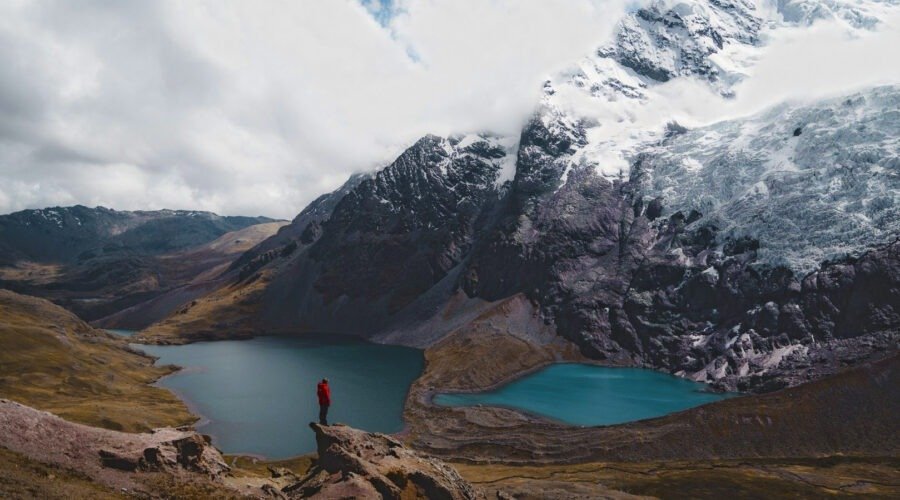
Ausangate & Rainbow mountain trek 6 Days
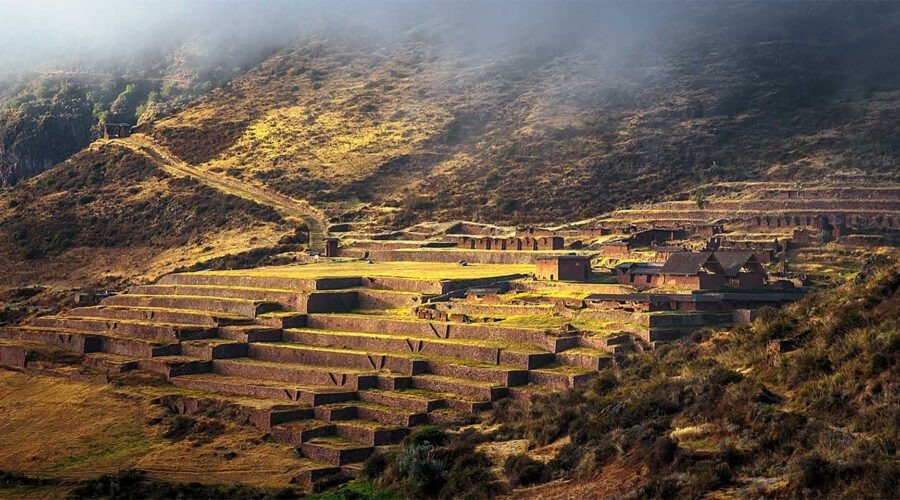
Huchuy Qosqo Trek To Machu Picchu 3 Days
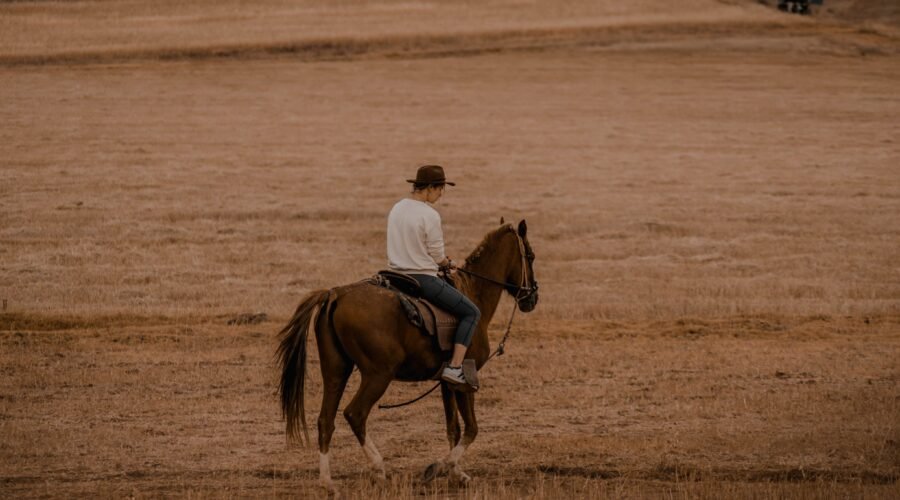
Picnic with horseback riding to the 7 lakes of Ausangate 1 day
Ausangate trek was an incredible adventure with magnificent views, the Peru hike team is really very good since they were very attentive to my questions and the food was great, I recommend this company 100%, make your reservation here since the prices in Cusco They are quite expensive but with this company we book at the best price and magnificent attention, unlike other companies, Peru Hike is very good in service and customer service, they respond very quickly to email and chat and they are always attentive to their passengers.
I did the Ausangate trek 5 days and rainbow mountain with my girlfriend and we absolutely loved it. By chance, no one else had booked for the same dates as us and so we essentially got a private tour. Our tour guide, Adolfo, was absolutely brilliant in every way. He was extremely knowledgeable and informed about Peruvian culture and history, as well as the flora and fauna along the trek. He was also very passionate about sharing his knowledge, which both my girlfriend and I really appreciated. He was also patient when we needed a rest, always allowing us to continue along the trail at pace that we felt was comfortable. He was also just great company and had a great sense of humour, which was obviously really important as we spent the vast majority of the four days together. Adolfo was great and I really don’t think the tour would have been as good with a different guide! We were also treated to amazing food three times a day by our head chef Elio and sous chef Julia. They worked tirelessly and wowed us with what delicious food they could produce in such remote locations, thousands of metres above sea level. They even made us a cake on our third day to our amazement! Finally, our horseman Toribio was extremely attentive, hard working and efficient, always having our campsite ready for us when we arrived for our rest each day. We loved this experience and its something we’ll never forget, thanks Adolfo and Peru Hike company!
From the start at pickup, to the time they dropped us off back in Cusco, the trip was extremely organized and ran like a well oiled “blue machine”. The entire team was extremely professional. Our guide Santiago made us feel like family, and took care of us like one. We were blown away by every meal created by the chef Tongo, and the horseman ensured everything ran smoothly. The Ausangate and Rainbow mountain trek 5 days was beautiful and the hot springs at the end of the trek was a lovely surprise. I can not say enough good things about this company and trail, and hope to join Peru Hike company on another expedition in the near future.
We booked Ausangate and Rainbow Mountain trek 5 days with Peru Hike company and can highly recommend it!
First of all, a HUGE thank you to the staff: Saul was such a caring guide and handled even difficult, unforeseen situations in the best possible way. We had a great time and really enjoyed the tour with him. Gregori, our chef, did an outstanding job and the food was just wow! Victor, our horseman, and Walter, our porter, were both very hard working and did great as well.
The hike itself was wonderful and adventurous. It led us through fantastic landscapes, stunning valleys and beautiful lakes. The last day of the trip, when we visited 7 lakes and pacchanta hot springs, was the absolute highlight.
We would like to thank “our” four guys again for their exeptional work so we could make unfortettable memories!
Far exceeded my expectations – great food and an authentic adventure. Hike was not necessarily easy, but every moment was worth it. The crew did a great job of providing an immersive experience I won’t soon forget. Lucio was the best guide for our Ausangate and rainbow mountain trek!
Join my Adventure: There's Room in My Backpack
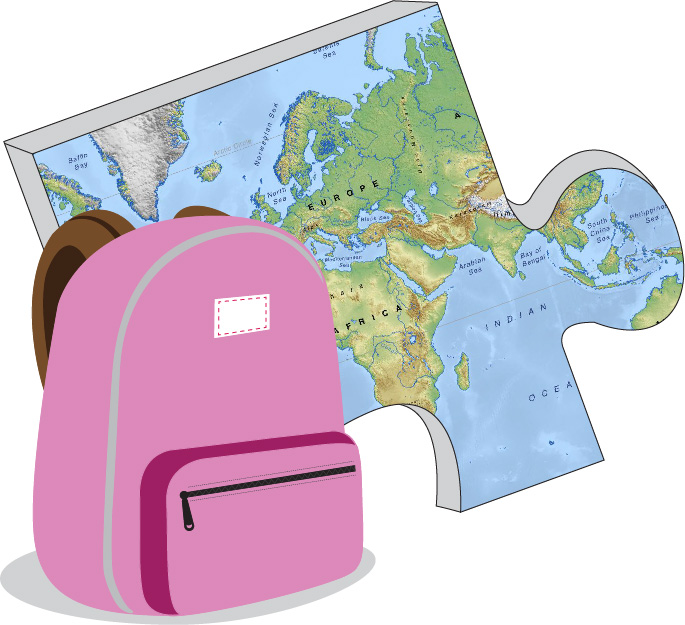
Packing up the Pieces
Ausangate Trek Map | Breathtaking 6 Day Circuit with Rainbow Mountain

- Author: Megan Anderson
- Created: January 8, 2021 12:00 pm
- Updated: June 9, 2023 4:13 pm
- Maps and Overviews
- Peru Multi-Day Trek
Copy the following HTML iframe code to your website:
- Distance Instructions
- Travel mode

- Distance 45 miles
- Time 144 h 0 min
- Speed 2 mph
- Min altitude 14150 ft
- Peak 16716 ft
- Climb 9911 ft
- Descent 10108 ft

This is a basic overview of the 6 day Ausangate trek circuit with the option to add-on Rainbow Mountain and Red Valley. Included is a free downloadable Ausangate trek map.
This incredible multi-day trek is for adventure seekers looking to enjoy one of Peru's most scenic hikes. Walk among hundreds of alpacas and llamas. Maybe spot vicuñas and chinchillas along the way. Gaze upon diverse glacial peaked mountains and wander next to vivid blue alpine lakes.
The Ausangate trek is an epic trek and finds its way to the top of the list for the most beautiful treks in the entire world. This Ausangate trek map follows the main hiking circuit with an add-on to Rainbow Mountain and Red Valley.
⁉️ If downloading the map, please verify that the map is correct and follows the waypoints. Oftentimes, there are daily updates to the site, map platforms, and other external issues that may cause a bug in downloading. Be mindful that this map is solely for entertainment purposes. See my full disclosure here . Always hike responsibly and respect the mountains by following a no-trace philosophy, avoid hiking alone, be conscious of the weather and personal limitations, and do not stray from the visible trail
Ausangate Trek Map Logistics
- Add-On Out & Back Trail: Rainbow Mountain (Vinicunca) and the Red Valley (Valle Rojo)
- Mileage: Around 45 Miles, depending on route
- Difficulty: Challenging & Hard due to the altitude, remote trails, and little foot traffic
- Duration: 5 - 6 Days
- Trail Marker: There is some signage along the route. Many of the mountain passes have signs with the altitude. The path is pretty straightforward; however, if doing the hike independently download an off-line Ausangate trek map. Look for route arrows on rocks.
- Basic covered shelters can be found along the route and some have facilities like outhouses and running water.
- Tent, I carry and love Nemo tents
- Durable high ankle hiking boots, Salomons are excellent and GORE-TEX is best
- Sleeping Bag for Cold Weather , I carried no less than a 15° Sleeping Bag, and a sleeping pad
- Trekking Poles
- Water Filter Kit
- Cooking Stove with enough fuel and cooking supplies for at least 5 days
- Portable Battery Packs for chargers (kept warm at night)
- First-Aid Kit with at least one Emergency Blanket per person
- Layered clothing for all weather conditions, including warm gear for nights
- Coca leaves for altitude sickness and gifts
- Offline Ausangate trek map
- My Complete Peru Packing List for Multi-Day Treks
- This high-altitude trek never dips below 14,150 feet (4,000m)
- Due to the remoteness and altitude, it's best to hike in a group or with a local guide. Never hike alone.
- Find a hiking partner in the Cusco Hike Club
Schedule 6 Day Ausangate Trek & Map
- Day 1 | Upis - Wild Campsite | 8.5 miles
- Day 2 | Wild Campsite to Shelter near Laguna Ausangatecocha | 4.5 miles
- Rainbow Mountain & Red Valley | Add minimum of 3 miles round-trip
- Day 4 | Campsite near Rainbow Mountain Campsite to Machuraccay Lodge | 8.75 miles
- Day 5 | Machuraccay Lodge to Campsite near Lakes | 10.5 miles
- Day 6 | Campsite via Pacchanta | 4 miles
Day 1 | Upis to Campsite Night 1
Depart Cusco early in the morning for the village of Tinki . In Cusco, catch the buses next to the stadium here .
From Tinki, take a taxi to Upis , or as far as the driver will take you. Most wont stop in the actual village of Upis, but rather on the road over 3 miles out. In Upis, soak in the hot springs or continue to the trailhead. Walk towards Abra Arapa Pass , and continue to a few lakes and streams that make a great place to camp.
Ausangate Trek Map | Day 1
- Distance: 8.5 miles
- Duration: 4 -6 hours
- Tips: A dip in the Upis hot springs is 5 PEN
Day 2 | Wild Campsite to Shelter near Laguna Ausangatecocha
Leave the stunning mirador and cross the river to take the scenic high trail. This trail has stunning views of the lakes and comes in above the two iconic lakes of Hatun Pucacocha . From here, continue on the path to Laguna Ausangatecocha to camp at the shelter. Sleeping at the shelter near Ausangatecocha allows ample time to explore this beautiful lake.
Note | To the right of Hatun Pucacocha there is a steeper trail that cuts in the direction to Rainbow Mountains via the Anantapata Lodge. This Ausangate trek map doesn't include that trail, but it can be found on maps.me
Ausangate Trek Map | Day 2
- Distance: 4.5 miles
- Duration: 3 - 5 hours
- Tips: There are covered shelters at the two mains lakes. For hikers who have less time, and more energy, take the alternative path for Rainbow Mountains.
Day 3 | Shelter to Camp Site Near Rainbow Mountain
Leave early in the morning for Rainbow Mountain.
Note | Some people choose to leave their gear behind at the shelter and do the trail as an out and back in 1 day; however, we didn't feel great about leaving our gear behind.
From the shelter, follow the trail on the hillside to the right of Surapampa . Continue on the trail past the village of Alcatarhui . Pass two small covered shelters and continue to wind towards the stunning Anantapata Lodge . From here, begin the uphill climb to Abra Warmisaya Pass .
Take the trail downhill past the section of dried out lakes. Head to the campsite. There is a water source is close by, but it is mucky and needs to be filtered. There are shelters here, but they are property of AB Expeditions . Contact them to inquire about the shelter use.
Behind the campsite is the short trail which leads to the viewpoint of Rainbow Mountain (Vinicunca) .
Red Valley (Valle Rojo ) can be seen from Rainbow Mountain and is less than a 45 minute climb from the viewpoint of Rainbow Mountain.
Ausangate Trek Map | Day 3
- Total Distance: 9 miles (Includes Rainbow Mountain and Red Valley)
- Duration: 5 - 7 hours of hiking, but more time for exploring the sites
- Tips: The trail to rainbow mountain is short and takes around 30 minutes to walk. Don't miss Red Valley, which is overlooked, but just as special as Rainbow Mountain. Campers should watch the sunrise over Rainbow Mountain.
Day 4 | Camping Near Rainbow Mountain to Machuraccay Lodge
Leave early and follow the same route you took the day before, back to the shelter. Go through the Warmisaya Pass , walk past the Anantapata Lodge and back to the shelter near Laguna Ausangatecocha . The shelter is a great place to have lunch, stock up on water, and prepare for the uphill climb to Abra Paloman , the highest pass on this trek. Coming down the Abra Paloman Pass, look to the left for the "Red Lake." Here, find the high-end Machuraccay Lodge . It's possible to camp nearby.
Set-up camp and climb the rocks to get up close to the "Red Lake."
Ausangate Trek Map | Day 4
- Distance: 8.75 miles
- Duration: 6 - 8 hours
- Tips: Camp near the lodge to have access to fresh water. There are larger rocks which help protect the tent from the wind.
Day 5 | Machuraccay Lodge to Lakes Campsite
Leave early from the Machuraccay Lodge and follow the path along the river towards the village of Pampacancha .
The next section after Pampacancha is incredibly scenic and follows along a river. The trail continues along the left side of the river. Look for blue and white arrows that lead to the major pass of Abra Khampa . From Abra Khampa, the trail moves up and down in elevation until the downhill path finally begins.
After Khampa Pass, the trail will come to a fork. Follow the blue sign to the left for a few camping options. There are a few campsites on the left fork, but none to the right. Either trail is fine, but if camping, take the left trai.
From the lakes, Pacchanta village is about 4 miles away.
Ausangate Trek Map | Day 5
- Distance: 10.5 miles
- Duration: 7 - 9 hours
- Tips: There is a waterfall a bit off the main trail after Pampacancha. This is a great place to eat breakfast. On the way to Abra Khampa , follow the trail on the left side of the river. After Khampa, the lakes are part of the popular day trip of 7 Lagunas de Ausangate. There are lots of trails with epic viewpoints. The area near the 7 Lakes is well marked with signage.
Day 6 | Lakes Camsite to Pacchanta
Follow the lakes and continue on to Pacchanta . There are a few smaller and scenic lakes. The path is straightforward and continues into Pacchanta. Here, it's possible to soak in the hot springs for 5 PEN or eat at a restaurant. From Pacchanta, catch a car for Tinki. Cars cost 30 PEN and take around 30 minutes.
From Tinki, buses run back to Cusco frequently and should cost no more than 15 PEN.
Ausangate Trek Map | Day 6
- Distance: 4 miles
- Duration: under 2 hours
- Tips: Leave early to have plenty of time to soak in the Pacchanta Hot Springs. These Peru hot springs offer some of the best views in Peru. Buses run frequently back to Cusco, but can be delayed if not enough people are on the bus. Plan accordingly.
Ausangate Trek Map | 6 Day Circuit
Want all the logistics that accompany this Ausangate Trek Map? Get more detailed information of this Ausangate trek map, how to reach the trailhead, what to pack, useful tips and tricks, and how much the Ausangate trek costs without a tour. Follow along with this complementing blog post:
How to Hike the Epic Ausangate Trek Without a Guide
More Top Peru Multi-Day Treks
- Choquequirao Trek Visit the "Other Lost City" from Cusco
- Choquequirao to Machu Picchu Trek: Awesome Inca Trail Alternative
- Waqrapukara | The Most Epic Inca Site You've Never Heard Of
- 4 Day Colca Canyon Trek Without a Tour
- Best Cusco Treks & Cusco Trekking Safety Tips
Cusco & Sacred Valley Resources
- The Ultimate Cusco & Sacred Valley Itinerary in One Week
- Unique Cusco Itineraries & Best Cusco Multi-Day Treks
- 43 Epic Things to Do in Cusco
- Where to Eat in Cusco with over 40+ Recommendations!
- Cusco South Valley Tipon, Pikillaqta, & Andahuaylillas
- The Complete Guide to the Sacred Valley Peru
- The Best Things to Do in Urubamba Peru
- The Ultimate Guide to Ollantaytambo Peru
- 35 Inca Ruins in Peru You Need to Visit
- 32 Unique & Famous Peru Landmarks
- 22 Charming Villages in the Andes Mountains
1. Taxi Drop-off

Taxi from Tinki will drop-off before the small village of Upis | Cost: 30 PEN | 30 minute taxi ride
2. Upis Trailhead

Begin the trailhead past the tiny village of Upis | Lodging, Camping, & Hot Springs here
3. Abra Arapa | Pass

4. Camp Night 1 | Wild Camp

Mirador & wild camping | garbage can
5. River Crossing

Cross the river to stay on the official trail
6. Iconic Lakes | Covered Shelters

Free covered shelters & iconic lakes of the Ausangate Trek | Hatun Pucacocha
7. Sleep Night 2 | Shelter with Basic Facilities

Covered Shelter | Basic Facilities, running water, outhouse, garbage
8. Anantapata Lodge | Camping Facilities Nearby

High-end Lodge with Camping Facilities nearby
9. Abra Warmisaya | Pass

10. Sleep Night 3

UPDATE 2023: These shelter huts are property of AB Expeditions Tour Group
11. Rainbow Mountain

12. Red Valley

13. Abra Paloman | Pass

14. Sleep Night 4 | Machuraccay Lodge | Camping Space

High-end Lodge near Red Lake | Wild camping nearby with fresh water source
15. Shelter with Basic Facilities

Basic Shelter with running water
16. Abra Khampa | Pass

17. Viewpoint

Covered viewpoint with garbage
18. Camp Night 5 | Basic Facilities
Covered Shelter with outhouse
19. Pacchanta

Village with Basic Hot springs | Cost: 5 PEN | Restaurants with Menu | Cars back to Tinki | Cost: 30 PEN
This incredible multi-day trek is for adventure seekers looking to enjoy one of Peru’s most scenic hikes. Walk among hundreds of alpacas and llamas. Maybe spot vicuñas and chinchillas along the way. Gaze upon diverse glacial peaked mountains and wander next to vivid blue alpine lakes.
- Duration: 5 – 6 Days
- Due to the remoteness and altitude, it’s best to hike in a group or with a local guide. Never hike alone.
➯ Hey… don’t forget your Travel Insurance! I love SafetyWing
- Day 1 | Upis – Wild Campsite | 8.5 miles
Note | To the right of Hatun Pucacocha there is a steeper trail that cuts in the direction to Rainbow Mountains via the Anantapata Lodge. This Ausangate trek map doesn’t include that trail, but it can be found on maps.me
- Duration: 3 – 5 hours
Note | Some people choose to leave their gear behind at the shelter and do the trail as an out and back in 1 day; however, we didn’t feel great about leaving our gear behind.
- Duration: 5 – 7 hours of hiking, but more time for exploring the sites
- Tips: The trail to rainbow mountain is short and takes around 30 minutes to walk. Don’t miss Red Valley, which is overlooked, but just as special as Rainbow Mountain. Campers should watch the sunrise over Rainbow Mountain.
Leave early and follow the same route you took the day before, back to the shelter. Go through the Warmisaya Pass , walk past the Anantapata Lodge and back to the shelter near Laguna Ausangatecocha . The shelter is a great place to have lunch, stock up on water, and prepare for the uphill climb to Abra Paloman , the highest pass on this trek. Coming down the Abra Paloman Pass, look to the left for the “Red Lake.” Here, find the high-end Machuraccay Lodge . It’s possible to camp nearby.
Set-up camp and climb the rocks to get up close to the “Red Lake.”
- Duration: 6 – 8 hours
- Duration: 7 – 9 hours
Follow the lakes and continue on to Pacchanta . There are a few smaller and scenic lakes. The path is straightforward and continues into Pacchanta. Here, it’s possible to soak in the hot springs for 5 PEN or eat at a restaurant. From Pacchanta, catch a car for Tinki. Cars cost 30 PEN and take around 30 minutes.
- Choquequirao Trek Visit the “Other Lost City” from Cusco
- Waqrapukara | The Most Epic Inca Site You’ve Never Heard Of
Disclosure: This is part of my Hikes & Adventures series , which means these treks can be strenuous and challenging. These are my experiences and I am not an expert. Please have all the proper equipment, verify the weather conditions, use professional resources, do your own research, be mindful of constantly changing trail conditions, a nd take into consideration your own physical abilities and/or limitations. These guides are for entertainment purposes only. Please see my full disclosure for more information here .

- Peru: +51 935 379 967
- Peru: +51(084) 214162
- Blog (Peru Travel Guide)
- Payment Menthods
- Coronavirus Disease (COVID-19) -->
- Mon-Sun 8am-5pm PET
- Book Your Adventure!
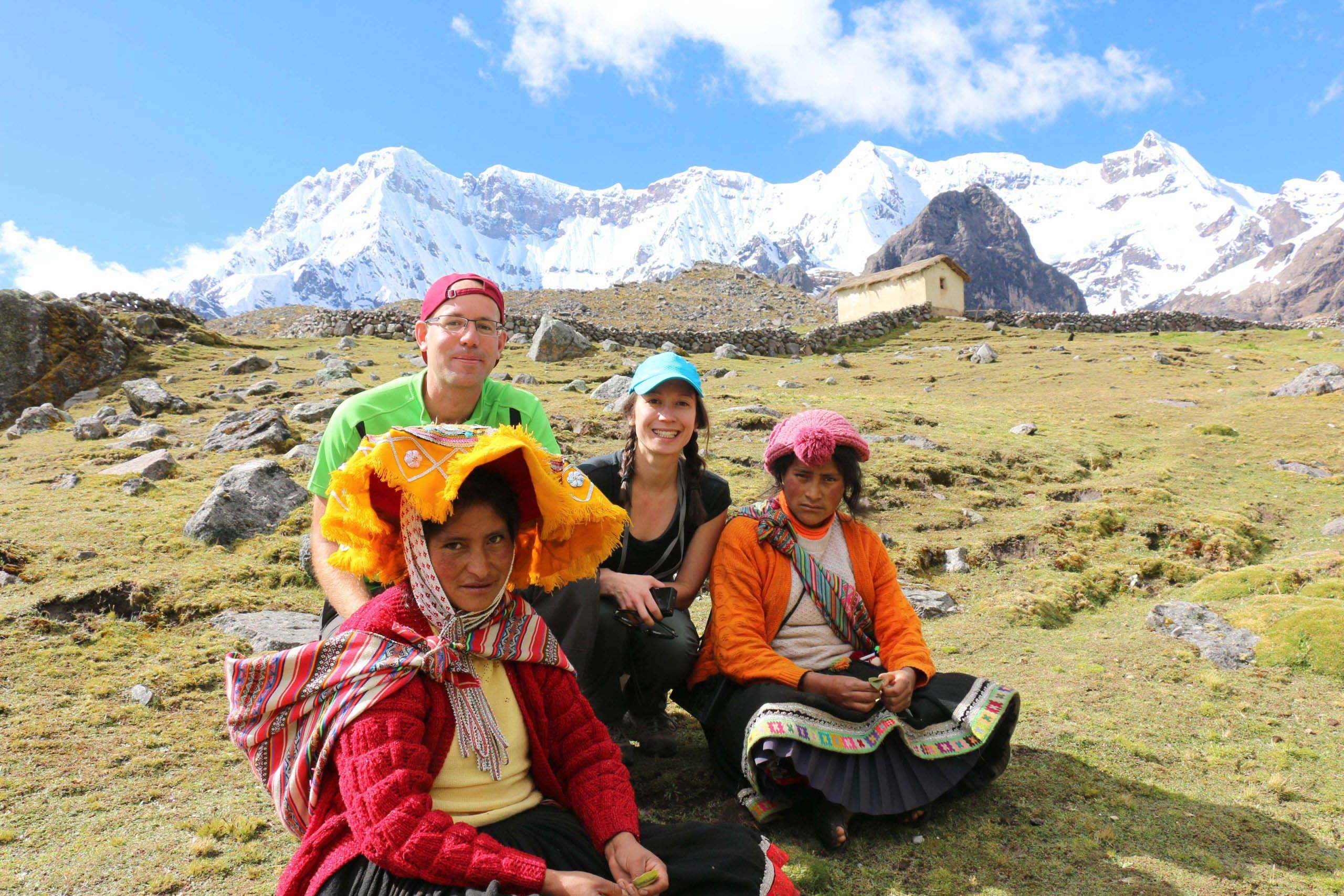
EXTRAORDINARY, ONCE IN A LIFETIME EXPERIENCES!
Your adventure begins here, explore the ausangate trek & rainbow mountain vinicunca in the andes of peru.
Ausangate Trekking Peru is a recognized and professional trekking company based in Cusco . We are a unique company that is 100% specialized in Ausangate Trek and Rainbow Mountain . Our treks are conducted in small groups to minimize our impact on the environment and ensure the highest quality of attention to each passenger. Each tour is operated by our highly accredited and experienced guides who will take you along the famous Apu Ausangate .
- Apu Ausangate
- Rainbow Mountain Vinicunca
- Ausangate Lodge
- Andean Experiences
Local ownership and operation
We are a local trekking and tour agency in Peru. Book directly with us.
Unforgettable experiences
We offer high quality customized services. Reliability and care are our strengths, which have earned us a great reputation..
Expert local guides
Safety is our top priority and our main concern! All our mountain and trekking guides receive regular training and their skills are updated every year.
Small groups
A big part of the experience is our small groups. It is these people that make traveling with Ausangate Trekking unforgettable.
Experience The Ausangate & Rainbow Mountain Trek
Enjoy the incredible hikes to ausangate and rainbow mountain vinicunca.
Spend memorable days hiking through some of Cusco’s most dramatic landscapes. Get a taste of the trail in the rugged Ausangate Mountain before traveling to the Machu Picchu Sanctuary, where thousands of acres of wilderness provide the backdrop to a beautiful hike above sweeping hills and valleys. The Ausangante and Rainbow Mountain of Cusco are full of breathtaking landscapes and awe-inspiring adventures. Rugged highland valleys, towering peaks, pale blue glacial lakes, and vast mountains stretch endlessly toward the sweeping skyline. These hikes focus on a wide range of Cusco and Ausangate’s most iconic destinations, making it the perfect trip for enthusiastic hikers interested in checking Ausangate and Rainbow Mountain off of their bucket lists. The experience of striking out into this amazing wilderness alongside expert Trek Leaders and new friends is not one to be missed.

Ausangate Trek
The ausangate 7 lakes hike 1 day, urcos - ocongate - tinke - pacchanta - comercocha lagoon - otorongococha - azulcocha - pacchanta hot springs.
Day 1: :Cusco – Pacchanta – Circuit 7 Lagoons – Cusco Our Ausangate 7 Lakes Day Hike begins with the pick you up from your hotel in Cusco at 4:00 am. Then, you will drive for 3 hours and 30 minutes in our private Transportation to the town of

Ausangate Trek To Rainbow Mountain 2 Days
Cusco - cusco – vinicunca rainbow mountain- ausangate lodge - circuit of the seven lagoons – pacchanta – cusco.
Our Ausangate Trek To Rainbow Mountain 2 Days is a good option for those who don’t have much time and is still want to see the Majestic Ausangate Mountain which is the 5 highest mountain in Peru. We have Lodge where you will spend the night comfy

Ausangate Trek 2 Days With Lodge
Our Ausangate Trek 2 Days with Lodge is a good option for those who don’t have much time and is still want to see the Majestic Ausangate Mountain which is the 5 highest mountain in Peru. We have Lodge where you will spend the night comfy. You will

Ausangate Rainbow Mountain Trek 3 Days
Cusco – pacchanta – upis pampa – hanantapata- rainbow mountain vinicunca – cusco.
The Ausangate and Rainbow Mountain Trek 3 Days offers you an unforgettable experience in just three days! If you like to get off the normal tourist routes and are excited to explore some unique, rural parts of the Andes, this trek is for you. Book

Ausangate Trek 4 Days 3 Nights
Cusco – ccayrahuire – hanantapata – ausangate cocha – huchuy finaya.- tticllacocha – ninaparayoc- pacchanta- cusco.
The Ausangate Trek 4-days trek is one of Peru’s best hiking lovers’ options. Don’t miss the excitement of this adventure heading to the Rainbow Mountain, located in the Andes mountain range. You’ll observe gigantic glaciers, crystalline

Ausangate Trek 5 Days Classic
Cusco – pucarumi – paqchanta- jampa pass – huano huano - laguna ausangateqocha.- upispampa -upis - cusco.
The Ausangate trek 5 days offers an array of wildlife including soaring condors, Alpacas, Viscachas, vicuñas, Condors, bobcats and pumas. Our private campsites are located with amazing view of Ausangate Mountain from different angle and you will al
Experience the Inca Trail Hike to Machu Picchu
Breathtaking inca sites, overwhelmingly impressive verdant vistas, and deluxe camp under starry nights..
“We had the most wonderful adventure celebrating our anniversary by hiking the Inca trail for four days…We cannot say thank you enough to Peru Summit adventures for this trip. We have fallen in love with Peru and will absolutely be back to see Carlos and his team.“ Four days of cold, pain, and exhaustion dissipate as the mist lifts to reveal the emerald peaks and terraced ruins of the mystical ancient city–Machu Picchu. Inca Trail Hike to Machu Picchu is for sure one of the life changing experiences. The amount of hikers a day is limited to 500 and the permits sell out quickly moths in advance, so our recommendation is to book you permit 6 months in advance at least.

Short Inca Trail 2 Days
Cusco - km 104 inca trail - chachabamba - wiñaywayna - sun gate - machu picchu.
This short inca trail 2 days with a hotel allows you to visit the most magnificent ruins such as: Chachabamba and Winawayna, and then enter on foot through the Sun Gate as the Incas did. You are going to take a bus down

Inca Trail To Machu Picchu 4 Days
Dead woman’s pass - runkurakay - sayacmarca - phuyupatamarca - wiñay wayna - sun gate - machu picchu.
Inca Trail 4 Days 3 Nights The famous Inca Trail to Machu Picchu is Peru’s number one hike and one of the most well-known and popular hikes in the world. Offering 4 days of hiking along original paved Inca pathways, a

Humantay Lake & Salkantay Trek 2 Days
Cusco - mollepata -humantay lake - salkantay pass - salkantay lake.
El 2 Days Humantay Lake and Salkantay Trek is a great way to explore the highlights of the Andes Mountains in a short amount of time. The Humantay Lake is one of the many hidden gems of Peru’s highland region and wel

Salkantay Trek 3 Days to Machu Picchu
Cusco- soraypampa -salkantay mountain -santa teresa - aguas caliente -machu picchu, your safety is our priority, explore with confidence.
We are committed to ensuring the safety and wellbeing of our travelers, and the people and communities impacted by our trips. As firm believers in the human urge to explore and learn, even in times of social distancing, we have established an enhanced set of security guidelines to guarantee the optimal travel experience.
Peru Packages
Travelling around peru is a bit more complicated than other countries. book one of our comprehensive packages and let vidal expeditions handle all the difficult logistics and bookings. we have lots of options including all the highlights of peru including the amazon, lake titicaca, flights over the nazca lines, even foodie tours around lima. and if our published itineraries aren’t perfect, we can customize just for you. we got you covered.

Machu Picchu Tours
Machu picchu one day tour, cusco - ollantaytambo - aguas calientes - machu picchu.
Machu Picchu Full Day by Train Visit Machu Picchu through the most comfortable and fastest way to get there. The train ride goes through the landscapes of the Sacred Valley of the Incas until arriving at the Aguas Cali

Machu Picchu Tour By Train 2 Days
Enjoy a relaxing tour of Machu Picchu in 2 days by taking an incredible Train Journey to the Inca Fortress and discover why this ancient Inca citadel of Machu Picchu is a sacred place wrapped in a veil of mystery w

Sacred Valley and Machu Picchu 2 Days
Chinchero, moray – circular terraces, salt mines , ollantaytambo and machu picchu.
Do you want to visit the most amazing places the Incas left us but don’t have much time? Our 2-day Sacred Valley and Machu Picchu tour will take you to the most amazing Inca complexes, including World Wonder Machu Picc

Cusco Sacred Valley Machu Picchu 3 Days
Coricancha the main inca temple typical central market of cusco interesting inca and colonial streets sacsayhuaman qenqo tambomachay pucapucara pisac inca ruins and typical market.
DAY 01: CUSCO CITY – SACSAYHUAMAN – QENQO – PUCAPUCARA – TAMBOMACHAY – PISAC We pick you up in the morning from any place in Cusco you tell us. Then we get you to the downtown of Cusco to ex

Machupicchu Rainbow Mountain 4 Days
Cusco city tour - moray - maras salt mines - machu picchu - rainbow mountain vinicunca.
If you want to see the best that Cusco has to offer, learn all about the amazing history of the Incas, and be astounded by sheer natural beauty, our 4 Day Rainbow Mountain and Machu Picchu tour is for you. Whether you’
Trending Adventures Treks in Peru
Suggested itineraries and best alternative treks in peru beyond the salkantay trek to machu picchu and the inca trail..
These excursions will show you a different side of Peru that is just as extraordinary and breathtaking. With us, you'll experience exceptional hospitality and personal attention to detail as our passionate and professional guides share the best parts of Peru.

Day 1: :Cusco – Pacchanta – Circuit 7 Lagoons – Cusco Our Ausangate 7 Lakes Day Hike begins with the pick you up from your hotel in Cusco at 4:00 am. Then, you will drive for 3 hours and 30 minutes in our private T

Cusipata - Llactoc - Rainbow Mountain Peru, Vinicunca
Rainbow mountain one day tour.
Cusco – Cusipata – Rainbow Mountain Vinicunca – Cusco This journey start picking you up from your Hotel at five in the morning. Then we continue getting to the town of Cusipata, where we will have a good and delic

Mollepata - Soraypampa -Sky Camp - Humantay Lake
Humantay lake one day tour.
Cusco – Mollepata – Soraypampa – Huamantay Lake – Cusco Humantay Lake Full Day Tour .- The trip starts in the city of Cusco at approximately 4:30 in the morning (we will pick you up at your lodging). After two

Cusco, Chinchero, Maras , Moray, Salt Mines, Ollantaytambo, Pisac.
Sacred valley full day tour.
Cusco – Chincheros – Maras&Moray – Urubamba – Ollantaytambo – Cusco Sacred Valley Full Day Tour .– The trip starts picking-you-up from your hotel at eight in the morning. Then we will go to the town o

Cusco - Chinchero - Moray - Maras, Salt Mines - Huaypo Lagoon
Moray and maras salt mines full day.
Cusco – Chincheros – Maras – Moray – Salt Mines – Cusco. Moray and Maras Salt Mines Full Day .- The trip starts picking-you-up from your hotel at eight in the morning. Then we will go to the town of C

Cusco - Tipon - Pikillacta -Huacarpay- Andahuaylillas
South valley half day tour.
Cusco – Andahuaylillas – Pikillacta – Tipon – Cusco. South Valley Half Day Tour .- We pick you up from your Hotel between 9:00 am to start visiting these incredible places in the southern of Cusco. TIPON: Tipon

Cusipata - Quehue - Qeswachaka Bridge - Four Lagoons
Q’eswachaka inca bridge full day.
Q’eswachaka Inca Bridge Full Day (also spelled Keshwa Chaca, Q’iswa Chaca, Keswachaka, Q’eshwachaka, Qeswachaka, Q’eswachaca, Q’eswachaka, Queshuachaca, or Queswachaka), is the last remaining I

Cusipata - Checacupe - Palccoyo Rainbow Mountain - The Rock Forest
Palccoyo rainbow mountain 1 day.
We’ve all heard plenty about Rainbow Mountain; the famous mountain of 7 colors a few hours south of Cusco. But what about Palccoyo Rainbow Mountain ? It’s another mountain that is full of colors and just as beautiful

Cusco - Cusipata - Acomayo - Marcaconga - Waqrapukara
Waqrapukara trek full day.
Our Waqrapukara Trek is a remote group or private hike where you can enjoy horseback riding, white water rafting (or canoeing), hiking and camping trek along with spectacular sceneries to the Apurimac Canyon 3 hours S
Suggested Peru Destinations
Discover machu picchu and cusco alongside the country's finest travel guides..
Peru offers world-class tourist attractions, with mysterious archaeological sites, awe-inspiring landscapes and diverse wildlife. In this vast and storied land, ancient, colonial, and modern traditions meld together for an unforgettable cultural experience. No matter the type of traveler—history buff, adventurer, or foodie—Peru offers a myriad of activities to satisfy every appetite.

Alternatives Trek
Cusco, peru.
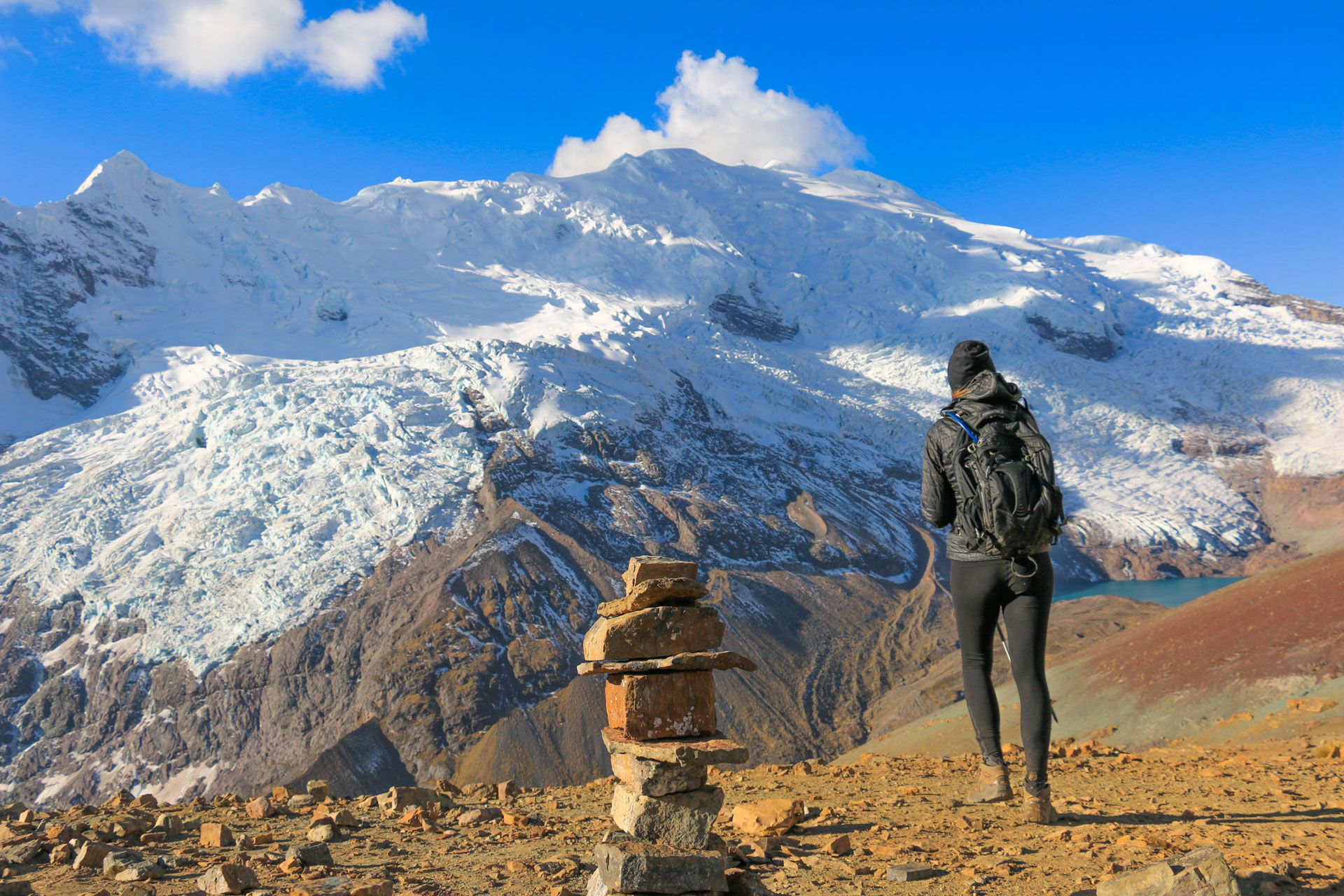
Ausangate Trek Peru
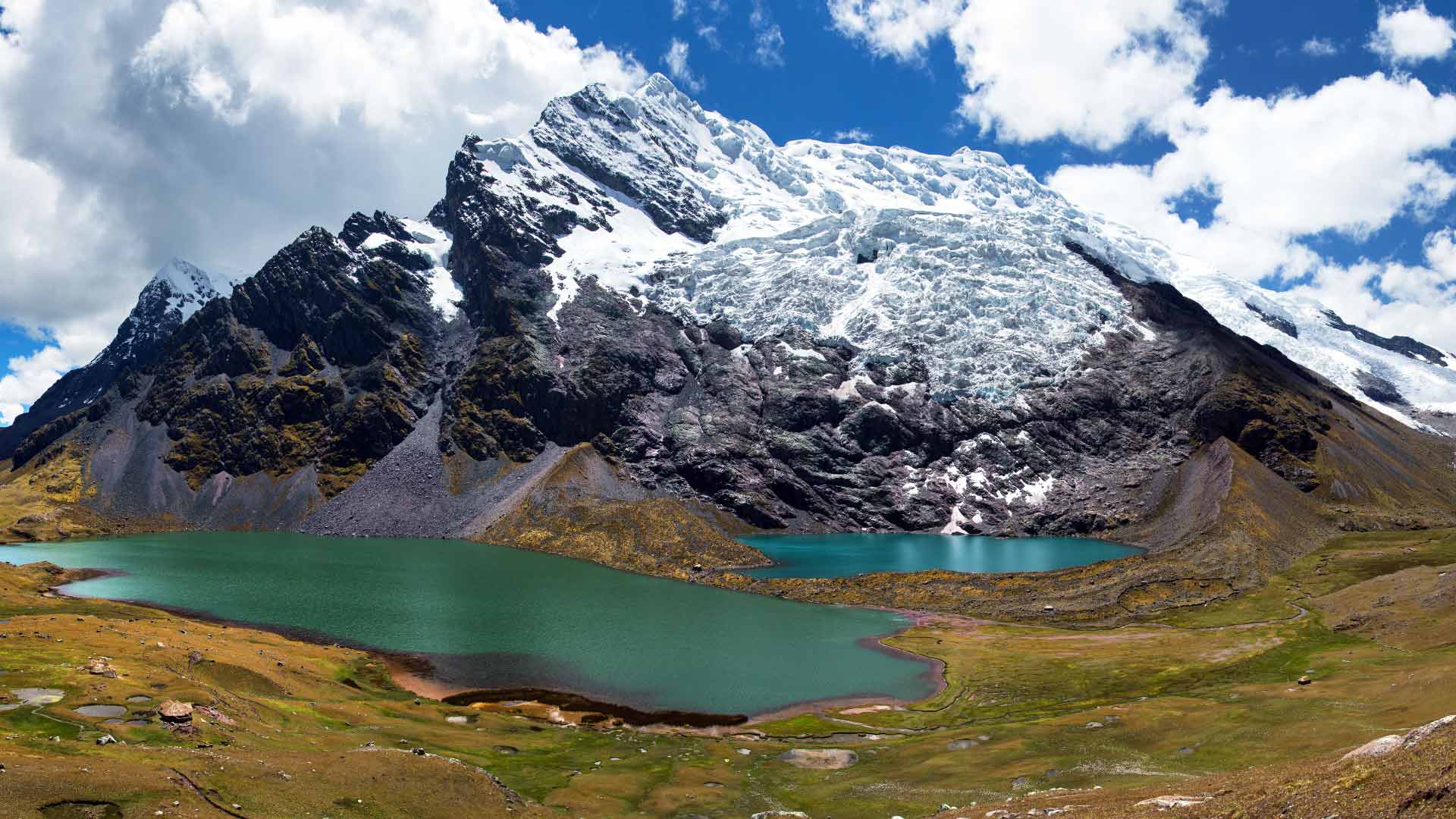
Ausangate Trek Tours
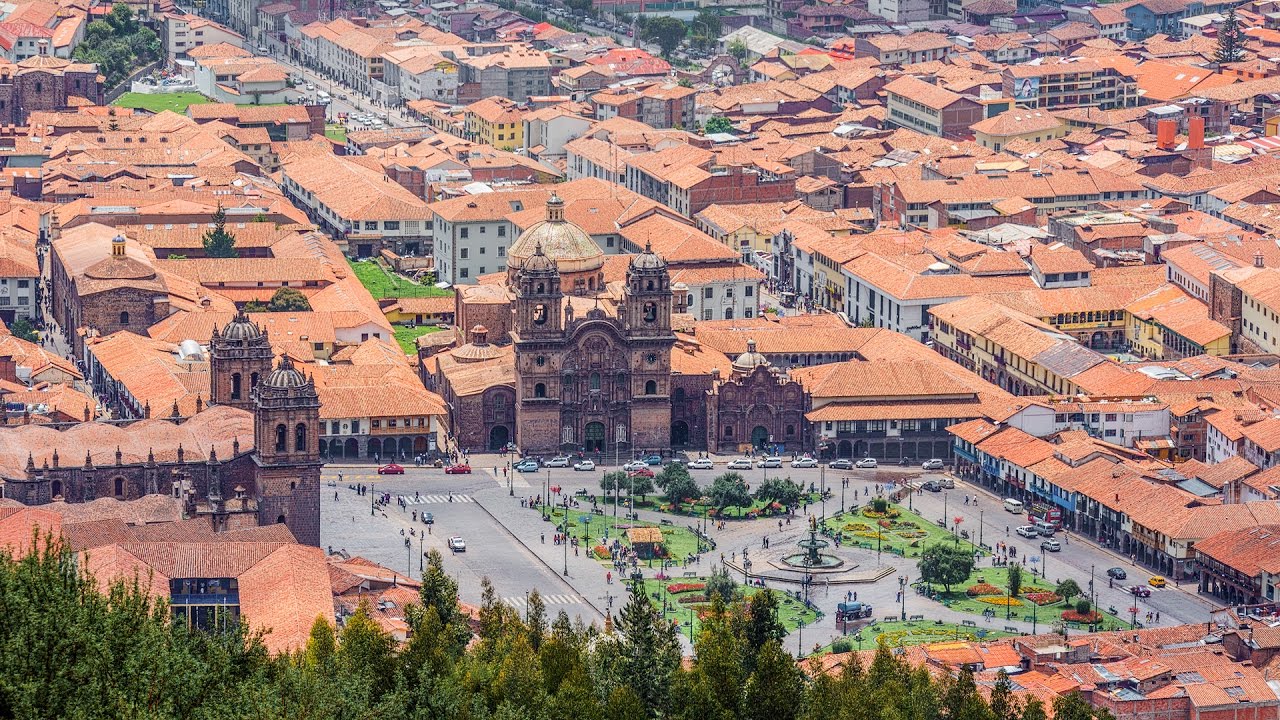
Cusco Day Hikes

Cusco Day Tours
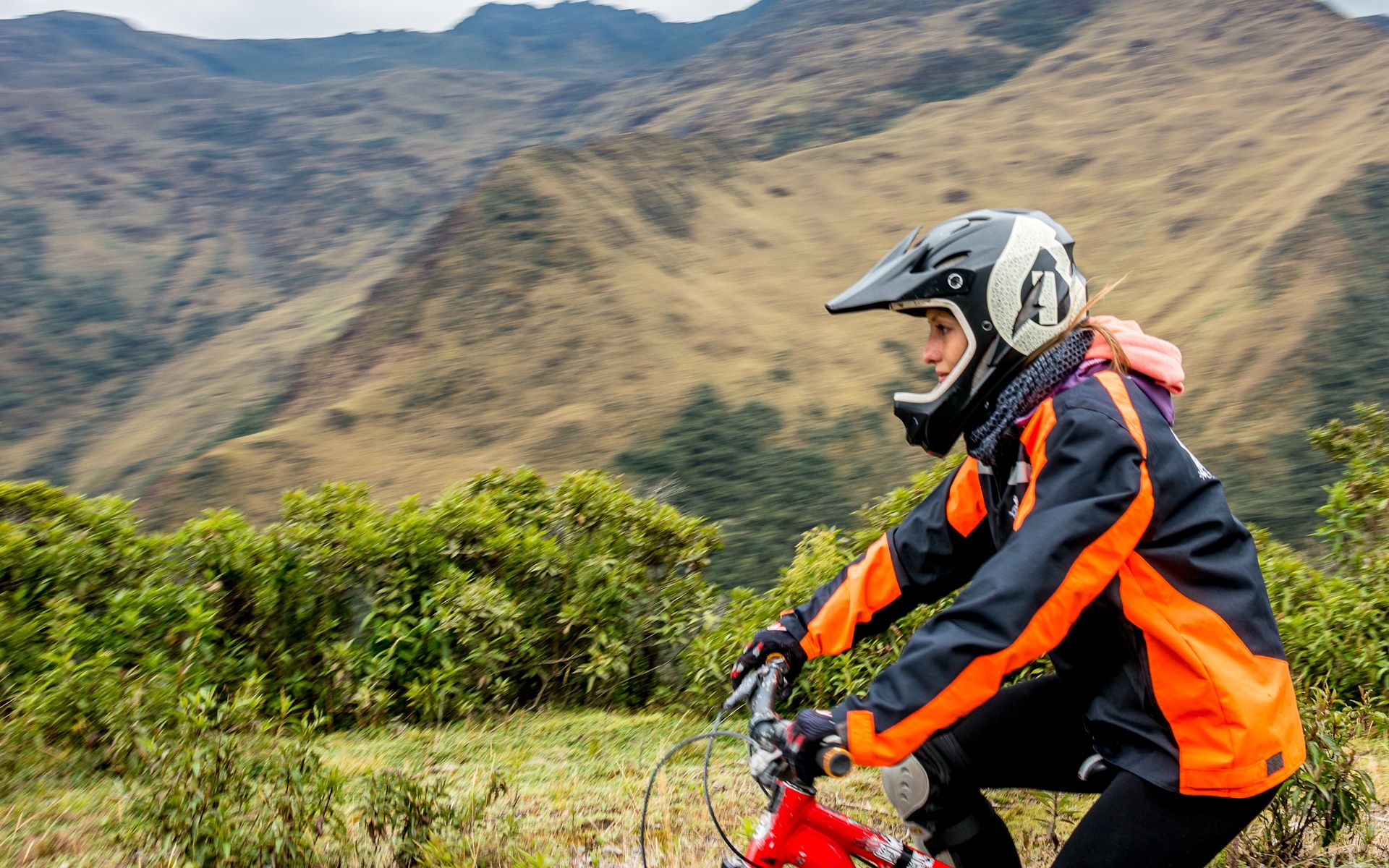
Inca Jungle Trail

Inca Trail Peru
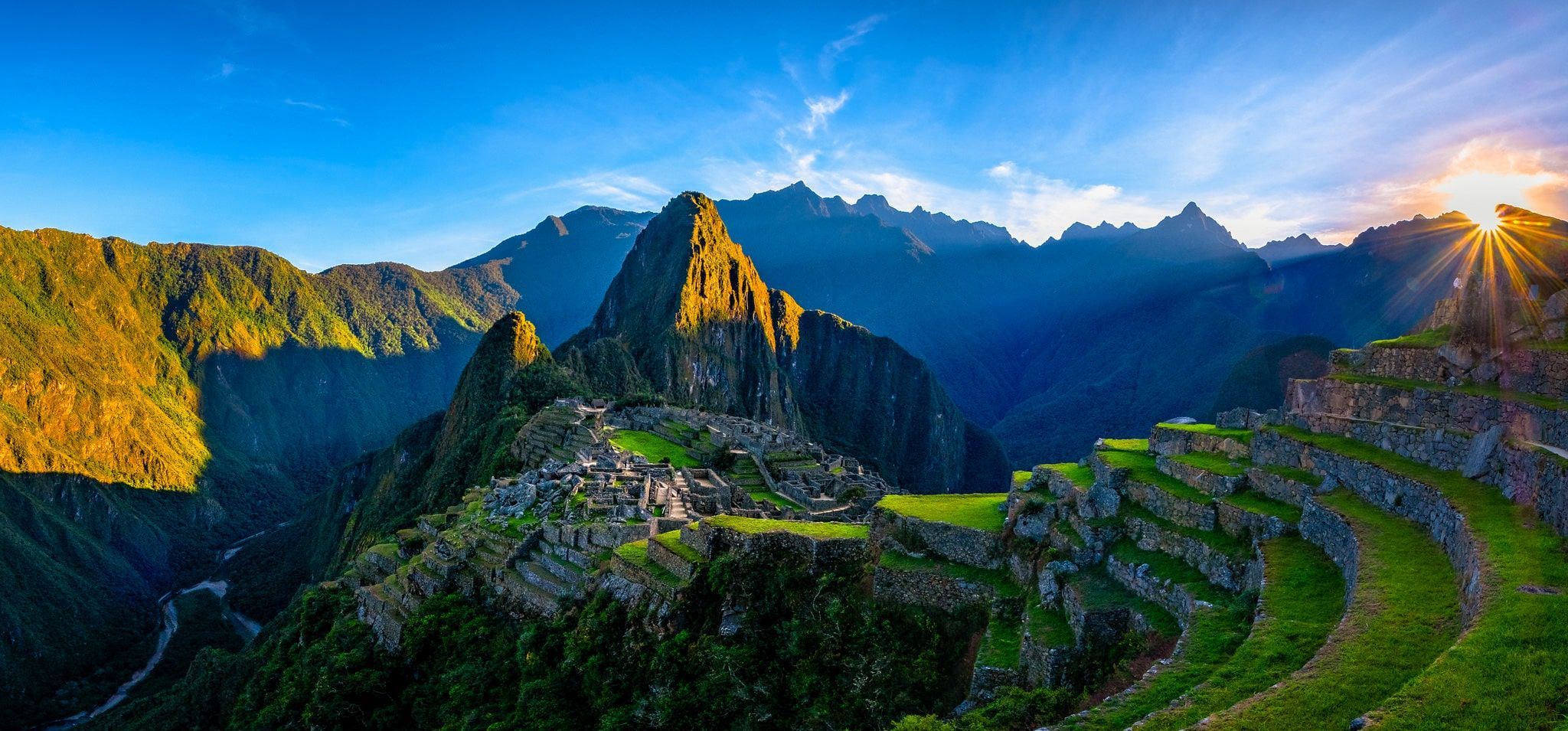
Peru Travel Guide
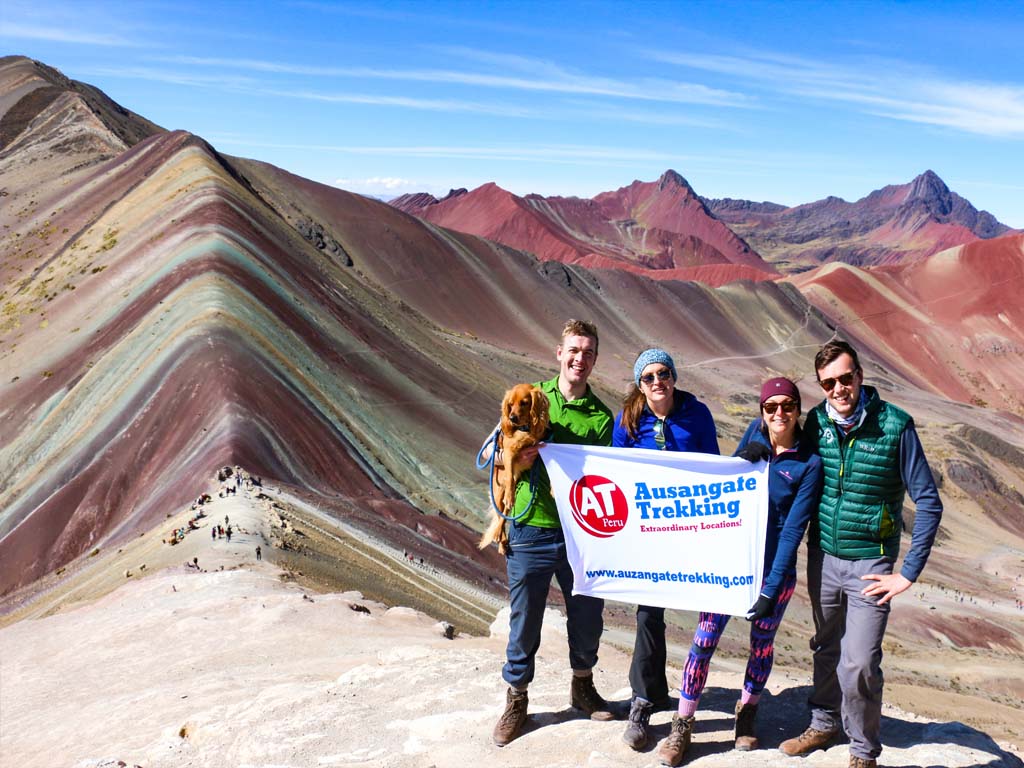
Rainbow Mountain Trek

Salkantay Trek Peru
Frecuently asked questions, the most frecuently asked questions at ausangate trekking, how do you prevent altitude sickness in cusco.
The best way to prevent altitude sickness in Cusco is to be prepared. During your first 2 days you should take things easy. This means you shouldn’t take part in any strenuous activity. You should rest a lot and drink plenty of water. Alcohol and smoking isn’t a good idea as it can agitate you and make you feel a lot worse.
How to avoid altitude sickness in Peru?
You can avoid altitude sickness by spending a few days taking it easy in Cusco before you head off on any kind of trek. Trying to do a tough activity too soon could make you very ill. You should also eat lightly and avoid alcohol to feel your best.
What is the best trek to Machu Picchu?
There’s no definite answer to this as there are many options. The Inca Trail is the most popular and needs to be booked months in advance as there are only a certain number of spots each day. The best alternative trek is considered to be Ausangate Trek, which offers a real adventure and fantastic scenery. Inca Jungle is great for those seeking a thrill and Lares is a top option if you want a quieter and more rural experience. If you have a lot of time and want to experience two incredible Inca sites, you can opt for the Choquequirao trek.
When to do the Ausangate Trek?
The best time to do the Ausangate Trek is between the months of May and September which coincides with the dry season. Rainfall is low and there is more chance of blue skies.
Is the Ausangate Trek dangerous?
No. There are no dangerous areas or anything like that, the danger lies only in the altitude, the cold and the isolation. If you are lucky you will come across a couple of llama herders who may not even speak Spanish. In 3 days of trekking we may have met 12 people in total and 10 of them were in the same group. A week earlier some French people did it and they met ZERO people. It is assumed that we did it at the time of the year when most people do this trek.
Is the Ausangate Trek difficult?
It has no technical steps but it is a physically very hard route due to the altitude. A perfect acclimatization is necessary. Also, keep in mind that it is a very uncrowded route and in case of emergency it is very likely that you will not find anyone to help you. Of course, it is essential to have a travel insurance that includes assistance up to 5,400 meters (not all of them). If you are not sure you can do it, do not risk it, you have other routes such as the Salkantay Trek which is much easier and more accessible and very beautiful.
How high is the Ausangate Trek?
The Ausangate Trek is a high altitude 70km hike in the Peruvian mountains near Cusco with an average altitude of over 4000m.
Is it cold on the Ausangate Trek?
Very cold. The cold can be intense, especially at night. In summer the temperature can drop to -5 or -10 degrees and there is always the possibility of a snowfall. Keep in mind that most of the time you walk above 4,000 meters above sea level.
Is it easy to get lost?
Yes, it is not that there is not a marked path, it is that there are many and they cross each other, plus you get to esplanades where it is very easy to get disoriented. We recommend 100% the use of a GPS that works in the mountains, or an offline map. We used Maps.me and it worked for us.
How can I prepare for Ausangate Trek?
To prepare for trekking at high altitudes we recommend you start to prepare a few weeks before. You should start a fitness regime that includes daily stretching and exercises, particularly for your legs. We recommend taking hikes at home weekly before you come to do the trail.
What helps altitude sickness in Cusco?
If you do feel sick, there are a few things you can try. One is to speak to your doctor before you come to see if you can get a prescription for pills to help. These can also be bought in pharmacies in Cusco. Other helpful ways are to drink coca or muna (Andean mint) tea, which have been in use since the Inca times. Small oxygen bottles are also available in pharmacies and can really help.
What are the coldest months in Cusco Peru?
The coldest months in Cusco are from May to July. During this time the sun is strong in the day, but once it goes down or you spend much time in the shade, it can get very cold. It can go below zero at night, so warm clothes are a must during these months.
What is the best month to go to Machu Picchu?
The best month in all the year is October. The climate is just right and the sky is usually very clear. It’s also not the busiest season so it isn’t overrun by visitors. However, anytime from May to October is a good time as it’s the dry season so you won’t get wet.
What’s the Difference Between the Different Ausangate Treks?
At Ausangate Trekking , we offer two variations of the Ausangate Trek , over four or five days.
The main difference is that on the 4-day trek, you’ll visit Rainbow Mountain , aka Vinicunca , which is a highly sought-after tourist destination. Do keep in mind, though, that if you opt for this trek, you’ll see more people and larger crowds when descending from Rainbow Mountain . Your time at the mountain itself will be quiet as we get there before the large groups.
The other main difference is the length and what you’ll see. Obviously, the 5-day trek is a little more challenging as it’s over more days. You’ll also get the chance to see more stunning views, visit different thermal baths, and spend more time in local communities to learn their customs and traditions.
What Is the Food Like on the Trek?
One of the aspects you’re likely to be most amazed by is the food on the trek. Most guests mention how much they enjoyed the array of dishes prepared by our professional chefs on the route. You’ll be blown away by the food you eat in the middle of the mountains.
We know that nutrition on the routes is essential, as you need plenty of energy to get you through each day. For this reason, we worked long and hard, together with our chefs and top nutritionists to put together the most well-rounded menu possible for the Ausangate Trek .
Every time you sit down for a meal, you’ll be greeted with an array of options for you to choose what you like from and that include all the essential food groups for a well-balanced meal every time.
If you have an allergy or prefer not to eat certain foods, you don’t need to worry. All you need to do is let us know before the trek and we’ll ensure you eat as well as everyone else in your group and enjoy all the fresh and local ingredients possible.
It gets even better—we¿ll also give you a cloth bag that we provide snacks for every morning to keep you going. We also prepare a special “tea time” at every camp with tasty light bites and hot drinks to tide you over until dinner.
You can see that you certainly won’t go hungry on the Ausangate Trek and will get to try many of our traditional Peruvian dishes.
How Much Does the Ausangate Trek Cost?
The price of the Ausangate Trek will differ depending on the company you travel with and the number of days you opt for. This is a summary of the costs when you decide to travel in a group tour with Ausangate Trekking . Prices are per person.
- AUSANGATE & RAINBOW MOUNTAIN TREK 4 DAYS — $450 USD
- AUSANGATE TREK 5 DAYS — $500 USD
How Far Do We Walk Every Day?
Every day, you’ll walk around 6–7 hours on average. You’ll walk the furthest on day 4, but because it’s not as much uphill, it isn’t as difficult as days 2 and 3. Below is a breakdown of the distance you’ll cover on each day of the Classic Ausangate 5 Days Trek :
- DAY 1: 10 km / 6.21 miles
- DAY 2: 12.1 km / 7.5 miles
- DAY 3: 13 km / 8.1 miles
- DAY 4: 15 km / 9.3 miles
- DAY 5: 7.1 km / 4.4 miles
Is the Ausangate Trek Worth It?
Yes. Most definitely! The Ausangate Trek is one of the best alternative routes in the Cusco region . This trek is especially suited to those who like to get off-the-beaten-path and escape the large crowds on some of the more popular trails.
You’ll be rewarded with some of the most incredible scenery imaginable after relatively difficult days of trekking. Expect to see snowy mountain peaks, crystalline lagoons, and plenty of local flora and fauna.
Our Flawless Reviews
Your words -- we tell it like it is.
Our travellers are our best advocates, and they frequently recommend our specialist travel services to friends, colleagues and family when planning a trip to our region.
Amazing trekking with perfect guidance
Our day hike with Urbano was absolutely perfect! I stayed in a nice and remote newly built lodge at the foot of Ausangate mountain, where Rosita, a farmer from the local community, prepared delicious Peruvian food (all vegetarian since we ordered that). The hike was absolutely spectacular: we managed to get to around 5, 000 meters above sea level to look at the beautiful lakes with different shades of blue. Urbano, our guide, spoke excellent English and told us a lot about the mountain, but also about the local culture and history. We really enjoyed the trip with him. And would recommend him anytime. Be aware that the weather can change very quickly in the mountains (especially between the dry and rainy season in late November).

Unique Trekking Experience
Percy and Urbano were a great company and professional tour operators from the first time we met them. We had many doubts about the trek in the beginning because of unfavourable weather conditions. At no moment we felt being pushed into buying the tour. When I was ready Urbano was there and had everything prepared in the blink of an eye. The trek itself was amazing. It takes you to really remote places where you hear nothing but the water of the rivers. The scenery is incredible and even along the 4 days extremely diverse. You can't imagine all the colours you will see. Urbano knows very well the region and the people from the village where the trek starts... Thank you once again, Urbano and Percy, for giving me this exceptional experience.
4 days Ausangate Trek Wonderfull
This 4-day-tour was an unbelievable experience concerning the nature, food, season-changes (during the rainy season) and so on. We had a very competent guide, a reaaaally good cook, two horsemen und 5 horses who carried all the stuff (baggage, tents and so on). Everything was well organised and worked out perfectly. We can highly recommend the Ausangate Trek organised by this agency! It’s the highlight of our 3-weeks-journey in Peru.
What Defines Us
Everything from one source.
There's a reason why so many people recommend our adventure holidays.
Legally Licensed
We are registered and licensed Tour Company, accredited by the Peruvian Ministry of Tourism DIRCETUR CUSCO.
Expert Guides
We work with the best guides in the city. They all have an official degree in tourism and have vast experience touring our routes. They are responsible, respectful, trustworthy, and fluent in English, Spanish, and Quechua.
Small Groups & Big Adventures
With a maximum group size is 8 on most tours, it feels more like traveling with friends than being on an organized tour. You'll meet like-minded people where everyone is guaranteed to share a passion for travel.
Our Experience
We offer the most focused and personal treks you will be able to find in Perú. With a multitude of exciting itineraries, you can experience breathtaking journeys through the Andes'.
Fantastic Meals
To provide exceptional meals, we customize our menus depending on the preferences of the group, and we regularly accommodate vegetarian, vegan, gluten-free, and other specialty diets.
Environmental Sensitivity
We have deep love and respect for our Mother Earth or Pachamama since we are a 100% Cusco company. We know the importance of our Andean culture, and like good children of the earth, we do everything possible to avoid contamination.
Camping Equipment
It’s essential to have the best equipment when you’re walking in the mountains. Due to the constant climate changes in the region, we use tents suitable for all four seasons.
Join Upcoming Trips
Book this trip with us. here are the upcoming dates. feel free to share this trip with your friends and family. for custom trips or general inquiries, ausangate lodge pacchanta, we are a nice place to rest. road to the amazing snow capped ausangate. with many services for your enjoyment..

Our Licences


Ausangate Trek – Lodge to Lodge along the Camino del Apu Ausangate
Our Ausangate trek started with a picture, a mind-blowing image circulated on Facebook of a surreal rainbow mountain, which I assumed had been photoshopped beyond belief. (Could something really be that beautiful?) When I saw the image, I initially thought it was the Zhangye Danxia mountains in China, but something about the shape of the hill looked slightly different. Dragging the picture into Google image search revealed that I was looking at formations near Ausangate mountain just a few hours from Cusco, Peru. Yay!
The Ausangate circuit is featured on many lists of the world’s best high-altitude treks. One of the holiest mountains in Incan mythology, Ausangate features windswept valleys, snow-covered peaks, glaciers, panoramic views… everything a serious trekker could want. But much to our surprise, we discovered that that rainbow mountain was not on the well-known camping circuit. Further digging revealed that the Camino del Apu Ausangate, an alternative lodge-based Ausangate trek run by Andean Lodges , combines the stunning mountain scenery and high-altitude passes of Ausangate with the little known technicolor landscapes around Vinicunca to the southwest. Start packing, people!!!
Ausangate Trek, Day 1 – Cusco 3,399 m (11,152 ft) to Chillca Tambo 4,368 m (14,331 ft)
Fast forward a couple months, and we suddenly found ourselves in an Andean Lodges’ van bouncing up and down on a dirt road into the Cordillera Vilcanota, a Peruvian mountain range boasting several 6,000+ m peaks including Ausangate (6,384 m / 20,945 ft). The drive from Cusco to the trailhead had included a quick stop in Checacupe to visit a colonial bridge and a reconstructed Incan bridge as well as the town’s gorgeous church, one of the most ornate in the Sacred Valley. From Checacupe, the gradually deteriorating road wound its way through a series of river valleys taking in the ever-more-spectacular Andean landscape.

The drive itself was a highlight. We passed isolated Quechua villages with crumbling adobe dwellings and herds of sheep, llamas and alpacas. Women dressed in colorful Quechua clothing slowly walked along the road, the silver ornamentation on their oval hats glistening in the momentary sun. Eventually, we rose above the Peruvian tree line. With little warning, the van stopped.
“We’re here!” announced our guide Jesus. Sebastian, playing the role of second guide, jumped out of the van and started taking hiking poles out of the back of the van. British walkers Malcolm and Sue sat staring out the windows unsure of where “here” was. Daisy, an American working for a trekking company, started packing up her daypack. Thomas and I stepped out of the van and examined the tiny path which crossed a small river and led off into a snaking gorge. From the first step, it was clear the Ausangate trek was going to be stunning. Little did we know.

The first few minutes of the trail were a good test for trekkers; the narrow, gravely path clung to the steep walls of the gorge and required some sure footing and focused attention. But after about thirty minutes, the rocky gorge opened up into a broad glacial valley filled with herds of llamas and alpacas, which made for much easier walking. Two Andean geese, symbols of devotion, swooped in and landed along the banks of the river; we would see these birds, known locally as huallatas, over and over during our five-day, 45-kilometer Ausangate lodge trek.
Off to the left, the small Quechua village of Chillca seemed dwarfed by the sweeping slopes. Colorful figures drifted about tending their herds and doing their daily chores. In the distance, we could see Chillca Tambo, our first lodge, backed by the spectacular snowy peaks of Puca Punta and Jatun Jampa. As we approached, llamas carrying our bags arrived via a different path – perfect timing! We were greeted at the lodge with hot drinks, alpaca slippers, snacks and a warm fireplace. Later that evening, we dined on a delicious meal of stuffed trout, steamed vegetables and mashed potatoes as Wilma, a local member of the staff, serenaded us with traditional Quechua tunes.

Ausangate Trek, Day 2 – Chillca Tambo 4,368 m (14,331 ft) to Machuracay Tambo 4,814 m (15,797 ft)
As would happen every day on the Ausangate trek, Wilma’s tiny voice outside our door woke us with more Quechua songs. It was one of her responsibilities to wake the trekkers each morning. Jesus and Sebastian later explained that Wilma was so shy about talking to foreigners that she preferred to sing them awake. I joked that I was going to record her voice and use it as the alarm on my phone. (Her singing is featured in the lead video.)

After a hearty breakfast of oatmeal and fruit, a group of women from Chillca gathered outside to demonstrate their spinning and weaving techniques and sell their traditional textiles. Chillca is quite remote and there are few opportunities for locals to earn money, so as part of their cooperation with communities along the trail, Andean Lodges organizes such weaving encounters. There was no pressure on us to buy anything at all, and it was a fantastic opportunity to watch the women work and to take photographs. It was also much more authentic than anything we experienced in Cusco and the Sacred Valley , and the sight of the women weaving in the open fields backed by snow-capped mountains was worth the whole trip.
Setting out for the day, we headed up the Phinaya Valley. The weather seemed to be changing by the second: sun, rain, sun, hail, sun, snow. Fearing heavier snow, Jesus made the decision to reroute us directly up the Pampacancha towards Ausangate. While we certainly missed a bit on the usual path up via the moraines and glacial lakes, we did have the opportunity to walk for several hours with a direct view of Ausangate’s eastern face. The weather added to the drama as the veil of snow gradually lifted to reveal the holy mountain as well as breathtaking views of Mariposa.

Every day, the Andean Lodge staff walks ahead of trekkers and sets up a tent to provide shelter during lunch. That tent was much needed our first full day out on the trail because a rainstorm broke out and it poured while we feasted on potato soup and stuffed avocados. Bizarrely, just as we finished eating, the rain ended and the sun-filled skies returned. (Now, that is some serious planning!)
We continued our hike up the rocky trails to our second lodge Machuracay Tambo taking in the gorgeous views of the surrounding glaciers, peaks, and lakes. At 4,814 m (15,797 ft), Machuracay Tambo is the highest lodge on the Ausangate trek, and Andean Lodges markets it as the “highest lodge in the world.” Nepal and Tibet fans might scoff at that claim, but the statement is really more about the level of comfort they have achieved at such extreme altitudes. Having spent months on trekking trails in Nepal, Tibet and Northern India, Thomas and I raved about how clean and perfectly white the Andean Lodges’ bedding was. Our fellow trekkers didn’t seem to understand our extreme happiness over fresh bedding, but a trek or two in the Himalayas would definitely clarify that for them.

Ausangate Trek, Day 3 – Machuracay Tambo 4,814 m (15,797 ft) to Anantapata Tambo 4,750 m (15,584 ft)
The third day started with a series of Quechua offerings to Apu Ausangate meant to protect us on our climb to Palomani Pass, the highest pass on the Ausangate trek. Officially listed at 5,200 m (17,060 ft), the jury is still out on the exact height as GPS devices disagree. Regardless, it was a steep, slow climb up with sensational views over Ausangate’s walls, crumbling glaciers and jagged peaks. I also couldn’t stop looking back and photographing Mariposa which seemed to get more beautiful the higher we climbed.

Beyond scenery, we spotted a number of vizcachas, animals which look like a cross between rabbits and chinchillas, darting from rock to rock. We also saw a small herd of wild vicuñas grazing in the distance (Yes! That was a major goal of ours to see vicuñas!!!). Once at the top, we paused to celebrate our achievement and take in the epic panoramas. I have to say here that we were in awe of Sue and Malcolm who were doing their first high-altitude trek at the ages of 67 and 71. Fantastic!!!
Crossing the pass, the rocky eastern face of Ausangate gave way to the incredible snow-covered south face, which looked like the world’s biggest pile of whipped cream. It was one mind-bending mountain view after another as we descended alongside a massive glacier towards Ausangate Cocha, the lake at the glacier’s base. At one point, I fell behind the group while I was taking pictures. The small group ahead of me dwarfed by massive chunks of ice and frozen waterfalls is a view I will remember forever.

Descending into the valley, alpacas dotted the cliffs and slopes, tiptoeing along tiny paths like fearless mountain ballerinas. At every curve, they danced across the trail in front of us curiously staring at us with rabbit-like, pursed lips that made us laugh over and over again. Below, hundreds of alpacas grazed in a broad glacial valley bisected by a small river which flowed out of Ausangate Cocha. How many times can I repeat the word beautiful?
As with day two, the weather was all over the place. By the time we crossed the valley, the blue skies had been replaced with a mix of snow and hail. And once again, we stepped into the lunch tent at the precise moment it started raining. (How do they do that?) The climb and the altitude left some of our group picking at their meals, but Thomas and I stuffed our faces with delicious soup and Peruvian causas until the rain stopped and we headed back out on the trail. The cold, cloudy skies shifted and morphed revealing peaks and stunning mountain ridges. The weather created dramatic views back over Ausangate as fierce winds whipped up swirling clouds of snow backed by a sky of steel grey.

While three of the four lodges on the Ausangate trek are virtually identical in design, the lodge on day three was different. Anantapata Tambo was designed and built with Chillca community funds as their contribution to the joint venture with Andean Lodges. For us, this was an important opportunity to witness the community’s influence.
Some guests have commented on Tripadvisor that Anantapata Tambo is simpler and less glamorous than the other lodges on the Ausangate trek, but that really is the wrong way to look at it. The single-story construction, smaller rooms, and fewer windows reveal the practical design of a people who live at high altitudes in harsh conditions. Vaulted ceilings and full walls of windows are simply not part of their cultural vision or daily reality. And I did really think the bathroom was distinctly warmer here. I also enjoyed the cozy, central location of the fireplace in this lodge.

Ausangate Trek, Day 4 – Anantapata Tambo 4,750 m (15,584 ft) to Huampococha Tambo 4,800 m (15,748 ft)
Thomas and I have had the extraordinary luck to do many of the world’s greatest hikes and treks. When it comes to landscapes, we’ve seen the best of what the world has to offer. I say with very little hesitation that day four of the Ausangate trek will always be on our short list of the world’s most extraordinary trails.

We began by hiking up to the next pass which topped out at about 5,100 m (16,732 ft). Of course, there were mesmerizing views of the rocky peaks of Tacusiri the entire way as well as back over Ausangate rising up in the distance. Ascending to the pass, there were only slight hints of the colorful magic that lay beyond. But as soon as the next valley came into view, the extraordinary sight of Vinicunca, the rainbow mountain, immediately caught my eye.
“That’s it, isn’t it?” I blurted out at Jesus and Sebastian despite the fact that it was still miles away. My eyes were locked on the mountain for several minutes before I noticed the entire valley was a natural work of art. Yellows, oranges, reds, blues, greens, purples… alpacas everywhere… reflections in Kayrawiri Lake… mountain peaks… too much for a mind to process. As clouds floated over the valley, the colors shifted and transformed playing tricks on the eyes: squirming shades of apricot, aqua and violet morphed into coral, turquoise and magenta.

Moving along the trail was a surreal experience. In one direction, classic high Andes with soaring snow-covered peaks and glaciers; in the other direction, a painted desert of rainbow minerals. Our trail changed from grey to purple to green to red as we wound our way down rocky moraine past glassy lakes and back up cinnamon slopes in the shadow of towering blue-grey mountains.
On the far side of the valley, the trail narrowed to a tiny path which sliced across steep, gravely slopes of colorful earth. Ironically, at the very moment our eyes were most likely to wander due to the phenomenal landscape, we needed to closely watch every step. This was one of the few times during the Ausangate trek where people with a fear of heights might have had some issues. I had to stop several times to revel in the magnificence of a jagged layer of yellow and grey stone that jutted into the sky ahead of us. Malcolm, a retired geography teacher with an obvious interest in geology, listed all the formations he could name as we passed.
We wanted to rush forward to Vinicunca, but Jesus urged us up a bulge of layered yellow and grey stone, “The view you want is up there.”

Despite the altitude, Thomas and I shot up the hill knowing that our photo and video taking would eat up time. It was THE view, THE picture that had led us to Ausangate in the first place. And no, it was not a figment of some Photoshop artist’s imagination; it was even more spectacular in reality than in the Facebook images we had seen. The shades of turquoise in the mountain were especially unique and mysterious. And amazingly, we had the polychrome wonderland entirely to ourselves!!! In an era in which we suppose all the world’s treasures have been discovered and overrun, how is it possible that this viewpoint isn’t a household name?

But the wonders didn’t stop there. As we walked along the rainbow slopes of Vinicunca, we spotted another herd of vicuña galloping through the valley below us. Further on, Jesus stopped to show us ancient fossils which proved the entire area had once been part of a great ocean. We walked for hours along those narrow, gravely paths through a spectrum of reds and oranges. Simply awesome! We had had no idea from pictures how extensive this painted desert was. Late in the afternoon, we stopped to have lunch at the base of a mountain that looked like the back of a purple tiger. And just before sunset, we arrived at our last lodge Huampococha Tambo.

As we approached, the legendary caretaker Tio Mario, known to the Andean Lodges’ guides as the last of the Incas, greeted us by blowing a conch shell. The sound echoed off the surrounding mountains and floated across the entire valley making our magical day even more magical. All of the Andean Lodges’ caretakers are great, but Tio Mario so obviously loves and values his interaction with guests that his hospitality transcends language barriers. If you do the Ausangate trek, take a moment to sit with him and talk with him (even if you do not speak Spanish or Quechua). Tio Mario is a real highlight in a trip filled with highlights.
Our last dinner on the Ausangate trek matched the perfect day: we feasted on BBQ, shared a bottle of Cabernet Sauvignon, and enjoyed a dessert in the shape of Ausangate created by Tio Mario himself. Afterwards, we all plopped down by the fireplace and toasted our feet as we reminisced over a very memorable if somewhat tiring day.

Ausangate Trek, Day 5 – Huampococha Tambo 4,800 m (15,748 ft) to Cusco 3,399 m (11,152 ft)
I had been so tired and overwhelmed by color when we arrived at Huampococha Tambo, that I hadn’t really noticed how beautiful the setting was. Before breakfast, I walked down to the mirror-flat lake and soaked up the otherworldly reflections of the surrounding burnt orange and purple flatiron formations. Ducks crisscrossed the lake and a pair of Andean geese flirted with each other off to my right. Was it the same pair of geese that we had seen on our first day? Had they followed us and re-appeared on each day of our trek? If so, they were as devoted to us as they were to each other.
After a super breakfast of pancakes, we started the climb up to Anta Pass paralleling those astonishing layers of rock. We were all moving a bit slowly on our fifth day, or perhaps we were just reluctant to hurry towards the end of the truly amazing Ausangate trek. We paused at the pass to take one final look at magnificent Ausangate. The holy mountain was ringed in dramatic black clouds, framed for our memories as we stepped into the valley beyond.

On our final descent, our motley crew of trekkers merged with the llama caravan and support staff. Another magic moment as the train of people and pack animals wound its way down into the narrow valley. A couple of our fully loaded llamas decided to celebrate by taking a dirt bath in a dusty hole. We made good-natured bets on whose bags had suffered most. Luckily, our clothes and supplies were carefully packed in a double layer of waterproof protection, so any dust coating (or rain) was only superficial. Continuing our descent, the reds and purples of the surrounding hills muted into browns and yellows as we followed a river almost 1,000 m (3,200 ft) down.

That river wound its way past isolated adobe houses and llama corrals. The houses gradually became larger, more structured adobe villages with women and children crisscrossing our path. Most of the locals just smiled at us shyly or said “buenos dias,” but we found it quite amusing that the herds of llamas and alpacas seemed to immediately notice we were VERY different. They stared at us like we were an army of alien invaders marching into their lands. We laughed at their reactions the whole way down the trail.
The Ausangate trek ended just after we passed the tree line. We had one final lunch feast; the cook even prepared an extra pachamanca, a traditional meal of Peruvian potatoes slow-baked in an impromptu earthen oven. (Hint: eat the ashy potato skins – it actually tastes quite good.) We took tons of pictures, and said our goodbyes. Exhausted by the perfect trek, we all crashed in the van on the drive back to Cusco. It’s amazing that the world-class Ausangate trek lies a mere three hours from one of the most touristed areas in Peru. What a discovery!

More about the Ausangate Trek and the Rainbow Mountain, Peru
Andean Lodges markets itself as the premier lodge to lodge hike in the Peruvian Andes. I have no doubt that that is true, but it is much more than that. Hardcore trekkers, especially those who have seen the Ausangate trek listed as one of the world’s greatest hikes, might worry that a lodge-based trek means sacrificing some of the epic landscapes. THAT IS NOT THE CASE AT ALL. Daisy had done hikes along the conventional Ausangate hiking route before and she assured us that these trails were every bit as rewarding, and then some.
Moreover, the conventional Ausangate trek does not enter the phenomenal multi-colored landscapes southwest of Ausangate or visit the Vinicunca rainbow mountain, two attractions which are on locally controlled community lands and are not open to other trekking companies. Andean Lodges has spent years developing this joint venture with the communities of Chillca and Osefina , earning their trust, and ensuring that their lodges have the highest environmental standards to prevent their trekking tours from damaging the extraordinary landscapes in the area.
We kept our eyes peeled for greenwashing or unintentional environmental mistakes by the company, but we did not witness anything questionable. Trash is packed out, biodegradable soaps and shampoos are provided for guests, and solar-powered lamps and candles are used to light the lodges. The lack of electricity also means that you cannot easily recharge camera batteries during the trek. Luckily, a solar-powered charger is available at the Anantapata Lodge on day three of the Ausangate trek. Andean Lodges is planning to equip the other lodges with similar charging stations.
From what we saw, Andean Lodges did an exceptional job on the environmental front. One moment in particular really impressed us. One of our fellow trekkers threw a plastic wrapper from a chocolate bar into the fireplace and Sebastian reacted with a gut level “No, no, don’t throw that into the fireplace.” His reaction was so genuine, so concerned that it immediately conveyed serious dedication to and understanding of what a green business should be. We were highly impressed.

Altitude Issues during the Ausangate Trek
The Ausangate trek involves some serious elevation gains. It is essential that trekkers understand this and take time to acclimatize before they begin the trek. Even high-altitude Cusco still sits 1,000 m (3,200 ft) below the first lodge. Experienced trekkers know sleeping 1,000 m above the previous night is a BIG JUMP. For this reason, it is highly recommended that you do some higher day walks in the Sacred Valley to acclimatize. Daisy recommended the San Jeronimo to Señor de Huanca walk near Cusco to acclimate. Andean Lodges also organizes acclimatization options including a half-day Huanacaure trek as well as a Yanacocha Lake add-on option to give trekkers an additional day at the first lodge in Chillca.
Because of the 1,000 m jump on the first day, Thomas and I both decided to take Diamox for the Ausangate trek despite the fact that we had been in Cusco for quite some time. (We generally don’t like Diamox because of its side effects, but we knew that 1,000 m was a lot.) We were the only trekkers on Diamox, and we were the only ones not to experience altitude-related issues. Of the other trekkers, nobody experienced serious altitude sickness, but they did experience headaches, loss of appetite (which was a bummer because the food was great), and difficulty sleeping in the highest lodges. Two of the other trekkers eventually started taking Diamox and their symptoms improved.
Andean Lodges is aware of these altitude issues and takes safety measures seriously. In case of altitude sickness or any other health emergencies, the guides are always in contact with Andean Lodges’ medical director via satellite phones.
Plan your Ausangate Trek
When to Go – Best time for the Ausangate trek is May through September, with April and October being the shoulder seasons.
Book Your Trip – We highly recommend that you book the Ausangate trek in advance. You can either contact Andean Lodges to ask for their rates and availability, or you can book this 5-day trek directly on Viator .
Accommodation – Most visitors stay in vibrant Cusco (or Cuzco) or relaxed Ollantaytambo before or after their Ausangate trek. Both towns are a great base for exploring the gorgeous Sacred Valley; in addition, they have plenty of accommodation options. To find great hotel deals, check out Hotelscombined.com , a site which offers the best deals across numerous top hotel booking sites, including agoda .
- Accommodation
- Hiking & Trekking
31 responses to “Ausangate Trek – Lodge to Lodge along the Camino del Apu Ausangate”
Yet again, Tony and Thomas you have out done yourselves. The Video, with the music and the photos with the article are truly amazing. I am in awe of the mountains colors and the huge peaks. Thank you for the article and it looks as though the accommodations are quite nice.
This trek looks super. It almost looks like you filmed in two completely different areas.
So beautiful. <3 <3 <3
Oh Mann, da wäre ich jetzt auch gerne. Ist halt schon ein wenig anders als bei uns in den Alpen. Super Fotos! Ich glaube ich weiß schon, wo ich meinen nächsten Urlaub verbringen will (muss nur noch meine Freundin überzeugen, die sich schon aufs Meer freut). 🙂
Extraordinary trek photos! I’m yet to experience something like this.
We highly recommend both trekking in general and this particular trek. The Camino del Apu Ausangate was an extraordinary adventure, which I would easily do again tomorrow.
Great review, I really enjoyed reading it and viewing both the photos and video. It certainly helped me better understand the sheer scale of everything and what an amazing trek it is.
I would like to thank you for mentioning Malcolm and Sue and highlighting how amazing they both are. I suspect they will be both flattered and a little embarrassed by your comments, lol.
Naturally my brother and I are somewhat biased, but we are both immensely proud of them and what they have achieved. Well done Mum and Dad! Not sure either of us are capable of such a trek now, aged 41 and 43, never mind at 71 and 67!
It’s so great to get a comment from you. Thomas and I are still going on about how lucky we were to have your mom and dad as well as Daisy on the trek.
We really wanted to mention Sue and Malcolm to encourage other seniors to get out there and explore. A lot of retired people don’t even know they have the option of doing something like this because they never see images of other seniors having adventures.
Watching the two of them take on those mountain passes one after another was BEYOND impressive – this trip took some serious energy. Sue’s backstory with her operation and having to relearn how to balance and turn takes it to another level. I was watching her on the trails – she’s amazing. We even renamed her from “sweet Sue” to “super Sue.” You should be enormously proud of both of them.
Your video gave me such memories of my Ausangate trek with Andean Lodges in April of 2014. Thank you!!! Anyone who is at all adventurous and likes peace and quiet while luxuriating in the beauty of the Andes of Peru, needs to experience El Camino del Apu Ausangate. Thanks!
@S. Ashley, It really is stunning, isn’t it? Glad the video could capture some of the awesomeness of the region.
Hi. Im planning to do the ausangate this march 2015. Is there a 4 day itinerary for this lodge trek This should be my itinerary March 02 – ETA Lima March 03 – Cusco March 04 – Sacred Valley March 05 – Inca Trail March 06 – Inca Trail March 07 – Inca Trail March 08 – Machu Picchu – Cusco March 09 – Cusco March 10 – Ausangate March 11 – Ausangate March 12 – Ausangate March 13 – Ausangate – Cusco March 14 – ETD Cusco – Lima March 15 – Lima March 16 – ETD Lima Can you advise. Thanks
Hi Arthanean,
Yes, there is a 4-day version of this trek. You cut out the Machuraccay Lodge and go directly from Anantapata to Huampococha. Even on this shorter trek, you go through the colorful areas that make Ausangate so special. But honestly, if you could add another day, it would be really worth it. Just contact Andean Lodges directly, they are very helpful and can give you a lot more info.
Wow, guys, stunning photos and video.
Thank you for this fantastic video, the landscape is so special. My brother loves to hike. Im going to tell him about Asangate.
Is there a camping version of this trek too?
Thomas and Tony,
You have given us another trek to consider.
Well done video!
Hey Joe, Thanks for the compliment. You guys would LOVE Ausangate – it’s so beautiful. So keep training those legs, so you and Mary will be ready for your next trip. 🙂
hi tony and thomas! we loved your review and video of the 5 day/4 night Andean Lodge trek, and it helped us decide to book it! We are going in late August. I’m wondering what sort of warm clothing and layering you used while hiking. We’ve heard that it gets quite cold, but do not feel like we should pack and travel with our Winter gear, as it is so bulky.
If you have a moment, let me know!
thanks, brett (from new york city)
Dear Brett,
Because we are traveling long-term with a backpack, we are always limited to what we can carry. When we did our trek in mid-September, we had a thin down jacket, a water-and-windproof jacket, long underwear, gloves, hat and scarf with us. In Cuzco, we also rented a thick down jacket and waterproof pants for the duration of the trek. The clothes we rented were clean, well-maintained and were about $9/day each. There are stores selling and renting out trekking and camping equipment all over downtown Cuzco. I think this would be your easiest option if you don’t want to carry all of your winter gear.
While we were hiking, we never had to wear long underwear or a thick down jacket because we were heating up froom walking. Definitely layer! In our case, the weather changed constantly and we were peeling and adding layers all the time. But I did love my thick jacket in the mornings and evenings when it does get cold. I hope this answered your question.
Have have a wonderful time in Peru!
i trekked this route last year in April 2014! Well, it was such a great experience that I just came off the same trek a week ago. This time I traveled with a teacher and her son, who turned out to be a mountain goat. I was in better shape than in 2014. The cardio work really helped. I can’t say enough about the beauty, challenge and excitement of this trek. I would love to do it again, a fourth time, but I fear that may not be possible. I did a similar trip in 1989 with Roger Valencia before the lodges wherein existence. The route was the now non private land route. I can’t recommend this lodge to lodge route highly enough. It’s a must in a lifetime.
Dear S. Ashley, We always appreciate when people share their experiences here on the blog, so thank you! I can totally understand that you did this trek more than once; it is so rewarding. You put it perfectly when you talked about the “beauty, challenge and excitement” of this trek, nicely summed up. You also said, it is a must in a lifetime; well, it sounds like you had three lifetimes of trekking experiences in Ausangate. Congratulations! We never met Roger in person, but we’ve heard so many good things about him. He’s obviously a genius creating such a fantastic and unique trek! 🙂
Any chance that you remember the dosage of Diamox that you took? Did you take a 250MG pill twice a day? Over how many days did you take it?
You want to take the lowest effective dose to avoid side effects like tingling in your hands, feet and lips. We took 125 mg twice a day. We actually bought 30 tablets of 250 mg Diamox in Cuzco for about $25, and it worked fine for us. (It is called Acetazolamida in Spanish, and in Peru you don’t need a prescription). We started a day before and stopped the day we left the last lodge to go back to Cuzco. It works very quickly (try a carbonated drink a few hours after taking it, and you’ll see what I mean).
On a previous trip we made the mistake of taking 250 mg twice a day, but that was way too much for us. It can actually cause similar symptoms to altitude sickness which you want to prevent in the first place.
Please follow this link to the CDC ; they recommed the same dosage for Acetazolamide (Diamox):
Hope this helped,
Enjoyed reading and watching your video…….we are doing the 5 day trek May 2016 with 3 other couples. We range in age of 54-60. This will be all of our first high altitude trek! We are all in good physical condition….half are not experienced hikers. What should the not as experienced hikers (even the more experienced) do to be well prepared for this amazing trek? We will be in the sacred valley and Cuszo for 9 days prior to the start to the trek.
You probably ask why would not as experienced hikers want to do this…….the scenery!!! For myself it is the challenge and the beauty of the scenery and the remoteness! Are we crazy??????
The number one recommendation I have for both experienced and inexperienced members of your group is to take Diamox. (Actually, Thomas mentions the same thing in the comment directly above yours on the blog.) We generally don’t like to use Diamox, but the Ausangate trek involves a particularly large jump of around 1000+m from the departure point in Cuzco to the first lodge. That is much more than the 300m-500m per day increase that most altitude sickness guidelines recommend (we’re talking the altitude increase of locations where you sleep). It really does make a big difference here because it is a jump from 3300m to 4300m, and on the following day, you climb to 4800m. That is some serious climbing. Even if many in your group have hiked in Nepal or India, most trekking routes there are usually laid out to sleep moderately higher than the previous night. Here is a link to the CDC’s info on Diamox (Acetazolamide) .
We follow the CDC’s dosage guidelines which recommends less than some general travel doctors recommend. These dosage guidelines are based on studies that have been conducted in the Himalayas suggesting that the 125mg twice a day is effective and reduces Diamox side-effects. I just want to point out that we are not doctors and everyone should read up on the subject for themselves, but these dosages have worked well in our experience.
We also STRONGLY recommend trekking poles. A lot of people, especially inexperienced hikers, think that trekking poles just get in the way. We think they are essential for dragging yourself up those high passes, descending steep slopes, and balancing on those narrow paths along scree slopes.
As for the trails themselves, they are not really technically challenging in any way. If anyone suffers from fear of heights, the second half of the trek involves narrow paths along slopes, but honestly the scenery is so gorgeous, they’ll probably be too busy taking pictures to notice.
I have to say that we absolutely love the people at Andean Lodges and the Ausangate Trek was one of our favorite experiences in South America. I’m sure you’ll love it.
Thanks Tony……I am a believer in hiking poles also! Sometimes when negotiating a slope of boulders they are a nuisance but other wise I wouldn’t be without my poles! I have mentioned to our group about discussing with their doctor about taking .Diamox. Good to hear that the hike is not technically challenging so the hiking part should be okay for our non experienced hikers…..biggest challenge will be the altitude for all of us!
What an awesome experience and awesome videos. i’ve just come back from my peru trip as well. Your post remind me much of it. Thank you!
@Asana. Thanks for the compliments. We are happy you enjoyed our post and we hope we inspired you for your next trip to Peru.
I loved your video.
Would you recommend the Ausangate circuit over the Inca Trail? Thanks.
We never did the Inca Trail, but the Salkantay lodge trek also dubbed the alternative Inca trail. Both treks are amazing and sufficiently different. It’s really worth doing both. In the end, it depends on what you prefer and what your goals are. The Ausangate trek is less busy, is very colorful and offers more classic high-altitude landscapes. The Salkantay trek combines high-altitude landscapes with cloud forest and ends in Machu Picchu , which many people like.
Leave a Reply Cancel reply
Your email address will not be published. Required fields are marked *
This site uses Akismet to reduce spam. Learn how your comment data is processed .

Our Hotel Picks in Cusco
The cozy Hostal El Grial is located in the quirky San Blas neighborhood. All private rooms come with bathrooms and individual touches.
The gorgeous Belmond Hotel Monasterio is a 400-year-old monastery turned luxury hotel in the center of Cusco.
Check out all the hotels and lodges in the Sacred Valley's most vibrant city.
Search our Site
- Antarctica (7)
- Argentina (14)
- Belgium (16)
- Cambodia (37)
- China (116)
- Czech Republic (5)
- DR Congo (2)
- Eritrea (1)
- Ethiopia (1)
- Germany (39)
- Honduras (1)
- Hong Kong & Macau (6)
- India (252)
- Indonesia (97)
- International (2)
- Madagascar (1)
- Malaysia (58)
- Malta & Gozo (3)
- Mexico (35)
- Morocco (10)
- Myanmar (28)
- New Zealand (2)
- Pacific Islands (3)
- Philippines (83)
- Portugal (8)
- Singapore (12)
- Sri Lanka (20)
- Tanzania (1)
- Thailand (92)
- The Netherlands (3)
- The Vatican (1)
- Turkey (10)
- United States (41)
- Uruguay (1)
- Vietnam (46)
Ausangate 7 Lakes Full Day
Ausangate trek 5 days, ausangate circuit 6 days, ausangate trek sibinacocha lake 7 days, huchuy qosqo trek 3 days, cachicata trek 4 days.
- Choquequirao Trek 4 Days
Inca Jungle Trek 4 Days
- Lares Trek to Machu Picchu 4 Days
Salkantay Trek 5 Days
- Rainbow Mountain Peru Full Day
Rainbow Mountain Trek 2 Days
7 Days 6 Nights Cusco Challenging Up to 12

6 Days 5 Nights Cusco Challenging up to 12

5 Days 4 Nights Cusco Challenging up to 12
WELCOME TO AUSANGATE TREK
Four key factors set us apart from other adventure and hiking companies.
All Inclusive Trips
Small Groups
World-Class Destinations
The Best Guides in the Industry
Choose your vacation type.

Alternative Treks Cusco

Our Recommendations For Travellers

IMAGES
VIDEO
COMMENTS
What Does It Cost To Hike The Ausangate Trek? Ausangate Trek Cost With A Company. Prices for the Ausangate trek vary greatly between companies. This is true for all the trekking tours from Cusco. Generally, you can expect to pay between $450-$850 for this trail. This includes guides, transport, horses, and camping gear.
Cost. Embarking on the Ausangate trek involves budgeting for various expenses essential for a successful journey. Here's a breakdown of anticipated costs to consider when planning your adventure: Item Cost; Transportation to/from Cusco/Pacchanta: $16: Permits: $10: Local Guide: $0 to $50 per day: Food:
The famous Rainbow Mountain one of the highlights of the trek. Day 5. Ausangate lake - Jutumpata, 13km. Ausangate lake (4300m) - Palomani Pass (5200m) - Jutumpata (4400m) Right after the camping, you start steep and long up to Palomani pass, up to 5200m the highest point of the hike.
The Ausangate trek is considered strenuous, with a few moderate days sprinkled in. The trek is classified as Grade C in difficulty, which implies altitudes between 14,800 to 16,400 ft (4500-5000 m) and 6-7 hours of hiking per day. ... Postpone your tour with zero cost up to 10 days prior to departure.
COST OF AUSANGATE TREK WITHOUT GUIDE. On the other hand, if you plan to do the Ausangate Trek without guide, it'll be a cheap expedition - That is, if you already have all the gear. Here are the fees involved: Transportation from Cusco: USD $6 return. Food shopping: USD $30-40. Gear rental: USD $50 to $100 per person.
Ausangate Trek Entrance Fee | Cost: 10 PEN per person ($2.75) | Some days people collect the entrance fee, other days they don't, you may be asked to pay later on during the trek. In Upis, there are modest hot springs. It's nice to soak here for an hour and appreciate those mighty mountain views. Take caution and don't relax your muscles ...
How Much Does the Ausangate Trek Cost? Depending on the company you're doing it with, the average cost of the 2-day Ausangate Trek is around $200-$250 USD per person. If you opt for a longer trek, the price will automatically increase. The above price range is also more likely to include one night camping.
Average Altitude: Over 4000m/13,123ft. Highest Points: Arapa Pass - 4850m/16,000ft; Palomani Pass - 5165m/17,000ft. Explore the stunning Ausangate trek, a 4 to 5-day adventure starting and finishing in Tinqui (Tinki). Covering a total distance of 70km/43 miles, this trek offers breathtaking views and challenging terrain.
Ausangate Trek Cost. Apu Andino Travel Peru charges $600USD per person for this trek. It's a lot of money, but, you are extremely well looked after. As always though, get in touch directly with the tour company to check for the best Ausangate trek price at the time of your visit. You'll find the team at Apu Andino Travel Peru to be very ...
Explore our complete guide to hiking the Ausangate trek and learn how to prepare for one of Peru's most challenging, yet rewarding hikes. +1 817 210 6443. Start Planning My Trip. ... Several airlines fly this route, including some low-cost options. However, the most reliable option is LATAM.
The Ausangate Trek is a 43 mile backpacking trip that runs through one of the most beautiful landscapes in the Andes. Starting at 12,000ft and reaching high passes close to 17,000ft, the Ausangate Trek reaches some seriously high elevations. Along the way, you'll pass by small villages, glacial lakes, towering snow capped peaks, and herds…
Discover the Ausangate Trek Guide, a stunning hike from Cusco to Rainbow Mountain. Learn why it's one of the most magnificent treks. (888) 812-8687 [email protected]. ... Ausangate Trek Cost. Are you looking for an amazing, once-in-a-lifetime trekking experience in Peru? If so, the Ausangate Trek is definitely for you! ...
Additional costs or delays beyond our control Landslides, bad weather conditions, itinerary modifications due to a safety concern, illness, pandemics, government policy changes, political instability, strikes, an act of God, etc. ... Ausangate Trek 5 Days, a fantastic and less-known trek are surrounding the snow-capped Sacred Mountain ("Apu ...
The best choice after arriving in Tinki is to take a taxi from the plaza to the Ausangate trek's "trailhead.". Nearly all taxis decline to go there, even though the official trail starts just past the small village of Upis. The village of Upis is divided into two sections, and taxis typically stop between them.
The Ausangate trek is considered strenuous, with a few moderate days sprinkled in. The trek is classified as Grade C in difficulty, which implies altitudes between 14,800 to 16,400 ft (4500-5000 m) and 6-7 hours of hiking per day. Many of the days have steep sections that cause rapid altitude gain in a short time.
Embark on the magnificent Ausangate trek to the Rainbow Mountain. Are you looking to do one of the best hikes around Cusco? Embark on the magnificent Ausangate trek to the Rainbow Mountain. ... The excursion with accommodation, transport, food, guide, entries cost US$490*. In total, count on a budget of around PLN 2,300* for the excursion ...
Ausangate Trek 5 days. Ausangate trek Plus rainbow mountain 5 days: explore the unspoiled nature and remote Ausangate circuit, including the impressive rainbow mountain, on a 5-day trek around the foothills of the wonderful snow-capped sacred mountain ("Apu") of Ausangate (6,380 m / 20,931 ft), which is the highest mountain region of Cusco.
Without a doubt the Ausangate Trek offers some of the most wonderful scenery in the whole of the Cusco area, with many birds and wildlife and also glaciers and high alpine lakes. Its also one of the most challenging in the region with three high passes over 5,000 metres/ 16000 feet. On a clear day, Apu Ausangate dominates Cusco's southern ...
From Tinki, buses run back to Cusco frequently and should cost no more than 15 PEN. Ausangate Trek Map | Day 6. Distance: 4 miles; Duration: under 2 hours; Tips: Leave early to have plenty of time to soak in the Pacchanta Hot Springs. These Peru hot springs offer some of the best views in Peru. Buses run frequently back to Cusco, but can be ...
Ausangate Circuit 6 Days Details. This very special alternative trek takes you alongside the spectacular snow-capped "Apu" of Ausangate (6.372m/20900ft) and takes you over mountain passes, through awesome mountain scenery, authentic Andean villages, hot springs and turquoise lakes. This alternative route to the classical circuit around ...
The price of the Ausangate Trek will differ depending on the company you travel with and the number of days you opt for. This is a summary of the costs when you decide to travel in a group tour with Ausangate Trekking. Prices are per person. AUSANGATE & RAINBOW MOUNTAIN TREK 4 DAYS — $450 USD; AUSANGATE TREK 5 DAYS — $500 USD
Ausangate Trek, Day 3 - Machuracay Tambo 4,814 m (15,797 ft) to Anantapata Tambo 4,750 m (15,584 ft) The third day started with a series of Quechua offerings to Apu Ausangate meant to protect us on our climb to Palomani Pass, the highest pass on the Ausangate trek. Officially listed at 5,200 m (17,060 ft), the jury is still out on the exact ...
Ausangate Trek, it is a company run by professionals dedicated to tourism, with extensive experience in adventure tourism in the region cusco. Our team members were born in the ausangate mountainous regions of Cusco and have spent their childhoods traversing the endless trails of these parts of the country.